

20 Best Places to Visit in the South of France
Written by Lisa Alexander Updated Aug 24, 2023 We may earn a commission from affiliate links ( )
Just mentioning the "South of France" conjures up images of stylish seaside holidays, complete with private beach clubs, upscale boutique shopping, and fancy gourmet dining. This description fits the French Riviera (especially Cannes, Monaco, and Saint-Tropez), but it's just one aspect of the South of France.
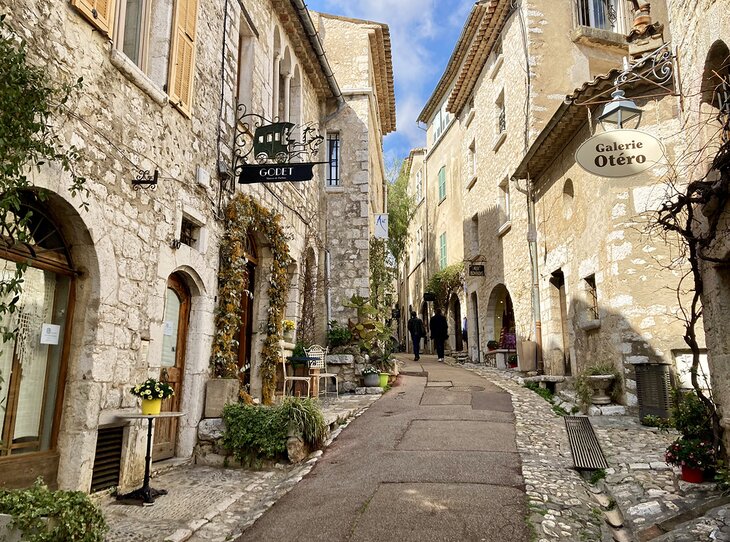
After the French Riviera, the second most-visited area in the South of France is sunny rural Provence . A patchwork of small farms, fields of lavender and sunflowers, and colorful open-air markets characterize the Provençal countryside. There are also fascinating medieval hilltop towns, Roman ruins, and historic cities such as Aix-en-Provence, Arles, and Avignon.
Would you like to discover the South of France's less touristy side ? Then head to Marseille for a glimpse of a real working city with a cosmopolitan vibe. Toulon is another authentic seaport with tourist appeal.
In Southwest France, the Basque seaside resort of Biarritz boasts an elegant Second Empire hotel, beautiful sandy beaches, and spectacular coastal scenery. Biarritz also has a superb aquarium and many fine-dining restaurants, as well as trendy bistros.
Slightly off the beaten path, the Languedoc-Roussillon region includes outstanding attractions like the UNESCO-listed fortified city of Carcassonne and the lively university town of Montpellier.
The most undiscovered area in the South of France is the rural Gascony region . This unspoiled countryside is known for its quiet villages and hearty cuisine. Toulouse is the biggest city in Gascony yet has the feel of a small town, thanks to its relaxed and convivial ambiance.
Plan your French sightseeing itinerary with our list of the best places to visit in the South of France.
1. French Riviera Seaside Resorts
2. nice: art museums and beaches, 3. aix-en-provence, 4. historic monuments in avignon & arles, 5. saint-tropez: a charming village with beautiful beaches, 6. the upscale seaside resort of biarritz, 7. the walled medieval town of carcassonne, 8. hilltop villages of provence (villages perchés), 9. the glamorous seaside city-state of monaco, 10. montpellier, 11. lourdes & pyrénées nature sites, 12. marseilles, the calanques & cassis, 13. ancient roman monuments & archaeological sites, 14. unesco-listed albi, 15. toulon & île de porquerolles, 16. the gascony region, 17. bordeaux, 19. the camargue, 20. plage de l'espiguette, map of places to visit in the south of france.
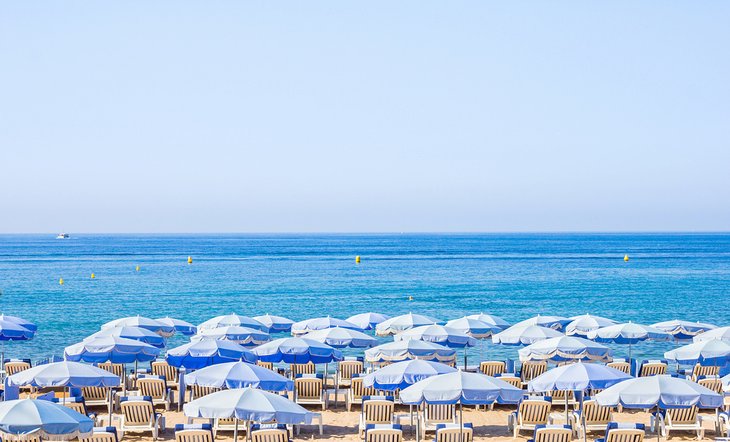
The sunny weather, mesmerizing deep-blue sea, and leafy palm trees give the French Riviera a dreamy quality. Also known as the "Côte d'Azur," the French Riviera delivers fabulous beach holidays with a hefty dose of culture.
During the early 20th century, artists flocked to the Côte d'Azur to capture the sublime scenery on canvas. As a result, many local museums display the works of Renoir, Matisse, Chagall, Picasso, and other painters who were captivated by the coastal landscapes.
Nice is prized for its gorgeous waterfront promenade and art museums, while Cannes is known for private beach clubs and the annual film festival.
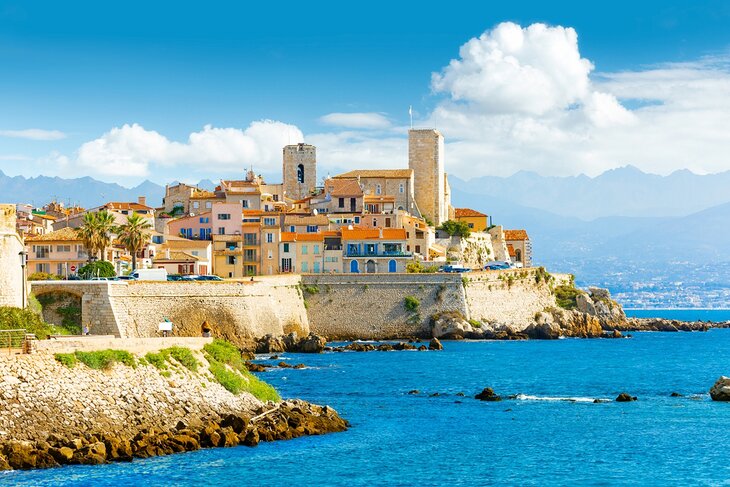
Other top resort destinations include Monaco and Saint-Tropez . The French Riviera also has smaller lesser-known towns that are full of charm, such as Fréjus, Antibes, Villefrance-sur-Mer, Beaulieu-sur-Mer, Èze, Roquebrune-Cap-Martin, and Menton.
Of all the French Riviera resorts, the coastline near Antibes has the best beaches, especially along the Golfe Juan on the Juan-les-Pins and Cap d'Antibes headland. In this area, there are about a dozen public beaches. The Plage de la Garoupe is the prettiest beach, with a fine white-sand shoreline, but much of it is occupied by private beach clubs during the summertime.
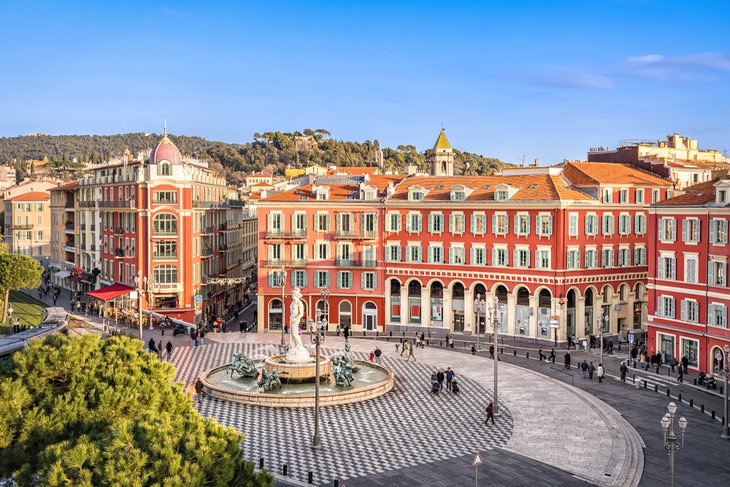
One of the highlights of the Côte d'Azur, the town of Nice deserves special mention because of its charming historic city center and amazing art collections: the Matisse Museum, Chagall Museum, Fine Arts Museum, and Museum of Modern and Contemporary Art.
With its scenic beachside location, balmy weather, and pleasant Mediterranean landscape, Nice has it all. The centerpiece of Nice is the Promenade des Anglais , a palm-fringed seafront promenade, while the Vieille Ville (Old Town) is a delightful warren of medieval alleyways and winding cobblestone streets.
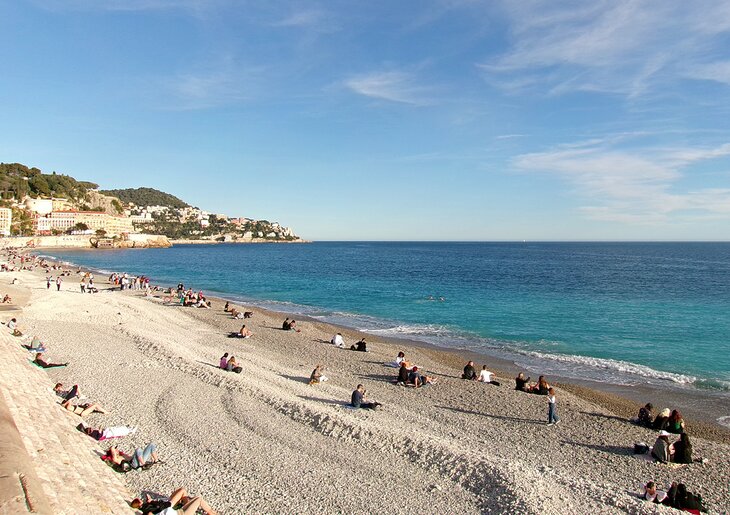
Surrounding Nice, the sunny Provençal countryside brims with day-trip possibilities, such as Grasse and Fréjus. Within a 30-minute drive are the atmospheric hilltop towns of Saint-Paul-de-Vence and Èze , as well as the fetching seaside villages of Cagnes-sur-Mer and Villefranche-sur-Mer .
Other highlights include the Villa Ephrussi de Rothschild on the Saint-Jean-Cap-Ferrat peninsula and the sea-facing Villa Kérylos in Beaulieu-sur-Mer, designed to resemble an ancient Greek nobleman's mansion of the 2nd century BC. Both villas are open to the public for visits.
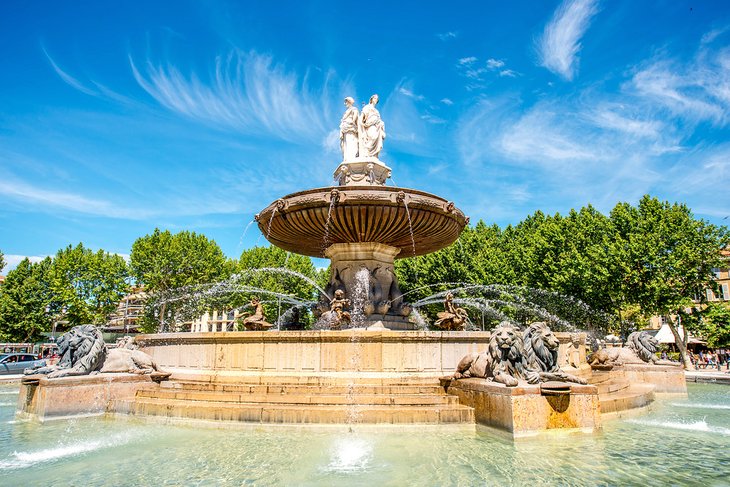
To experience the quintessential lifestyle of southern France, visit Aix-en-Provence. This elegant city epitomizes the Provençal region's character with its open-air markets, bustling outdoor cafés, and refreshing fountains that adorn the public squares.
As in most towns of Provence, the ambiance is slow-paced and relaxing. Aix-en-Provence residents have perfected the art de vivre, with leisurely meals and strolls along graceful tree-lined streets.
Top tourist attractions in Aix-en-Provence are Vieil Aix (the Old Town); the Cours Mirabeau , a tree-lined avenue with many sidewalk cafés and restaurants; and the Quartier Mazarin neighborhood, which was developed in the 17th century.
If you appreciate Post-Impressionist art, visit the Atelier de Cézanne , the studio where Paul Cézanne created many famous paintings. Cézanne was born in Aix-en-Provence and spent his childhood here. The Cézanne Trail gives you a chance to explore the landmarks associated with the artist on a self-guided walking tour.
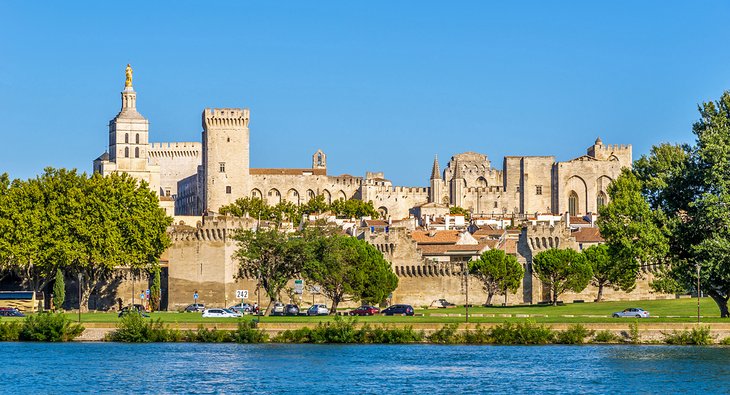
Discover the cultural heritage of Provence in Avignon and Arles. The UNESCO-listed Palais des Papes in Avignon stands as an awe-inspiring testimony to the grandeur of Christendom during the 14th century.
Avignon also has an outstanding museum of fine arts (the Musée du Petit Palais ), noteworthy medieval churches, and lively festivals throughout the year.
In the heart of Provence, Arles boasts a must-see Roman Amphitheater that was built in the 1st century to accommodate 21,000 spectators, as well as several other Roman-era archaeological sites.
In Arles, it's fun to wander the town to find the landmarks painted by Vincent van Gogh such as the Café du Forum (now called the Café van Gogh) on the Place du Forum . To see more sights painted by Vincent van Gogh, try the Van Gogh Route self-guided walking tour .
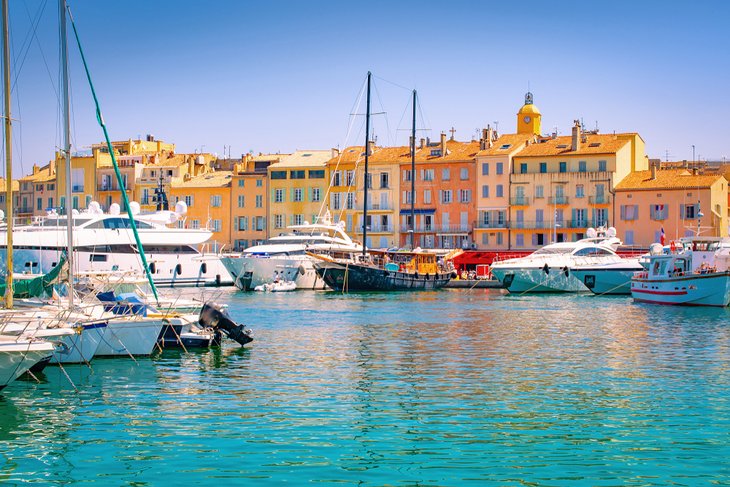
Saint-Tropez was just a humble fishing village until 1956 when the film And God Created Woman (starring Brigitte Bardot) made it famous. Scenes from the movie were shot on location throughout the town, including at the Plages de Pampelonne where private beach clubs continue to draw a fashionable clientele.
Today, this alluring beach resort still has the charm of a bygone era with its picturesque old fishing harbor ( Vieux Port ) and quaint historic town center ( La Ponche ). At the Musée d'Histoire Maritime , learn about local fishermen who began traveling beyond the Mediterranean Sea in the 16th century.
Besides its old-world charm and pristine sandy beaches, Saint-Tropez offers interesting cultural attractions . An outstanding collection of Impressionist and Post-Impressionist art is on display at the Musée de l'Annonciade , housed in a chapel that dates to 1510.
To soak up the ambiance of Saint-Tropez, spend time at the Place des Lices . This tree-shaded square features outdoor cafés where you can take in the everyday scenes of men playing pétanque (the Provençal version of bocce ball) and women shopping at the open-air produce market (on Tuesday and Saturday mornings).
If you are outdoorsy, take a hike on the Sentier du Littoral , a trail with superb views of the coastline. The trail begins in La Ponche and continues along a seaside path until Tahiti Plage (beach). Keep in mind that this trail has some rocky areas. Tip: Wear good hiking shoes.
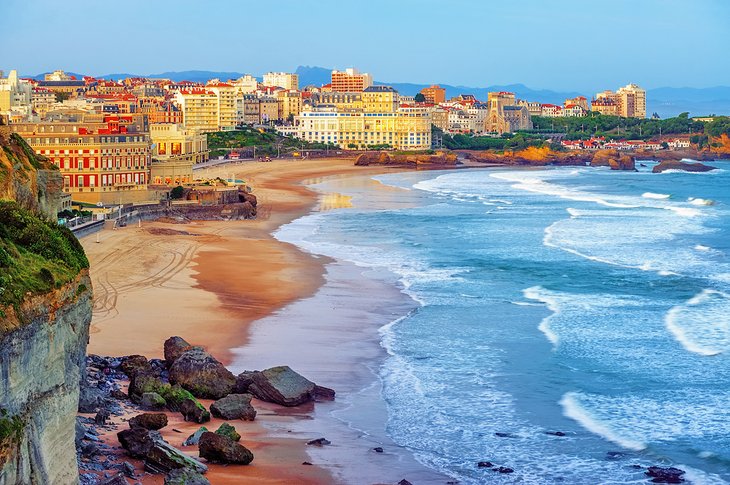
Stunning coastal scenery and elegant architecture distinguish Biarritz from other seaside resorts in the South of France. The town was once a holiday destination for aristocrats and royalty, and for that reason is known as the "Queen of Resorts and the Resort of Kings."
Empress Eugénie (wife of Napoleon III) adored this seaside location in the Basque region because of its dramatic natural beauty. Thanks to the empress and other aristocratic visitors in the 19th century, the little fishing village became a sophisticated and genteel beach town. The regal air of the past is evident in opulent oceanfront mansions and streets named after royalty.
The magnificent palace built for Empress Eugénie now houses the five-star Hôtel du Palais overlooking the Grande Plage , one of the top tourist attractions of Biarritz . The hotel offers sumptuous accommodations and exquisite fine dining.
Even if you don't stay at the Hôtel du Palais , you can splurge on a meal at the La Table d'Aurélien Largeau . This Michelin-starred restaurant serves contemporary Basque cuisine in a lavish Second Empire salon with ocean views.
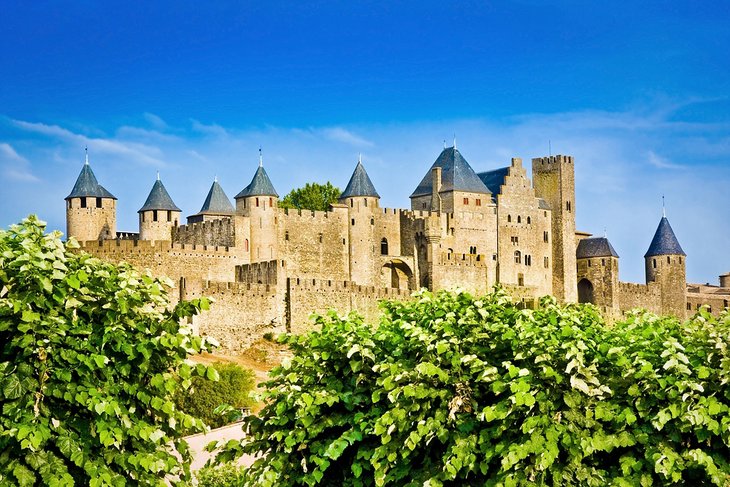
Carcassonne gives you the impression of stepping into the scene of a fairy tale. Perfectly preserved, this fortified medieval town is designated as a UNESCO World Heritage Site . The turreted towers lend a Disneyland-like quality.
By exploring the narrow alleyways and cobblestone streets of Carcassonne, you can imagine what life was like during the Middle Ages. Check out the Grand Puits de la Cité , a listed Monument Historique . Townspeople once withdrew drinking water from this 14th-century well.
As early as the 12th century, residents worshipped at the Cathédrale Saint-Nazaire et Saint-Celse , an impressive Gothic monument that is now a basilica. For a peek at a medieval fortress, head to the Château Comtal , where the Viscounts of Carcassonne resided in the 12th and 13th centuries.
Another nearby UNESCO-designated site in the Languedoc-Roussillon region is the Canal du Midi . This 360-kilometer canal was created in the 17th century to link the Atlantic Ocean to the Mediterranean Sea.
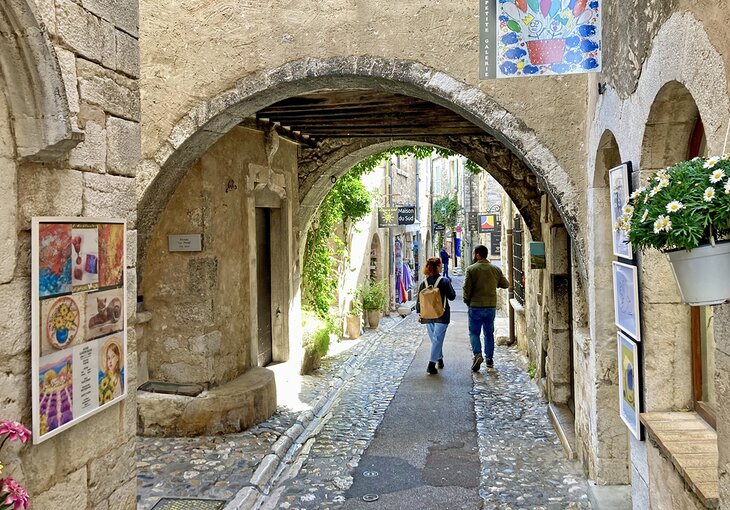
Hilltop villages ( villages perché s in French) encapsulate the old-world charm of Provence. Many of these ancient towns are still enclosed by ramparts, which adds to the magical feeling of being enclosed in a little medieval world.
You will enjoy wandering narrow cobblestone streets and pedestrian lanes to discover small boutiques, fountain-adorned squares, and historic churches. Provençal hilltop villages also will delight you with splendid views of the rural landscape.
If you are traveling by car, you can create a driving itinerary to discover the quaint country villages of Provence, especially in the remote Luberon region , which is designated as a UNESCO-listed biosphere reserve.
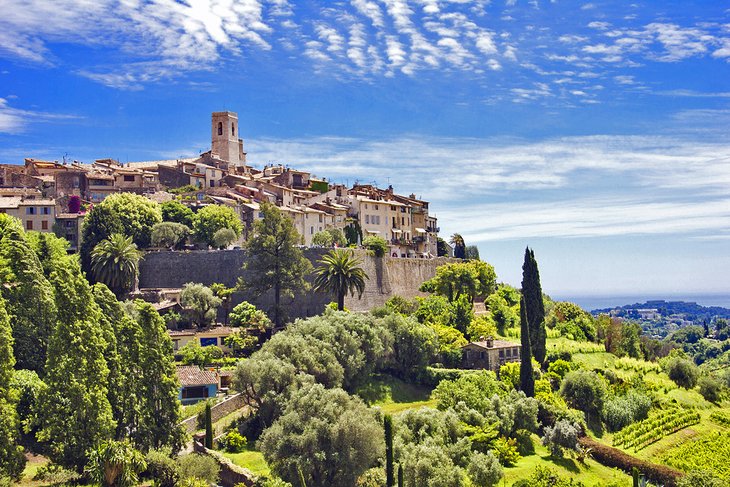
For those based in Nice, several interesting hilltop villages are easy day-trip destinations . These are beautiful little towns, although this area is no longer rural and instead is part of the suburban sprawl around Nice.
It's hard to resist the allure of Saint-Paul de Vence , about a 30-minute drive from Nice. This well-preserved walled town stands high on a precipice overlooking the landscape. The town's quaint cobblestone streets, enticing boutiques, and fabulous views make up for the fact that the village is overrun with visitors even in the off-season.
Beginning in the 1920s, many famous artists were drawn to the beauty of Saint-Paul de Vence, and their work is on display at the Fondation Maeght , two kilometers outside the village.
Along the French Riviera coastline , Èze is a captivating hilltop village (only 12 kilometers from Nice) perched 400 meters above the sea. This picture-perfect village affords sweeping vistas of the Mediterranean and the Cap-Ferrat coastline. Luxurious accommodations are found at the Château de la Chèvre d'Or hotel , a Relais & Châteaux property with a two Michelin-starred restaurant.
A 45-minute drive from Nice in the foothills of the Maritime Alps is the town famous for its perfume factories. Grasse also has a wonderful Vieille Ville (Old Town), full of narrow pedestrian streets, small squares, and historic buildings. To soak up the ambiance and sunshine, stop for a leisurely al fresco lunch on the Old Town's main square (Place aux Aires).
One of the Plus Beaux Villages de France , Gourdon (40 kilometers from Nice) boasts many artisan craft boutiques and an impressive château with gardens designed by André Le Nôtre. From Nice, you can go on a full-day Provence countryside small-group day trip to visit hilltop towns Grasse, Gourdon, and Saint-Paul de Vence as well as the seaside resort of Cannes.
Medieval hilltop villages are scattered throughout the Haut-Vaucluse area of Provence. Two more of France's Plus Beaux Villages are Séguret (10 kilometers from Vaison-la-Romaine) overlooking the Dentelles de Montmirail mountain range and Venasque , which affords views of Mont Ventoux.
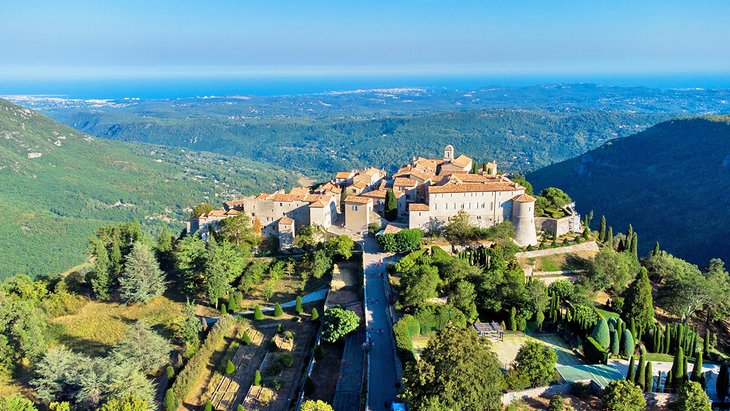
Presiding above rocky gorges in the Haut-Vaucluse, Monieux has a museum dedicated to truffles, the Musée de la Truffe du Ventoux, and hosts a Medieval Festival in September.
Crillon-le-Brave offers the charm of a quiet hilltop hamlet along with a five-star Relais & Châteaux resort property, the Hôtel Crillon Le Brave .
The Luberon natural regional park in the Haut Vaucluse has many medieval hilltop towns on the Plus Beaux Villages list: Gordes , dramatically perched on a steep promontory; Ménerbes , made famous by Peter Mayle's A Year in Provence novel; Lourmarin , which has a majestic château that hosts cultural events and festivals; Roussillon , built alongside an ochre cliff and surrounded by woodlands; and Lacoste , a tiny village full of art galleries and outdoor cafés.
Also in the Luberon natural park, Bonnieux stands out because of its traditional Provençal market and its fantastic museum devoted to the history of bread, the Musée de la Boulangerie. The town also has an interesting Romanesque church.
Apt is known for its large Provençal market (held on Saturday mornings) and museum of archaeology, while Cadenet has a luxurious boutique hotel, the Auberge La Fenière , with a Michelin-starred restaurant, Le Goût de Bonheur .
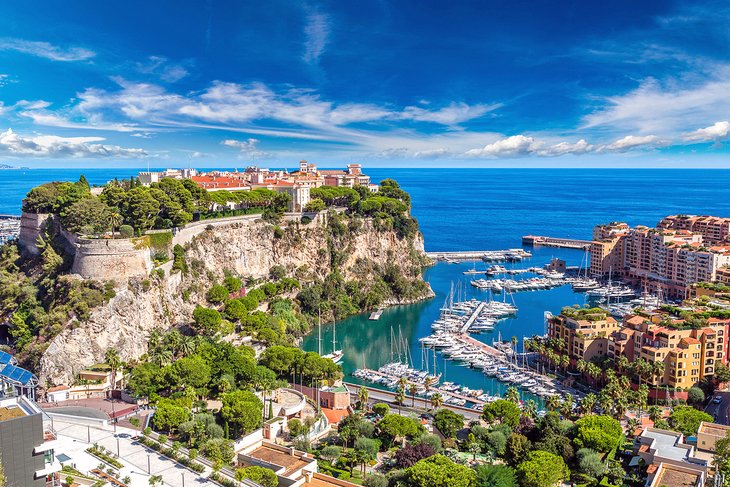
Perched on a promontory above the sea, Monaco boasts an impressive ancient castle and splendid coastal views. This dazzling city-state on the French Riviera is home to a royal family with a heritage that dates back to the 13th century.
Just a 30-minute train ride from Nice, Monaco draws fashionable crowds to its high-profile yacht shows, the annual Formula 1 Grand Prix de Monaco car race, and the Opening Gala at the Opera House.
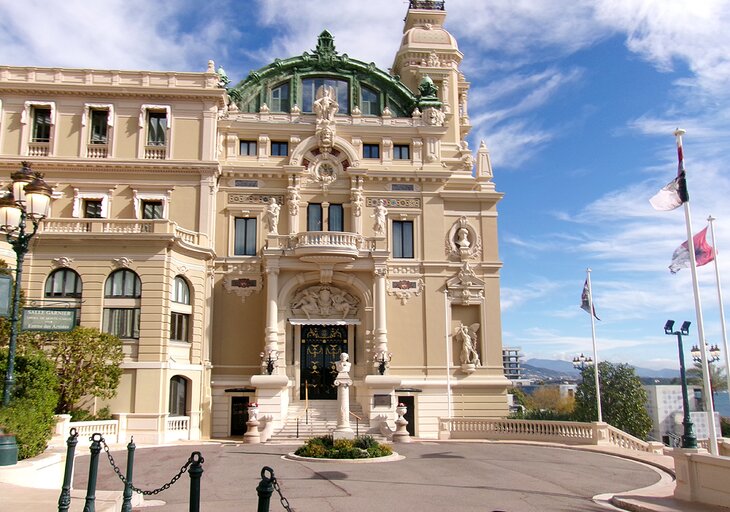
Even if you only visit for a day or afternoon, you can see many of the highlights of Monaco including the Palais Princier (Prince's Palace), the Musée Océanographique , and the ritzy Place du Casino in the Monte-Carlo district. These top attractions are all within easy walking distance.
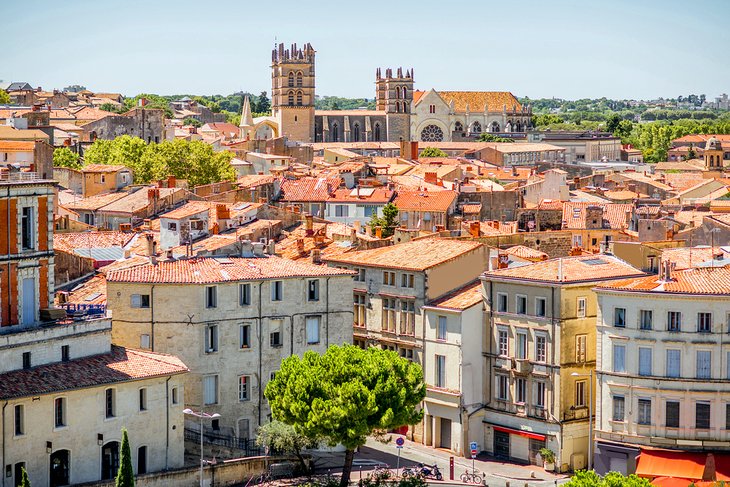
Despite being a modern urban city, Montpellier has retained its historic character in L'Écusson (the Old Town) with its jumble of winding medieval streets, elegant squares, beautiful churches, and stately hôtel particuliers (aristocratic mansions).
Encircling L'Écusson, spacious tree-lined boulevards were created by Baron Haussmann (who designed the Grands Boulevards of Paris) in the 19th century, replacing the city's medieval ramparts. The best of the 21st century is seen in Montpellier's sleek tram system with new cars featuring decorations by Christian Lacroix.
An air of trendiness and youthful energy reigns throughout Montpellier, thanks to the university-student population. Buzzing sidewalk cafés and chic gourmet restaurants delight locals and tourists alike.
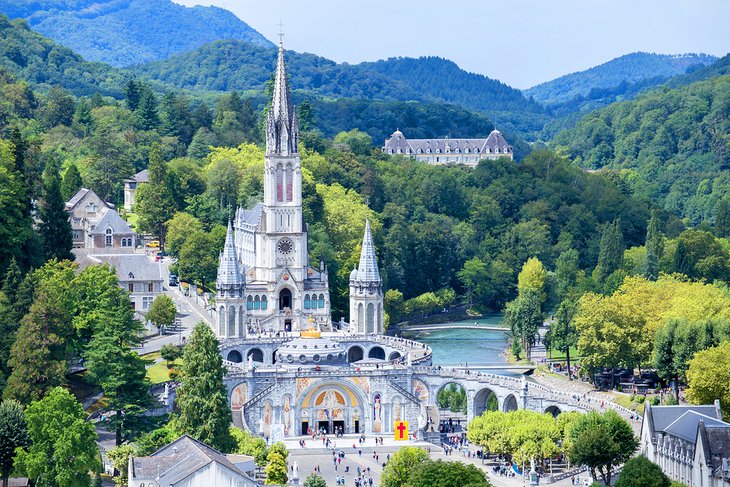
Densely forested, rolling hills provide an inspiring backdrop for the Lourdes cathedral alongside the rushing Ousse River. Pure spring waters flow into a Grotto where Saint Bernadette received visions of the Virgin Mary. Water from this source is believed to have healing properties.
Millions of pilgrims visit Lourdes annually, making it the biggest pilgrimage destination in France and one of the most important Catholic pilgrimage sites in the world. Pilgrims visit the Grotto of the Apparitions, worship at the Basilique Notre-Dame du Rosaire (Basilica of Our Lady of the Rosary), and participate in candlelit Marian processions.
One of the top attractions of the French Pyrenees , Lourdes draws many pilgrims who hope for cures to an illness by bathing in the sacred waters. So far, the Catholic church has validated 70 official miracles.
Lourdes is an ideal starting point to explore the Pyrenees Mountains. The UNESCO-listed Cirque de Gavarnie awes you with its spectacular scenery of sheer granite walls and rushing waterfalls. The highest summit (the peak of Mont Perdu ) soars to over 3,300 meters; the Grande Cascade with a 422-meter drop is Europe's tallest waterfall .
An easy walking path at the Cirque de Gavarnie allows you to soak up the scenery of snow-dusted mountains, alpine chalets, and goats grazing on the grass. You'll also enjoy listening to the refreshing sounds of a meandering stream and the chirping of little birds.
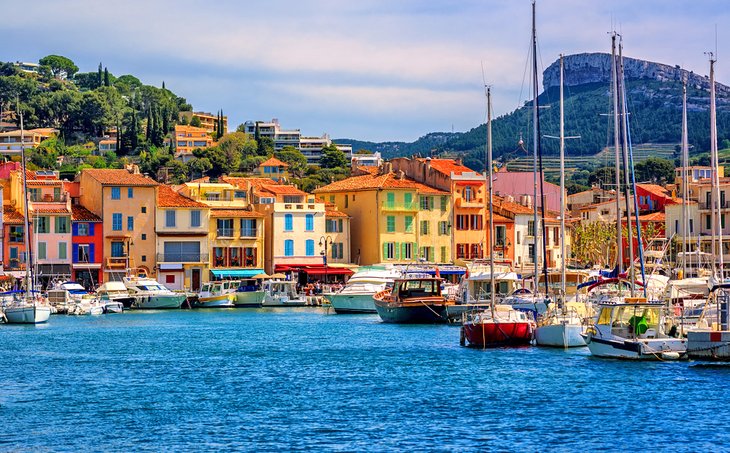
To experience an authentic Mediterranean seaport, spend a day or two exploring Marseilles . A bustling harbor explains the city's raison d' ê tre , as well as its rich multicultural heritage.
The Old Town ( Le Panier ) of Marseille brims with historic buildings, artisan boutiques, and authentic restaurants, while the Vieux Port dating back to the 6th century BC is still in use today as a launching point for fishing boats.
A fish market is held every morning at the harbor, and the restaurants around the waterfront are the best places to visit to sample the gastronomic specialty of Marseilles, bouillabaisse (seafood stew). The upscale Restaurant Miramar (12 Quai du Port) is famous for its bouillabaisse.
From the Vieux Port in Marseille, you can hop on a ferry to reach two favorite tourist destinations: the 16th-century Château d'If (fortress) on the île d'If, and the Calanques , a national park featuring white limestone coves filled with seawater. You can also take cruises and private boat excursions to explore the Calanques (coves).
It is even possible to take an Electric Bike Tour to the Calanques from Marseille . This full-day tour traverses the wild terrain of the Calanques with a stop at a beach for swimming and concludes with a visit to the Basilique Notre-Dame de la Garde, one of the top tourist attractions in Marseille .
Less than 30 kilometers from Marseilles is Cassis . The pastel-painted houses, picturesque port, and bright Mediterranean sunlight of this Provençal fishing village appealed to Post-Impressionist painters such as Paul Signac, Henri Matisse, and Raoul Dufy, who arrived in the late 19th and early 20th century to paint scenes of the harbor and coastline.
Today, Cassis is a recreational getaway for residents of Marseille as well as travelers who appreciate the charm of a small seaside town. If you would like to visit Cassis and the Calanques as a day trip from Marseille, an organized sightseeing tour is the perfect option.
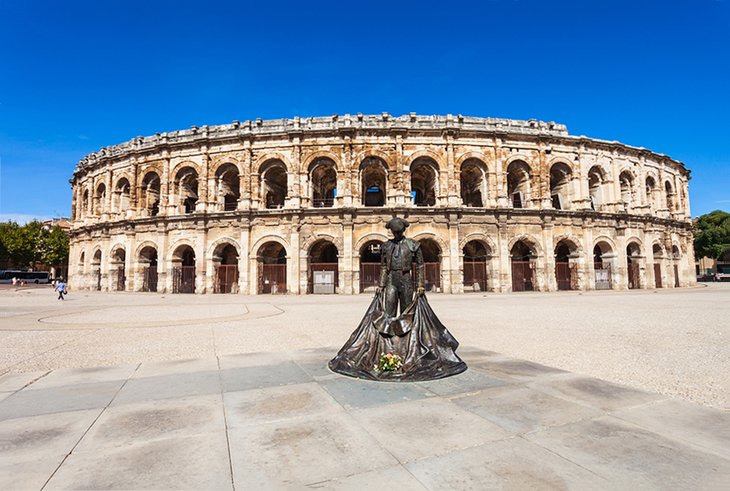
Both Arles in Provence and Nice on the French Riviera have fascinating ancient Roman ruins, among their other tourist attractions. The Arènes d'Arles was once used for gladiator fights and today hosts cultural performances. In the Cimiez quarter of Nice are the ancient ruins of Cemenelum, revealing vestiges of the Roman baths and amphitheater.
Nîmes in the Languedoc region has some of the most impressive ancient Roman monuments in the south of France. The Arènes de Nîmes , a perfectly designed Roman amphitheater, and the Maison Carrée (Roman temple) are remarkable for their exceptional state of preservation.
An important town during classical antiquity, Orange boasts a UNESCO-listed Théâtre Antique (Roman theater dating to the 1st century). This incredibly well-preserved ancient theater today hosts the renowned Chorégies d'Orange music festival, as well as other cultural events.
In the Haut-Vaucluse area of Provence , Orange is a 30-minute drive away from Vaison-la-Romaine , which is considered one of the Plus Beaux Détours de France (France's official list of places worthy of a detour).
Vaison-la-Romaine has remarkable archaeological sites dating to the 1st century. The old Roman theater of Vaison-la-Romaine is used as an open-air venue for Vaison Danses , an international dance festival that takes place every year in July.
Also in the Haut-Vaucluse area, Pernes-les-Fontaines was founded during the Gallo-Roman era. This relaxing town was named for its many fountains that provide abundant drinking water, a legacy of the Roman heritage.
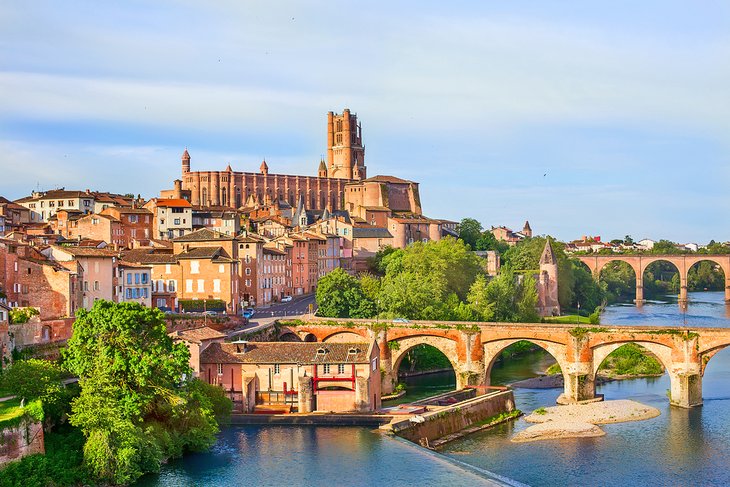
The historic episcopal city of Albi is designated as a UNESCO World Heritage site because of its exceptional architecture and cultural value. An imposing fortress-like cathedral presides over the medieval town.
Founded in the 13th century, the enormous Cathédrale Sainte-Cécile is the world's largest cathedral built from brick. The breathtaking vaulted interior features over 18,000 square meters of frescoes and an ornately decorated Gothic choir with 200 intricate statues. Not to be missed is the Last Judgment fresco, a masterpiece of Renaissance painting.
Housed in the UNESCO-listed 13th-century Palais de la Berbie, the Toulouse-Lautrec Museum is devoted to the work of the famous artist, Henri de Toulouse-Lautrec, who was born in Albi. The museum displays Lautrec's distinctive posters, as well as paintings and drawings.
Albi is a worthwhile day trip from Toulouse (a one-hour drive) or combined with an itinerary of other attractions such as Carcassonne (about a two-hour drive).
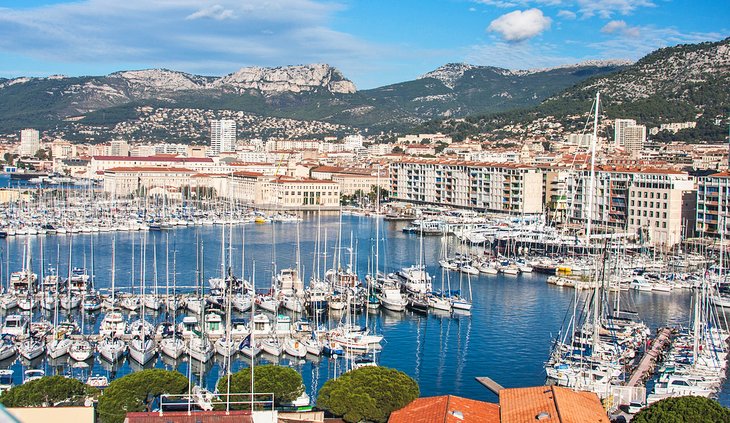
Toulon is less touristy than other seaside cities along France's Mediterranean coast yet offers plenty of attractions. This characteristic port town has an attractive palm-fringed waterfront, which is full of shops, and restaurants with outdoor terraces.
Highlights of Toulon are the atmospheric Le Mourillon quarter, an old fishing village; the historic harbor including the Porte de l'Arsenal , an 18th-century military building that houses the Musée National de la Marine (seafaring museum); and the astounding coastal views from Mont Faron (accessible by the Téléphérique du Faron cable car).
A traditional Provençal market has been held in Toulon since the 18th century. Today, this market takes place every day (except Mondays) at the Cours Lafayette from 7:30 am until 12:30 pm; vendors sell fresh vegetables, fruits, flowers, specialty food products, and Provençal fabrics.
From the Port of Toulon, you can sail away to the dreamy Île de Porquerolles just an hour's ferry ride away. The island features unspoiled natural scenery, sandy beaches, and secluded coves. It's the perfect destination for a relaxing getaway. Besides sunbathing, the Île de Porquerolles offers opportunities for snorkeling, hiking, and mountain biking.
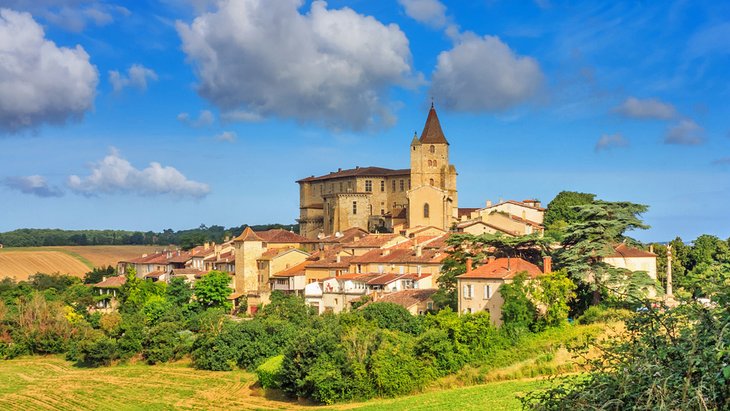
If you really want to get away from all the tourists, go to Le Gers (the Gascony region). This pastoral region in Southwest France is exceptionally charming, yet almost completely undiscovered by travelers.
Unspoiled forests and farmlands blanket the undulating countryside in a colorful patchwork while hilltops are dotted with imposing castles, walled medieval towns, and quiet country villages.
Toulouse is the largest city in the region, but it has a slow-paced, small-town feel. With its sultry climate and sidewalk cafés found at every turn, Toulouse immerses you in a relaxing ambiance typical of southern France.
There are plenty of things to see in Toulouse , including a UNESCO-listed Romanesque basilica and stately civic buildings constructed from the red bricks that earned the city its name, La Ville Rose .
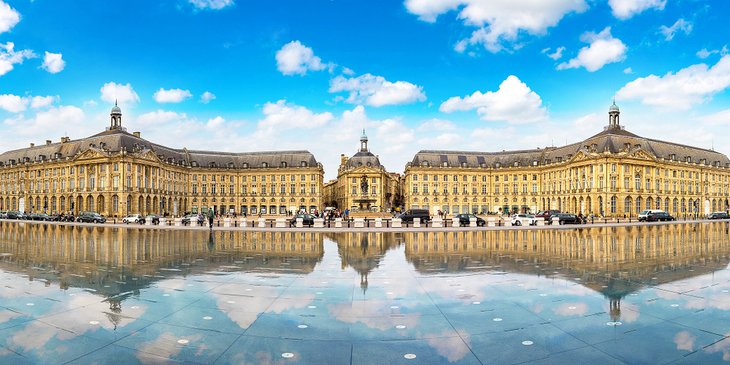
UNESCO has designated the entire historic city center of Bordeaux as a World Heritage Site because of its cultural value and architectural treasures from the Age of Enlightenment. The city boasts nearly 350 buildings that are listed as Monuments Historiques .
Built up along the Garonne River in Southwest France, Bordeaux is a cosmopolitan port town with a heritage that stretches back to antiquity. The city flourished during the 18th century, which explains the coherence of Neoclassical buildings dating to that era.
Among Bordeaux's top tourist attractions are the UNESCO-listed 12th-century Cathédrale Saint-André and the 18th-century Grand-Théâtre, which hosts ballet, opera, and music performances.
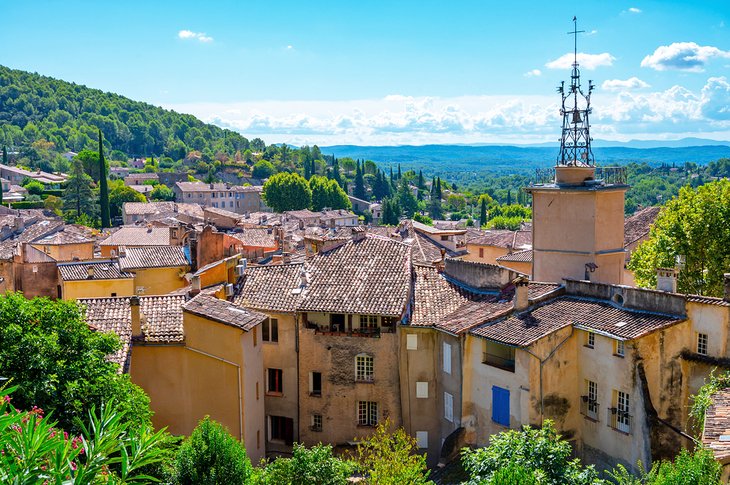
Le Var region is a hidden gem of Southern France, nestled between Provence and the French Riviera. Lush woodlands, rolling hills, and farmlands define the landscape of this rural area. The countryside is dotted with historic towns, ancient abbeys, and beautiful villages.
You may visit La Chartreuse de La Verne , a serene Carthusian monastery (and listed Monument Historique ) that is open to the public. You will appreciate the peaceful setting, as well as the monastery's 12th-century Romanesque church and the ceramics (for sale at the monastery's boutique) that are handcrafted by the resident nuns. The boutique is closed on Sundays.
The Abbaye du Thoronet is another 12th-century abbey (classified as a Historic Monument ) hidden deep within a forest of oak and olive trees. The Thoronet Abbey is one of three important Cistercian monuments in the South of France (the others include the Silvacane Abbey and the Abbey of Sénanque in Provence). You may visit the abbey year-round.
The Var region is full of traditional country villages and towns featuring fountain-adorned squares and inviting outdoor cafés. Lorgues is typical with its many fountains, an impressive historic church, an atmospheric medieval quarter, and a weekly open-air market that draws many visitors.
Near Lorgues are two tourist attractions that appeal to luxury seekers and gourmands: the Château de Berne (in the town of Flayosc), a five-star Relais & Châteaux hotel set amid vine-cloaked fields and olive groves; and the famous Chez Bruno fine-dining restaurant (in Le Plan Campagne Mariette near the Château de Berne) that specializes in dishes made with truffles.
Sheltered by steep limestone cliffs, Cotignac (23 kilometers from Lorgues) is classified as a Village de Caractère du Var (Village of Character of the Var) as well as one of the Plus Beaux Villages thanks to its lovely ambiance, picturesque streets, and pleasant tree-lined central square.
If you love the great outdoors, be sure to see the Gorges du Verdon in the region's northeastern corner. Part of the Parc Naturel Régional du Verdon , this 700-meter-deep river canyon offers opportunities for swimming, water sports, and hiking.
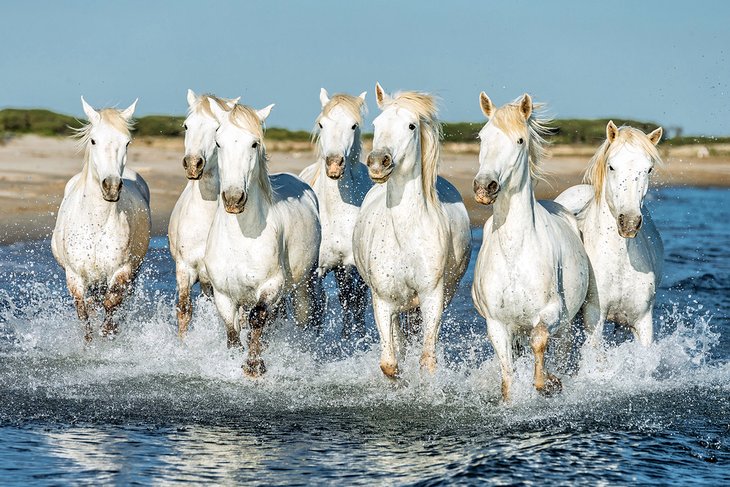
About a 20-minute drive from Arles, the Camargue is a unique landscape of wetlands, marshlands, beaches, and sand dunes. The Parc Naturel Régional de Camargue is home to wild white horses, Camargue bulls (used in bullfighting), and over 300 species of birds including pink flamingos.
Within the Parc Naturel Régional de Camargue, Saintes-Maries-de-la-Mer delights tourists with its sandy beaches and a wide selection of cafés, restaurants, and shops.
Just outside the Camargue Natural Regional Park are several noteworthy historic towns. Dating back to the 13th century, Aigues-Mortes has its medieval fortifications completely intact. These ancient walls conceal an atmospheric warren of narrow streets, steeped in the ambiance of the Middle Ages.
Salt marshes surround the town of Aigues-Mortes and less than two kilometers away is the Salin d'Aigues-Mortes , where the prized Fleur de Sel de Camargue sea salt is harvested by artisans in the centuries-old manner. At the Salin d'Aigues-Mortes site, you can take a guided or self-guided walking tour of the salt marshes. During July and August, watch workers harvest the Fleur de Sel salt.
The area around the Camargue Natural Regional Park boasts seaside vacation destinations: Le Grau-du-Roi (seven kilometers from Aigues-Mortes), an old fishing village that has been transformed into a modern resort; and Port Camargue (12 kilometers from Aigues-Mortes), which has sandy beaches.
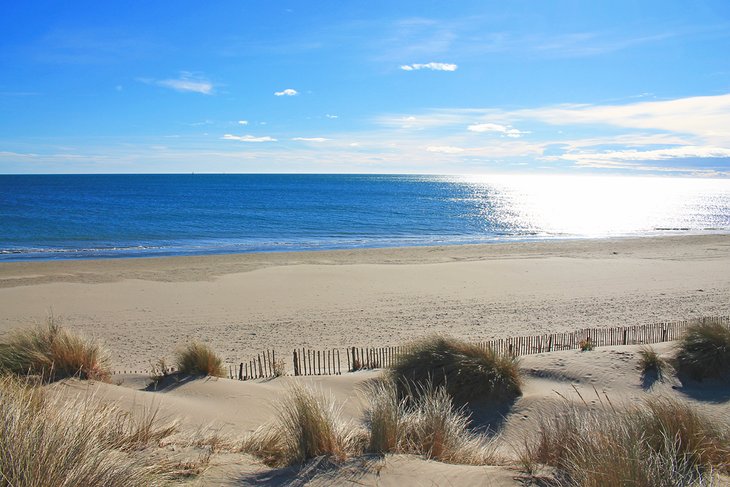
The Plage de l'Espiguette ranks as one of the best beaches in France because of its pristine environment and calm deep-blue seas. This dreamy stretch of white-sand shoreline is a favorite summertime destination in the Languedoc-Roussillon region (a 45-minute drive from Montpellier).
At this wild unspoiled beach, outdoor activities are the main draw. Things to do include swimming, nature walks, horseback riding, kitesurfing, and fishing.
More Related Articles on PlanetWare.com
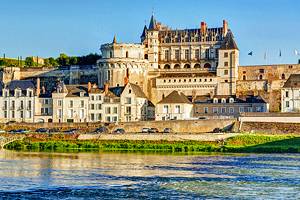
Other Highlights of France : Many travelers begin a vacation in France by visiting the capital city of Paris . The TGV high-speed train takes just over 2.5 hours from Paris to Avignon, a good starting point to explore Provence. For more trip-planning inspiration, read about the best places to visit in France . Other top tourist destinations include Normandy and the Loire Valley.

More on France

- Search Please fill out this field.
- Manage Your Subscription
- Give a Gift Subscription
- Sweepstakes
The South of France Is My Favorite Vacation Destination — Here Are Its 20 Best Places to Visit
The lavender fields, quaint villages, and beautiful beaches have my heart.
Lindsay Cohn is a writer, editor, and avid traveler who has visited 45 countries across six continents — and counting. She contributes to Travel + Leisure, Hotels Above Par, InsideHook, Well+Good, The Zoe Report, and more.
:max_bytes(150000):strip_icc():format(webp)/Lindsay-Cohn-8b22fb2d452f46f5a256755f4d0f42a5.jpeg)
Alexander Hafemann/Getty Images
France ranks among the most popular tourist destinations in all of Europe — of course there are remarkable destinations in the country that gave us boeuf bourguignon , the Eiffel Tower , and Champagne. But with alluring beaches along the Côte d'Azur , magical lavender fields, and the vineyards of the Luberon, the South of France is a superb destination all on its own. I'm a professional travel writer who's been to 45 countries across six continents, and it's my absolute favorite place in the world to visit. If you’re planning on spending even just a few days in le Midi , this list will help you choose which of the region's many, many highlights to include in your itinerary.
kolderal/Getty Images
Gordes is one of the most beautiful small towns in the world , with roads and facades that seem to have sprung from the pages of a children's storybook. Unsurprisingly, tourists beeline to this enchanting Luberon village to see — and snap photos of — its cobbled lanes, white stone buildings, and churches.
Saint-Tropez
AtanasBozhikovNasko/Getty Images
A French Riviera hotspot put on the map by Bridget Bardot and other members of the jet-set pack in the 1960s, Saint-Tropez still sizzles. Sun-kissed holiday goers crowd glamorous beach clubs here, moor their mega yachts in the harbor, shop for breezy linens at the boutiques, and traipse around the old fishing quarter.
Abbaye Notre-Dame de Sénanque
Just outside the tourist-trodden center of Gordes lies Abbaye Notre-Dame de Sénanque, a photogenic monastery founded in 1148 by Cistercians monks. Guided tours of the church and cloisters are available throughout the year. When the lavender fields bloom in the summer, this site reaches peak prettiness.
Île Sainte-Marguerite
maudanros/Getty Images
Île Sainte-Marguerite floats about half a mile offshore from Cannes. In contrast to its mainland neighbor, the largest of the Lérins Islands is small, slow-paced, and steeped in nature. Expect rocky beaches, turquoise waters, and a eucalyptus forest, as well as a very interesting underwater sculpture museum.
Gabrielle Therin-Weise/Getty Images
It’s not hard to find enchanting hilltop towns in Provence. The enduring charm of Mougin that lured Edith Piaf and Christian Dior enamors all who visit. This medieval village has a snail-shaped center with cobbled lanes and flower-clad houses, plus large-scale art sculptures and award-winning restaurants overlooking the leafy countryside.
Oppède le Vieux
imageBROKER/AnnaReinert/Getty Images
In stark contrast to the Disneyland-like atmosphere of Gordes, Oppède le Vieux is an under-the-radar village that’s built atop rocks and surrounded by overgrown trees. The stone pathways, steps, and structures here are in various degrees of ruin, which imbues a time-worn charm.
Porquerolles
robixy79/Getty Images
Escape to Porquerolles, off the coast of Hyères, for a peaceful respite that can include time lazing on near-empty beaches, swimming in placid tides, sipping your way through vineyards, cycling in the countryside, and wandering through old forts.
Plage des Marinières
cwrgutierrez/Getty Images
Widely considered to be one of the most beautiful beaches in the French Riviera, crescent-shaped Plage des Marinières in the darling village of Villefranche-sur-Mer is the perfect spot for a day of basking in the sun, strolling across golden sand, and splashing in the blue waters of the Mediterranean Sea.
Saint-Jean-Cap-Ferrat
Nickzas/Getty Images
The exclusive commune of Saint-Jean-Cap-Ferrat has long attracted the attention of artists and jet setters with deep pockets and a desire for privacy. Exquisite villas are obscured from sight by lush vegetation. Pristine beaches, scenic hiking trails, and a yacht-filled harbor define this desirable destination.
Site Archéologique de Glanum
Fernando Fernández Baliña/Getty Images
Named after the Celtic god Glanis, Site Archéologique de Glanum traces its roots back to 600 BC. It’s at this extensive site just outside the town of Saint-Rémy-de-Provence that visitors can walk through remarkable surviving remains of both Gaulish and Roman settlements.
Le Sentier des Ocres
Filippo Maria Bianchi/Getty Images
The most iconic and unmissable sight in the Luberon village of Roussilian, Le Sentier des Ocres is a former ochre quarry with walking paths through rust-hued hills. The setting certainly provides spellbinding photo ops.
Wirestock/Getty Images
Nice is a vibrant seaside city with a lovely historic core. If Vieux Nice is on your itinerary, begin with the Promenade des Anglais, then wander through the narrow cobblestone streets, admiring the pastel-hued facades and shopping for Niçoise soaps. Experience a Provencale market, grab socca (chickpea pancake) at one of the outdoor cafes, and soak in the views from Colline du Château before you depart.
Francesco Riccardo Iacomino/Getty Images
The untamed region between the Mediterranean Sea and the two branches of the Rhône River delta, Camargue defies preconceptions with its vastly different landscape. Rather than olive groves and grape vines, expect salt marshes and reed beds inhabited by free-roaming white horses and pink flamingos.
Valensole Plateau Lavender Fields
Paula Galindo Valle/Travel + Leisure
Lavender is the emblem of Provence. The fields on the Valensole Plateau that erupt into a fragrant and gorgeous purple bloom each summer are some of the most popular — and photogenic — attractions in the region.
lucentius/Getty Images
Fragrance fans are no doubt familiar with Grasse, a French Riviera town in the hills behind Cannes that’s considered the perfume capital of the word. Rare roses and jasmine for designer luxury scent makers grow in this sunny village. It’s also home to many perfumeries.
Monastery Saint-Paul de Mausole
SEN LI/Getty Images
If you’re at all interested in the life and work of Vincent Van Gogh, consider a visit to Monastery Saint-Paul de Mausole. This is the monastery-turned-psychiatric facility in Saint-Rémy-de-Provence where the tortured Dutch artist sought treatment and famously painted “The Starry Night.”
Palais des Papes
Maremagnum/Getty Images
The standout attraction in Avignon, the enormous Palais des Papes served as a pontifical residence in the 14th century. It's also on the shortlist of the most significant medieval Gothic buildings in all of Europe, with ceremonial halls, chapels, a cloister, and frescos.
Mines Bruoux
DEA/ALBERT CEOLAN/Contributor/Getty Images
Mines Bruoux , near Gargas, gives visitors the chance to tour a maze-like complex of tunnels and galleries in a 19th-century ochre mine. You will learn about the fascinating mining process as you go. The cool underground temperature provides a reprieve from the summer sun, too.
Promenade de la Croisette
Federica Fortunat/Getty Images
Few places embody French Riviera glamor quite like Promenade de la Croisette. Running along the Mediterranean Sea, the famous palm-fringed thoroughfare is crowned by Palais des Festivals et des Congrès, which hosts the Cannes Film Festival, and you'll find many upmarket hotels, shops, and restaurants here as well.
Carrières de Lumières
Francois LOCHON/Contributor/Getty Images
For an unforgettable experience that speaks to Provence’s artistic pedigree, head to Carrières de Lumières in Les Baux-de-Provence. Housed in an old quarry, this contemporary art center hosts multimedia shows that combine larger-than-life projections of famous paintings and music.

22 Best Places to Visit in the South of France
Written By: ThePlanetD Team
Updated On: February 9, 2024
Looking for the best places to visit in the South of France ? You’ve come to the right place. It had been quite some time since we’d traveled to the South of France, but this summer we had the good fortune of spending nearly a month revisiting this beautiful region. While taking a Canal du Midi cruise on our luxury houseboat with Le Boat , we had the chance to explore some of the lesser-known places in Southern France.
During this trip down the historic waterway, we were reminded of all the beautiful places in the South of France that we’ve taken over the years. France really has it all. So, if you are looking to branch out from the ordinary, check out the best places to visit in the South of France to create a holiday that will ignite all the senses.
Table of Contents
Top Places to visit in the South of France
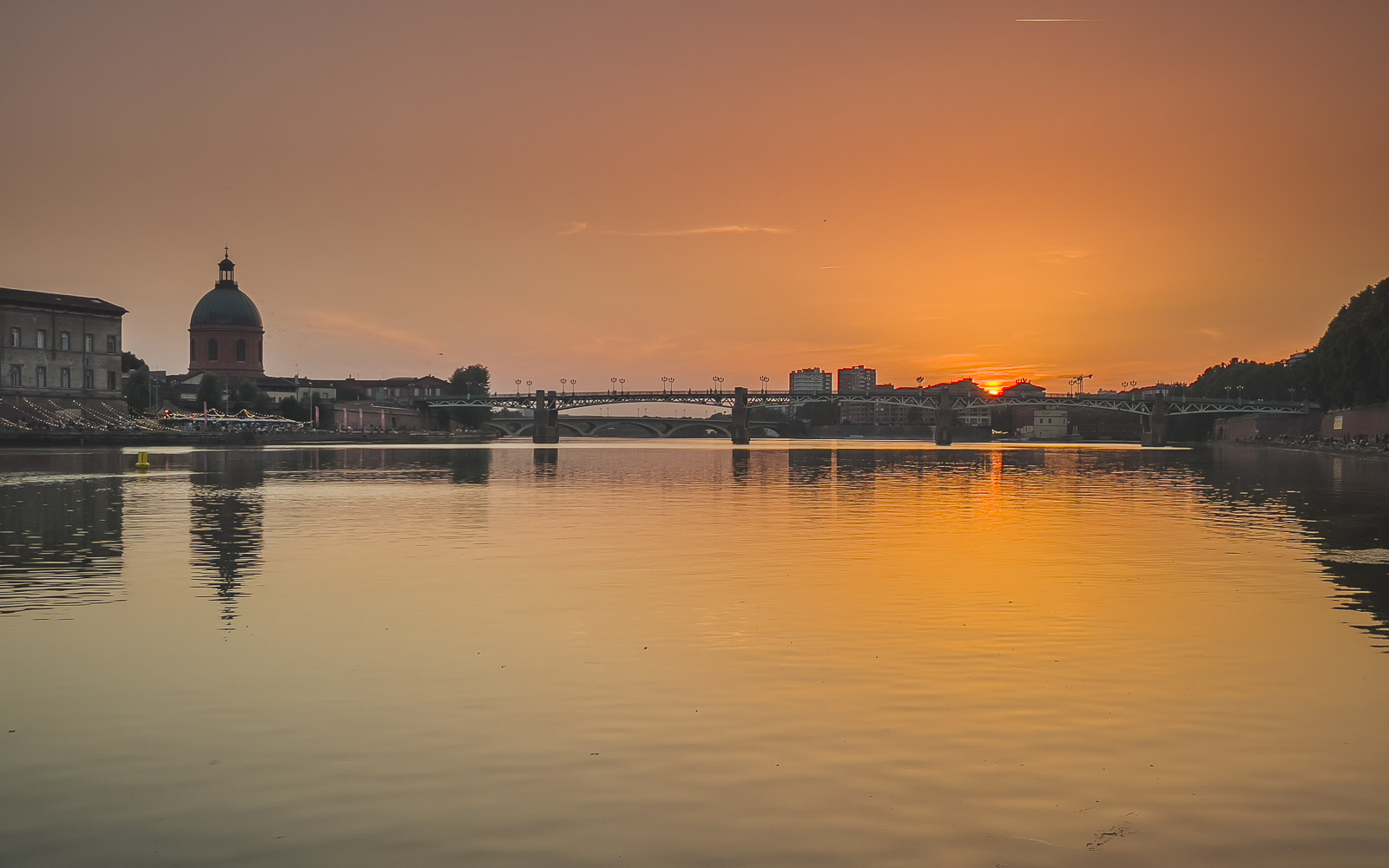
Historic cities , the French Riviera, and beautiful beaches; the South of France oozes with energy and excitement. But what are the best places to visit in the South of France? Are you looking for a city filled with elegant architecture and cultural attractions? Or perhaps one of the beautiful medieval villages, overlooking the Mediterranean Sea surrounded by olive groves? Be it sandy beaches, art galleries, or traditional French cuisine , Southern France is a timeless holiday destination, and it’s easy to see why.
This guide will cover everything from the stunning natural attractions in the South of France to national parks and the best cities. Are you ready to get started? Let’s take a look.
Best cities and towns to visit in the South of France
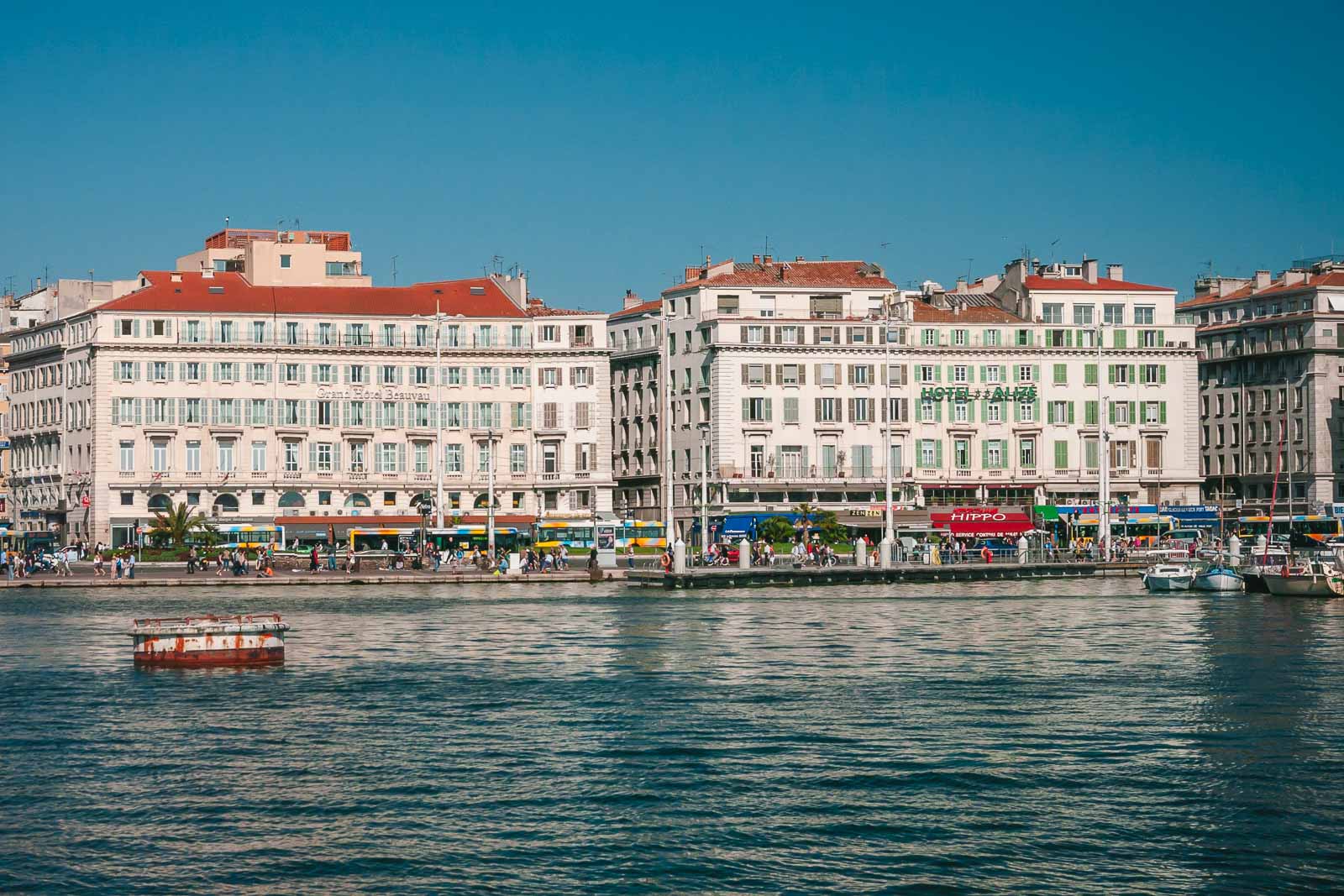
When looking for the best places to visit in the South of France, a great place to start is with the region’s urban areas. South France has some incredible cities and towns. Let’s dive straight in.
1. Toulouse
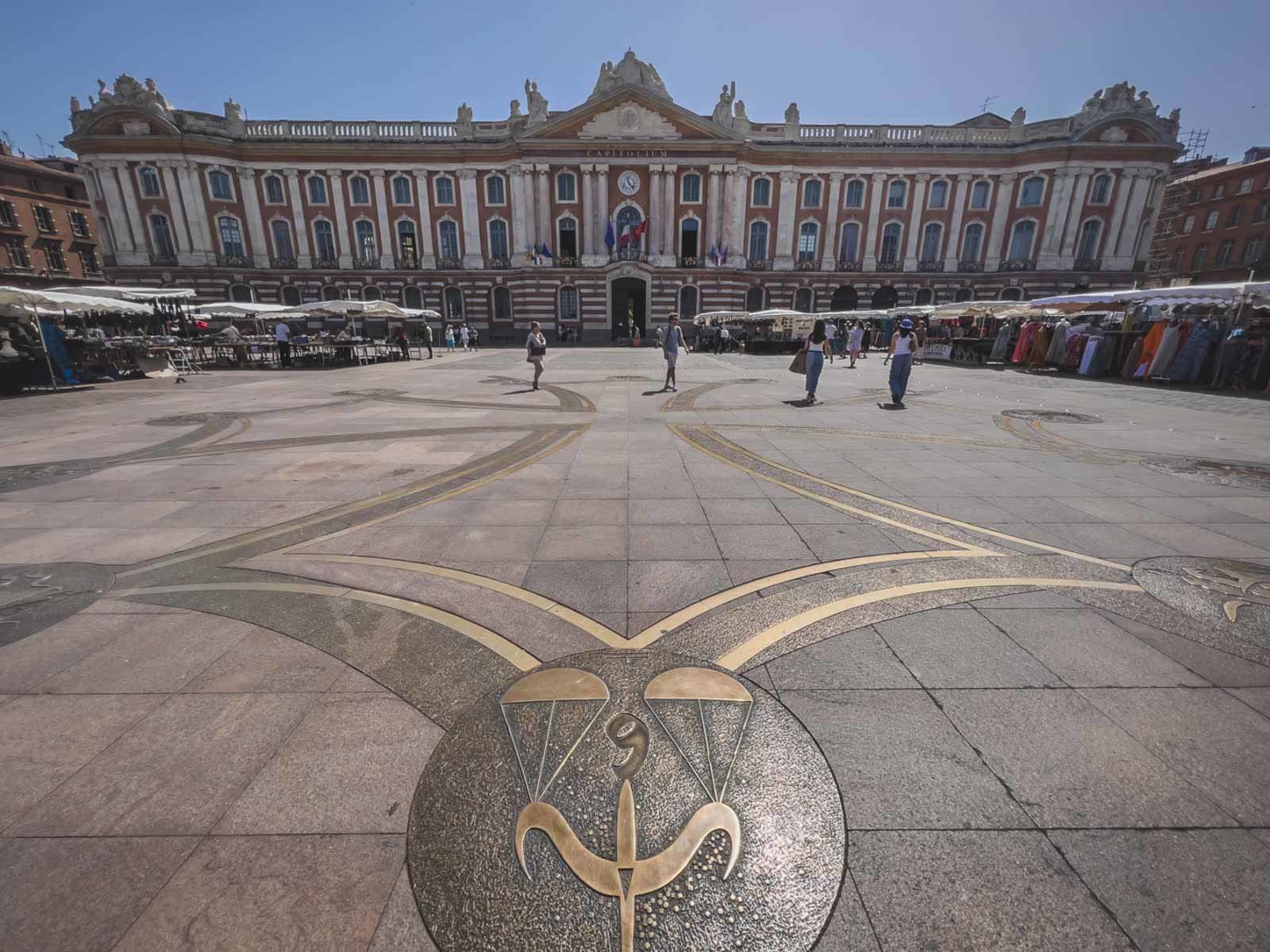
Toulouse was an unexpected city in the South of France, located inland along the Spanish border. The city has the nickname ‘La Ville Rose’, meaning the pink city due to the pink bricks used to build most of its buildings. Toulouse is France’s fourth largest city after Paris, Marseilles, and Lyon and yet it is easy to explore on foot. When visiting Toulouse, you’ll feel as if you are visiting the authentic France with locals dining in outdoor cafes and students relaxing by the river’s edge. It is what we imagine Paris was like 50 years ago.
A bustling university city, Toulouse may be small, but it is filled with energy. There are plenty of attractions to see in Toulouse like the main square of La Capitole, Basilique Saint-Sernin de Toulouse, and the Musee Aeroscopia. Toulouse is the center of the aeronautics and space industry in France and this museum showcases its history and development.
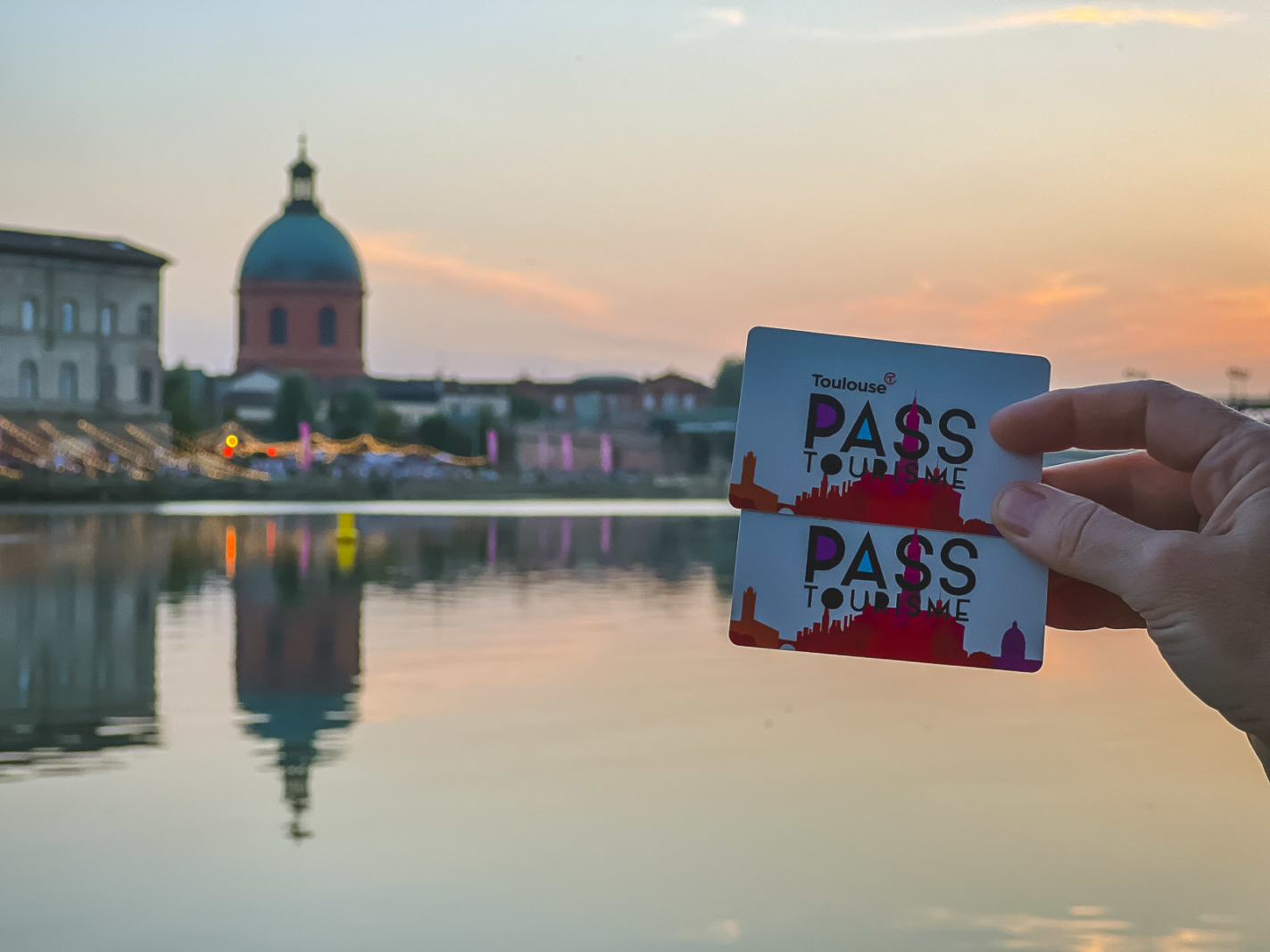
If you go, make sure to pick up a Toulouse Pass to really explore the city. The Toulouse Pass offers 1, 2, or 3-day passes that include public transport and free entrance into most of the city’s most popular tourist attractions.
There is an old town to wander, plenty of museums, and a fairly cutting-edge fashion scene. It is also the starting point of the Canal du Midi which winds its way down 240 km to the French Riviera. Toulouse is a fantastic place to visit in South France, and will definitely keep you entertained. Read more: Best Things to do in Toulouse France
2. Marseille
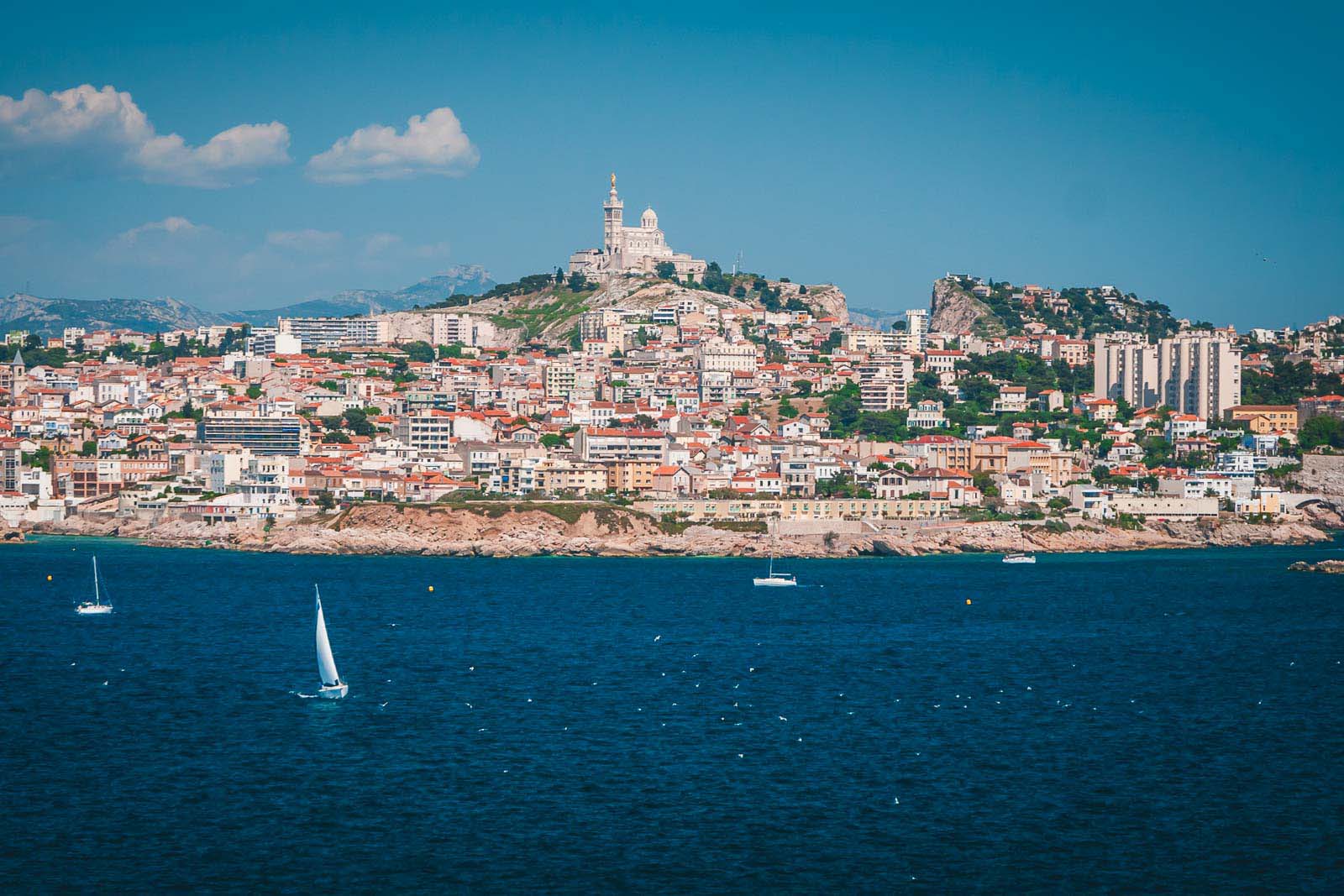
Marseille is the oldest city in Southern France. In fact, it is the oldest city in all of France and it is second in size only to Paris . Located on the Gulf de Lyon, which is part of the Mediterranean Sea, Marseille is the perfect blend of African and French culture. A trading hotspot and port hub since 600 BC, Marseille is one of the best places to visit in the South of France if you want a taste of history and ancient culture.
The most important part of Marseille is its Vieux Port. It is here that fisherman once sold their catch, and hundreds of years later, many still do. You should also visit the Basilique Notre Dame de la Garde, the Musee des Beaux-Arts, and Palais Longchamp.
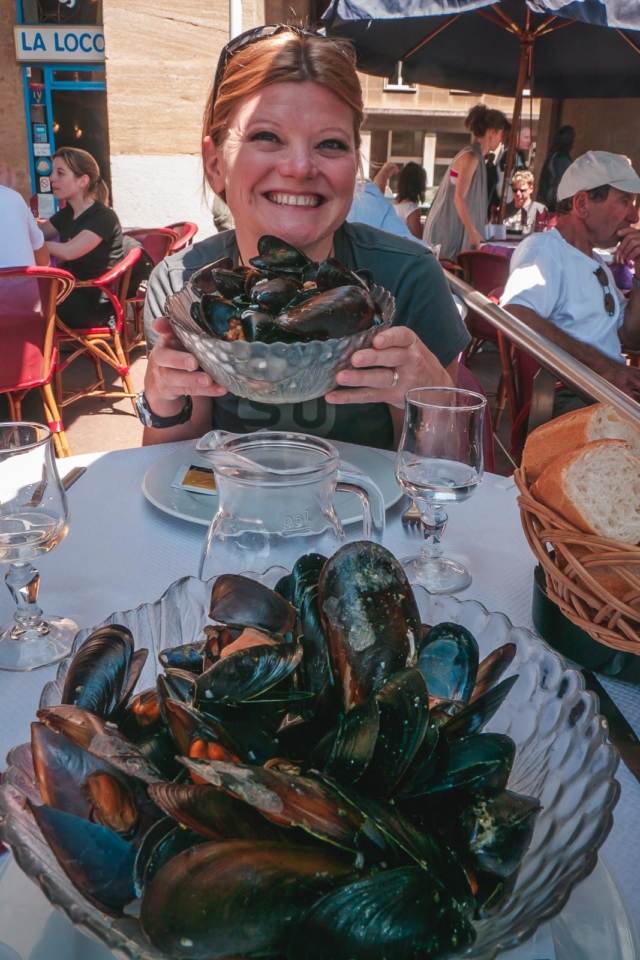
We suggest spending a minimum of three days in Marseille so that you experience the seafood scene, and its best attractions including a day trip out to Chateau d’If made famous by Alexander Dumas in The Count of Monte Cristo written by Alexander Dumas.
When visiting Marseille, we suggest getting a Marseille City Pass – The city pass is valid for 1-3 days and lets you hop on hop off to see all the top tourist attractions. With unlimited access to public transportation plus a tour on the Tourist train to Notre-Dame de la Garde or through the Old Marseille. You’ll have entry to MUCEM, and Regards de Provence Museum, plus crossing Frioul Island, or If Island with entrance to Chateau D’If. There are plenty of discounts, entry to municipal museums, and a guided city tour. See details here.
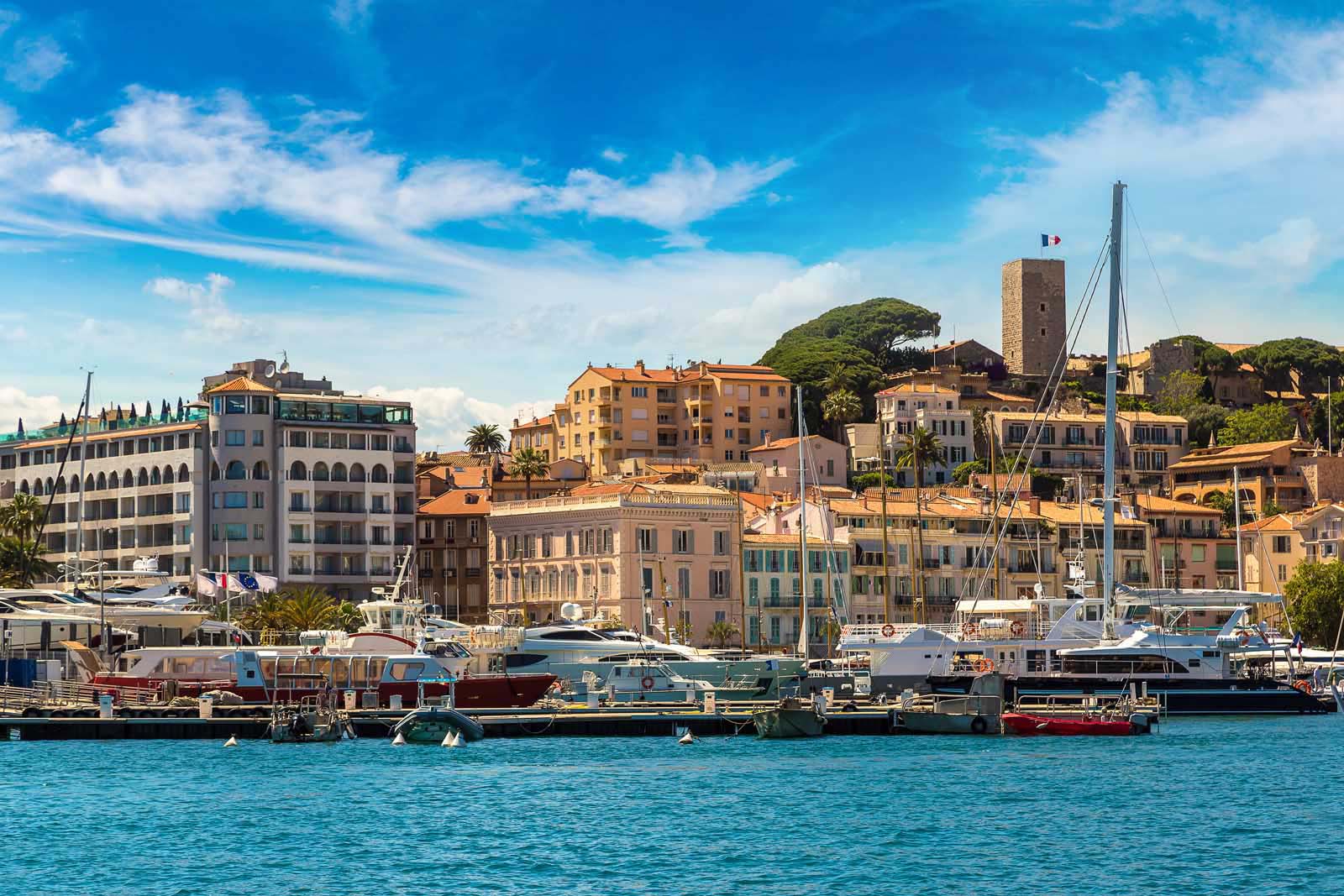
Who hasn’t heard of Cannes? If you are visiting Southern France and craving a city experience, you must visit Cannes. The city is perhaps the most famous spot on the French Riviera thanks to the glitz and glamour it exudes on an annual basis. It is loved by celebrities, and adored for its annual film festival, The Cannes International Film Festival. It has many beloved beaches and cultural attractions as well.
Much of Cannes and its attractions can be experienced by walking (or driving) along the Boulevard de la Croisette. The boulevard spans the Cannes coastline, with stunning views over the Bay of Cannes on the Mediterranean Sea. The Boulevard de la Croisette is lined by luxury hotels, boutiques, and restaurants and caters perfectly to an upscale crowd.
Cannes is best for those who want luxury, resort-style atmosphere. When we visited Cannes, we couldn’t afford the luxury hotels and instead stayed at a campsite just out of town. But we still had the chance to brush shoulders with the rich and famous as we visited the beaches to work on our tans and enjoy a taste of that five-star hospitality.
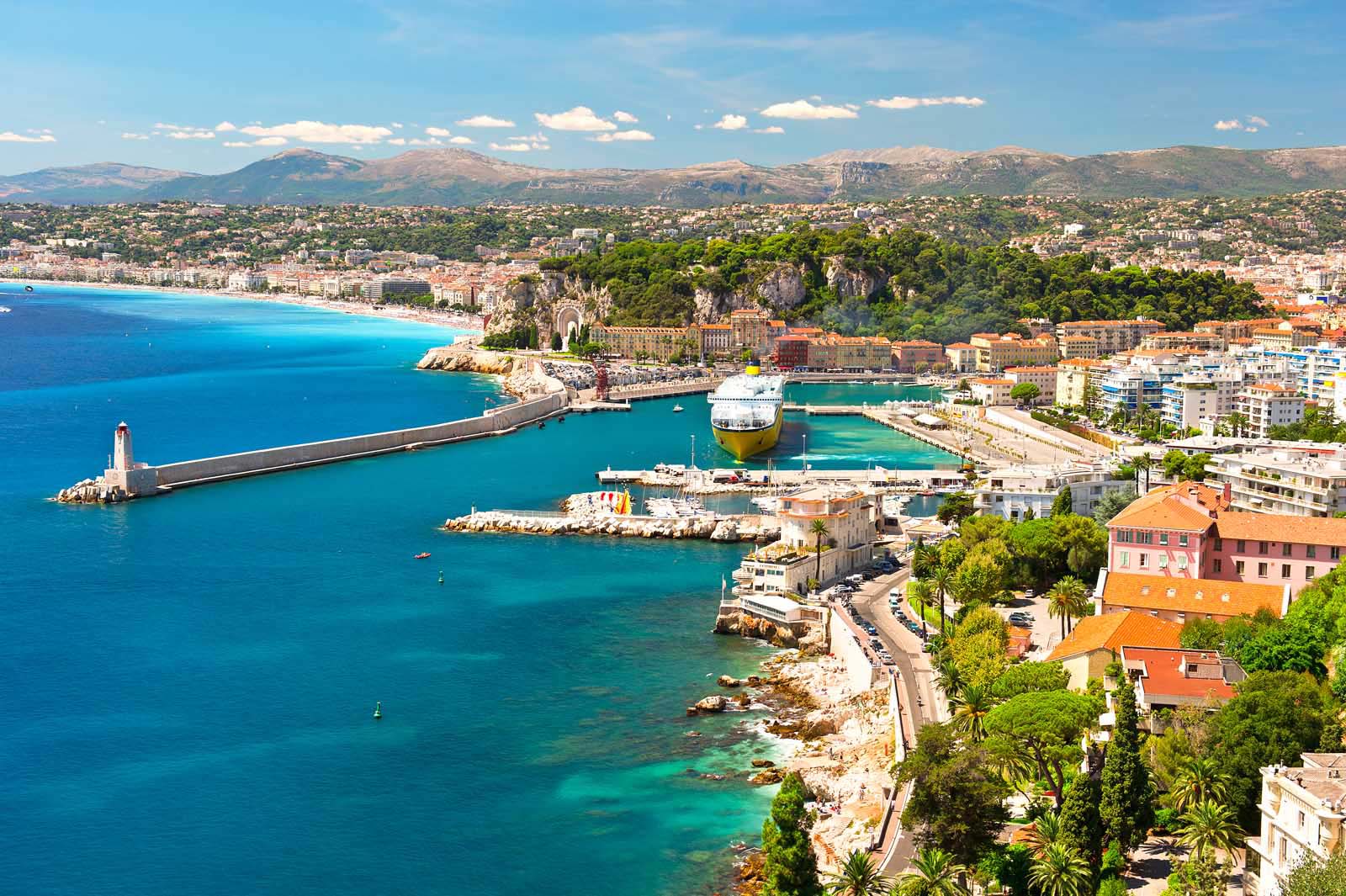
Nice is the biggest city on the French Riviera which makes it one of the top places to visit in the South of France. It has the most urban feel out of all the places on our list and is ideal if you want to feel in the middle of all the action. A good choice for a hotel is Hotel Nice Riviera . This 4-star hotel is one block from the beach with reasonable prices.
Like Cannes, Nice has a scenic stretch of road along its coastline. Promenade des Anglais stretches 7 km and is where you’ll find the majority of attractions and the best ocean views. It is on the Promenade des Anglais that you’ll find the Nice Carnival, which takes place every February or March. You should walk the promenade, Old Town, and make time to visit the Castle Hill of Nice – an old medieval fortress overlooking the city.
Interestingly, Nice is also surrounded by a number of beautiful towns and villages – many of which date back to the Middle Ages. You can spend days relaxing in the city and on its beautiful beaches, taking the odd day trip to a medieval town for the best of both worlds. Read more: 24 Hours in Nice – Sometimes You Only have a Day to See it All
5. Aix en Provence
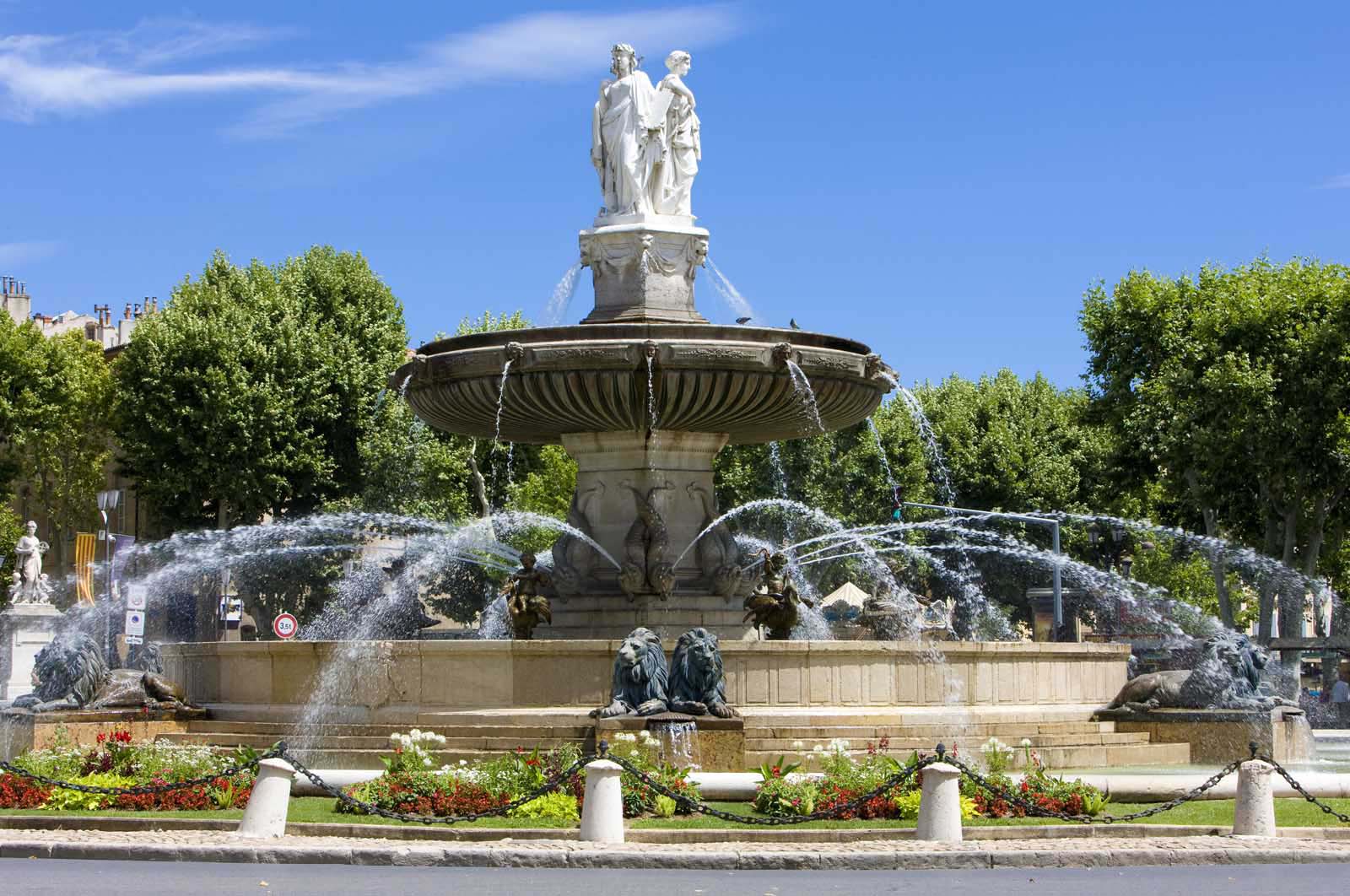
The region of Provence is one of the most magical regions in France, and Aix en Provence is everything you’d expect of a city in southern France. It has class, elegance, and history by the bucket loads. The former capital of Provence is perfect for tourists who value culture when choosing a holiday destination. Aix en Provence has a number of nicknames, including “The city of a Thousand Fountains” and “The City of Counts”. It is packed with things to do and see, and it has a noble atmosphere to match.
Aix en Provence is an artsy university town just 20 minutes north of Marseille. It was also the birthplace and home of the great painter Paul Cezanne. The city is proud of this historical fact and traces of Cezanne can be found everywhere in the city. The Cezanne walk is your best way to see everything Cezanne. This is a fun and interesting self-guided tour that Dave and I did on a sunny afternoon during our visit. Our walking tour took us around the Old Town, visiting Cezanne’s Studio, and Camp De Milles.
Some of the best things to do in Aix en Provence is to explore its art galleries, museums, and other historical attractions. Expect a lively nightlife scene and plenty of temporary exhibitions and events.
6. Saint Tropez
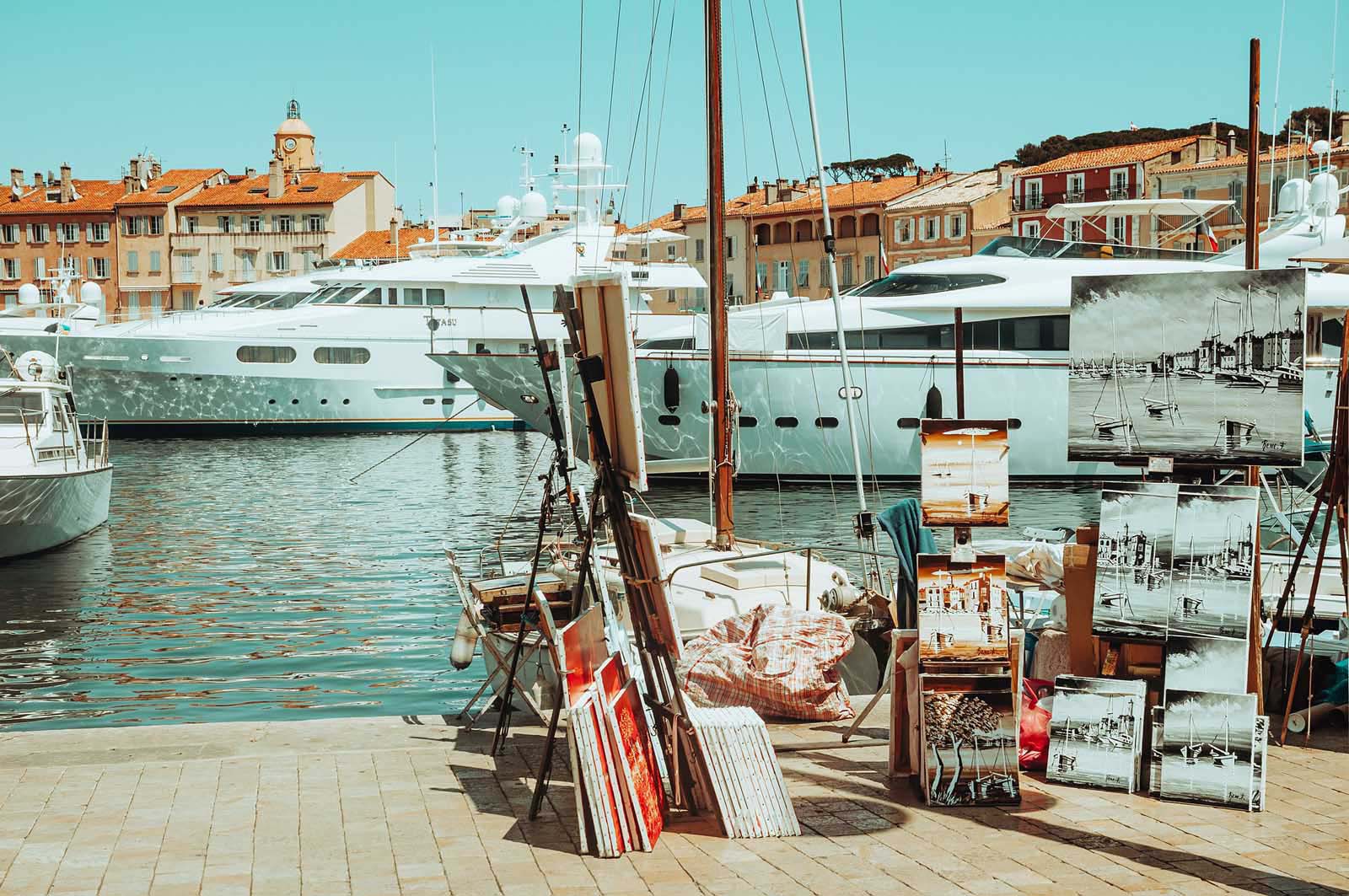
Yearning to be steps away from the ocean? Saint Tropez is the ideal candidate. Saint Tropez is perfect if you want glamour and beauty, yet a quieter feel than big cities like Nice. The small town sits on the French Riviera and was once a little fishing village.
The fishing village shot to popularity after being used as a filming location for And God Created Woman starring Brigitte Bardot in 1955. Since the 1960s tourists have been flocking to one of the most popular places to visit in the South of France, but Saint Tropez has still retained some of its most charming village qualities. You can still spot some little fishing boats in the Old Port, and La Ponche Quarter is still full of narrow streets with cobblestones.
The best beaches in Saint Tropez are Plage de Pampelonne, Plage St. Tropez and Bouillabaisse Beach. However, once you’ve spent a day on the beach make sure to experience the town’s hospitality scene, and don’t miss checking out the central square at the market at Place des Lices. It has a reputation for delicious food and fantastic locally owned restaurants; definitely try the fresh seafood and locally grown olives.
7. Saint Paul de Vence
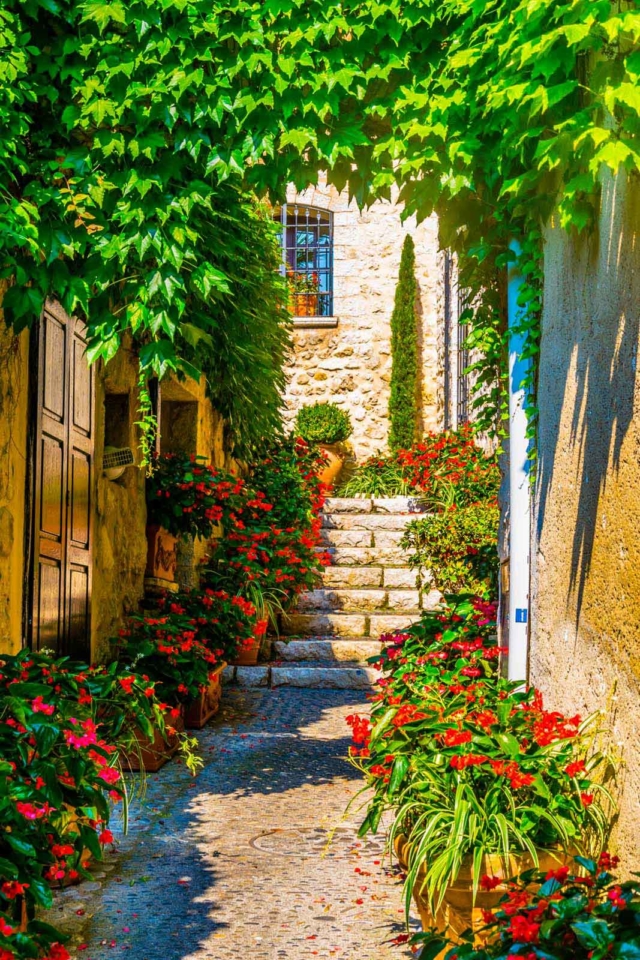
Saint Paul de Vence is one of the oldest medieval villages on the French Riviera. Picture a walled town with cobblestone streets and historical, overhanging buildings. Everything is built from traditional stone and Saint Paul de Vence is the sort of place where every inch of rock feels like it has a story to tell.
The town sits on a hill overlooking the French Riviera. It is relatively easy to visit as a today trip from Nice but, if you can, you should try to stay in the town itself. Saint Paul de Vence feels like somewhere out of a fairy tale. Just walking through its cobbled streets and Old Town (remember a camera) is enough to keep you entertained for a full day.
It was once the home of famous painter Marc Chagall and when you visit one of its top attractions, the Cimetière de Saint-Paul-de-Vence, you will see his grave.
You should also dine at La Colombe d’Or , where the Roux family once let artists such as Picasso, Braque, Calder, and Matisse dine in exchange for now famous paintings. Eating delicious food is even better when you are surrounded by works of art while you eat.
8. Les Baux de Provence
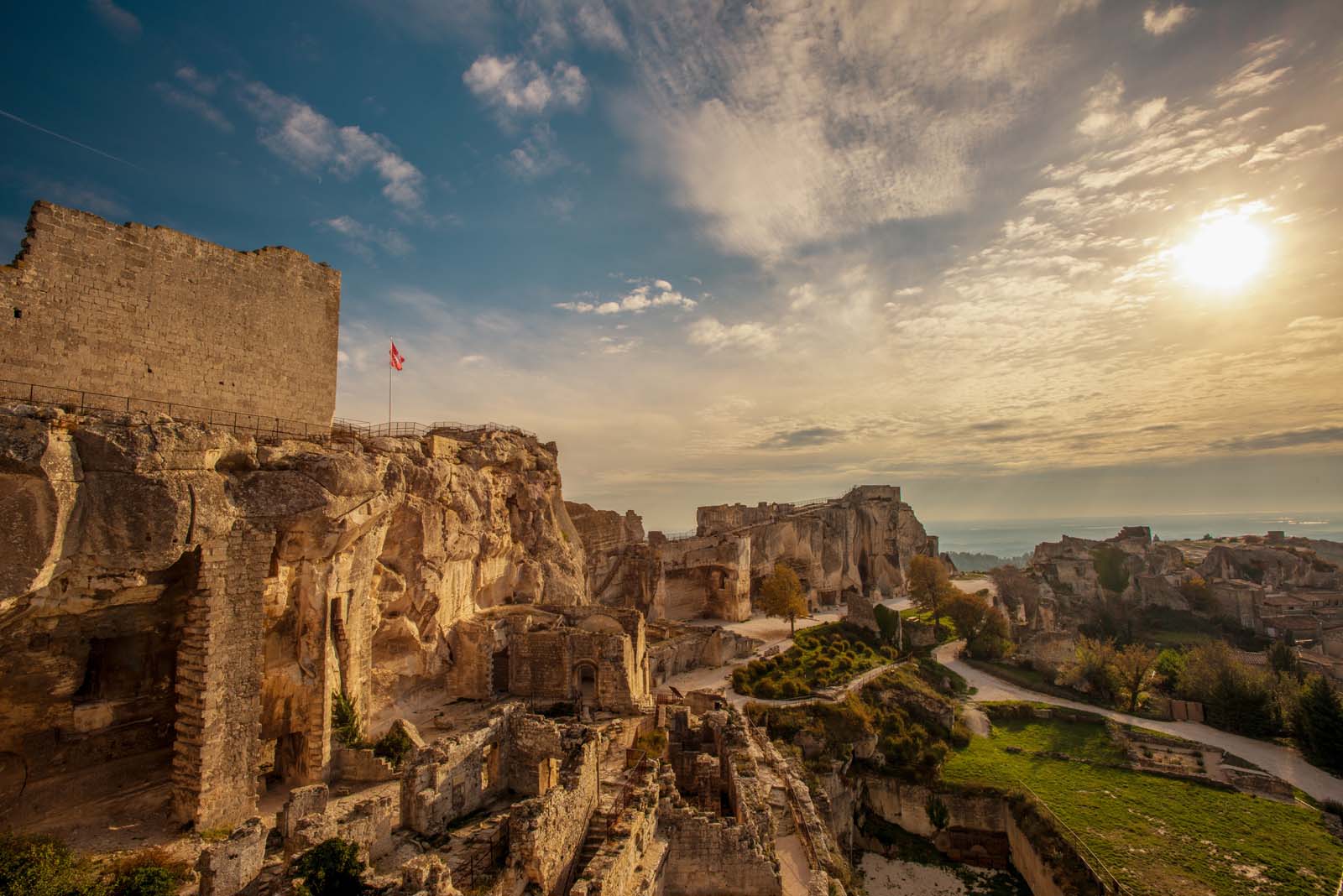
Okay, we may be concentrating on cities and towns but the village of Les Baux de Provence was too beautiful not to include. This hilltop village is still protected by medieval walls and makes a wonderful, memorable getaway. In fact, it is so beautiful that the city is deemed a UNESCO World Heritage Site.
The top attractions in the village are, The ruins of Castillo de Los Baux, a 12th-century castle, and Carrieres de Lumieres. Carrieres de Lumieres (the quarry of lights) is a unique attraction with artwork projected onto the disused quarry’s limestone walls. Art enthusiasts will love the novelty of a digital exhibition, and the artwork displayed changes frequently which keeps the quarry exciting to visit.
Sure, Les Baux de Provence is quiet and distanced from the Mediterranean Sea, however, the village has a film set feel and is bursting with history and charm. If you want a quaint, lesser experienced impression of Southern France, Les Baux de Provence is a fantastic place to visit. You may also like Enchanting Medieval Villages in France – The French Riviera
9. Saint Rémy de Provence
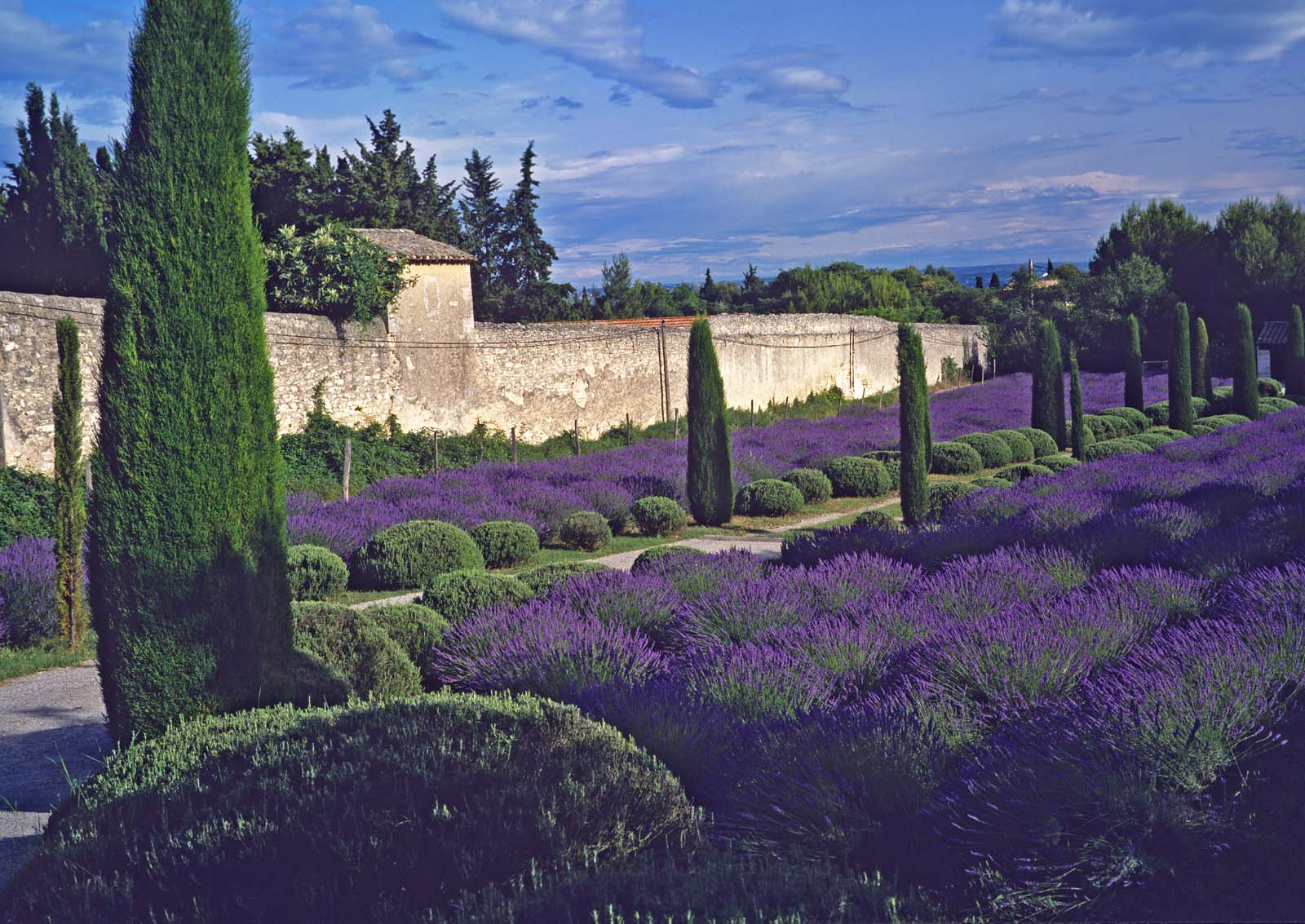
Saint Remy de Provence is another gorgeous, rural town located on the outskirts of the Alpilles Natural Regional Park. Not only does Saint Remy de Provence have beautiful architecture and quiet urban scenery, but its natural beauty was also the muse of a very popular artist.
Vincent Van Gogh lived in Saint Remy for a year, where he checked himself into a mental hospital and began one of his most prolific working periods. It was in Saint Remy that he painted The Starry Night. Whether you are a Van Gogh fan, art enthusiast, or just intrigued, Saint Remy is a great place to learn more about art history.
Musee Estrine Presence Van Gogh is the best attraction for learning more about the artist. Glanum is the best attraction for history and is an old Roman town and extensive archeological site. You can also visit the Monastery Saint Paul de Mausole – the psychiatric asylum where Van Gogh was admitted. Saint Remy de Provence has lots to keep you entertained.
10. Vers Pont Du Gard
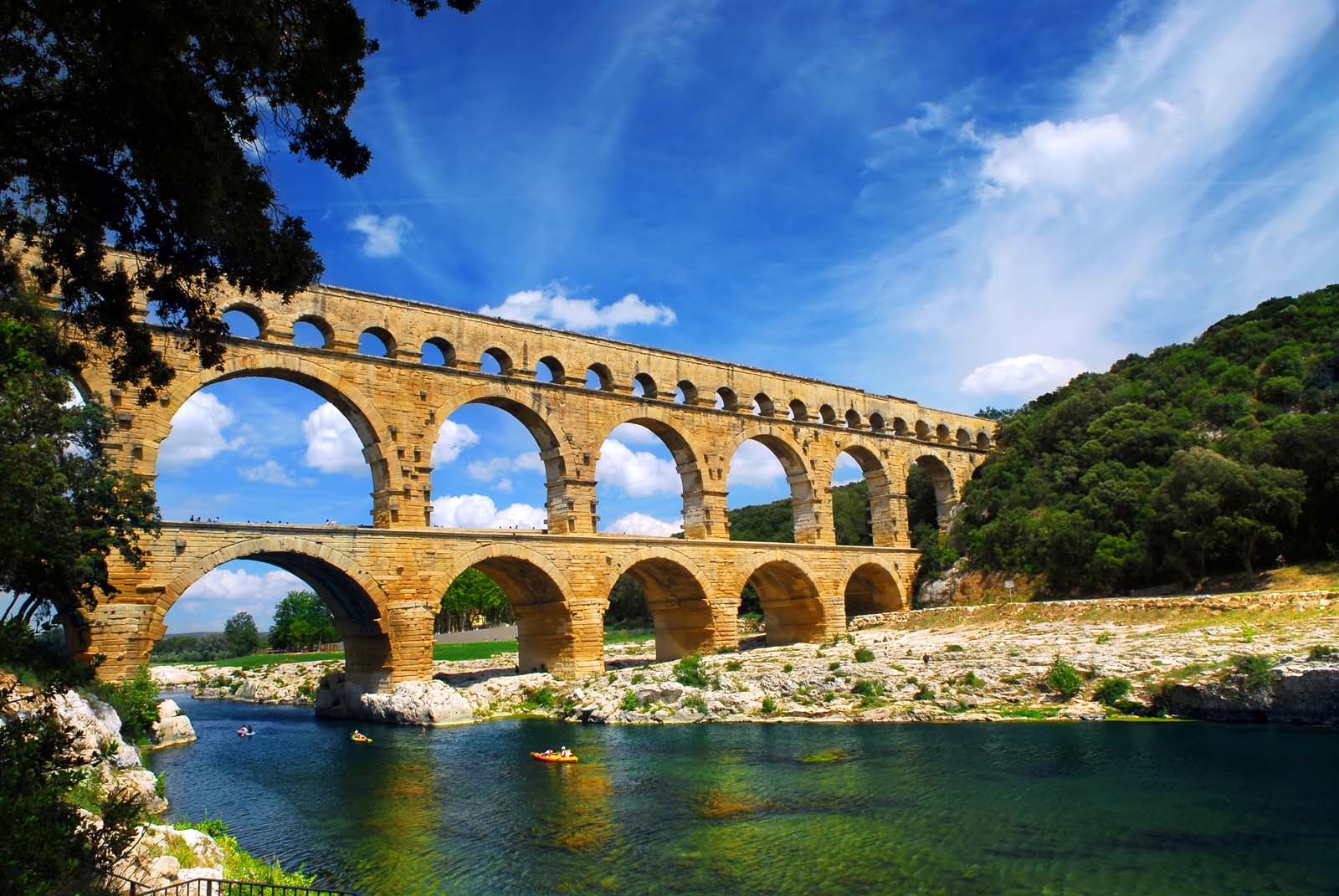
Vers Pont Du Gard is another small town and, like Saint Remy, has lots of surrounding Roman heritage. The most famous Roman attraction is the Pont du Gard bridge and aqueduct, which have been protected and maintained to still stand today. I remember taking our road trip in the South of France and making a detour for the sole purpose of seeing this bridge. Vers Pont Du Gard is full of impressive architecture, and if you like visiting places with character, you will certainly be in for a treat.
Once you’ve visited the town’s bridge, the Pont du Gard Museum and Chapel Notre Dame de Laval are the best attractions to enjoy. You can also swim and fish in the River Gardon. Despite being inland, being located next to a river makes Vers Pont Du Gard an enjoyable destination even in the height of summer. You aren’t sacrificing much by skipping beach days for river days, and taking a dip is refreshing on a hot day.
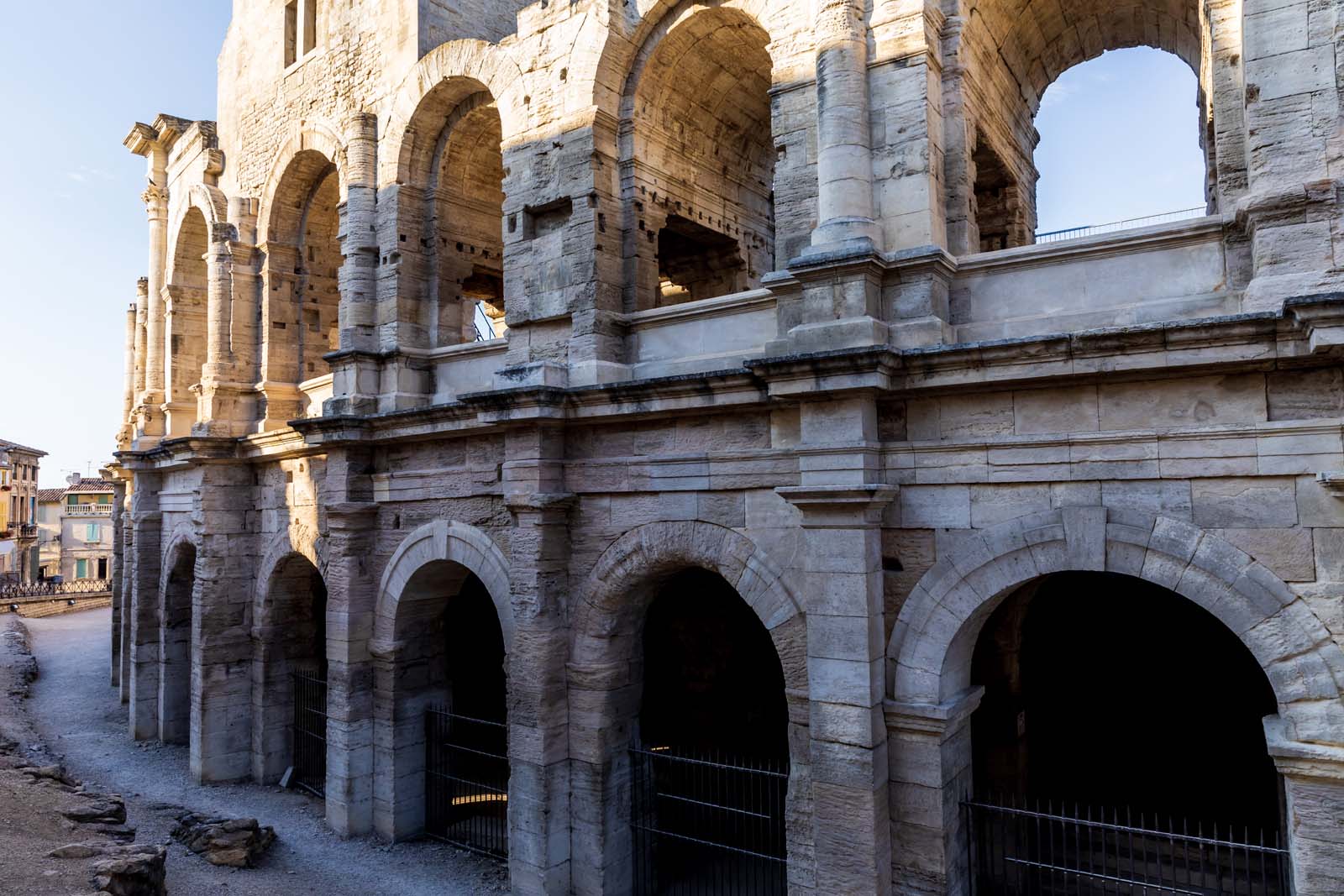
Arles is our final recommendation and easily one of the best places to visit in the South of France. In the ancient Roman period, Arles was once a provincial capital. Today, many of the architecture and historical sites remain – including Arles Amphitheater.
We recommend catching a performance at the Arles Amphitheater, taking a Van Gogh walking tour to see the areas which inspired famous works, and visiting the cloisters at St. Trophime. Arles has lots of religious and artistic history, so allow lots of time for sightseeing.
The city itself sits on the banks of the Rhone River. It is flanked by the Camargue Nature Reserve and, while located inland, is less than an hour’s drive from some of the best beaches on the Riviera. If you are looking to hire a car and explore lots of France, Arles is a wonderful base.
Best natural places to visit in the South of France
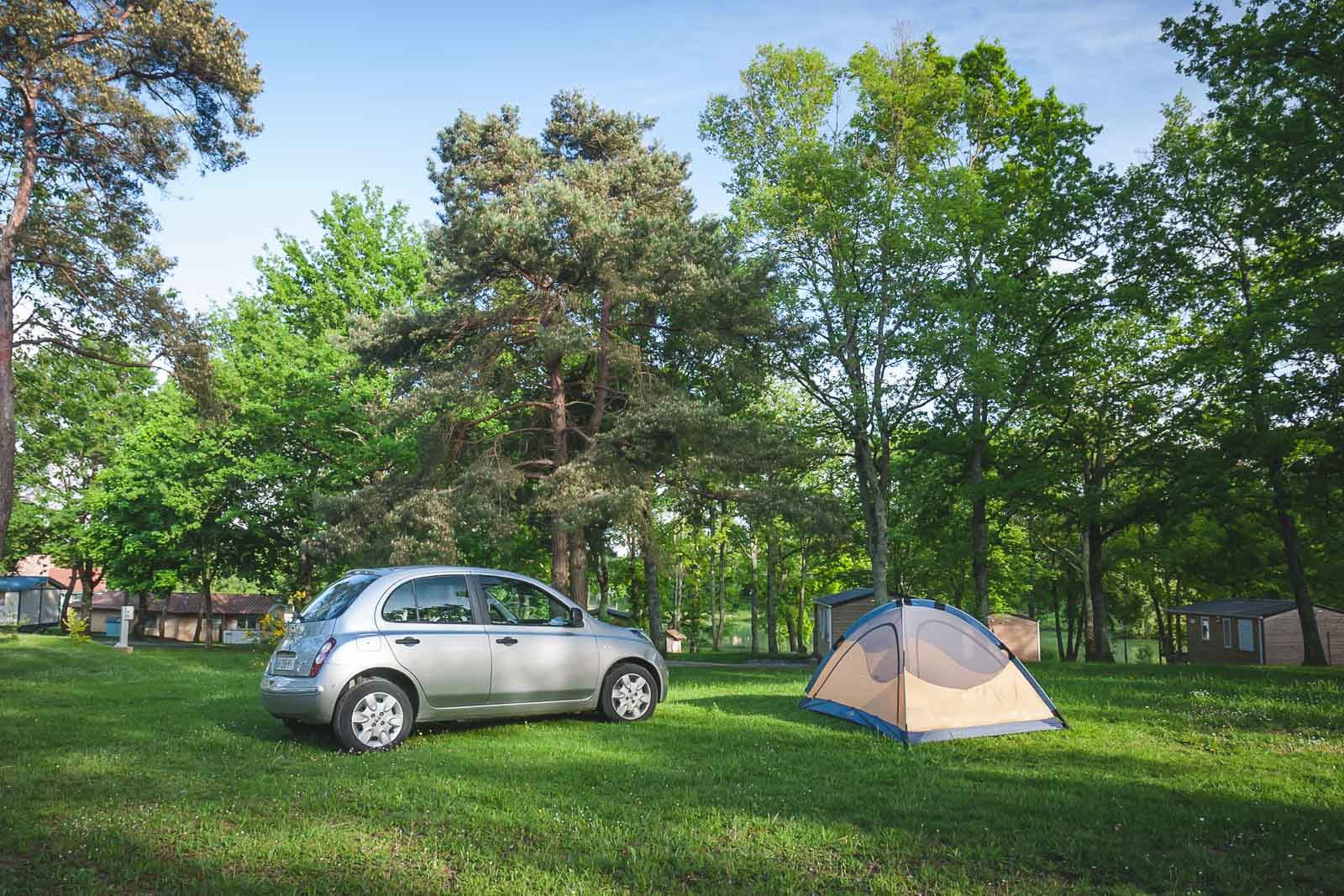
Now that we’ve covered the best cities and towns let’s look at the best natural places to visit in the South of France.
Southern France is full of amazing natural places to visit, whether you want to use them as a day trip or just arrange to stay nearby. You best have a Google Maps account because you’ll need offline maps to head to these spots. These places are the creme de la creme.
12. Verdon Natural Regional Park
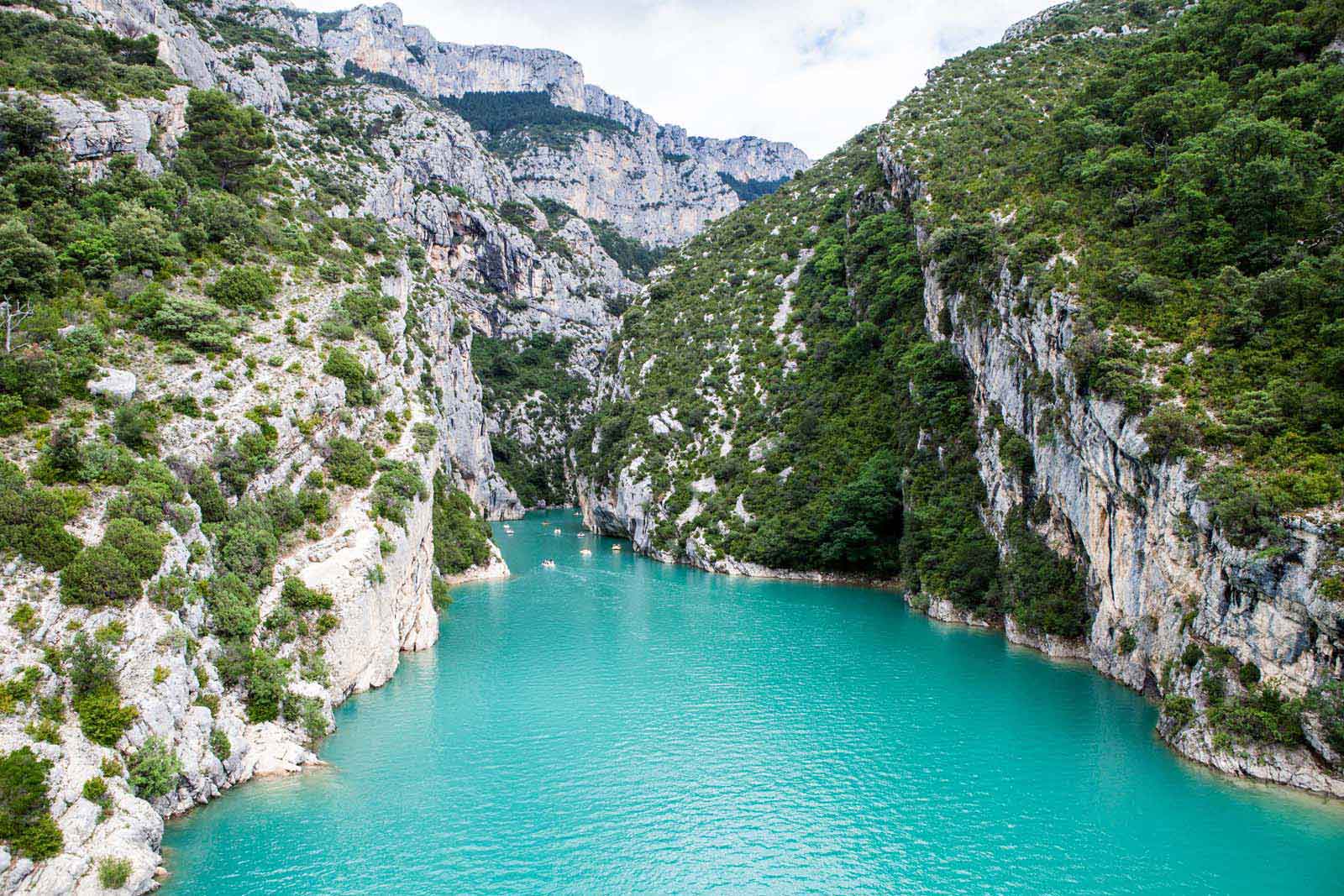
Verdon Natural Regional Park is one of the best places to explore natural attractions, not just hiking trails and beautiful views. Located in Alpes-de-Haute-Provence, the 180,000-hectare park is most known for the Gorges du Verdon and Lake Croix.
The Gorges du Verdon is a 25 km (15.5 miles) long river canyon with a brilliant milky blue river. Expect white water rapids and steep cliffs reaching up to 700 meters (0.4 mi) on either side of the river. This natural wonder is the deepest gorge in France. You can hike to numerous viewpoints, or even book a rafting experience for a bit of extra exhilaration. The Gorges du Verdon is a big deal and is known as France’s answer to the Grand Canyon .
After exiting the Verdon Gorge, the river runs straight out into the Lake of Sainte-Croix. There are three villages along its shores and you can take your pick to grab a bite to eat and go for a swim.
13. Calanques National Park
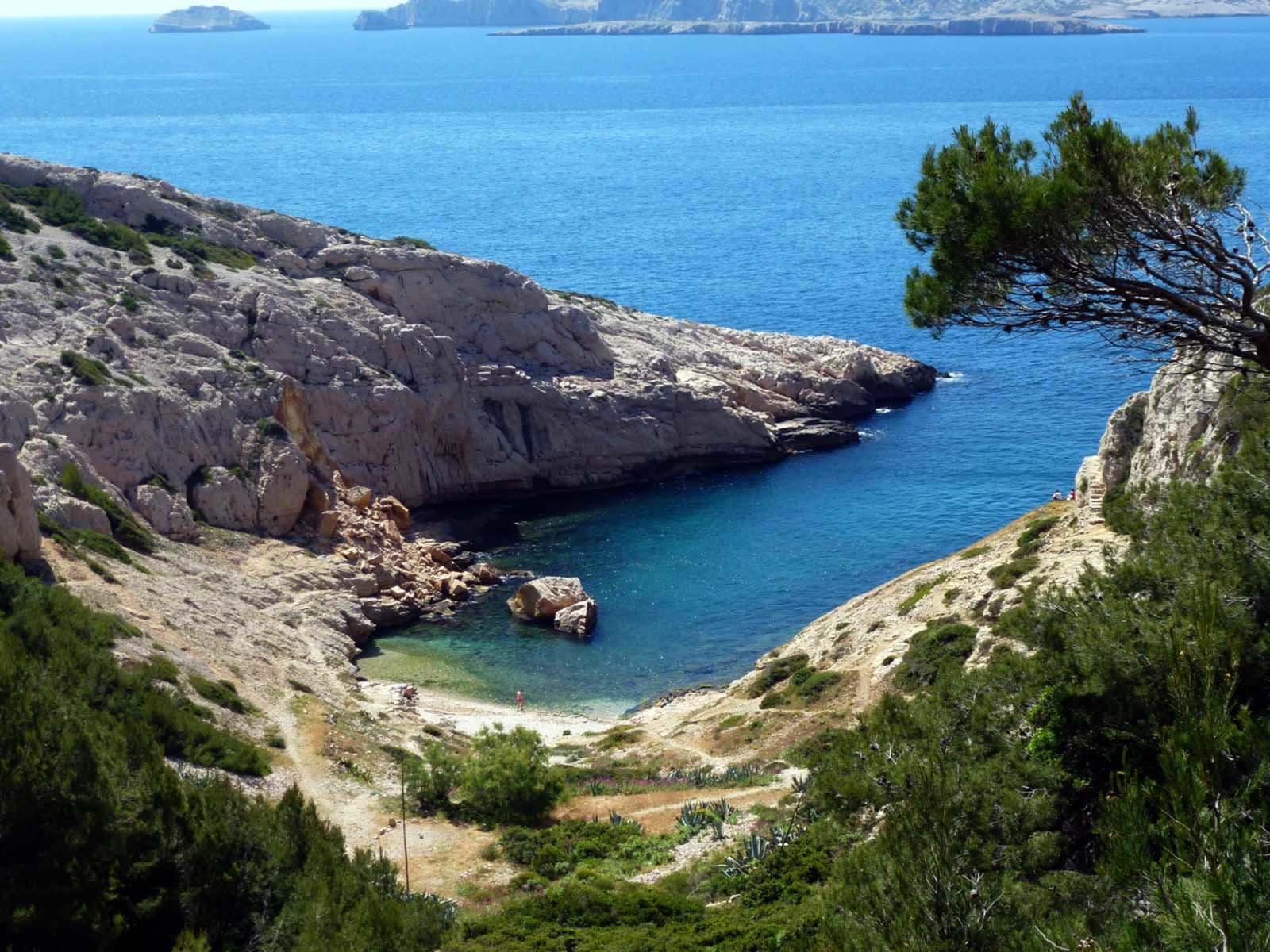
Calanques National Park covers both ocean and land, and the 128,000-acre reserve is situated on the coastline an hour’s drive from Marseilles en route to Cassis. If your idea of heaven is coastal hikes with hidden coves and dramatic cliff faces, then Calanques is a perfect spot. It is the only national park in Europe that is located near urban areas and is both on land and sea.
The word ‘Calanques’ describes a dolomite or limestone inlet – basically dramatic pale grey or white sea cliffs. The park is full of these beautiful areas and you should definitely invest in a good quality camera so that you have pictures to cherish after your holiday.
Keep your eyes peeled while hiking as well, as the marine reserves are popular spots for pods of dolphins. The park has over 140 species of protected animals and plants, which is a nature lover’s dream.
14. Natural Reserve of the Courant d’Huchet
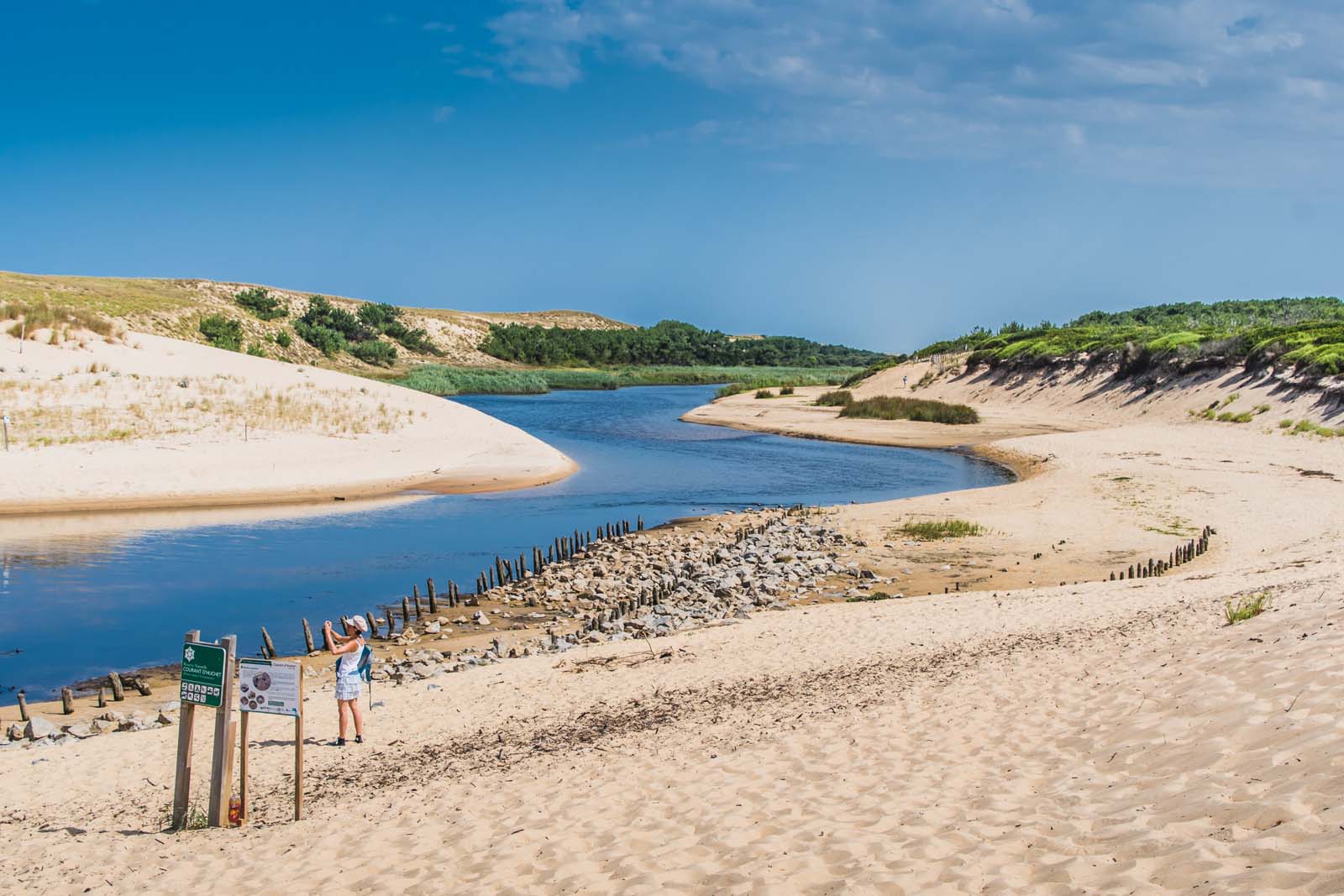
Compared to the other spots on this list, the Natural Reserve of the Courant d’Huchet is tiny. However, it has some of the most striking landscapes and is easily one of the best natural places to visit in the South of France. It is located an hour’s drive north of Biarritz and makes for a fantastic day trip.
The reserve is primarily marshland but has a beach in the midst of the park. The beach contains high hills of sand dunes that beautifully contrast the surrounded marshes and forest. Visitors can head to the beach to swim and climb the sand dunes.
You can also hike the network of trails, spotting native animals and flora as you walk. If you want something really different though, we recommend a boat tour. You can hire a boat to explore independently or take a tour for a more informative experience – whichever takes your fancy.
15. Baronnies Provencales Regional Natural Park
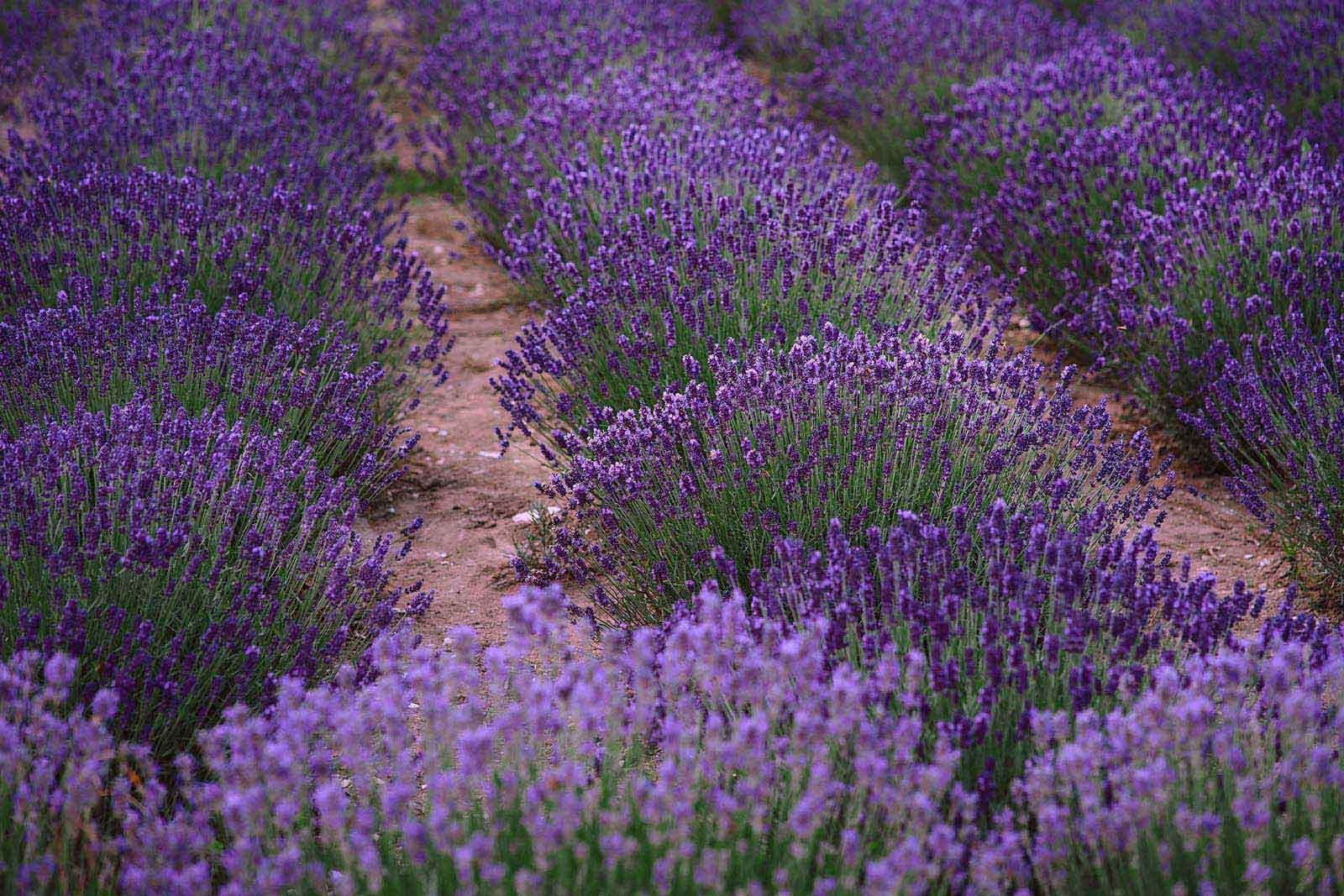
Have you ever seen those artsy lavender field photos plastered all over Instagram? Well, Baronnies Provencales Regional Natural Park is where you can take your very own. Apart from its remote villages and low-lying mountains, Baronnies Provencales is full of lavender fields. If you visit the South of France between June and September, you should definitely make your way to the park to see them.
Baronnies Provencales Regional Natural Park is about an hour and a half drive from Avignon. You could visit on a day trip or find accommodation in one of the park’s villages. Apart from the lavender fields, you’ll find thousands of hiking trails and other outdoor activities.
16. Regional Park of Camargue
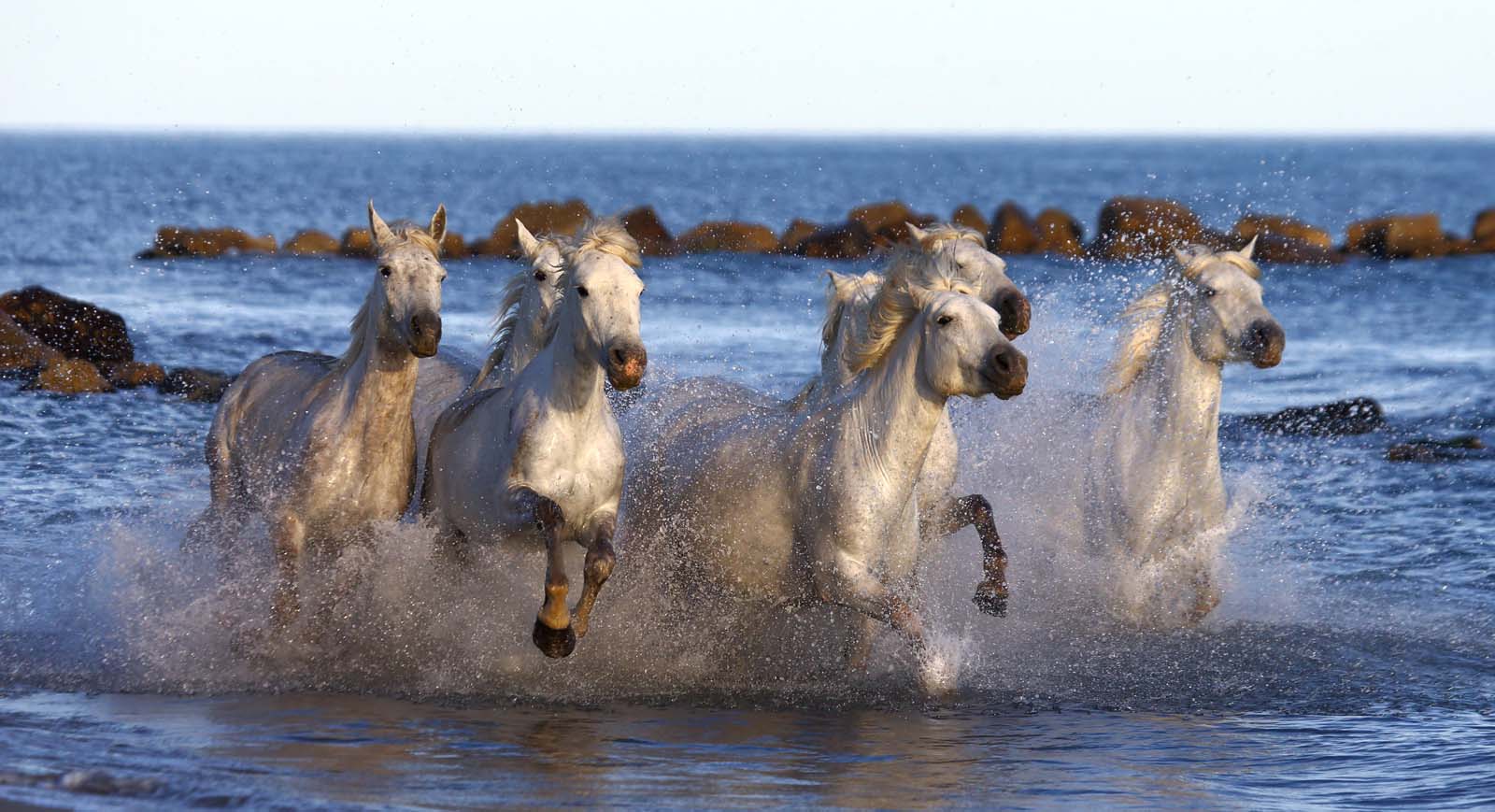
Camargue Park is famous for many things, including the once wild herds of Camargue horses. The Camargue horses are highly prized in France and are considered to be one of the most ancient horse breeds in the world. While breeding is strictly regulated now, you might still be lucky enough to spot a semi-feral herd.
Apart from the horses, Camargue Natural Regional Park features wetlands, rough grazing areas, and a marine reserve. It is also located along the coastline, just outside of Marseilles and near the city of Arles.
The best things to do in Camargue are animal related. You can spot flamingoes at Ornithological Park of Pont de Gau and visit a ranch to take a horseback ride out to spot the semi-feral horses from afar.
17. Alpilles Regional Nature Park
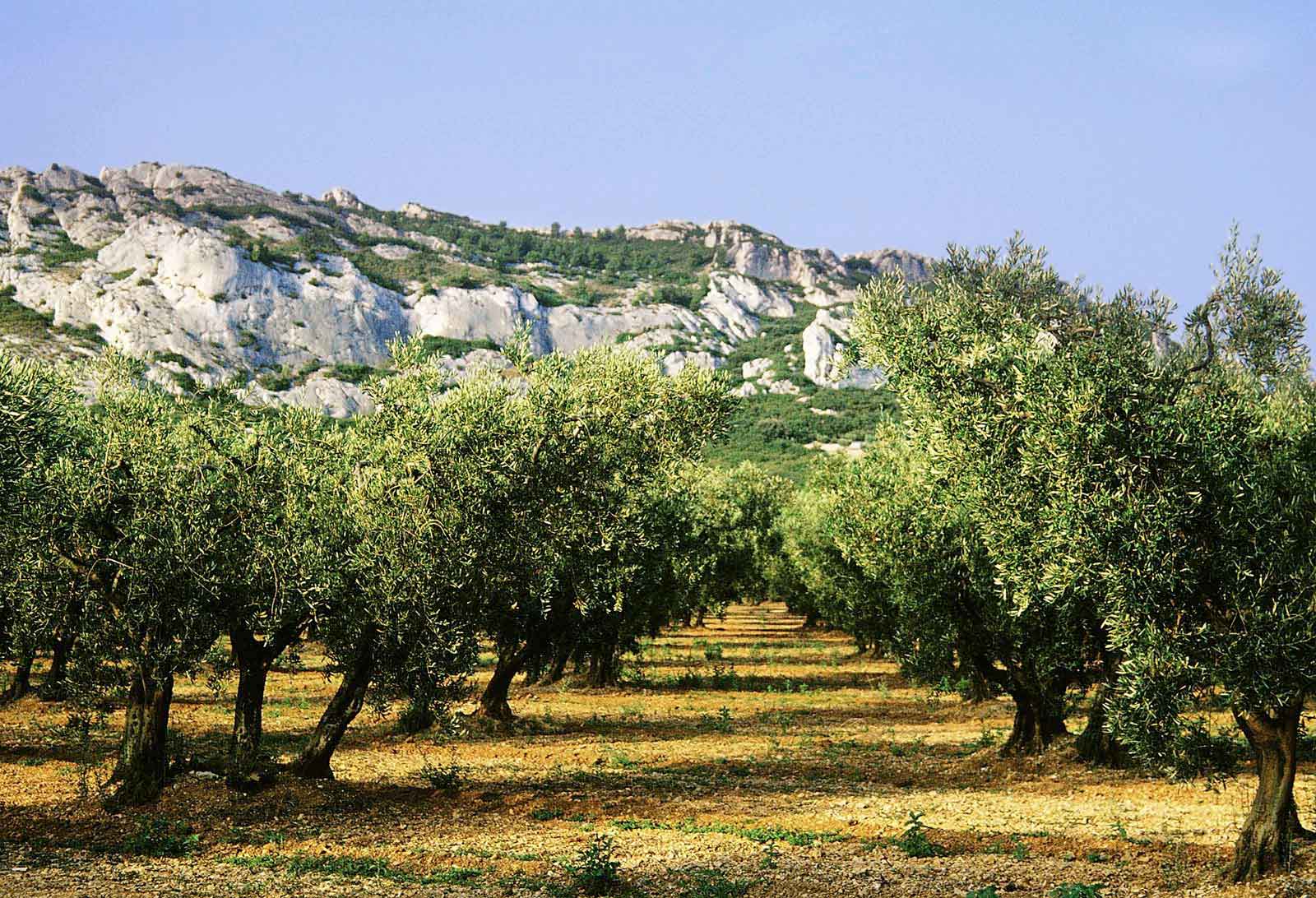
Fancy getting active? Alpilles Regional Nature Park has the most to offer in terms of biking, hiking, and horseback riding trails with plenty of equestrian centers. With all its limestone rock formations and cliffs, there is plenty of climbing opportunities as well.
Alpilles has a great mix of activities. Whether you want history, culture, a fitness challenge, or a new profile picture, Alpilles has enough diversity to match your needs. It is a walkers paradise with hiking trails through pine forests, olive groves, and vineyards.
You can also easily visit the castle, and quarry art display in nearby Les Baux de Provence which we already mentioned above.
18. Sainte Baume Natural Regional Park
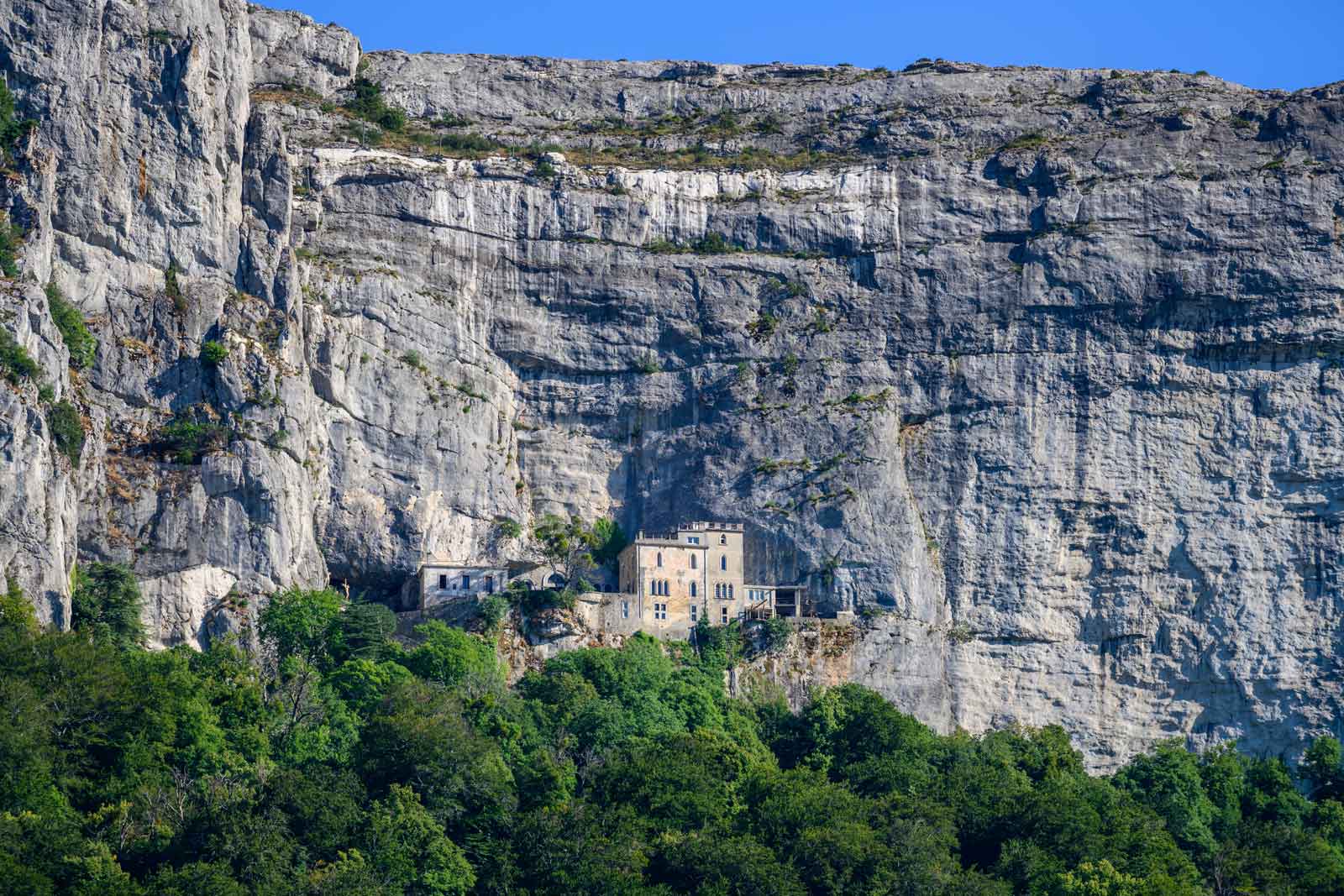
Sainte Baume Natural Regional Park is where the alpine meets the Mediterranean. The park is full of dramatic limestone mountains, ridges, and pine tree forests.
Climbers will love Saint Baume, which is centered around a long mountain ridge. There’s a great range of climbing routes to explore, ranging in difficulty and style. Sainte Baume also holds lots of religious significance. Visitors will find a grotto where Mary Magdalene allegedly lived. The site is popular amongst pilgrims and can be reached via a pretty forest path in around forty minutes.
19. Pyrenees National Park
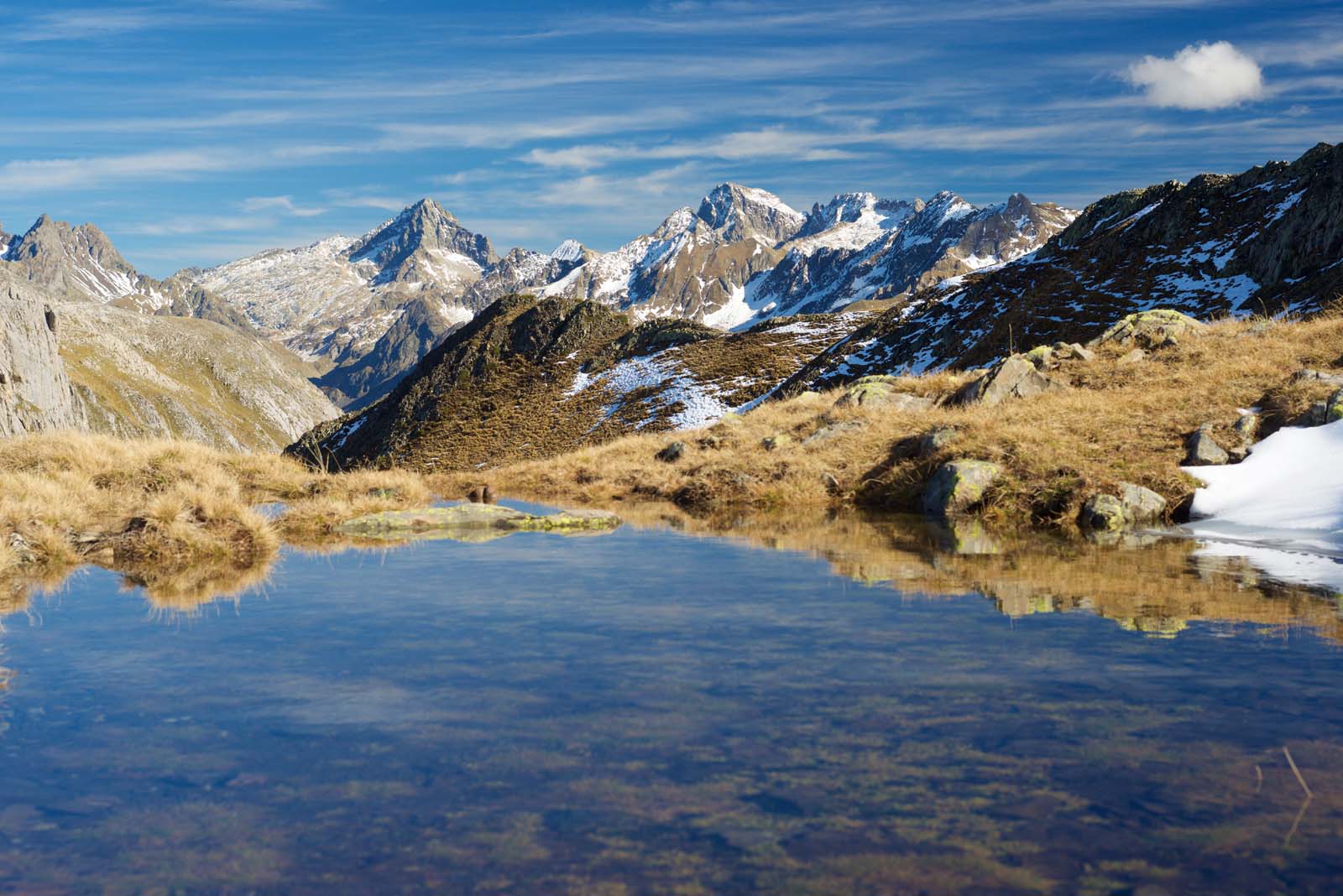
Pyrenees National Park is one of the best places to visit in the South of France. The park sits on the French-Spanish border and we were surprised to find them in South France. We had known the Pyrenees from our time in Spain, but we always thought of them as further north. We were surprised to see the mountains while cruising in 40-degree heat to Carcassonne.
From alpine meadows and high-altitude lakes to towering, craggy mountains, the park is stunning. If you want an exciting, beautiful place to visit in Southern France, Pyrenees National Park is bucket list worthy.
Cirque de Gavarnie is one of the most famous attractions in the Pyrenees of France. A cirque is a large cliff face that curves in shape like a huge, natural amphitheater. Cirque de Gavarnie is best known for its many waterfalls, which cascade down the cliff walls.
Apart from the Cirque de Gavarnie, the park is full of hiking trails, endless outdoor activities, and climbing opportunities. If you love mountain climbing in particular, you’ll love it here.
20. Landes de Gascogne Regional Natural Park
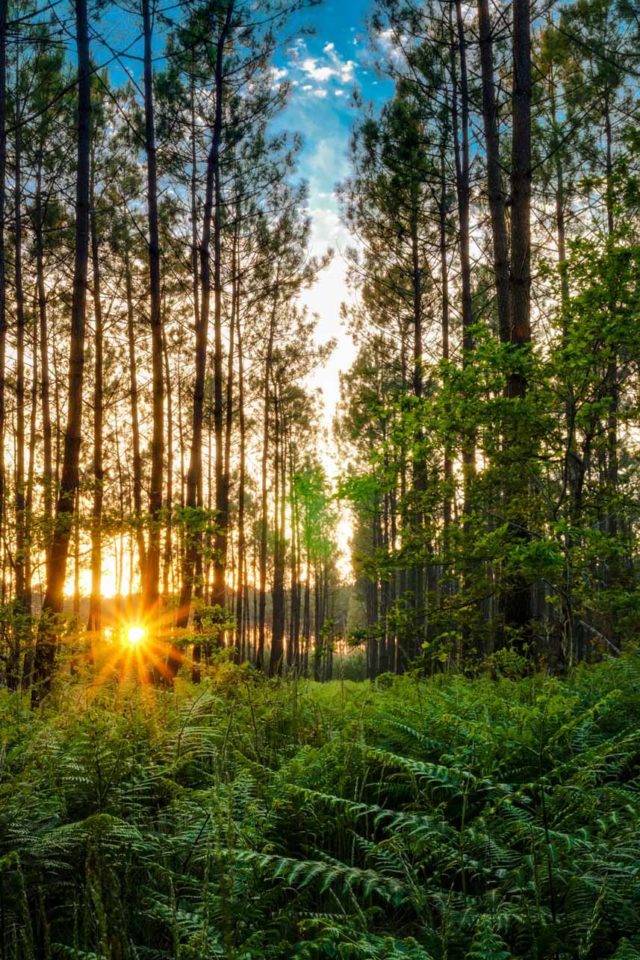
Landes de Gascogne Regional Natural Park is a nature reserve first and foremost, which we love. The park caters to tourism but in environmentally friendly ways, and there are attractions like an eco-museum and bird sanctuary to visit.
The park sits in southwest France, including some coastal areas and some inland. Visitors can kayak down rivers, swim in natural lakes, or hike the numerous trails. Landes de Gascogne is a serene, beautiful park that is bursting with nature. Visitors can cherish being surrounded by hundreds of different species of flora and fauna.
21. Narbonnaise en Mediterranee Natural Regional Park
Narbonnaise en Mediterranee is a diverse region. You’ll find beaches, cliffs, forests, and even vineyards. The vineyards are particularly popular, and some people refer to the park as the land of wine.
You can go wine tasting, take a hike, or go for a camping getaway. Narbonnaise en Mediterranee is about an hour and a half’s drive from Montpellier and Toulouse. It sits on the Mediterranean coastline and is ideally combined with a beach holiday. If you want somewhere to wine taste and explore, it is a small, beautiful, and easy natural place to visit in Southern France.
22. Mercantour National Park
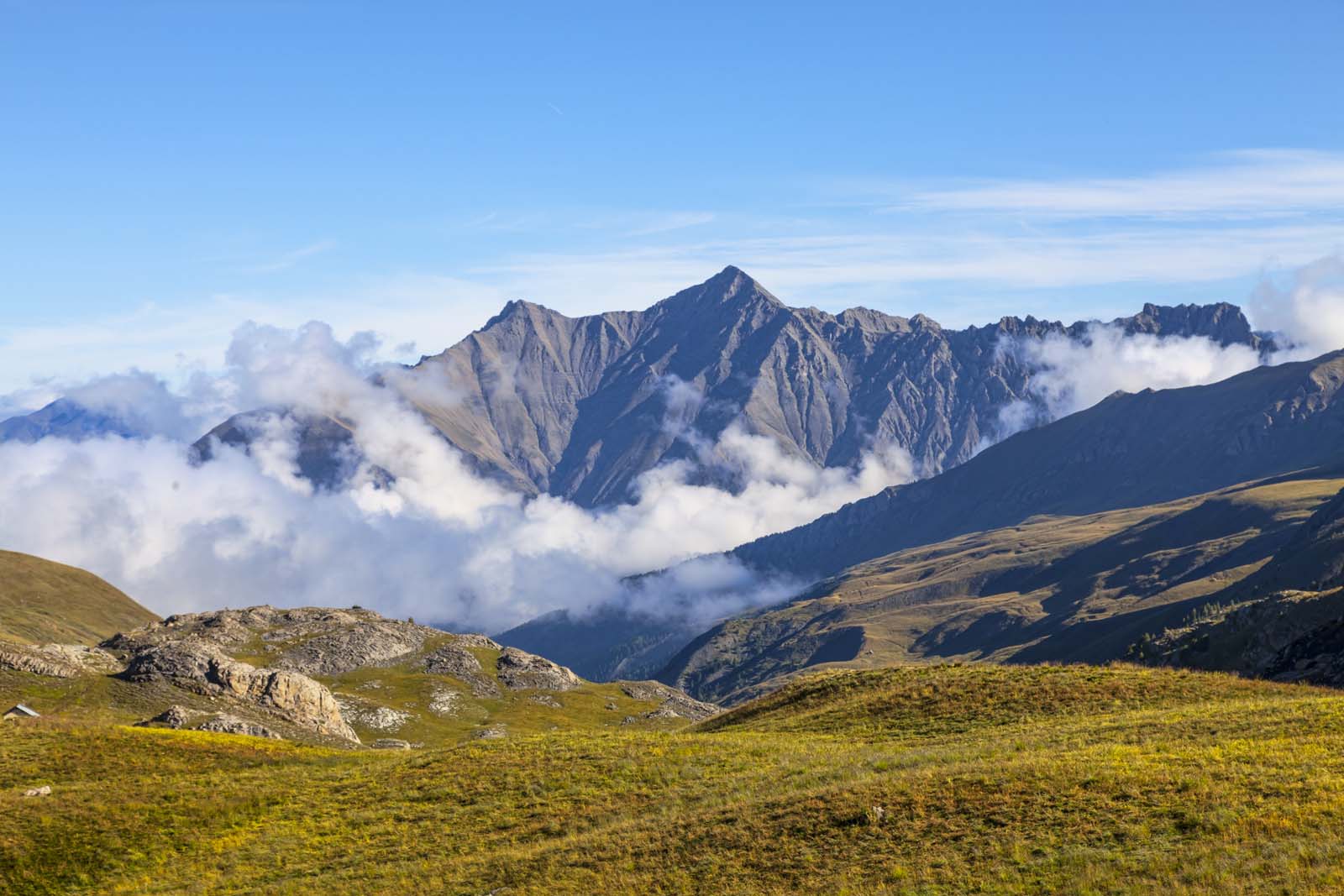
A stunning 167,297-acre park, Mercantour is a mixture of alpine lakes, irregular mountain ranges, and lots of scenic hiking trails. Even better? It is just an hour’s drive away from Nice.
The park is diverse and relatively unvisited compared to France’s other national parks. For those that make the trip though, there are endless rewards. You’ll discover tiny villages and mountain communities where many people still live off of the land. You can sample decadent cheeses and sumptuous honey and maybe even bring some home as a souvenir.
After appreciating the cultural side of Mercantour, you can dive straight into its outdoor activities. Hike, bike, climb, swim, and ride until your heart is content.
It’s no secret that the South of France is mesmerizing. This is just the tip of the iceberg of places to visit in the South of France.
We hope that this helped give you a sense of what you can see and do from walking cobblestone streets in medieval towns or lazing on sandy beaches on the shores of the Mediterranean Sea. All of these places to visit in the South of France are worth visiting. Glamorous, historical, and naturally beautiful, the South of France is sure to guarantee memories for a lifetime.
Plan Your Next Trip to France With These Resources
- 22 Beautiful Cities in France To Visit
- Where To Stay In Paris – Best Neighborhoods and Hotels
- 3 Days in Paris: The Best Paris Itinerary for Your First Visit
- French Food: 24 Traditional Dishes To Try in France or At Home
- 11 Interesting and Fun Facts About France
- 27 Free Things to do in Paris, France
Travel Planning Resources
Looking to book your next trip? Why not use these resources that are tried and tested by yours truly.
Flights: Start planning your trip by finding the best flight deals on Skyscanner
Book your Hotel: Find the best prices on hotels with these two providers. If you are located in Europe use Booking.com and if you are anywhere else use TripAdvisor
Find Apartment Rentals: You will find the cheapest prices on apartment rentals with VRBO .
Travel Insurance: Don't leave home without it. Here is what we recommend:
- Allianz - Occasional Travelers.
- Medjet - Global air medical transport and travel security.
Need more help planning your trip? Make sure to check out our Resources Page where we highlight all the great companies that we trust when we are traveling.
You May Also Like
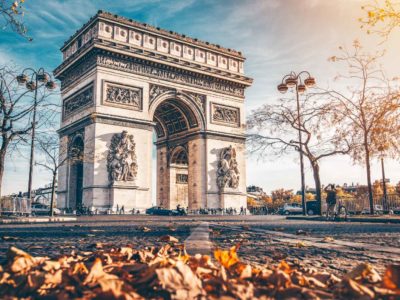
20 Best Museums in Paris To Visit in 2024
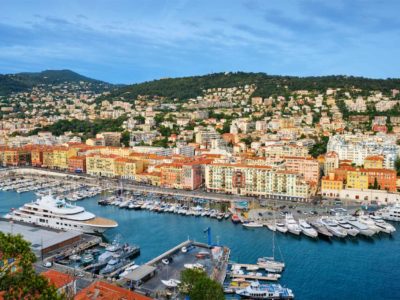
26 Amazing Things To Do In France in 2024

Ultimate One Day in Paris Itinerary – How to See Paris in a Day
About ThePlanetD Team
Guest writers for The Planet D offer insider tips and information on destinations that they are experts in. We can't be everywhere at once, and it is important to have the highest level of travel information from local writers and experienced travelers.
Join thousands of others who get our monthly updates!
Leave a comment cancel reply.
Save my name, email, and website in this browser for the next time I comment.
- Skip to primary navigation
- Skip to main content
- Skip to primary sidebar
- Skip to footer

The Mindful Traveller
Eco Travel Blog & Photography
20+ Best Places to Visit in The South of France
9 December 2023 · In: France , Travel

Are you looking for the best and most beautiful places to visit in the South of France ? You have come to the right place! This article walks you through 20 locations to add to your bucket list for an unforgettable sunny vacation, whether you are travelling as a couple, family with children or with friends.
The South of France, including the French Riviera or Côte d’Azur , is a stunning region with a lot to offer ! From picturesque hilltop villages and spectacular landscapes to pristine beaches and delicious local cuisine, you will find plenty of things to do and places to see on a holiday full of surprises and hidden gems.
Even though France is my homeland, I am constantly discovering something new . My trip to the South and Provence was one of those moments where I felt like I was in another country ! It is a unique and authentic destination where time stands still, a place that will truly recharge your batteries.
So, are you ready to discover the top 20 South of France places that you must visit ? Let’s get started! And, of course, let me know in the comments below if you have any other suggestions ☀️
Disclosure : Some of the links below are affiliate links, meaning that at no additional cost to you, we will receive a commission if you click through and make a purchase. For more information, read our full affiliate disclosure here .
Overview: must-visit South of France places
1- Avignon & Pont du Gard 2- Nice 3- Aix-en-Provence 4- Carcassonne 5- Arles & La Camargue 6- Hilltop Provence villages 7- Cassis & Les Calanques 8- Albi 9- Moustiers-Sainte-Marie & Verdon Gorge 10- Valensole & Lavender Fields
11- Menton 12- Île de Porquerolles 13- Marseille 14- Saint-Tropez & Port Grimaud 15- Montpellier 16- Antibes 17- Grasse 18- Cannes 19- Biarritz 20- Monaco

Top sights in Southern France – Map
Click on the top left of the map to display the list of stops and locations.
20+ best places to visit in the South of France

Remember that this list is only a recommendation! You will find many other beautiful places to explore in the South of France, whether you are travelling for a short weekend getaway or a week-long vacation.
Avignon, nestled on the banks of the Rhône River in southeastern France, is a stunning city steeped in history and cultural richness . Renowned for its medieval Papal Palace (Palais des Papes), a UNESCO World Heritage Site, and the iconic Avignon Bridge (Pont Saint-Bénézet), the city was once the centre of the Catholic Church under the Avignon Papacy.
Stroll through its charming Old Town with narrow streets, bustling squares and a vibrant atmosphere, and do not miss the annual Festival d’Avignon , a celebrated theatre festival attracting artists and spectators from around the world.
Avignon is, without a doubt, a captivating travel destination for all ages, perfectly blending its historical legacy with a contemporary and picturesque charm – a must-visit on a trip to the South of France.
READ MORE: Most Scenic Road Trips in France: 12 Epic Routes
BEST THINGS TO DO & SEE IN AVIGNON
- Explore the Palais des Papes
- Visit the Musée de Petit Palais
- Cross Pont Saint-Bénézet
- Wander through the Old Town
- Shop local at Les Halles Market
- Go wine tasting at a local vineyard
- Relax in the Rocher des Doms garden
- Marvel at the Avignon Cathedral
- Walk down Rue des Teinturiers
- Take a day trip to Pont du Gard
PONT DU GARD
The Pont du Gard is an ancient Roman aqueduct bridge not far from Avignon. Built in the 1st century AD, it spans the Gardon River and was part of a larger aqueduct system which supplied water to the city of Nîmes.
The bridge is an architectural marvel worth the visit, consisting of 3 levels and reaching a height of 49 meters.
Recognised as a UNESCO World Heritage site, the Pont du Gard is not only a testament to Roman engineering but also a popular tourist destination , offering you the chance to admire its well-preserved structure and picturesque surroundings .
UNFORGETTABLE EXPERIENCES I RECOMMEND
2- nice .
Nice is a picturesque city on the French Riviera , renowned for its stunning Mediterranean coastline, vibrant culture and historic charm . It is a top destination for summer vacation as it offers a mix of cultural, scenic and leisure activities .
The Promenade des Anglais , a famous waterfront promenade , provides breathtaking views of the azure sea and iconic pebble beaches, whilst its Old Town (Vieux Nice) will captivate you with narrow cobbled streets, colourful buildings and a lively atmosphere filled with markets, boutiques and bistros .
Former home of Henri Matisse, art lovers will also love exploring Nice as they discover the Marc Chagall National Museum and the Matisse Museum , with a stop at the Colline du Château to enjoy panoramic views of the city.
BEST THINGS TO DO & SEE IN NICE
- Stroll along the Promenade Des Anglais
- Enjoy the views from Castle Hill
- Visit the Marc Chagall National Museum
- Explore the charming Old Town
- Marvel at St Nicholas Cathedral
- Relax on one of its beaches
- Take a day trip to Monaco
- Discover the nearby Cap Ferrat
- Shop at Marché Aux Fleurs
- Tour the Musée Matisse
3- Aix-en-Provence
Aix-en-Provence is a charming city in the Provence region of southeastern France, famous for its elegant boulevards, historic architecture and artistic heritage as the birthplace of Post-Impressionist painter Paul Cézanne .
As you explore the city, you will come across significant landmarks such as the Saint-Sauveur Cathedral , the medieval Clock Tower and its central hub, Cours Mirabeau , adorned with fountains, trees and vibrant bustling, creating a lively local atmosphere.
Aix-en-Provence also has a rich cultural scene , with plenty of museums, including the Granet Museum , showcasing a diverse collection of art. It is a city full of surprises and a quintessential Provençal gem to add to your bucket list.
BEST THINGS TO DO & SEE IN AIX-EN-PROVENCE
- Stroll along Cours Mirabeau
- Explore Saint-Sauveur Cathedral
- Visit the Granet Museum
- Relax at the Thermes Sextius Baths
- Tour the Atelier de Cézanne
- Discover the Pavillon de Vendôme
- Admire the architecture of the City Hall
- Immerse yourself in local markets
- Marvel at the Fontaine de la Rotonde
- Bike up Montagne Sainte-Victoire
4- Carcassonne
Carcassonne is a hilltop town and medieval fortress city located in the Occitanie region in southern France. Its most distinctive feature is the Cité de Carcassonne , a UNESCO World Heritage Site, which is a well-preserved medieval citadel with double walls and 53 watchtowers.
Renowned for its picturesque setting and its role in preserving the spirit of the Middle Ages , the city is a captivating destination for history buffs , especially for its medieval fortifications, including the Château Comtal (Count’s Castle), a 12th-century castle offering archaeological exhibitions and a visit of the inner ramparts .
In addition, the Newer Town, known as the Ville Basse , offers a charming contrast with its more modern architecture and picturesque location along the Aude River.
BEST THINGS TO DO & SEE IN CARCASSONNE
- Explore the Cité de Carcassonne
- Venture inside the Château Comtal
- Take a walk along the fortress walls
- Visit the Basilica of Saint-Nazaire
- Experience La Cité Market
- Wander the Ville Basse
- Stroll along the Canal du Midi
- Admire the medieval Pont Vieux
- Tour the Musée de l’Inquisition
- Sample traditional Languedoc cuisine
5- Arles & La Camargue
Arles is a picturesque town in the Provence region of southern France, celebrated for its rich Roman history, well-preserved architecture and vibrant cultural scene . It is a must-see destination that harmoniously combines antiquity and artistic charm.
The city has impressive Roman monuments , including the UNESCO-listed Roman and Romanesque Monuments of Arles, such as the iconic Arles Amphitheatre and the Ancient Theatre , now hosting plays, concerts and bullfights.
Arles is also famous for inspiring the paintings of Van Gogh , which influenced the contemporary art exhibited at the Fondation Vincent Van Gogh. As a result, you will be able to explore locations depicted in his artwork , including the well-known Café Terrace at Night .
BEST THINGS TO DO & SEE IN ARLES
- Explore the Arles Amphitheatre
- Discover the Ancient Theater of Arles
- Join a Van Gogh walking tour
- Admire the Saint-Trophime Church
- Wander through Alyscamps
- Visit the Van Gogh Foundation
- Relax in Place du Forum
- Have a drink at Café Van Gogh
- Walk through Place de la République
- Tour the Camargue National Park
LA CAMARGUE
La Camargue is a unique and expansive natural region located in the delta of the Rhône River near Arles. Famous for its vast wetlands, salt marshes and lagoons , the area is a haven for diverse flora and fauna, including the iconic white Camargue horses , black bulls and pink flamingos .
The region is also known for its traditional cowboy culture , where you can explore the natural beauty and wildlife through guided tours, horseback rides and birdwatching excursions .
6- Hilltop Provence villages
The hilltop villages of Provence are known for their charming and picturesque settings , narrow cobbled streets and stunning views of the surrounding countryside. They are excellent stops on a road trip across the South of France and perfect for immersing yourself in the rich history, culture and beautiful landscapes of the region.
Here are some hilltop villages in Provence to add to your bucket list:
- Gordes: perched on the southern edge of the Plateau de Vaucluse, Gordes is a beautiful village with stone houses and a Renaissance castle. It also offers panoramic views of the Luberon Valley.
- Roussillon: renowned for its vibrant ocher cliffs, Roussillon is a striking hilltop village. Stroll through its narrow streets and appreciate the warm colours of the buildings, which blend harmoniously into the natural surroundings.
- Lourmarin: nestled in the Luberon region, Lourmarin is a charming village known for its Renaissance castle, bustling markets and tree-lined squares. It has also attracted artists and writers over the years.
- Ansouis: this fortified village is dominated by a medieval castle and surrounded by vineyards and olive trees. It is also a member of the Les Plus Beaux Villages de France association.
- Bonnieux: located on a hill overlooking the Luberon Valley, Bonnieux is home to a medieval church and a 12th-century church tower. It is also surrounded by vineyards and olive trees.
7- Cassis & Les Calanques
Cassis is a charming coastal town located in the Provence-Alpes-Côte d’Azur region of southern France. Nestled between the Calanques (rocky inlets) and vineyard-covered hills , it is renowned for its picturesque harbour, buzzing markets and crystal-clear Mediterranean waters .
Explore the narrow streets of its Old Town , relax on the pebble beaches or enjoy the breathtaking views from the Cap Canaille cliffs . Cassis exudes a peaceful and idyllic atmosphere , making it a popular destination for those seeking the beauty of the French Riviera without the bustling crowds .
In addition, the town offers different types of cultural and natural activities , from its famous white wines , including the Cassis AOC, to boat excursions allowing you to explore the nearby Calanques National Park .
BEST THINGS TO DO & SEE IN CASSIS
- See the Calanques on a boat tour
- Enjoy the views from Cap Canaille
- Stroll along the picturesque harbour
- Relax on the pebble beaches
- Sample the local Cassis white wine
- Explore the local market
- Hike to Calanque d’En-Vau
- Visit the Château de Cassis
- Rent a kayak to explore the coast
LES CALANQUES
Les Calanques is a stunning and rugged natural area located along the Mediterranean coast near Cassis. Characterised by a series of deep, narrow coves with steep limestone cliffs , the Calanques offer breathtaking landscapes, crystal-clear turquoise waters and hidden beaches .
This pristine and protected environment is a paradise for nature lovers, hikers and outdoor enthusiasts . You can explore the Calanques by boat or on foot, or enjoy water activities like swimming and snorkelling, immersing yourself in the beauty of this unique coastal ecosystem .
Albi is a historic city located on the Tarn River in the Occitanie region, known for its well-preserved medieval architecture and rich cultural heritage . It features charming streets, squares and historic buildings, creating an atmosphere that will transport you back in time .
Its centrepiece dominating the skyline is the impressive 13th-century UNESCO-listed Cathédrale Sainte-Cécile , a Gothic landmark with a striking red-brick exterior and large interior frescoes such as the spectacular Last Judgment .
Albi is also renowned for its many museums , including the Toulouse-Lautrec Museum dedicated to the works of the famous post-impressionist painter Henri de Toulouse-Lautrec, born in Albi, and the Fashion Museum housed in a former convent, presenting 18th–20th-century costumes.
BEST THINGS TO DO & SEE IN ALBI
- Explore the Cathedral of Saint Cecilia
- Visit the Toulouse-Lautrec Museum
- Discover the Berbie Palace
- Cross the picturesque Old Bridge
- See the Saint-Salvi Collegiate Church
- Relax in the Albi Gardens
- Stop by the Lautrec’s birthplace
- Experience the local market
- Walk along the Tarn River
- Tour the Fashion Museum
9- Moustiers-Sainte-Marie & Verdon Gorge
Moustiers-Sainte-Marie is a captivating hilltop village nestled in the Alpes-de-Haute-Provence region within Verdon Natural Regional Park. Renowned for its picturesque setting , the town is perched on the edge of cliffs beneath imposing limestone rocks.
The village is known for its emblematic star suspended between two cliffs , a symbol of a medieval legend. In addition, its charming streets are lined with artisan shops, cafés and galleries , creating a tranquil and idyllic atmosphere.
Surrounded by breathtaking landscapes and ideally located near the Verdon Gorge , Moustiers-Sainte-Marie is a popular destination for those seeking the charm of Provencal villages and the beauty of the natural surroundings .
BEST THINGS TO DO & SEE IN MOUSTIERS-SAINTE-MARIE
- Wander the narrow cobbled streets
- Discover Notre-Dame de l’Assomption
- Hike to Chapelle Notre-Dame de Beauvoir
- Admire the iconic star
- Visit a local faïence workshop
- Explore the artisan boutiques
- Take a trip to the Verdon Gorge
- Relax at the Saint-Maurin’s Fountain
- Travel to the nearby Lake Sainte-Croix
- Tour the Museums of Ceramics
LES GORDES DU VERDON
Les Gorges du Verdon is a spectacular river canyon located in the Provence-Alpes-Côte d’Azur region. Carved by the Verdon River, the canyon is renowned for its breathtaking turquoise waters , imposing limestone cliffs and spectacular landscapes .
It is often considered one of the most beautiful river canyons in Europe and is a popular destination for outdoor activities such as hiking, rock climbing and water sports.
10- Valensole & Lavender Fields
Valensole is a charming Provençal village located in the Alpes-de-Haute-Provence department in southeastern France. Known for its picturesque setting amidst lavender fields and olive groves , it is a popular destination, especially during the lavender blooming season.
The village itself features narrow streets , stone houses and a central square with cafés and shops. Surrounded by the scenic landscapes of Provence, it offers a tranquil and idyllic retreat , inviting you to explore the vibrant lavender fields and experience the beauty of the French countryside .
The best time to explore the lavender fields is during the summer months , usually from late June to early August. This is when the vibrant purple hues of lavender are in full bloom , creating a stunning visual spectacle – a paradise for photo lovers !
BEST THINGS TO DO & SEE IN VALENSOLE
- Explore the lavender fields
- Tour a lavender farms
- Take in the views from Plateau de Valensole
- Stroll through the cobbled streets
- Venture on hiking trails
- Discover a sunflower field
- Picnic in the fields
- Rent a bike and explore
- Visit the Church of Saint-Denis
Menton is a charming coastal town located on the French Riviera, near the border with Italy. Known for its picturesque Old Town , pastel-coloured buildings and stunning seaside promenade , it offers a delightful blend of Mediterranean beauty and historical charm.
Famous for its annual Lemon Festival (Fête du Citron), where elaborate citrus-themed exhibitions and parades attract visitors from around the world, the town is surrounded by lush gardens , including the famous Jardin Serre de la Madone , showcasing rare plants.
Menton also features a historic Old Town with narrow streets, lively markets and the Basilica of Saint-Michel with its 18th-century bell tower. Thanks to its mild climate, colourful architecture and mountain backdrop, the town is a tranquil and inviting destination not to be missed.
BEST THINGS TO DO & SEE IN MENTON
- Explore the Old Town
- Visit the Basilica of Saint-Michel-Archange
- Discover the Jean Cocteau Museum
- Wander the Serre de la Madone
- Stroll along Promenade du Soleil
- Do not miss the Lemon Festival (February)
- Relax on Plage des Sablettes
- Walk along the Cap Martin peninsula
- Venture around Menton Garavan Port
- See the Chapel of the Penitents-Blancs
12- Île de Porquerolles
L’Île de Porquerolles is a stunning Mediterranean island located off the coast of Hyères in the Var department of southeastern France. It is the largest of the three Îles d’Hyères and is part of the protected Port-Cros National Park .
Known for its crystal-clear waters , pristine beaches and diverse landscapes , the island is a paradise for nature and outdoor lovers . Explore its many trails on foot or by bike, visit the historic Fort Sainte Agathe and relax on beautiful beaches like Plage Notre Dame .
With its natural beauty and untouched landscapes, Porquerolles provides plenty of activities for all ages , perfect for travellers seeking a fun island experience . And do not miss the charming village centre of the island, which also adds to its charm, with cafés, shops and a tranquil atmosphere .
BEST THINGS TO DO & SEE IN PORQUEROLLES
- Relax on Plage Notre Dame
- Rent a bike and explore the island
- Visit the historic Fort Sainte Agathe
- Follow one of the hiking trails
- Stroll through the village centre
- Explore the local vineyards
- Hike to the Phare de Porquerolles
- Go kayaking or snorkeling
- Discover the Église Sainte-Anne
- Climb to the Observatory Tower
13- Marseille
Marseille, a vibrant port city in southern France, is characterised by a rich cultural tapestry , historical significance and a Mediterranean allure . Its bustling Old Port (Vieux-Port), where fishmongers sell their catches along the boat-lined quay, is a lively hub of activity, filled with cafés and seafood restaurants .
As you discover the city, you will come across iconic landmarks such as the Basilica of Notre Dame de la Garde , a Romanesque-Byzantine church offering panoramic views, and the historic Fort Saint-Nicolas .
In addition, the diverse neighbourhoods of Marseille feature a mix of traditional markets , contemporary art scenes and a vibrant maritime atmosphere . It is a perfect stop for travellers venturing on a road trip across the South of France.
BEST THINGS TO DO & SEE IN MARSEILLE
- Stroll along the Old Port (Vieux-Port)
- See Basilica of Notre-Dame de la Garde
- Discover the MuCEM
- Visit Fort Saint-Nicolas and Fort Saint-Jean
- Wander through Le Panier
- Admire Cathedral of Sainte-Marie-Majeure
- Take a boat trip to Château d’If
- Explore the Calanques
- Walk along La Corniche
- Shop at Les Terrasses du Port
Take a guided tour: Magnificent Neighborhoods Guided Walking Tour .
14- Saint-Tropez
Saint-Tropez, nestled on the French Riviera, is a glamorous coastal town known for its chic atmosphere , luxury yachts and vibrant nightlife. Originally a fishing village, it gained international fame in the 20th century as a favoured destination for celebrities and artists .
Its iconic Old Port (Vieux Port) is lined with upscale boutiques and waterfront cafés, whilst the Place des Lices is home to a lively market. You will also find beautiful beaches , including Pampelonne Beach , and cultural attractions like the Citadelle de Saint-Tropez , offering panoramic views.
Whether you are looking for relaxation on the beach , cultural experiences or a taste of the glamorous lifestyle , Saint-Tropez provides a diverse range of activities for a memorable sunny vacation on the French Riviera.
BEST THINGS TO DO & SEE IN SAINT-TROPEZ
- Explore the picturesque Old Port
- Ramble through Place des Lices
- Relax on Pampelonne Beach
- Visit the Citadelle de Saint-Tropez
- Discover the Maison des Papillons
- Wander through La Ponche
- Hike along the coast to Cap Taillat
- Go kayaking or paddleboarding
- Enjoy the vibrant nightlife
PORT GRIMAUD
Port Grimaud, often nicknamed the Venice of Provence , is a charming seaside town on the French Riviera. Designed by architect François Spoerry in the 1960s, it is a modern and purpose-built resort known for its picturesque canals , colourful houses and waterfront ambience .
Take a boat tour through the picturesque canals, relax on the sandy beaches along the Mediterranean coastline, stroll along the waterfront promenades and stop at Place des Artisans , a lovely market square surrounded by shops, cafés and the clock tower.
15- Montpellier
Montpellier is a vibrant city in the Occitanie region of southern France, known for its youthful energy , historic charm and thriving cultural scene . Home to one of the oldest universities in Europe, the city enjoys a lively atmosphere with a mix of medieval and modern architecture .
Its historic centre features narrow streets , elegant squares and significant landmarks such as the Gothic Cathédrale Saint-Pierre , characterised by conical towers, and the Place de la Comédie . You will also find many museums, including the Musée Fabre , and vibrant street life, café and markets .
With its perfect blend of history, culture and modernity, Montpellier offers a variety of activities for all ages , making it a must-visit on your summer holiday in the South of France.
BEST THINGS TO DO & SEE IN MONTPELLIER
- Discover Place de la Comédie
- Visit Saint-Pierre Cathedral
- Explore Promenade du Peyrou
- Immerse yourself in art at Musée Fabre
- Wander through the Antigone district
- Admire the Peyrou Water Tower
- Stroll through the botanical garden
- Attend a performance at the Corum
- Experience the local markets
- Take a wine and olive tour
16- Antibes
Antibes, located on the French Riviera, is a charming coastal town with a rich history and a picturesque setting . Known for its well-preserved medieval Old Town , it features narrow cobbled streets, historic buildings and the iconic star-shaped Fort Carré .
The town is home to the famous Picasso Museum , housed in the Château Grimaldi , where the artist Pablo Picasso once lived and worked. It also has beautiful beaches, including Plage de la Gravette , and the bustling Port Vauban marina with luxury yachts.
The blend of cultural heritage , Mediterranean charm and picturesque landscapes makes Antibes a popular destination on the Côte d’Azur and a must-see on your stay in the South of France.
BEST THINGS TO DO & SEE IN ANTIBES
- Wander the Old Town
- Visit the Château Grimaldi and Picasso Museum
- Discover the historic Fort Carré
- Walk around the Cap d’Antibes peninsula
- Hike to the top of the Garoupe Lighthouse
- Relax on Plage de la Gravette
- Stroll through Port Vauban
- Explore the Naval and Napoleonic Museum
- Walk along the city walls
- Stop by the Thuret Botanical Garden
Grasse is a picturesque town nestled in the hills of Provence, renowned as the perfume capital of the world . Surrounded by lavender fields and aromatic flowers, it has a rich heritage in the perfume industry, celebrated at the Musée International de la Parfumerie .
The town is dotted with perfumeries , including historic houses like Fragonard, Molinard and Galimard, where you can explore the art of fragrance creation through guided tours and workshops.
In addition, its medieval Old Town is full of narrow streets, charming squares and cultural attractions not to miss, such as the Cathedral of Notre-Dame-du-Puy , a former Roman Catholic cathedral housing many paintings, including some by Rubens.
BEST THINGS TO DO & SEE IN GRASSE
- Visit renowned perfumeries like Fragonard
- Tour the International Perfume Museum
- Stroll through the Old Town
- See the Cathedral of Notre-Dame-du-Puy
- Relax in the Jardin des Plantes
- Explore the Fragonard Museum
- Admire the Chapel of the White Penitents
- Take a scenic hike to the Clives
- Experience the Provencal market
- Wander the gardens of Parfumerie Galimard
Cannes, located on the French Riviera, is a glamorous and internationally renowned seaside resort. Famous for its annual film festival , the Palais des Festivals et des Congrès stands prominently along its iconic Boulevard de la Croisette .
The town has pristine beaches , luxury boutiques and upscale hotels . Beyond the glitz of the film festival, Cannes also offers a charming Old Town (Le Suquet) , historic sites like the Church of Notre Dame d’Esperance and panoramic views from the Lerins Islands .
With its mix of sophistication, cultural events and Mediterranean charm, Cannes is a symbol of Riviera elegance and a destination to add to your South of France bucket list, offering a range of activities for all ages.
BEST THINGS TO DO & SEE IN CANNES
- Stroll along the Promenade de la Croisette
- Visit the iconic Palais des Festivals
- Experience the Cannes Film Festival (May)
- Explore the Old Town, Le Suquet
- Take a boat trip to the Lérins Islands
- Tour La Malmaison Art Center
- Discover the Gardens of Villa Rothschild
- See the Church of Notre Dame d’Esperance
- Relax on the sandy beaches
- Shop on Rue d’Antibes
19- Biarritz
Biarritz, located on the southwestern coast of France, is a sophisticated seaside resort known for its picturesque beaches, exceptional surfing conditions and Belle Époque architecture . Once a favoured destination for European royalty, Biarritz offers a perfect blend of elegant charm and vibrant surf culture .
The town boasts iconic landmarks like the Rocher de la Vierge , a rock formation with a statue of the Virgin Mary offering sweeping views of the Bay of Biscay, and the Hôtel du Palais , a former imperial residence.
The lively atmosphere, wealth of outdoor activities , famous surf spots and a mix of Basque and French influences make Biarritz a versatile and appealing destination on the Basque Coast.
BEST THINGS TO DO & SEE IN BIARRITZ
- Enjoy sandy beaches, like Grande Plage
- Discover Rocher de la Vierge
- Admire the grandeur of Hôtel du Palais
- Take a surfing lesson or watch the surfers
- Visit the lighthouse, Le Phare
- Explore the Musée de la Mer
- See the Saint-Martin’s Church
- Wander around Le Port des Pêcheurs
- Spend time at Côte des Basques
- Shop and dine in Les Halles
Monaco, a tiny sovereign city-state on the French Riviera, is synonymous with luxury, glamour and opulence . Nestled between France and the Mediterranean Sea, it is renowned for its iconic Casino de Monte-Carlo , the prestigious Monaco Grand Prix and the lavish yacht-lined harbour of Port Hercules .
Monaco is a haven for high-end shopping , upscale dining and entertainment , offering a blend of historic charm, modern extravagance and breathtaking coastal views.
From exploring the Prince’s Palace of Monaco , the official residence of the ruling Grimaldi family, to soaking up the sun and sea at Larvotto Beach , there is plenty to do and see in this captivating destination.
BEST THINGS TO DO & SEE IN MONACO
- Experience the Casino de Monte-Carlo
- Explore the Prince’s Palace of Monaco
- See the Formula 1 Grand Prix
- Visit the Oceanographic Museum
- Discover the Jardin Exotique de Monaco
- Admire the Saint Nicholas Cathedral
- Stroll around the Princess Grace Rose Garden
- Relax in Fontvieille Park
- Enjoy the sun at Larvotto Beach
- Wander through Monaco-Ville
Shop the printable road trip planner
Create your dream road trip in the South of France 🌺

Tips for reducing your impact in France
Sustainable travel means exploring the world whilst being aware of your surroundings and having a positive social, environmental and economic impact on the places you visit.
Being a responsible traveller in the South of France is possible! Here are some eco-friendly travel tips for reducing your carbon footprint:
- Use the train to reach the area . The South of France is well-connected by train to the rest of France, Europe and the world, especially from Nice or Marseille, so prioritise travelling this way to lower your carbon impact.
- If you need to take the plane, book direct flights (which require less fuel than indirect flights) and offset your carbon footprint . But, do not use carbon offsetting as a complete solution. Combine it with other sustainable practices, like avoiding single-use plastic on the plane and mindfully packing your suitcase for your green city break.
- Select an eco-friendly accommodation . It is not always easy to determine whether a hotel has eco-conscious practices, but try to look on their website for green credentials and ask questions. You can also use Bookdifferent or Ecobnb to help you decide.
- Be mindful of your energy and water consumption . Turn off lights, electronics and heating/cooling when you do not need it. Reuse towels and linens at your hotel or guesthouse to reduce your usage and impact.
- Once there, use public transport . The South of France has an efficient public transportation network with buses and trains that can take you anywhere easily and quickly. And if you prefer to move freely, rent a hybrid car . Finally, for the most courageous, you can travel around by bike , a great green way to enjoy the sights whilst reducing your environmental impact.
- Eat at local restaurants or markets that use produce from the area and emphasise organic and sustainability. It will contribute to the local economy and reduce your carbon footprint by supporting restaurants where food does not come from long distances.
- Respect flora and fauna . If you are exploring the natural areas of the South of France, such as Verdon Gorgoe or les Calanques, follow designated trails and respect the local flora and fauna. Avoid disturbing, touching and feeding wildlife.
- Always respect the local heritage . Treat people and their surroundings with respect. Sustainable travel is not only about the environment but also about the local communities. So, always be respectful, smile and learn a few French words.
More inspiration for your green vacation:
- Best Travel Apps for Exploring Sustainably
- 15 Travel Books to Inspire Your Next Eco-Adventure
- Best Ecotourism Activities Around the World
Eco-friendly gear you might love:
- 10 Best Sustainable Backpacks for Travel & Hiking
- 10 Best Reusable & Eco-Friendly Travel Mugs
- 8 Best Filtered Water Bottles for Travel & Hiking
Check out this page for more inspiration on eco-friendly products & gear.

France travel planning guide
Yes, buying insurance is always valuable when travelling abroad. Enjoy your sunny vacation in the South of France stress-free with one of my favourite providers, Nomad Insurance .
Yes, tap water is safe to drink all over France, including the south. However, I also recommend travelling with the UltraPress Purifier Bottle , a lightweight filtered water bottle perfect for reducing plastic and staying hydrated.
Yes, renting a car in France is easy and is a great way to explore the country freely. I recommend booking yours with Rentalcars.com – they offer a variety of operators for all budgets.
The best way to book your accommodation in France is with Booking.com – my favourite platform to compare and reserve places to stay each night, from affordable hostels to luxury resorts with sea views.
I recommend booking your plane with Skyscanner . It has been my favourite platform for years, as it allows me to book the cheapest flights whilst lowering my carbon emissions.

Best South of France places – FAQ
I suggest spending a minimum of 7 days or more exploring the South of France, given the abundance of activities and sights. Allowing a week provides the opportunity to uncover hidden natural gems whilst allowing plenty of time to unwind and relax under the delightful French sunshine.
The best time to visit the South of France is from May to June and from September to October. During these two beautiful seasons, the roads and towns are less crowded, temperatures remain pleasant and the colours of the surroundings are simply stunning.
The South of France is considered a relatively expensive destination, particularly in popular tourist spots on the French Riviera. Whilst it can be seen as an upscale location, it is still possible to manage your budget by planning ahead, choosing affordable accommodations, eating at local markets and exploring less touristy areas.

And you, what is your favourite place to visit in the South of France? Let me know in the comments below!
With love ♡ Lucie
- Share on Twitter Share on Twitter
- Share on Facebook Share on Facebook
- Share on Pinterest Share on Pinterest
You will also love

STAY INSPIRED
Join our community today to receive exclusive travel tips & behind-the-scene stories that will inspire your next adventures, directly to your inbox. Can't wait to see you inside ♡
Reader Interactions
Leave a reply cancel reply.
Your email address will not be published. Required fields are marked *
Save my name, email, and website in this browser for the next time I comment.

Helsinki Travel Guide: Perfect 3-Day Itinerary
Follow the journey.

On the Blog
- Privacy Policy
Become an insider!
And receive exclusive travel tips & behind-the-scene stories ♡
Copyright Lucie Charpentier © 2024 · Theme by 17th Avenue

Home » Travel Guides » France » 15 Best Places to Visit in the South of France
15 Best Places to Visit in the South of France
The South of France is the embodiment of style and sophistication, and might make you think of the jazz age, the jet set in the 50s, impressionist painters, ochre-hued Provençal villages or Roman ruins.
It’s all of that and a whole lot more, so we’ve tried to curate a list that ticks all the boxes, with famous cities that make the headlines, and towns forever linked to the artists or writers who were inspired by them.
So whether you’re drawn by the South of France’s history, landscapes, culture, food or beaches there should be a place on this list to tempt you.
Lets explore the best places to visit in the South of France :

For a time in the middle ages this city on the banks of the Rhône was the centre of western Christendom.
Six papal conclaves were held in the spellbinding Palace of the Popes in the 14th century, and the building has fascinating little vestiges from this time, like the invaluable gothic frescoes still on the walls of the papal apartments.
The exalted ruins of Pont Saint-Bénézet are also from this period, poking out half-way across the river, guarded by a gatehouse and boasting the little medieval chapel of Saint Nicholas.
Browse the arty walled town, take a cruise on the Rhône, and see if you can come for the Theatre Festival in July, when Avignon becomes one giant stage.
2. Carcassonne

The Cité de Carcassonne, above the right bank of the Aude is a sight that can you dream: Walls have encircled this part of the city since the 4th century, but they were beefed up in the 13th century to stand as a barrier against the Crown of Aragon to the south.
After the 1600s they were no longer needed and allowed to decay, until the architect Viollet-le-Duc came along and gave them a romantic overhaul in the 1800s.
Carcassonne has much more besides: The Canal du Midi crosses the city and is a mind-blowing accomplishment from the 1600s, while the stained glass windows in the Basilica of Saints Nazarius and Celsus are some of the loveliest you will ever see.
3. Aix-en-Provence

Aix differs from the first two entries in that people visit this town, not so much for sights, but for its less tangible, atmospheric qualities.
On the evocative Cours Mirabeau, with its plane trees, fountains and elegant mansion, you’ll visit the haunts of the many famous personalities connected to Aix, like Paul Cézanne, Ernest Hemingway and Émile Zola.
You can continue the Cézanne theme by making the pilgrimage to Montaigne Saint-Victoire, just to the east of the city.
This jagged limestone ridge was a scene that Paul Cézanne returned to paint time and again in the late-19th century.

Nice is grander, a city of spacious squares and long esplanades.
It was one of the first coastal destinations to attract tourists, furnishing it with imposing 19th-century palaces and hotels on the Promenade des Anglais.
You can duck down the alleys of Vieux Nice to shop at the boutiques and flower market at Cours Selaya, or ascend the Colline du Château for a view that never ceases to delight.
If you don’t mind pebbles you can also join the select few who go down to sun bathe on Nice’s beaches.
Even in July and August it’s never exactly heaving on the shore and most visitors stick to the promenade.
Nice also has a clutch of artists who swore by the city: Marc Chagall and Henri Matisse both have dedicated museums here.

Chances are you’ll know one of Albi’s most famous sons even if you don’t recognise his name: Henri de Toulouse-Lautrec painted those iconic scenes of dancers at the Moulin Rouge, and created the art nouveau posters inextricably associated with the Belle Époque.
The museum in his name at the Albi’s Episcopal Palace has the largest single collection of his work in the world, with more than 1,000 pieces.
Its brick gothic home is also a UNESCO site, part of a group of dominating red brick buildings designed to inspire awe.
None more so than Albi cathedral, which looks like a fortress and was erected in the 13th century as a declaration of Catholic power after the suppression of the Cathar sect in this region.
6. Lourmarin

The little town just to the south of the Luberon Massif is the quintessence of Provence.
All the ingredients are here, particularly the landscape of mountains, orchards and vineyards that frames the Caselas belfry.
Lourmarin is one of France’s “most beautiful” villages, but is much more than an outdoor museum: It’s a lively little place, with 15 cafes and restaurants that make use of what little outdoor space they can find on this tangle of streets.
And, inevitably, there’s a cultural giant linked to the town.
Albert Camus lived and wrote here, and is buried in the town’s cemetery.
7. Biarritz

In the 19th century the European elites “discovered” Biarritz, and turned it from a seaside village into one of Europe’s most luxurious resorts.
Summing up this swift transformation is the Hôtel du Palais, built as a summer getaway in 1855 for Eugénie de Montijo, Empress of the French and wife of Napoleon III. Families flock to the Grand Plage, a broad golden sandy beach in front of regal turn-of-the- century landmarks like the Casino Barrière.
There are also good swells for surfers on the Grand Plage, as well as at Côte des Basques just along the shore.

North of Nîmes, with its profusion of Roman monuments, is the understated town of Uzès.
The nerve centre of this little place is the Place aux Herbes, where in summer the sunlight is scattered by the square’s plane trees, and the arcades on all sides shelter restaurants and cafes.
One of the south’s most celebrated markets is also held in these arches on Saturdays.
The square is the best place to begin a walking tour of this town with its feudal towers and creamy limestone mansions from the 1600s and 1700s.
You can scale the 100 steps of the Royal Tower for the best view of the symbolic Tour Fenestrelle, the romanesque campanile of Uzès Cathedral.
9. Marseille

Chaotic, cosmopolitan and edgy, Marseille challenges all of the stereotypes about Provence and the French Riviera.
It’s France’s second city and the country’s largest port, with a lot of diversity, epitomised by the hectic Nouailles Market.
The colossal Old Port, founded by the Phocaeans 2,600 years ago, is still the best place to see Marseille in action.
And for one of France’s most recognisable landmarks, make your way up to Notre-Dame de la Garde, at the highest point in the city, just to the south of the Old Port.
The new MuCEM is a high-profile attraction devoted to the history of the Mediterranean, while Marseille can also be your gateway to the Calanques, those vast fjord-like cliffs to the south of the city.
10. Pézenas

Up to the late-1700s Pézenas was the seat of the Governors of Languedoc, which has left this town in Hérault with plenty of stately renaissance and baroque architecture for a place with just 8,000 inhabitants.
More than 100 buildings have been listed as “historic” in Pézenas.
You can check in with the tourism office for the locations of all of Pézenas’ “hôtels”, and begin a walking tour you won’t soon forget.
A famous citizen from this period is the revered 17th-century comedy writer Molière, who performed at the theatre here several times in the 1650s and spent time in the court of Armand de Bourbon, the Prince of Conti, inspiring some of his early works.
There’s a small exhibition to the writer at this plush monument.

A UNESCO site for its abundance of Roman and romanesque architecture, Arles has a Roman theatre, amphitheatre, baths, necropolis and aqueduct to discover.
The 12th-century Church of St. Trophime is immensely valuable too, for the peerless romanesque sculptures above the portal.
The city didn’t miss out on impressionist painters either, as van Gogh produced some 300 works in his year in Arles, and shared the “Yellow House” with Gauguin for nine weeks.
Arles is also in the north of the Camargue, a region of salt flats, marshes and meadows where semi-feral white horses roam free, and fighting bulls are bred for export to Spain.
Between April and June the briny lagoons and reedy marshes in the Camargue teem with thousands of flamingos, one of the most amazing natural spectacles in the south.
12. Toulouse

On the Garonne River, the old centre of this university city is replete with stately 18th-century neoclassical buildings all made with a pinkish terracotta.
This has won Toulouse the nickname “La Ville Rose”, exemplified by the glorious facade of the Capitole.
There are older monuments in the city, sure to set historians’ pulses racing.
The Church of the Jacobins is the resting place of Thomas Aquinas, the 12th-century friar with a lasting influence on modern philosophy.
You can spot the World Heritage Basilica of Saint-Sernin by its spired bell-tower, and if you take a close look, you’ll see how the design of the arches changes with phase of construction.

A typical “village perché”, Gordes is a small medieval town on a hilltop in the Luberon range.
Gordes is one of the “most beautiful” villages in France, and you can be sure that it intends to remain so.
Any new buildings in Gordes must be built with limestone and capped with terracotta tiles! Like many of Provence’s rustic settlements, Gorde has attracted celebrities in their droves.
The town’s cobblestone streets coil around the hill, and at the top is a renaissance castle containing the town hall and a small art museum.
Minutes from here is Sénanque Abbey, feted for the image of its walls at the end of a lavender field.
14. Bordeaux

Another of the south of France’s many World Heritage sites is Bordeaux’s historic quarter.
This was mostly planned in the 1700s, when the city became too big to keep within the walls.
So there was a large urban remodel endowing Bordeaux with many of the sights and monuments people adore today.
This goes for Grand Théâtre, Place de la Bourse and the Place du Parlement.
Add these to the list of medieval must-sees, like the Grosse Cloche, the 15th-century belfry of the old town hall, and the ghostly gothic cathedral.
We haven’t even mentioned that Bordeaux is the world capital of wine, or that it’s a fun-loving university town with some of France’s best nightlife outside Paris.
15. Saint-Rémy-de-Provence

The little capital of the Alpilles, a small range of low mountains to the south of Avignon, Saint-Rémy-de-Provence is a medieval town blasted by the legendary mistral in winter and spring.
On clear days this creates that unique light that attracted the impressionists, and van Gogh made 150 paintings in and around this town.
Art lovers will get frissons when they notice a scene or building immortalised by the artist.
Saint-Rémy-de-Provence is adorned with mansions from the 17th and 18th centuries, when it was a prestigious place to be.
This was partly to do with Glanum, the ancient city a few minutes’ walk from the town.
There’s a 2,000 year-old triumphal arch, sacred spring and one of the most intact mausoleums in the former Roman world.
15 Best Places to Visit in the South of France:
- Carcassonne
- Aix-en-Provence
- Saint-Rémy-de-Provence

20 Best Things to Do in the South of France & Places to Visit
By: Author Tiana Thompson
Posted on Last updated: October 15, 2023
Categories France , French Riviera , Travel Guides
Home » 20 Best Things to Do in the South of France & Places to Visit
- 240 Share on Twitter
- 352 Share on Facebook
- 753 Share on Pinterest
- 275 Share on LinkedIn
- 546 Share on Email
Grab a café au lait and a croissant, my friend, because we’re about to embark on a journey through the best things to do in the South of France.
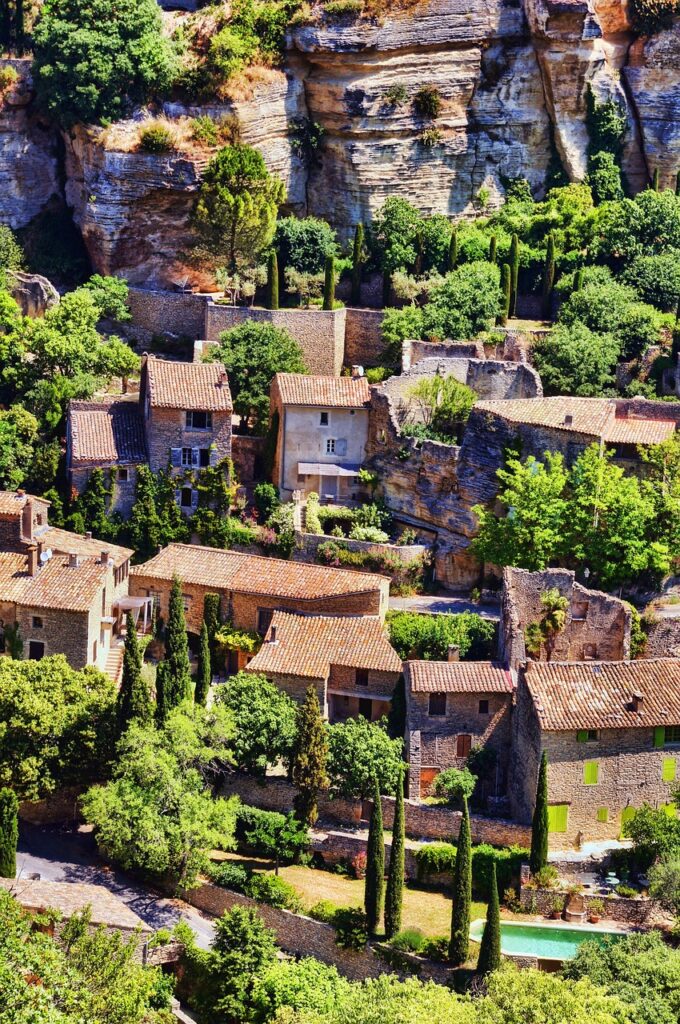
Since 2019, I’ve called France my maison and have been painting my way across the sun-dappled landscapes of this culturally rich country. I’ve got miles under my feet, countless baguettes in my belly, and an insatiable love for everything French.
From savoring escargot in quaint bistros to catching sunsets over lavender fields, I’ve explored every nook and cranny and unearthed the best-kept secrets of the South of France – and I’m here today to share them all with you.
Ready to dive into the French charm and explore all the best things to do in Southern France?
In this post, you'll find...
1. Les Baux de Provence
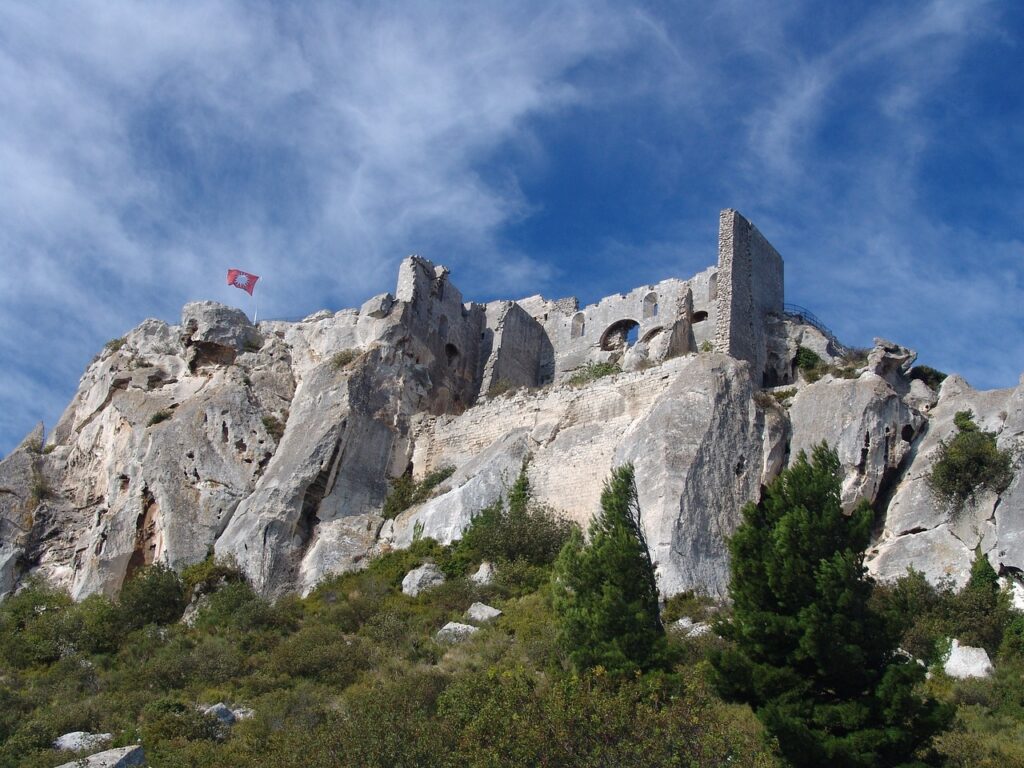
Alrighty, first stop: Les Baux de Provence. Nestled atop a rocky plateau, this charming village is like a scene straight out of a 14th-century painting. Its cobblestone streets, medieval fortress, and olive groves are a sight for sore eyes. Literally. You might want to bring your sunglasses because the sunlight bouncing off those limestone cliffs is no joke.
But it’s not just about the ‘gram-worthy views. The best thing about this little town is its history. You can wander through the ruins of the castle or lose yourself in the winding narrow streets. Don’t miss the famous Carrieres de Lumières, where art and technology meet in a magical light and sound show.
For a bird’s eye view of this spectacular sight, hop on a short drive to the viewpoint at Château des Baux. Trust me, your Instagram followers will thank you.
2. Vers-Pont du Gard
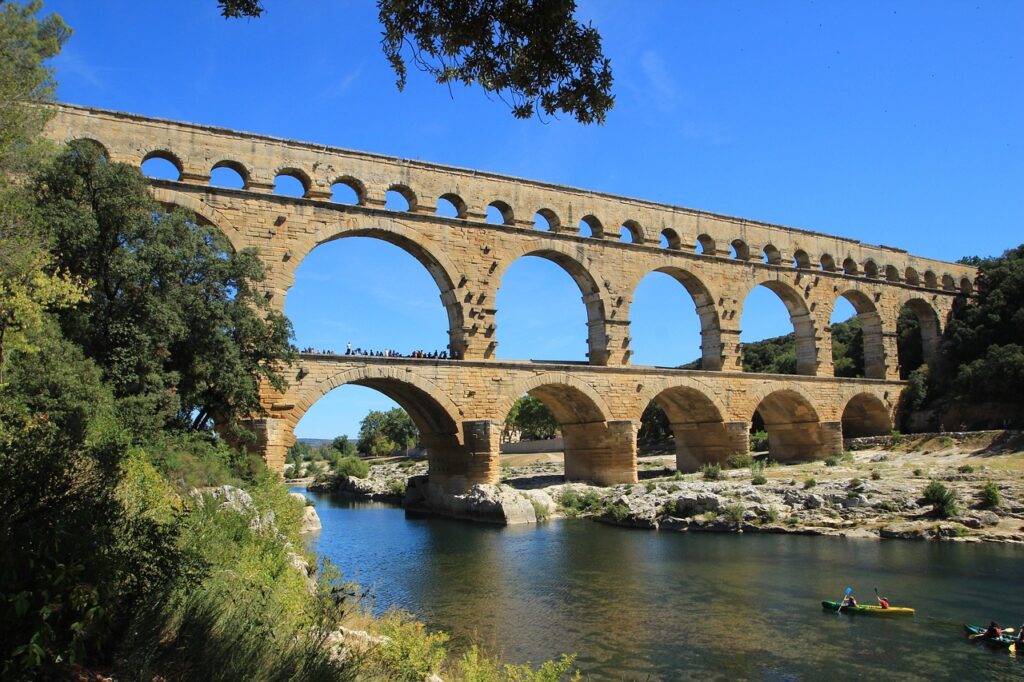
Moving on, let’s head over to Vers-Pont du Gard. Now, if you think bridges are boring, hold onto your berets, because this one will change your mind. The Pont du Gard isn’t just any old bridge, it’s one of the coolest bridges in France , and for good reason!
This UNESCO World Heritage site is a marvel of Roman engineering that’s been standing tall since, well, Roman times. It’s not just a bridge, but an ancient aqueduct. Can you imagine carting water across this three-tiered behemoth? Those Romans didn’t do things by halves, did they?
For the best experience, snag a skip-the-line ticket in advance . Because who likes to wait in line when there’s so much to see and do? With this golden ticket, you can stroll along the bridge, visit the museum to learn about its fascinating history, and even take a guided tour if you’re feeling extra adventurous. Plus, the surrounding area is perfect for a leisurely picnic.
Just imagine munching on a baguette, brie oozing out the sides, with this architectural marvel as your backdrop. C’est magnifique .
🎟️ Get your skip-the-line ticket to Pont du Gard here!
3. Lavender Fields of Valensole
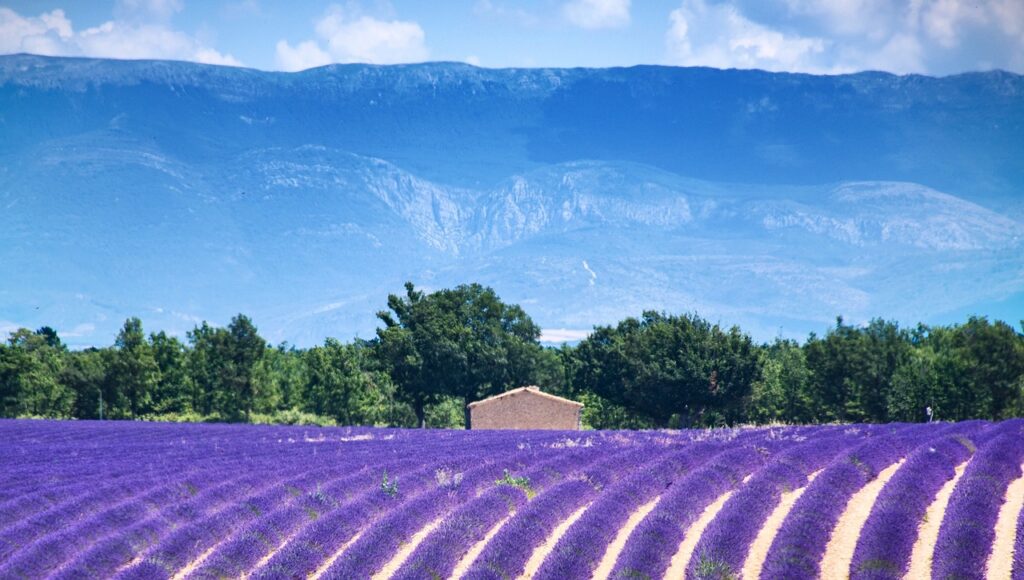
Next on the agenda, we’re trading in our berets for straw hats because we’re heading to the Lavender Fields of Provence. Imagine endless waves of purple rolling under the bright Provençal sun, the scent of lavender thick in the air. If it sounds like something from a dream, that’s because it is.
And let’s not even get started on the ‘gram potential (#nofilter).
The best time to visit is from mid-June to August when the lavender is in full bloom. You can just stroll through the fields, basking in the purple glow, or hop on a guided tour to learn more about this iconic crop.
Don’t forget to pick up some lavender oil or soap as a fragrant memento. So if you’re ever feeling the blues, just take a whiff, close your eyes, and you’re back in the South of France.
💡 Tip: I highly recommend booking your tickets in advance – since there’s such a short time period in the year where these blossoms are at their best, they tend to get really crowded! Book entry tickets here
🪻 Want to visit the lavender fields on a day trip from a nearby city? Check out these tours:
- Full-day trip from Aix en Provence (Guided tour)
- Full-day trip from Marseille (Guided tour)
4. Gorges du Verdon
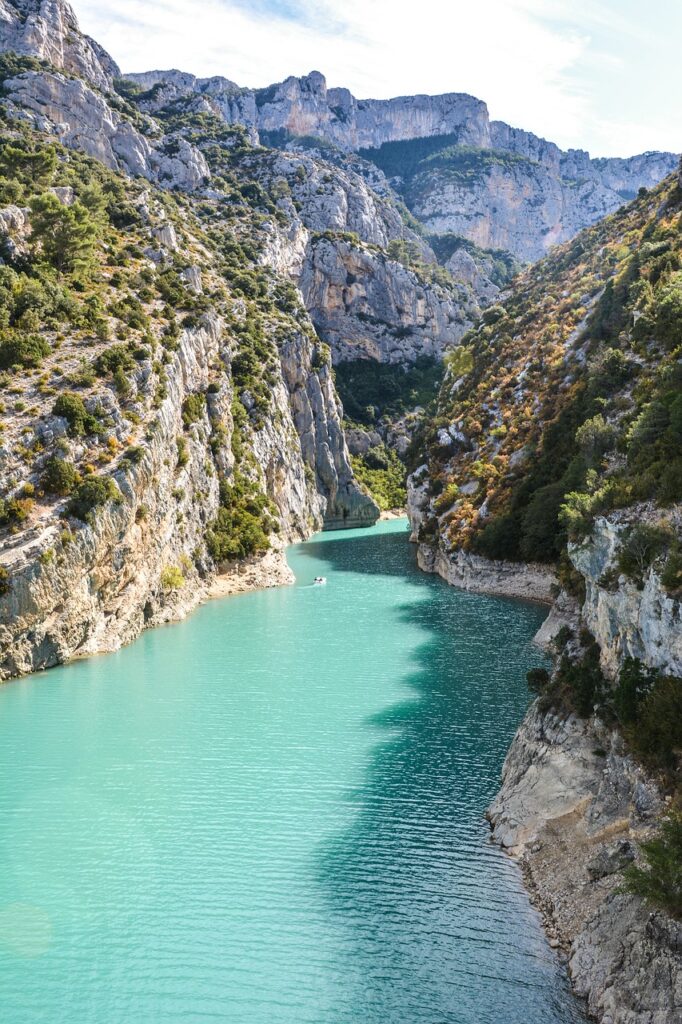
Pack your adventure hats, folks, because we’re about to take a detour to the Gorges du Verdon, Europe’s answer to the Grand Canyon.
This natural beauty in the heart of Provence offers more than just jaw-dropping views (although there are plenty of those). It’s the perfect place for adrenaline junkies, with activities ranging from white-water rafting to rock climbing. Not an adrenaline junkie? Fear not!
Hop in a paddleboat or canoe and gently float down the turquoise waters of the Verdon river. Don’t forget to look up and admire the towering limestone cliffs. And if you’re really looking for a chill day, there’s always the option of kicking back on the sandy beaches and soaking up the sun.
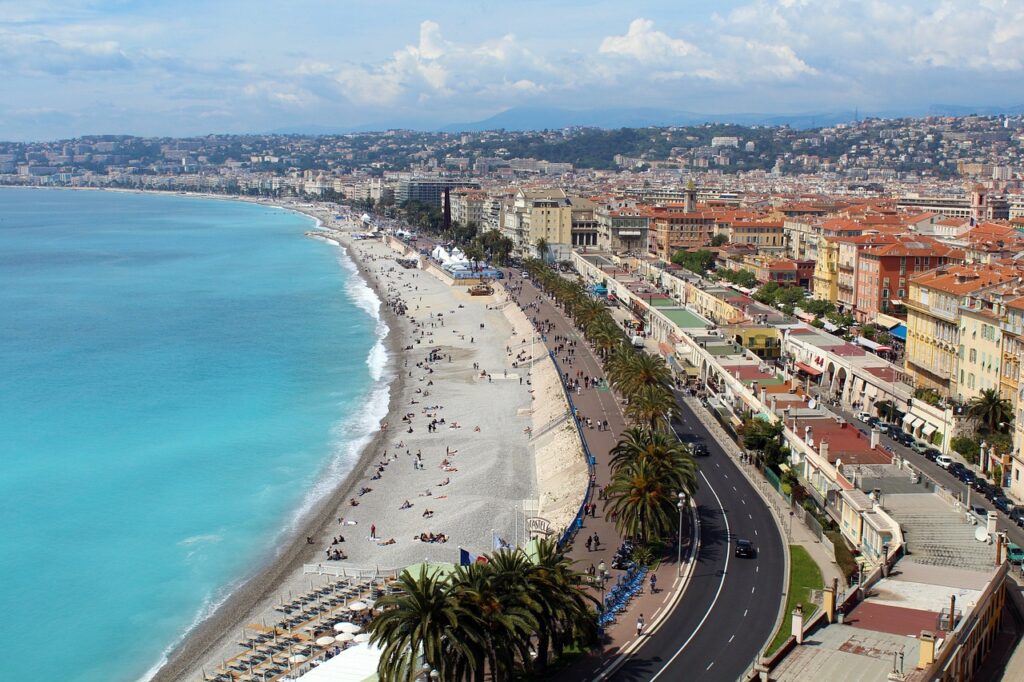
Alrighty, it’s time to dust off the sand and swap our adventure hats for something a bit more chic because we’re heading to Nice. This gem on the Côte d’Azur is known for its beautiful beaches, Promenade des Anglais, and pastel-hued old town.
When it comes to how to spend a day in Nice , you have no shortage of options. Wander through Vieux Nice, where you’ll find narrow streets lined with bustling markets and little ice cream shops (because nothing says South of France like gelato on a sunny day). Art lovers, don’t miss the Matisse Museum, dedicated to the city’s most famous resident, Henri Matisse.
And for the best views in town, head to Castle Hill. It’s a bit of a climb, but the panorama of the city and the Mediterranean Sea is worth every step. From morning market strolls to late-night beach walks, Nice is definitely, well, nice . It’s also home to tonnnnns of “Instagrammable” photo spots !
View this post on Instagram A post shared by Tiana (@wheretianatravelss)
I recommend taking a food and wine tour through the Old Town of Nice to really get a taste of the city. This tour will take you to taste local Nicoise specialities, cheeses, delicatessen, pastries and sweet delicacies, and even local olive oil and wine tastings. You’ll also learn some recipes to learn how to cook Niçois dishes from a local foodie!
⌛ Short on time? This tour will take you through the highlights of the French Riviera – visit the village of Èze, explore Monaco, Monte Carlo, Saint Paul de Vence, Antibes, and Cannes in one day. Book your French Riviera highlights tour here
6. Saint Tropez
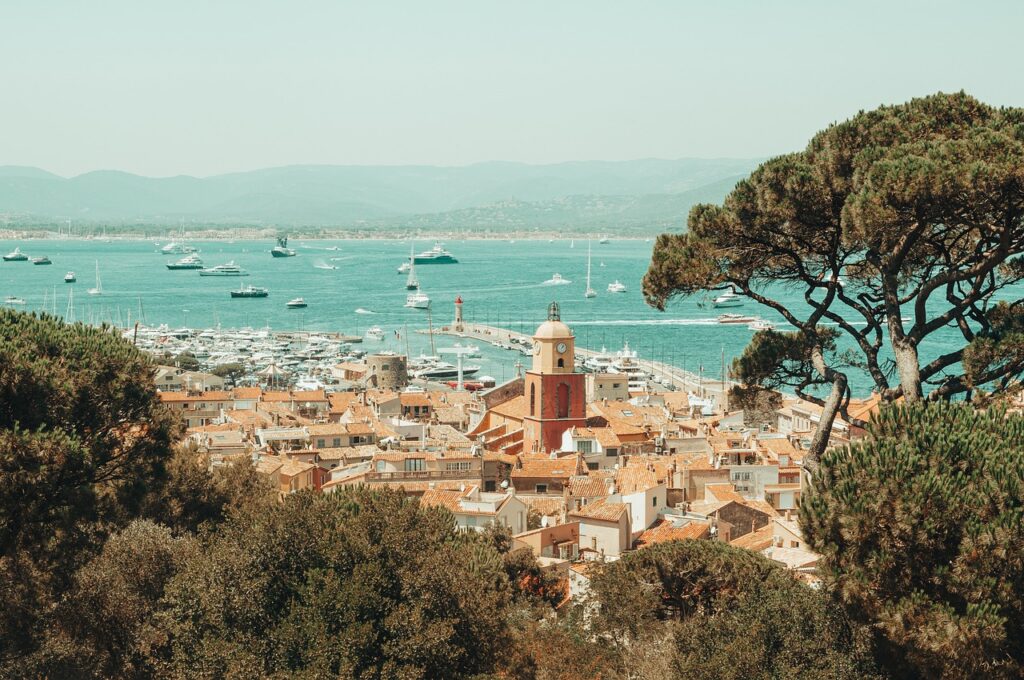
From Nice, it’s just a short drive (and ferry ride) to the glamorous town of Saint Tropez. A place where the rich and famous moor their yachts and soak up the sun on sandy beaches. But don’t worry, you don’t need to be a millionaire to enjoy St Tropez (although it wouldn’t hurt).
Stroll around the old town, with its narrow streets and vibrant houses. Explore the 17th-century Citadel for a touch of history and fantastic views of the port. And of course, take the time to enjoy the beaches – they are the main attraction, after all. Pampelonne Beach is the most famous, but there are quieter spots if you prefer a little more tranquility.
And who can resist a delicious ice cream while walking around the glamorous marina?
⛵ This ferry ticket offers a roundtrip boat transfer from Nice to Saint Tropez – perfect if you want to visit just for the day! Book roundtrip from Nice to St Tropez
Related read: How to get from Cannes to St Tropez
7. Cap d’Ail
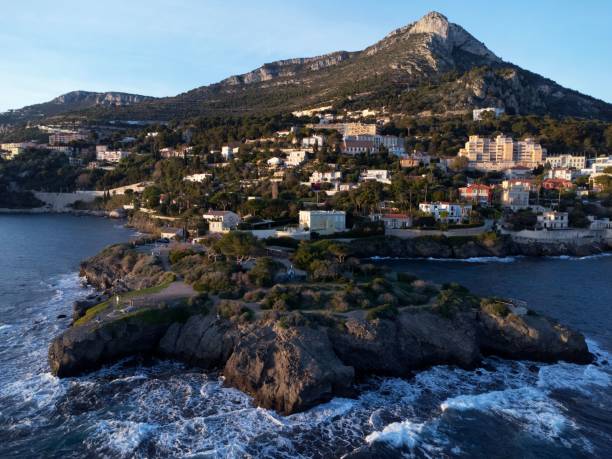
Let’s head to the lesser-known but just as lovely Cap d’Ail. This small town, just a stone’s throw away from Monaco-Monte Carlo, is a beautiful place to unwind after the bustle of Cannes and St Tropez.
Here, you can enjoy beautiful beaches without the crowds. Mala Beach is a popular spot, tucked away in a cove with crystal clear waters perfect for swimming and snorkeling.
For those who prefer dry land, there’s a beautiful coastal path that offers stunning views of the Mediterranean. And when you’ve had your fill of sun and sea, why not explore the Château des Terrasses? This 19th-century mansion hosts a variety of cultural events throughout the year.
Cap d’Ail is one of the most picturesque places to visit on the French Riviera and makes for a great day trip from Nice .
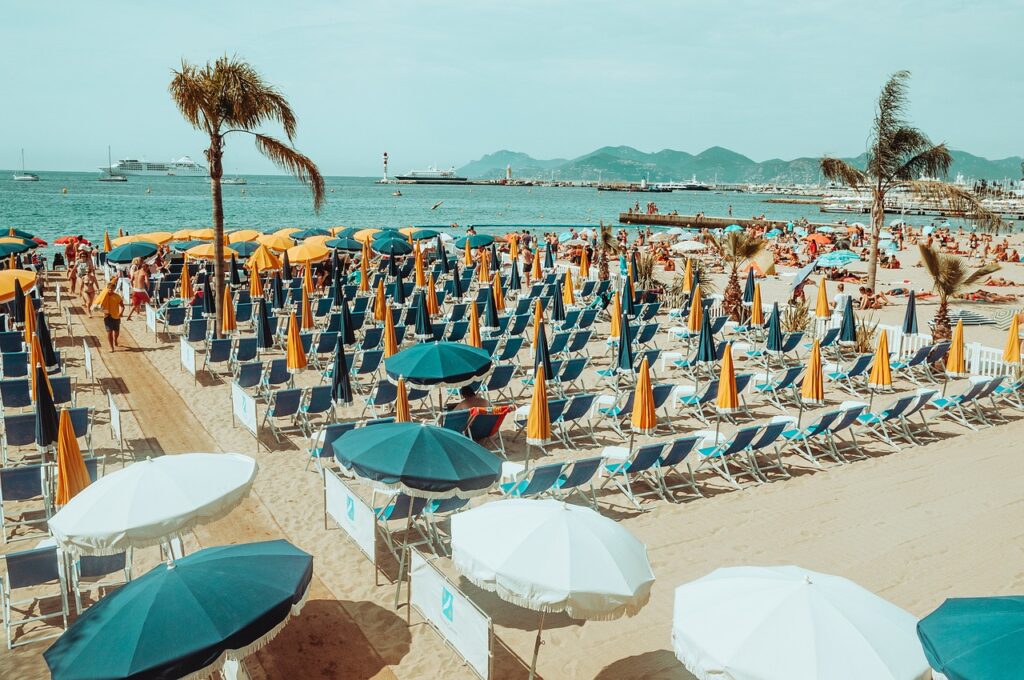
Next stop, Cannes. Famous for its annual film festival, the Boulevard de la Croisette, and luxury hotels, this is a city that knows how to make an impression. Walk in the footsteps of movie stars at the Palais des Festivals, and take a selfie on the red carpet. Visit some of Cannes’ beautiful beaches like Plage de la Bocca or Croisette Beach.
But Cannes isn’t just about the glitz and glam. It’s also a great place to venture out on a catamaran cruise and enjoy the sun-soaked Riviera from a different perspective.
⛵ This full-day catamaran cruise leaves from Cannes and takes you to enjoy the day on the water in the Bay of Cannes.
If you’re a nature lover, don’t miss the Calanques of Esterel. Their rugged beauty offers a stark contrast to Cannes’ polished façade. This family-friendly guided tour of the Esterel natural park will take you to tour the hidden coves, caves, and Calanques as you cruise on turquoise water.
And for a taste of Italy, take a full-day tour of the Italian Riviera . With the azure sea on one side and picturesque towns on the other, this is road-tripping at its finest. You’ll explore open-air markets in San Remo or Bordighera, then explore the captivating village of Dolceacqua.
Related read: 25 Best Things to Do in Cannes
9. Monaco-Monte Carlo
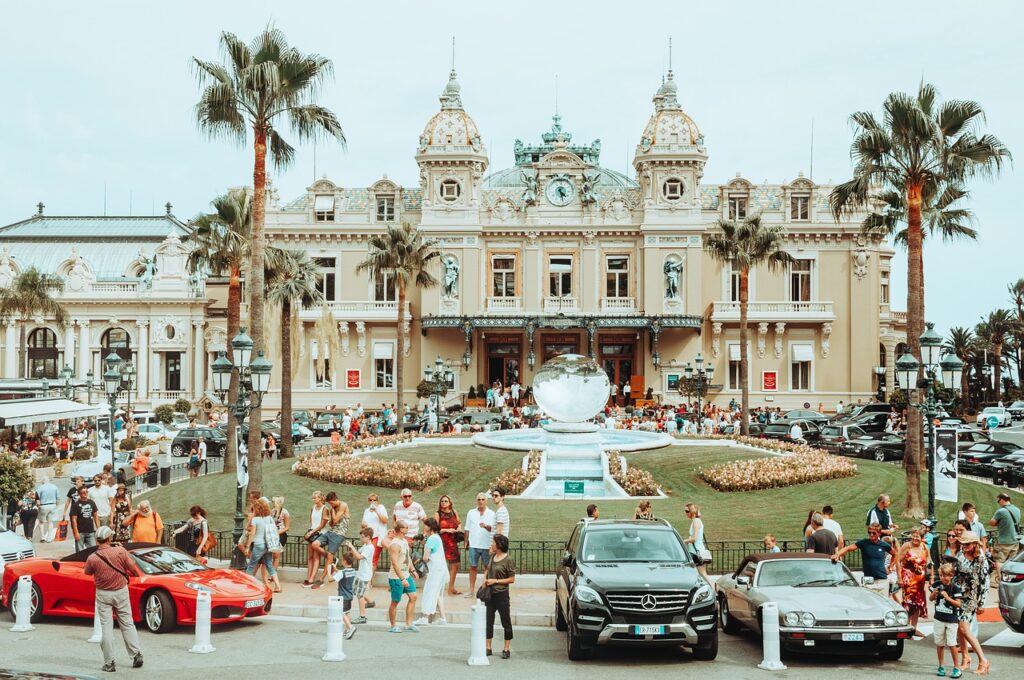
Just a stone’s throw away from Cap d’Ail is the glamorous city-state of Monaco-Monte Carlo, the world’s second-smallest country. Monaco-Monte Carlo is a testament to the adage, “Good things come in small packages.”
Despite its size, Monaco oozes luxury, class, and sophistication, making it a glittering jewel of the French Riviera. this city-state is bursting with glitz, glamour, and all things luxe.
Monaco-Ville, the old town, is a great place to start. Stroll through its narrow streets, check out the Prince’s Palace, and get lost in its medieval charm. If you’re a car enthusiast, the Monaco Grand Prix and the Car Collection of H.S.H. Prince Rainier III are must-sees.
For sea lovers, the Oceanic Museum is an awe-inspiring dive into the deep blue. Filled with marine curiosities and exhibitions, it’s sure to captivate both kids and adults. To see the best that Monaco has to offer, join a Hop-on Hop-off bus tour of the city . It’s an ideal way to ensure you don’t miss a thing!
10. Marseille
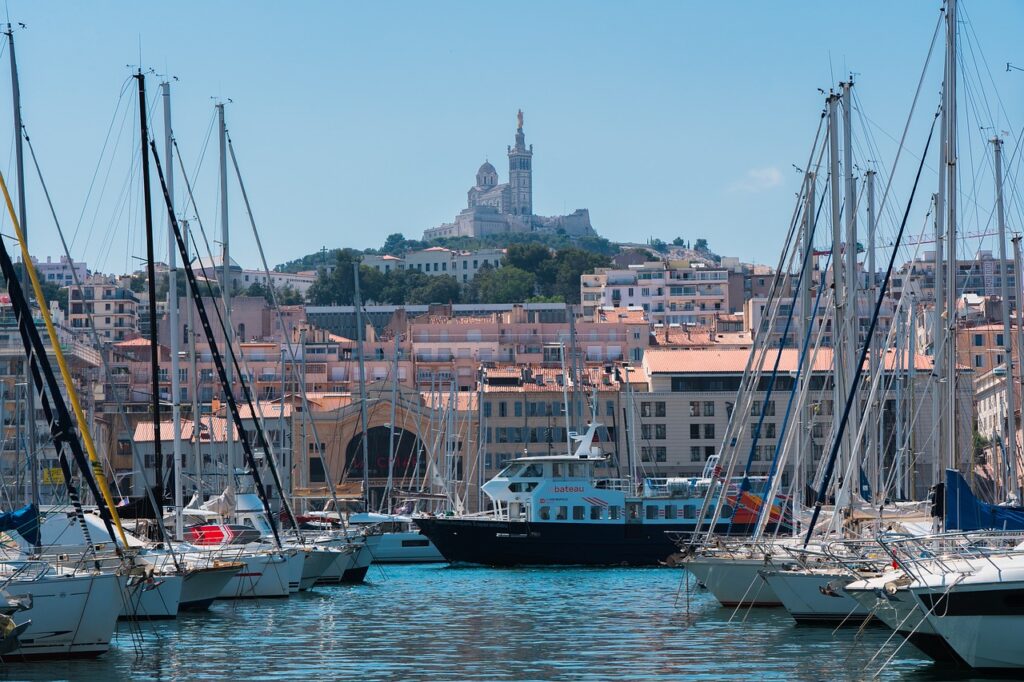
Marseille, nestled on the southeastern coast of France, is the heart of the Provence-Alpes-Côte d’Azur region. Renowned as the country’s oldest city, it bursts with an eclectic blend of tradition and multicultural vibrancy.
The city is famous for its bustling Vieux Port (Old Port), filled with yachts and fishing boats that capture its maritime heritage. Close by is the historic quarter of Le Panier, a labyrinth of narrow, winding lanes adorned with quaint shops and charming cafes.
You can’t miss the iconic Notre-Dame de la Garde, a basilica perched high on a hill, offering panoramic views of Marseille’s stunning cityscape and the Mediterranean Sea. From museums and historical sites to the Calanques National Park, Marseille is a treasure trove of cultural, natural, and gastronomical delights awaiting exploration.
🛥️ Want to take a boat cruise in Marseille? Check out my top two picks:
- This catamaran tour with lunch takes you on a voyage of discovery from La Madrague to the quaint town of Cassis on a maxi-catamaran. You’ll bask in the beauty of the Marseille Calanques and the Frioul Archipelago, and savor a delicious lunch featuring plancha (grilled food), assorted sides, and a sweet dessert. Book a catamaran cruise here
- This sunset dinner cruise is a romantic escapade, perfect for couples, families, or friends seeking a special evening. The journey will take you to the Frioul archipelago and its hidden coves, setting a perfect backdrop for a starlit meal. As the dinner concludes, let loose on the dance floor with tunes spun by an onboard DJ. Book a sunset dinner cruise
🎟️ Combination Ticket: To get the most bang for your buck, the Marseille City Pass offers unlimited public transport and free access to several museums and attractions. Now that’s what I call a ‘bon plan’! Purchase a Marseille City Pass
11. Aix en Provence
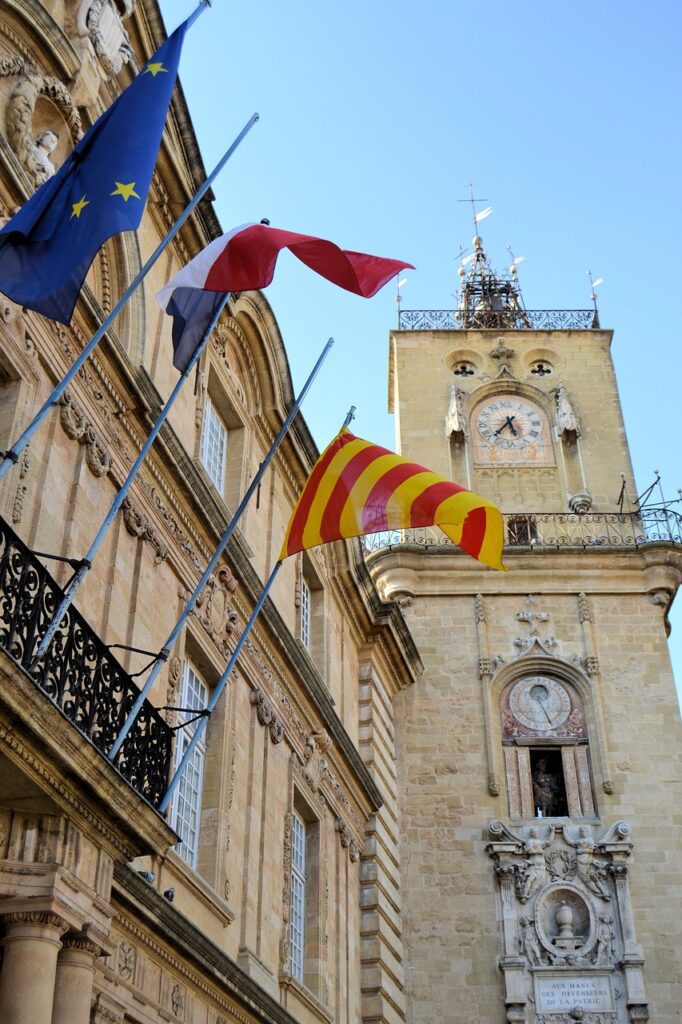
Delve into the captivating charm of Aix en Provence, an elegant city located in the heart of Provence. Recognized for its classical beauty, Aix en Provence is a haven for art enthusiasts and foodies.
The city is punctuated with fountains, adding to its distinctive allure. Strolling along the tree-lined Cours Mirabeau is a must, where cafés, bookshops, and boutiques beckon. The Atelier de Cézanne, the studio of the renowned painter Paul Cézanne, offers a glimpse into the artist’s life and work.
Beyond its artistic charm, Aix en Provence is a gastronomic delight, tempting visitors with Provençal cuisine, fine wines, and local markets brimming with fresh produce. For the foodies, a Provençal market walking tour is an absolute must. With fresh produce and local specialties at every turn, it’s a gastronomic adventure you won’t want to miss.
Here are my top two picks for tours in Aix en Provence:
- For a taste of the French countryside, join a tour of the hilltop villages in Luberon . You’ll see France’s rural charm at its best.
- And, of course, no visit to Aix would be complete without a wine tour of the countryside . The surrounding countryside is littered with vineyards that produce some of the country’s best vino.
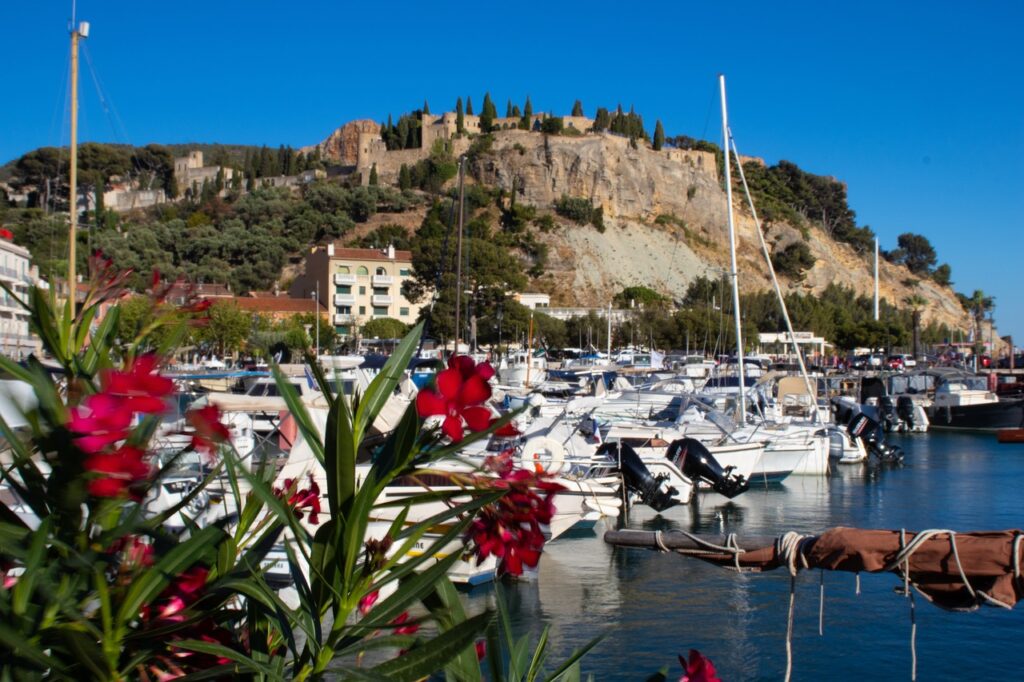
Cassis, nestled between the towering white cliffs of Cap Canaille and the steep limestone Calanques, is a picture-postcard fishing village in southern France. This little town is a Mediterranean treasure, with its vibrant harbor lined with pastel-colored houses and dotted with café terraces.
Here, fishermen still pull in their daily catch, adding a touch of authenticity to this idyllic setting. Venture towards the Calanques National Park to marvel at a series of stunning inlets with crystal-clear waters, perfect for swimming and snorkeling. On the water, you can spend the day paddle-boarding , or on a kayaking tour through the Calanques.
Back in town, explore the narrow, winding streets brimming with Provençal charm, or treat your taste buds with the local specialty, ‘Bouillabaisse’. Don’t forget to visit the historic Château de Cassis, which offers breathtaking views of the Mediterranean Sea and the surrounding vineyards. Cassis is a small town with a big personality, steeped in tradition and beauty.
Related read: The 12 Best Things to Do in Cassis, France
13. Saint Paul de Vence
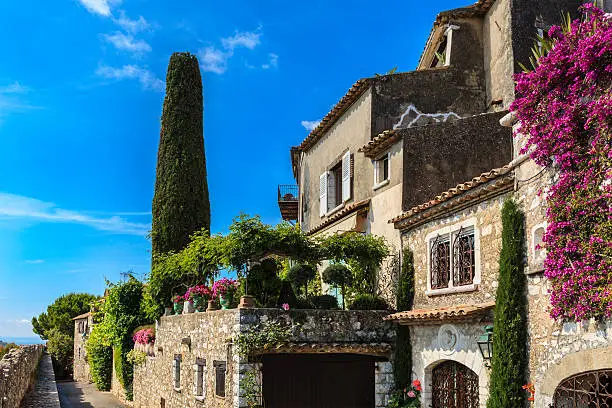
High in the hills of the French Riviera, Saint Paul de Vence is one of the oldest medieval towns in the region. A paradise for art lovers, its cobblestone streets have been trodden by renowned painters and actors, including Chagall and Matisse. The town’s history comes alive within its well-preserved ramparts, where ancient houses are now converted into art galleries and boutiques.
The Fondation Maeght, a museum dedicated to modern and contemporary art, is a must-visit, boasting works by Miró, Calder, and Giacometti. Don’t miss a walk along the La Grande Fontaine, a 16th-century monumental fountain at the town’s entrance. The heart of the town, Place de la Grande Fontaine, is a perfect spot for people-watching. With its fairy-tale charm and artistic heritage, Saint Paul de Vence offers an enchanting journey through time.
I recommend visiting Saint Paul de Vence on a day trip from Nice. On this half-day tour , you’ll grab a seat in a comfy minivan at your Nice hotel and prepare for a scenic drive to Saint Jeannet through the heart of Provence’s wine country. Your guide will share fascinating insights into French winemaking traditions as you head towards a local wine cellar.
There, you’ll get the chance to taste a variety of wines alongside an experienced winemaker. Wrap up the tour at Saint Paul de Vence, a historic village renowned for its artistic heritage, which has welcomed figures such as Renoir, Chagall, and Picasso.
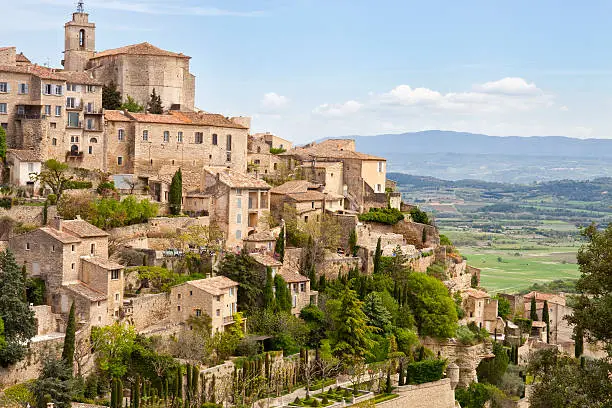
Tucked in the picturesque Luberon region of Provence, Gordes is a mesmerizing stone village, often hailed as one of France’s most beautiful.
Perched on a rocky hill, the village presents a stunning spectacle of stone houses spiraling down the slopes, capped by a 12th-century castle. The castle, now a museum, offers an insight into the village’s history and the cultural traditions of the region. Nearby, the Sénanque Abbey, a 12th-century Cistercian abbey tucked within lavender fields, is a sight to behold.
In town, explore the winding, cobblestone streets and enjoy panoramic views of the Luberon Valley. Market day in Gordes, every Tuesday, is a feast for the senses, with stalls selling local produce, honey, cheese, and more. With its undeniable charm, Gordes is a testament to the enduring allure of medieval France.
15. Avignon
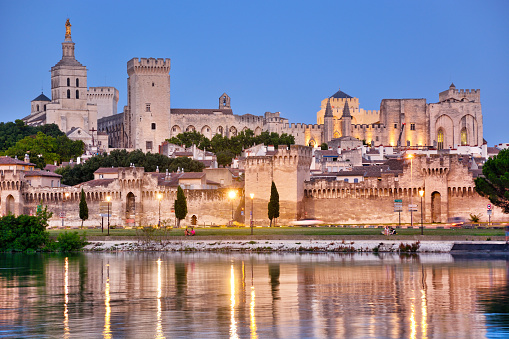
Positioned on the left bank of the Rhône River, Avignon, in southeastern France, is a city shrouded in history and architectural wonder. Best known for the Palace of the Popes, Avignon served as the papal residence during the 14th century, which is why the city is often referred to as the “City of Popes”. This UNESCO World Heritage Site is undoubtedly the heart of Avignon, offering an intriguing journey back to the Middle Ages.
Another must-see is the famous Avignon Bridge, also known as Pont Saint-Bénézet, partially crumbled but nonetheless picturesque. Avignon is also renowned for its annual arts festival, a perfect occasion to immerse yourself in theater, dance, and music. The charming cobblestone streets, local markets bustling with fresh produce, and the vibrant squares make Avignon a delightful blend of history, culture, and Provençal lifestyle.
The best way to taste all that Avignon has to offer? A wine tour, of course!
This 5-hour wine adventure through the heart of Côtes du Rhône’s famed wine country uncovers the stories behind three Grand Crus: Gigondas, Seguret, and Châteauneuf-du-Pape. On this immersive tour, you’ll marvel at picturesque vineyards and quaint villages, punctuated by charming bell towers, all nestled at the foot of the Dentelles de Montmirail. Gain insights into the intricacies of wine production and the diverse grape varieties that make this region so unique.
And the cherry on top? A delightful wine-tasting session led by a specialist, promising to make your foray into the wine world an unforgettable experience. Ideal for wine lovers and curious souls alike.
16. Toulouse
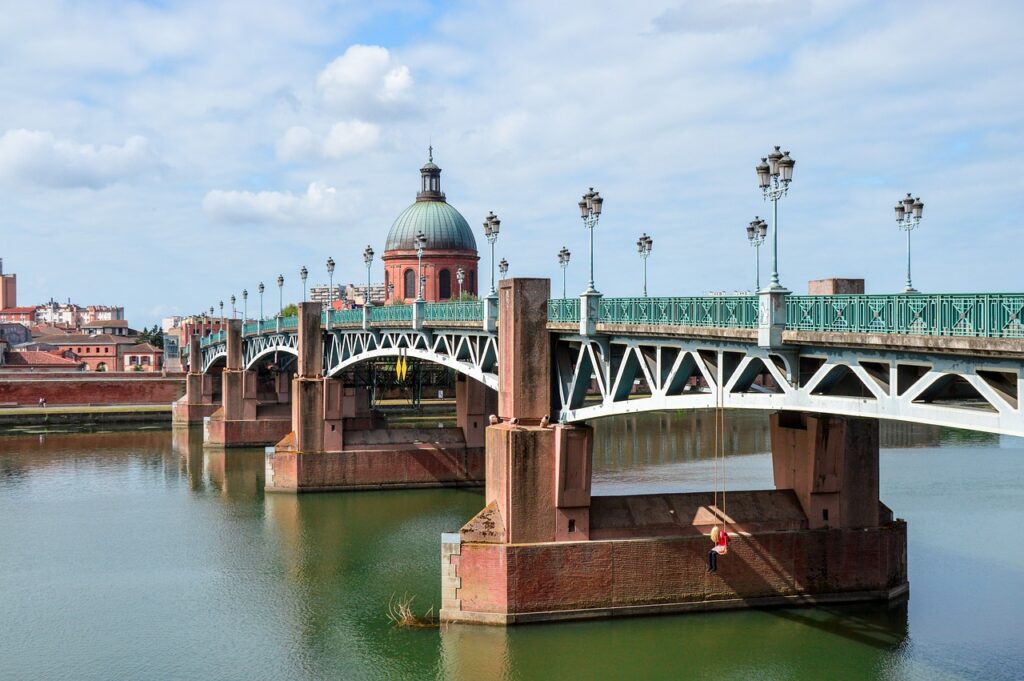
Toulouse, also known as “La Ville Rose” (The Pink City) for its distinctive brick architecture, is a vibrant city located in southwestern France.
It’s the heart of the European aerospace industry, home to Airbus headquarters, and the space-focused City of Space theme park – both offering captivating tours. Toulouse’s rich history can be traced back to the Roman times and is reflected in landmarks like the Saint-Sernin Basilica, a UNESCO World Heritage site and a gem of Romanesque architecture.
Art enthusiasts will appreciate the Fine Arts Museum, housing an extensive collection ranging from the Middle Ages to the early 20th century. Don’t forget to explore the charming old town, with its narrow streets filled with shops, cafes, and the Capitol Square, the city’s epicenter. And for those fond of nature, a stroll along the Canal du Midi, another UNESCO site, is a must.
🎟️ P.S. Make the most of your trip to Toulouse with the Toulouse City Card – your key to exploring the Pink City with ease and value! This card provides free access to major museums, discounts on guided tours, and unlimited use of public transportation.
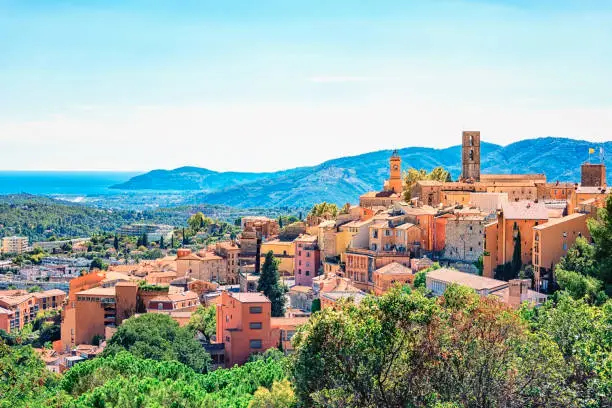
Nestled in the hills north of Cannes, Grasse is a quaint town famous for being the perfume capital of the world. A stroll through Grasse offers a sensory experience like no other, with a variety of aromas wafting through its narrow, winding streets.
The International Perfume Museum and the historic perfume factories like Fragonard, Molinard, and Galimard offer fascinating tours where you can learn about the art of perfume making and even create your own fragrance. This fragrance-making class in Grasse will teach you the basics of perfumery as you create your own scent!
Grasse’s old town is a charming labyrinth of narrow alleyways, packed with historic buildings dating back to the 17th and 18th centuries. Don’t miss the Cathedral Notre Dame du Puy, hosting artworks by Rubens and Jean-Honoré Fragonard.
For nature lovers, the surrounding region provides ample opportunities for hiking and exploring the scenic beauty of the Maritime Alps. In spring and summer, the surrounding fields burst into a riot of color, making Grasse look even more beautiful.
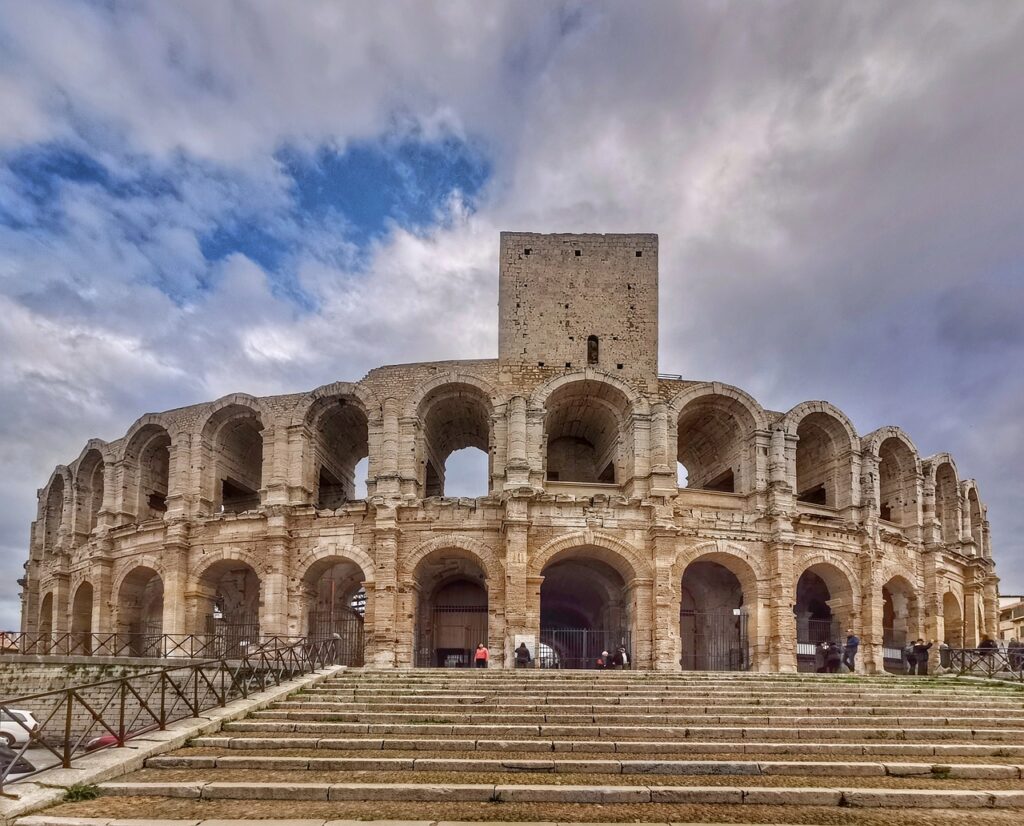
If you’re chasing the sun in Southern France, Arles, nestled in the heart of Provence, should be on your itinerary. Once an important hub of the Roman Empire, Arles boasts an impressive array of well-preserved Roman ruins including an amphitheater, and Alyscamps, a Roman necropolis.
This “little Rome of Gaul” also charmed the Dutch painter Vincent Van Gogh who produced over 300 paintings and drawings during his time here. Walk in his footsteps, exploring the cafes and scenery immortalized in his art, like the “Café Terrace at Night”. The Fondation Vincent van Gogh Arles is a definite must-see for art lovers.
In addition, Arles is the gateway to the Camargue, a magical landscape of salt lagoons, white horses, and flamingos. Take a short drive out to see this wonder of nature for a complete Arles experience.
Related read: 55 Most Iconic Landmarks & Monuments in France
19. Camargue Natural Regional Park
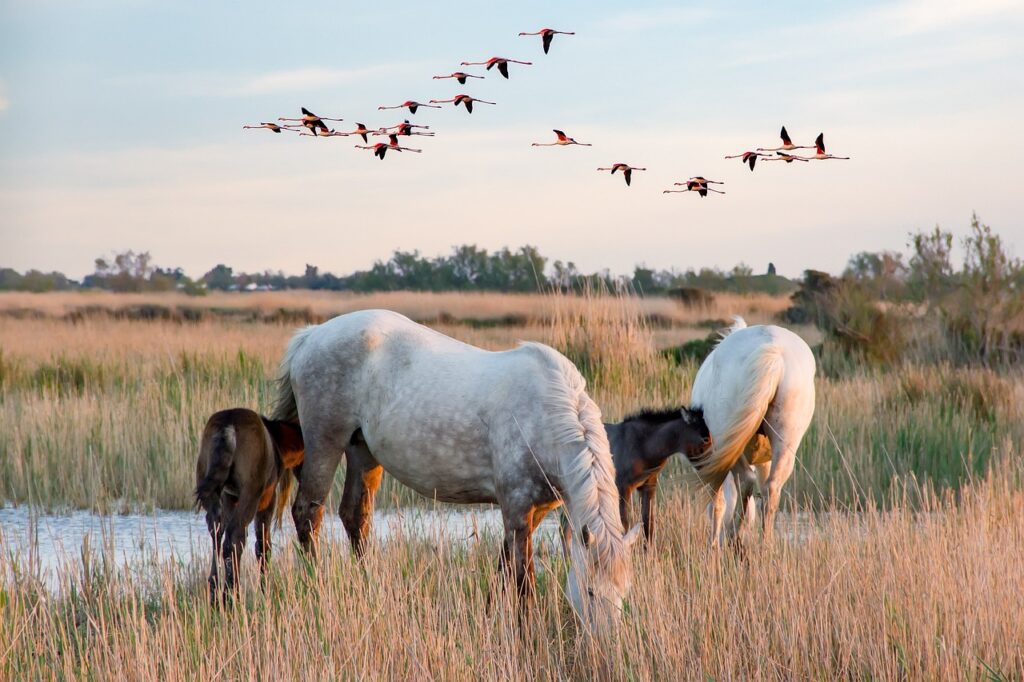
Take a break from the cobblestone streets of the old towns and immerse yourself in the wild beauty of the Camargue Natural Regional Park. This unique wetland, sandwiched between Arles and the Mediterranean Sea, is a treasure trove of biodiversity. Bring your binoculars and prepare to spot white horses, black bulls, and the famous pink flamingos that call this park home.
The Camargue is also a hotspot for birdwatchers with over 400 species, including herons, eagles, and waders. If you’re game, saddle up for a horse-riding tour to get up close with nature. In Camargue, the blend of wildlife, landscapes, and cultural heritage promises an unforgettable experience.
For an up close and personal experience, hop on a half-day 4×4 safari adventure . Guided by a local expert, you’ll venture through the park’s unique landscapes where salt, water, and wind converge, creating a haven for an array of wildlife. You’ll get up close with the park’s famous wild horses and bulls, and catch sight of the flamboyant pink flamingos dotting the marshlands.
This tour is perfect for nature enthusiasts and those seeking an off-the-beaten-path experience, offering a mix of education, exploration, and breathtaking natural beauty.
20. Pyrenees National Park
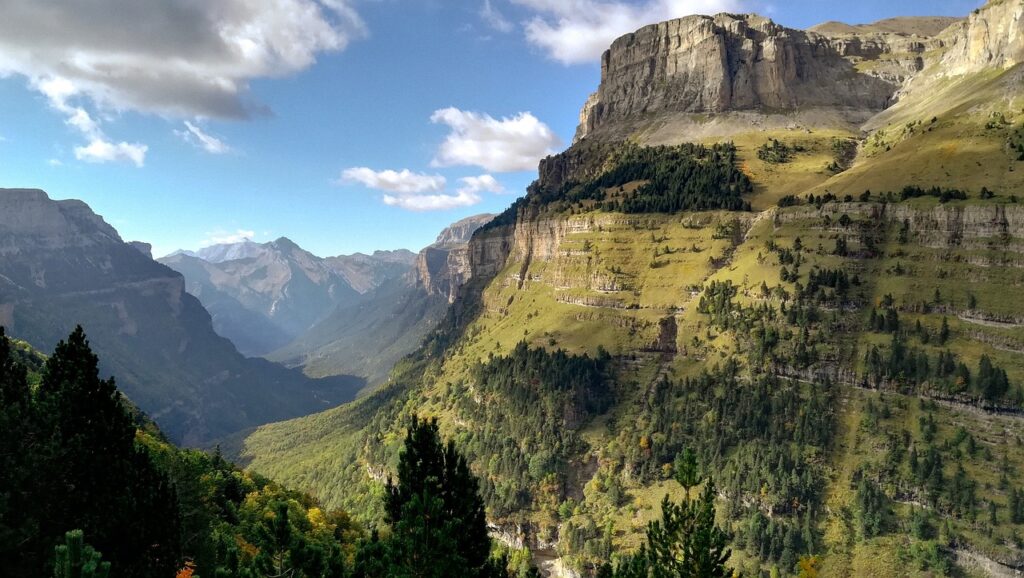
And now, let’s venture west towards the Pyrenees National Park, the perfect place for nature lovers and adventure enthusiasts.
This park, stretching along the border between France and Spain, is known for its spectacular mountain landscapes dotted with clear lakes and frothy waterfalls. Summer months are perfect for hiking; there are trails for every fitness level, from gentle walks in the valleys to challenging climbs up to peaks like Vignemale.
In winter, the snow-covered mountains become a playground for skiing and snowshoeing. Keep your eyes peeled for wildlife, as the park is home to unique species like Pyrenean chamois, marmots, and even brown bears. In addition to its natural beauty, the park is steeped in culture.
Explore the hilltop villages like Cauterets and Luz-Saint-Sauveur, sample the local cheese, and experience the warm hospitality of the Pyrenees. It’s an idyllic escape from the bustle of the cities.
The South of France is best known for its stunning Mediterranean coastline, exquisite cuisine, diverse cultural heritage, sun-drenched vineyards, historical towns, and glamorous seaside resorts like Nice and Saint-Tropez.
While beauty is subjective, many consider Nice as one of the most beautiful cities in the South of France due to its vibrant Old Town, stunning coastline, and iconic Promenade des Anglais.
If you’re traveling on a budget, consider visiting cities like Toulouse and Montpellier, or exploring the natural beauty of areas such as the Camargue Natural Regional Park and Gorges du Verdon. These places offer affordable accommodation and plenty of free or inexpensive activities.

Hi, I’m Tiana – founder of and author here at Where Tiana Travels. I’m a 20-something with a love for all things travel, photography, and food. I have been living abroad for the past 5 years and solo traveling the globe in my free time. I created this blog to share my travel stories and inspire other women to go out and see the world. Read more about me here!
- 445 Share on Facebook
- 66 Share on Twitter
- 225 Share on Pinterest
- 86 Share on LinkedIn
- 209 Share on Email

Home » Europe » 20 Best Places to Visit in the South of France
20 Best Places to Visit in the South of France
By Author Laura Longwell
Posted on Last updated: May 3, 2023
Endless vineyards, hillside towns, pastel villages, and cities packed with history–these are the places and sites that make the South of France an unmissable destination. From Roman ruins to dramatic landscapes and quaint city squares, you’ll find a little of everything here. Between Provence, the French Riveria, and the southwestern part of the country, we’ve spent considerable time exploring the best places to visit in the South of France. Here’s a look at some of our favorites.
Aix-en-Provence
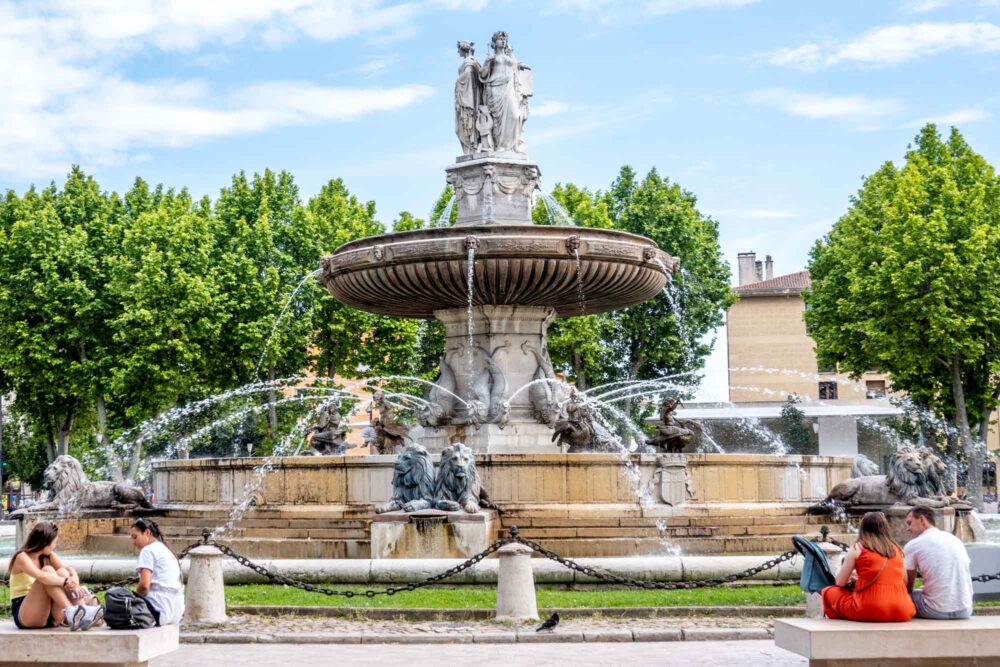
Aix-en-Provence is one of the best cities in the South of France to visit. Often called the City of a Thousand Fountains, Aix is known for its water features, markets, and beautiful pedestrian lanes and squares dotted with plane trees.
A visit to Aix is about being and soaking in the good life. Wander the farmers markets , pull up a chair at one of the cafes, or sample some of the many Provencal specialties at the restaurants and artisan shops.
If you’re looking to visit some of the top attractions in Aix , there are several interesting places to go. The Hotel de Caumont in the city center is an 18 th -century mansion featuring period furnishings. It also has a charming garden and café and features rotating exhibits by well-known artists.
Just outside the center, the Atelier Cezanne is another must-visit. The studio of painter and Aix-en-Provence native Paul Cezanne looks now just as it did when the artists died in 1906. His smock, supplies, and some of his favorite subject matter is still displayed here in a space that looks like he just stepped out for lunch.
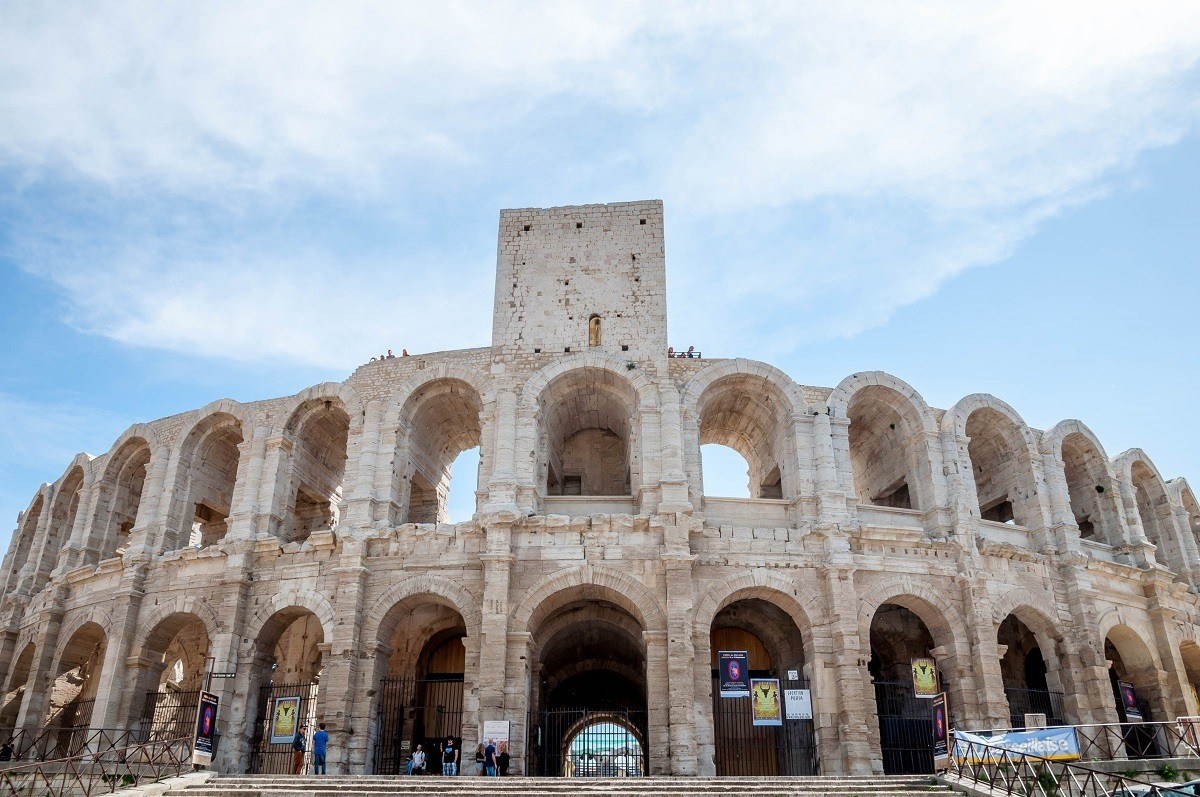
Splashed in blues, yellows, and greens, visiting Arles makes you feel like you’ve stepped into a Van Gogh painting for good reason—you have. The artist produced over 200 pieces when he lived here. Throughout the city, there are replicas of the works in the exact spots where he painted them with plaques that provide some of the backstory.
Arles has a lot to offer even for those who aren’t art lovers. It is packed with history, ambiance, and lots of great food. A visit here is a highlight of any southern France itinerary .
Right in the center of town is Arles Amphitheater , a two-tiered theater that dates from 90 AD and still hosts events. A short walk from the center is Alyscamps , a Roman necropolis that is now an open-air museum lined with sarcophagi and several chapels. Once the main burial site for the city, it is an interesting look back at thousands of years of history. Both places have been recognized as UNESCO World Heritage Sites.
If you visit Arles on a Wednesday or Saturday, the market on the ring road will be impossible to miss. Stroll through to see the Mediterranean and North African cuisines on display and buy provisions for a picnic.
Saint-Remy-de-Provence
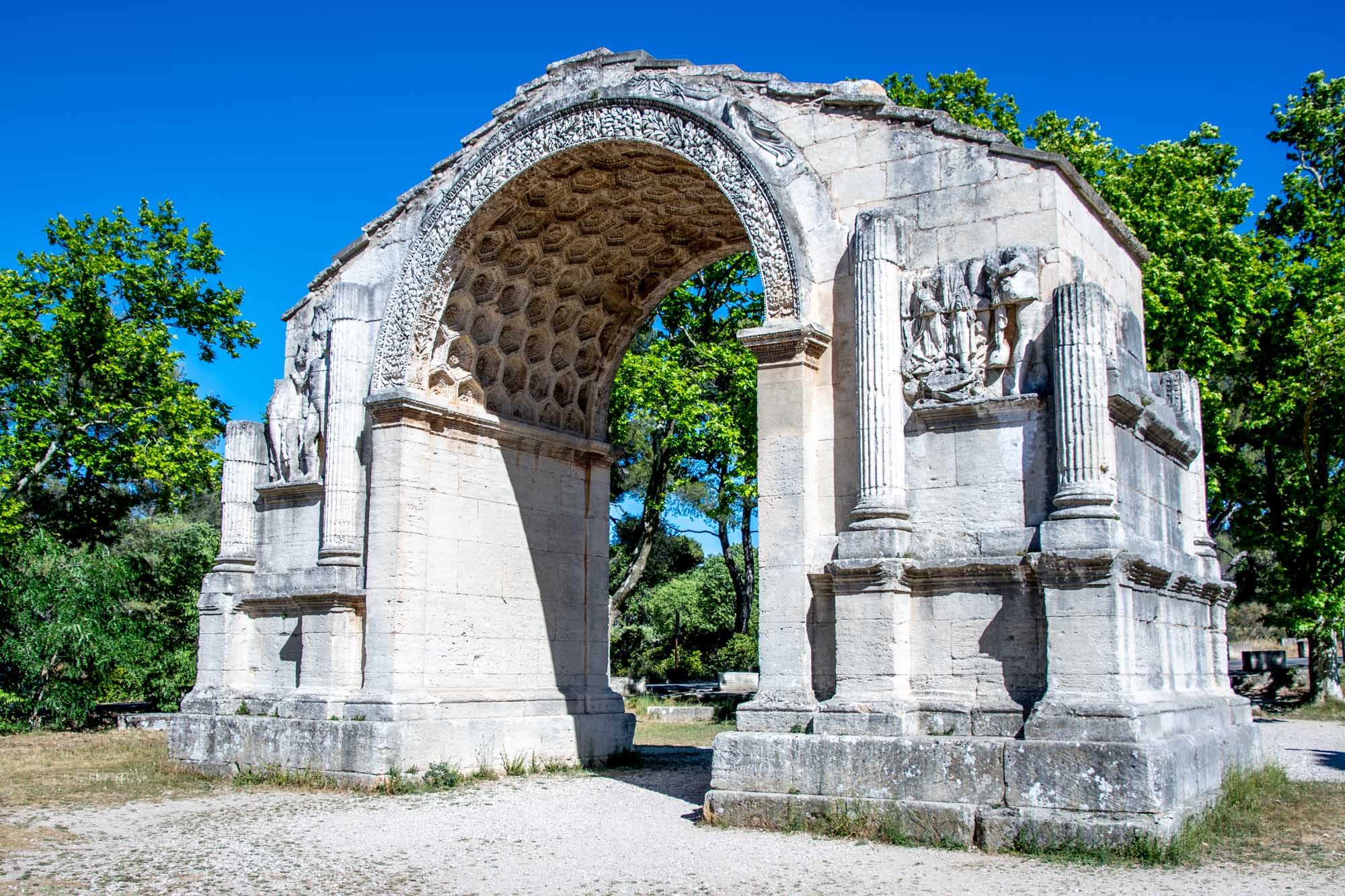
With less than 10,000 residents, Saint-Remy-de-Provence is the type of town where you just want to stay for a while. There are plenty of restaurants, shops, and things to see, and the pace is typically relaxed, which can be welcome in contrast to some of the larger cities in southern France.
Visitors can see most of the town in just a few hours. Or you can linger much long and explore the honeysuckle and wisteria-covered buildings, fountains, and colorful facades.
Located in Chaine des Alpilles, a small mountain range, Saint Remy has been inhabited for centuries. In fact, one of its main attractions is the archaeological site of Glanum . Many of the ruins there are from Romans who took over the area in the 1 st century BC. Some of the most notable structures are free to visit right along the road and include a triumphal arch that dates from about 10 BC and a funerary monument of a similar age.
A somewhat more contemporary site is Saint-Paul de Mausole , the psychiatric hospital where Vincent Van Gogh was treated for a about year in 1889 and 1890 shortly before his death. His room is preserved as it was during his stay, and you can explore the grounds and the works he painted there, including Starry Night .
Verdon Gorge
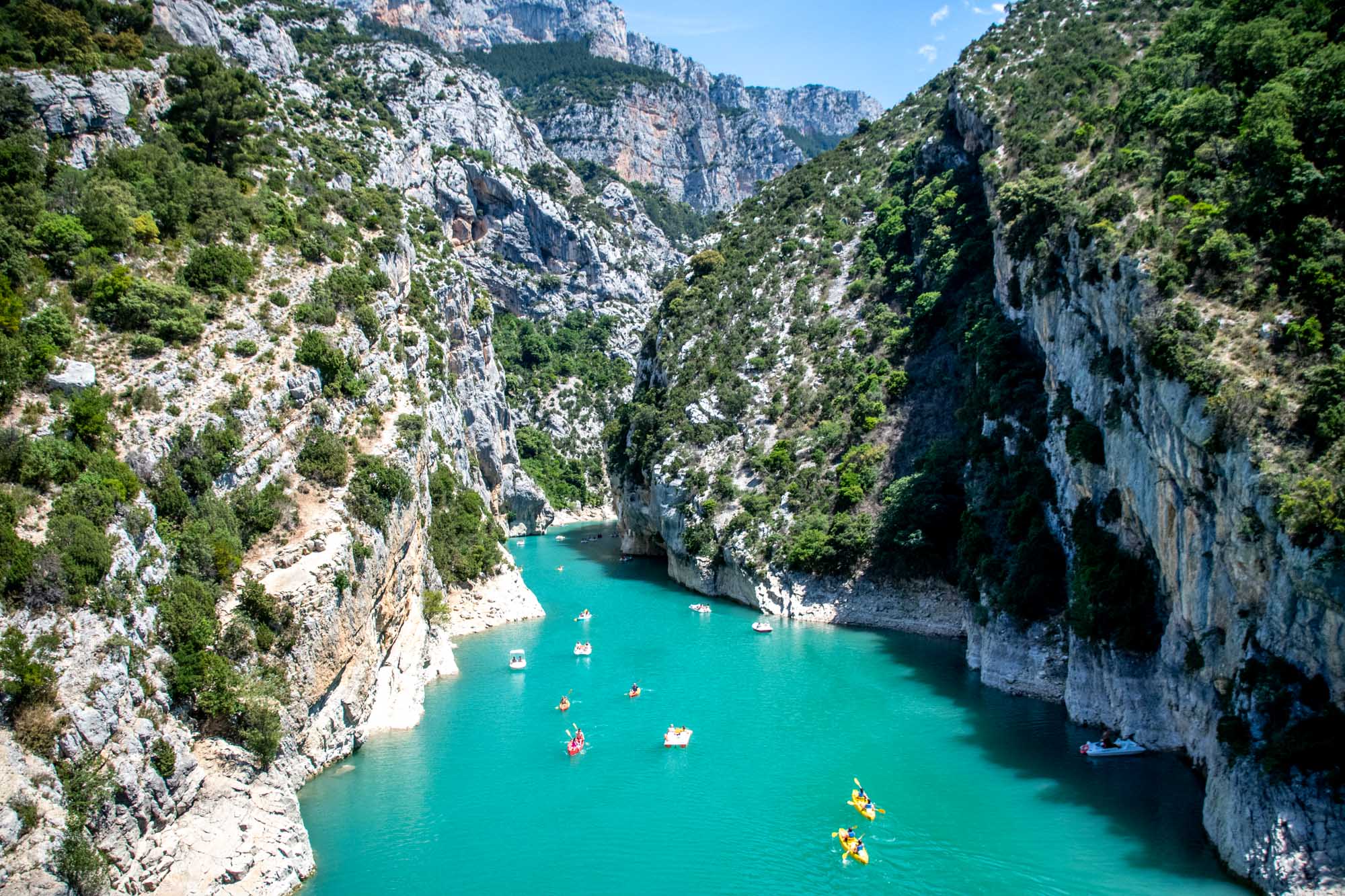
The first thing that catches your attention at the Verdon Gorge is the electric blue water. One of the most stunning natural places to visit in the South of France, this river canyon is 15 miles long and up to .4 miles deep. The limestone cliffs make for incredible scenery.
Paragliding over the canyon and climbing its walls are also popular, but we’re partial to being on the water.
There are three main ways to enjoy the Verdon Gorge river up close—by stand-up paddleboard, kayak, or electric boat. All the watercrafts are available to rent at Base Nautique de l’Etoile at the beginning of the gorge.
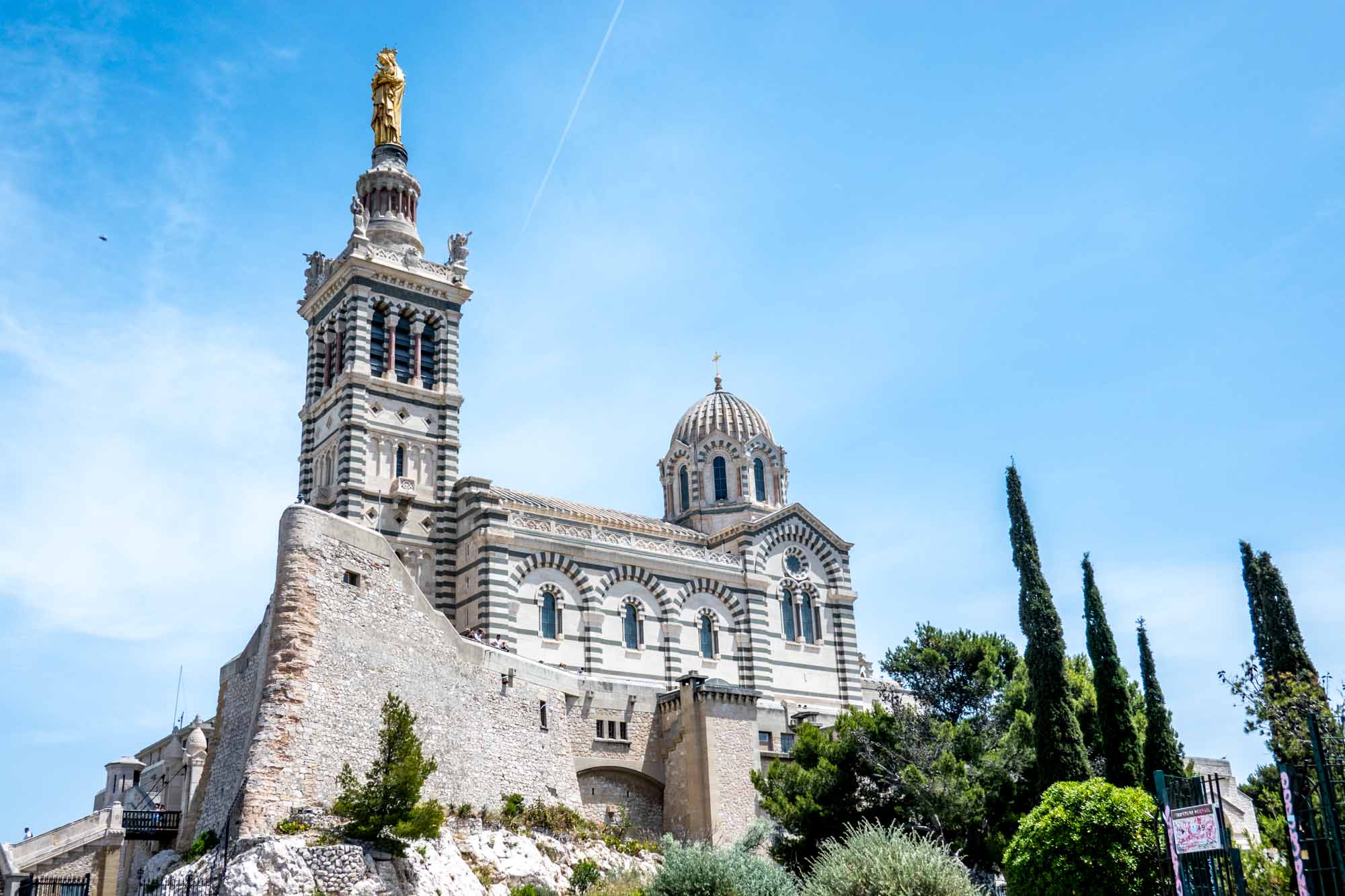
The second largest city in France, Marseille is a sprawling metropolis with a history stretching back to 600 BC.
The cosmopolitan city has been an important trading hub since the Middle Ages and has been influenced by all the cultures coming here to do business from southern Europe to North Africa, Asia, and beyond. The Old Port is still at the heart of the city where visitors and locals stroll along the harbor, watch the boats come in, and catch sightseeing cruises to visit the calanques.
One of the best views of the Old Port is from Notre-Dame de la Garde , a hilltop basilica filled with mosaics and topped with a gilded statue of the Madonna and Child. A visit here is one of the top things to do in Marseille.
Marseille has numerous notable museums and a sprawling park (often compared to New York’s Central Park) built around an 18 th -century mansion complete with walking paths, a rose garden, and a lake. For something completely different, visit Cours Julien and Le Panier, the biggest areas for street art in the city .
L’Isle sur la Sorgue
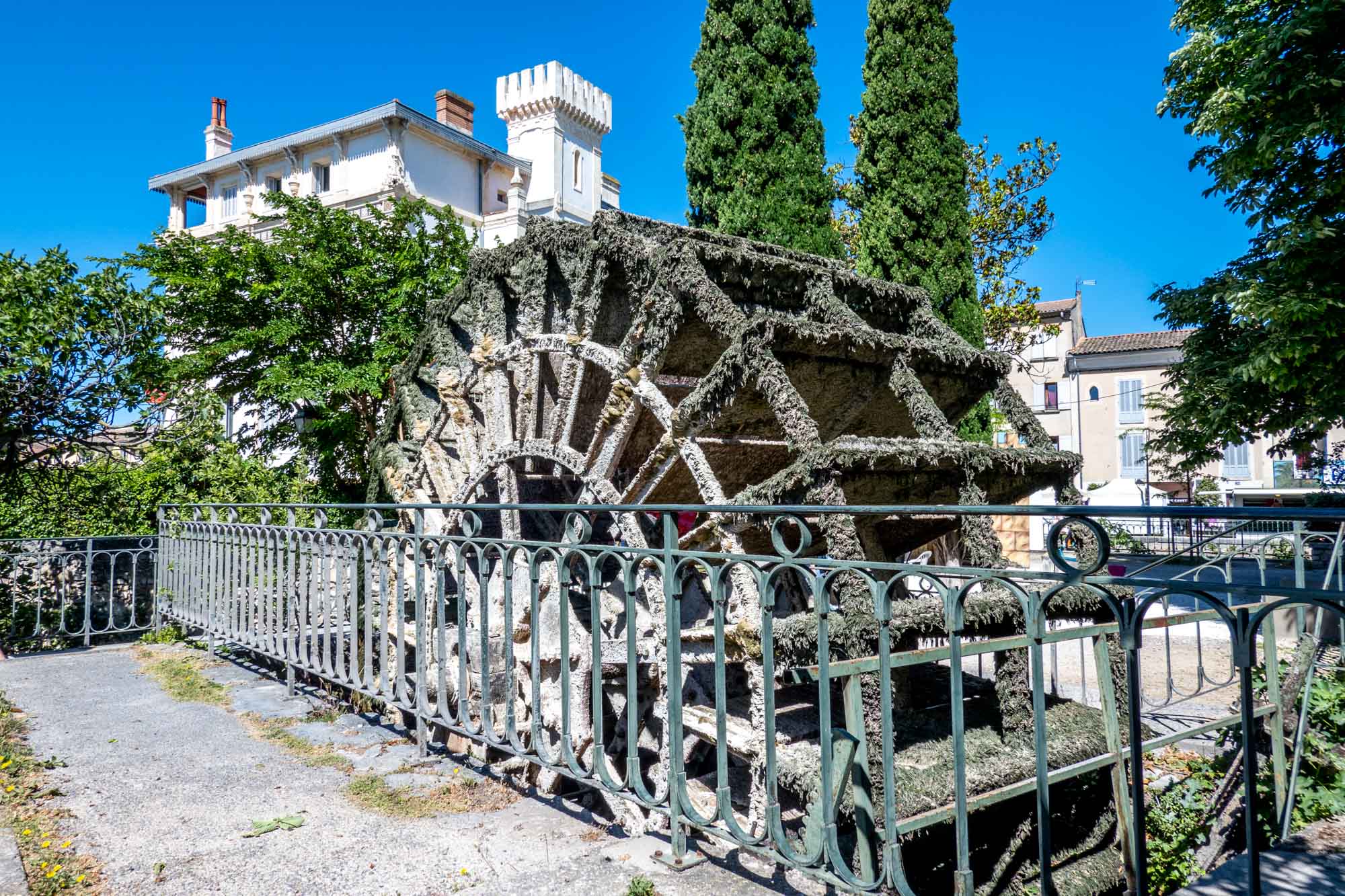
The picturesque town of L’isle sur la Sorgue is situated on the Sorgue River whose canals run beside the ancient streets. Many of the waterwheels that once powered the silk, dyeing, and paper industries are still in place, giving visitors a glimpse into the town’s rich past. Some of them still move, though the show is now just for people’s enjoyment.
In addition to its beautiful setting, people are drawn to L’isle sur la Sorgue for “treasure hunting” and the promise of a bargain. Nearly 300 antique dealers call the town home and specialize in art, furniture, and all manner of unique items. They have an important place in the large weekly market that spills forth all around the center of town.
Visitors will also enjoy the historic mansions that have been converted into art galleries. Don’t miss the Hotel Donadei de Campredon , an 18th-century mansion that is now an art museum featuring modern and contemporary art including sculpture, paintings, and photography.
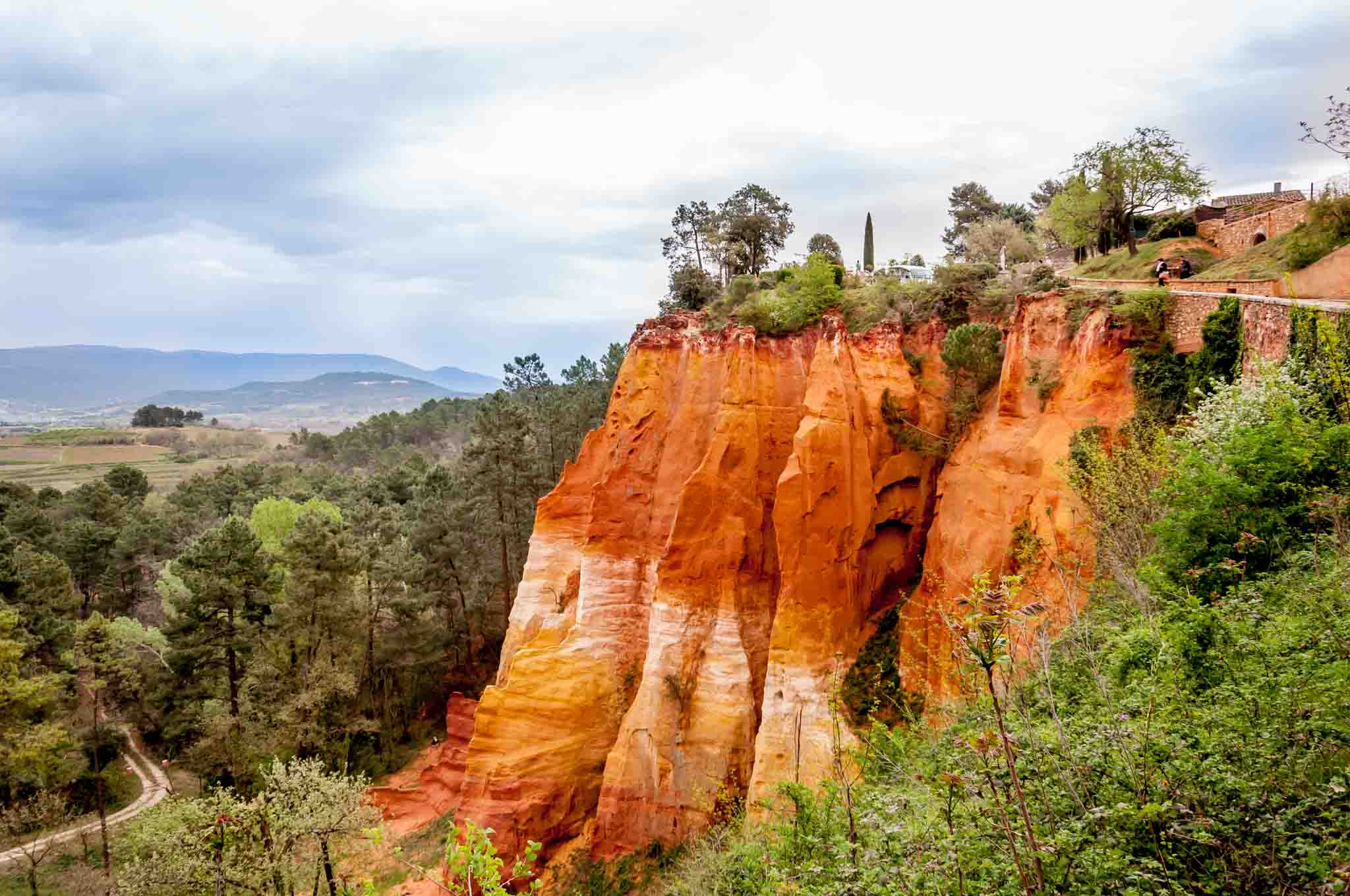
Roussillon has been a protected village since 1943. With less than 1300 residents, it has no modern development – just cafes, winding lanes, and amazing views.
The village is most known for having the largest ochre deposit in the world, which is found on the south end of town. The yellow, red, and orange hills are hard to believe until you actually step foot on the brightly hued paths. If you want to walk through the unusual landscape ( a significant landmark in the country ), there are 30- or 60-minute routes to choose from, but pick your clothing carefully so you don’t end up with stained pants or shoes.
If you visit Roussillon on Thursday, take the opportunity to visit the small weekly market. It focuses primarily on specialty items such a linens, soaps, wines, and ochre pigments.
Pont du Gard
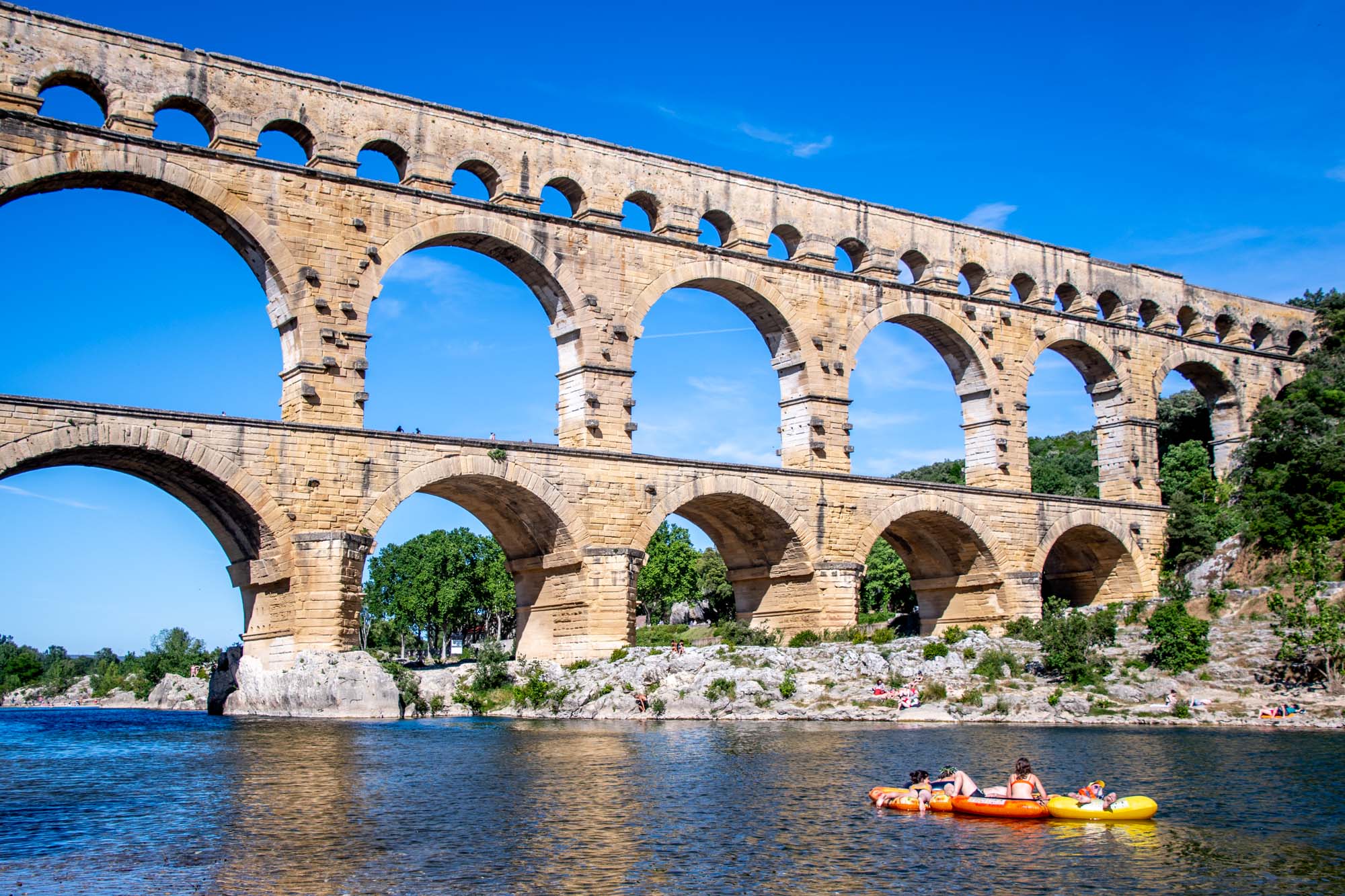
One of the most popular places to see when touring the South of France is the Pont du Gard . It’s difficult to imagine the sheer size of the 2000-year-old aqueduct until you see it up close.
The three tiers of the impressive Roman ruin tower 160 feet above the Gardon River. In the summer, people flock to kayak and swim in the chilly waters that flow around the aqueduct.
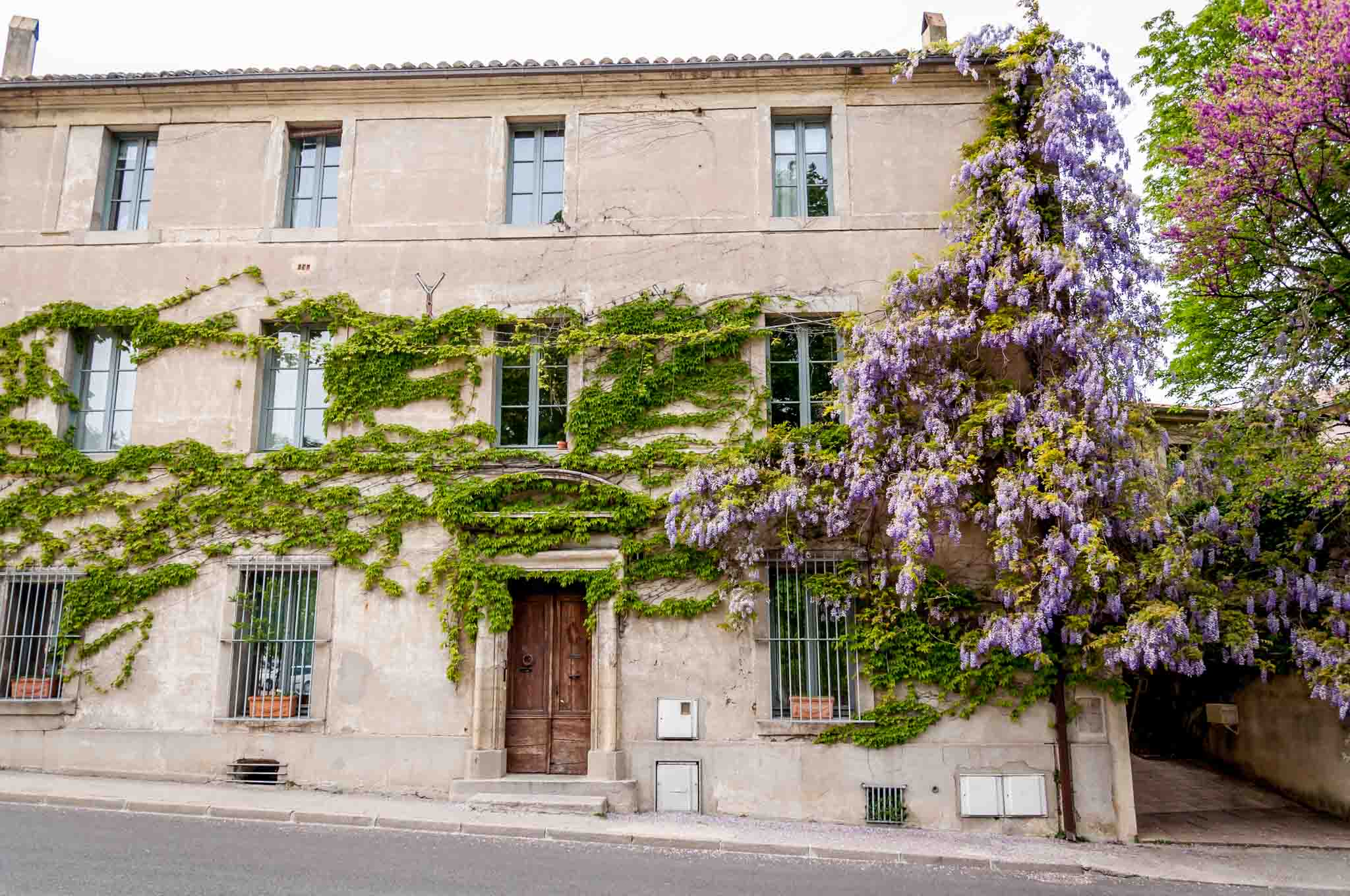
The old town of Uzes is ringed by circular streets. In the Middle Ages, these streets were walls designed to protect the Duke’s Castle at its heart. Visiting the town, you can still see towers, medieval gardens, the castle, and streets that make you feel like you’ve stepped back in history about 800 years.
While the towers and medieval structures are impressive, the real appeal of Uzes comes in wandering through its streets and among its limestone buildings. It’s even better if you find yourself in town on a market day.
On market days—Wednesday and Saturday—much of the town feels taken over by the market sprawling through the streets, though is it centered around the Place aux Herbes. Wednesday is focused on food, including locally grown produce and specialties. The Saturday market adds flowers and household items such as linens, housewares, clothes, and jewelry.
At the same time, regular businesses set up shop outdoors and all the sidewalk cafes fill with people. The atmosphere is welcoming and lively.
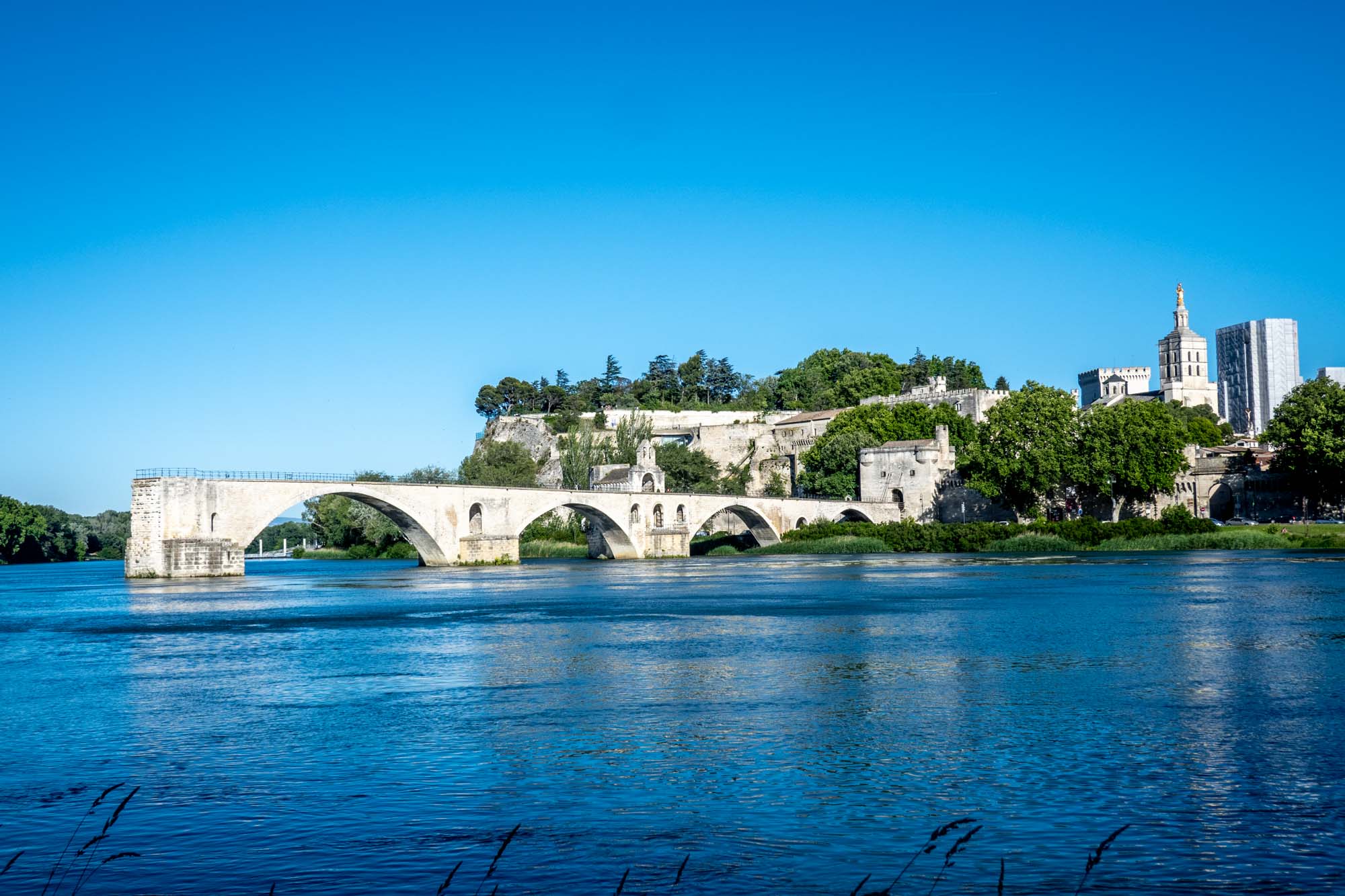
Avignon is a lively city teeming with businesses, cafes, a university, and tons of character. The attractions of its historic core have been recognized as UNESCO World Heritage Sites thanks to their architecture and the unique events that took place here.
At the heart of Avignon is the Palace of the Popes, the largest Gothic palace in Europe. In the 14th century, it was the home of the popes when the papacy moved to Avignon from Rome. Seven legitimate popes and, later, two anti-popes ruled the Catholic Church from France while living here. Though it was was once lavishly decorated, the palace was plundered over the centuries. Nevertheless, it remains one of the top places to see in France.
There are lots of things to do in Avignon beyond the palace as well. Walk along Saint Bénezet bridge (aka Pont d’Avignon), the famous 12th-century bridge to nowhere. Have lunch at one of the restaurants on Place de l’Horloge or stroll through the Parc Rocher des Doms. End your day at Pinotage, a floating wine bar in the Rhone River where you can watch the sunset over the city.
If you’d like to explore beyond the center, head to Manguin Distillery, which has made its famous pear brandy for over 50 years. On Saturday mornings you can join a distillery tour and taste a variety of their products. You might even see bottles attached to the trees outside where the the pears are actually growing inside the bottles.
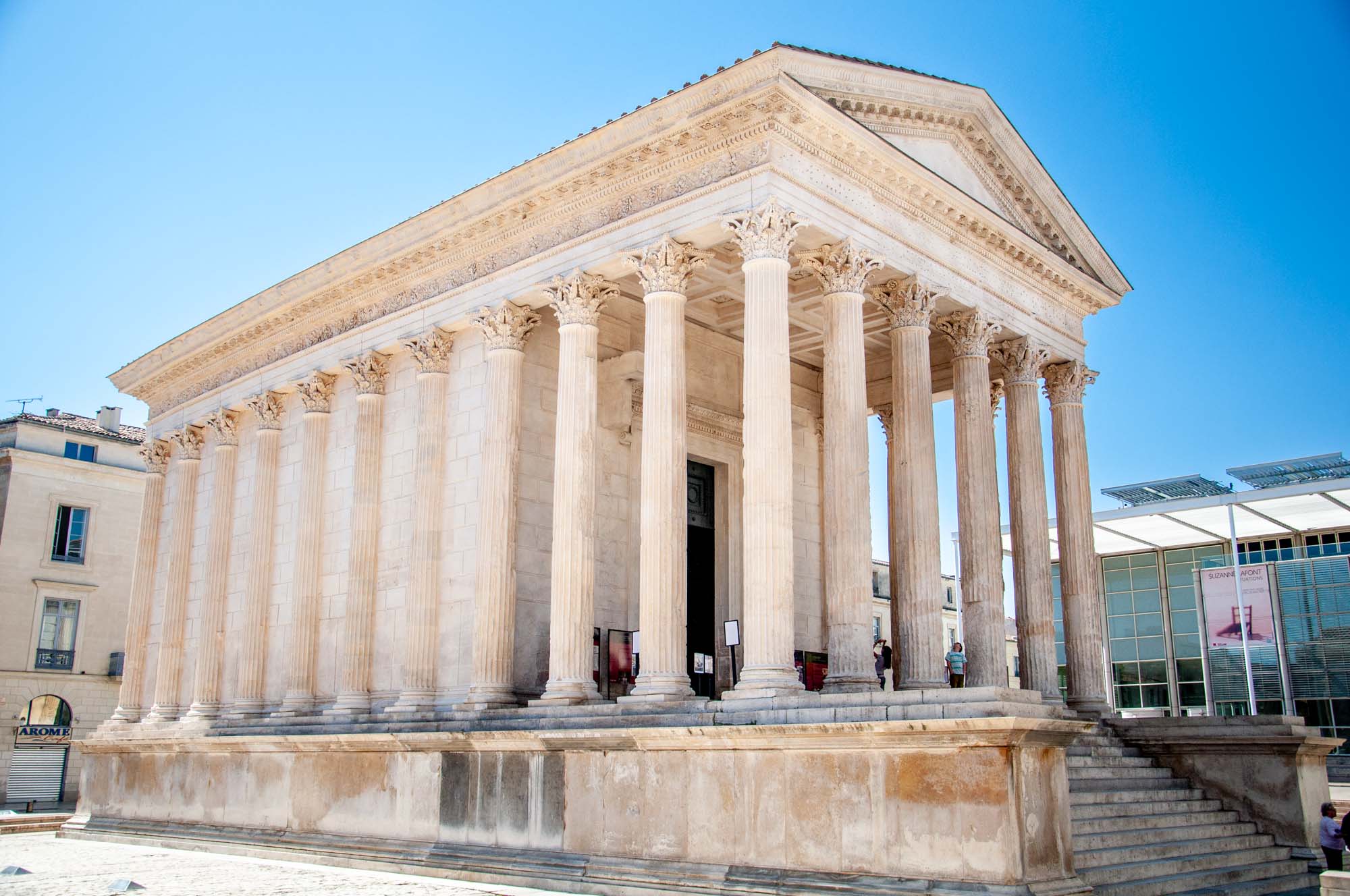
Nimes is a workaday city with a handful of well-preserved Roman ruins.
Its covered food market, Les Halles , bustles with energy as locals buy Provencal specialties such as brandade de morue (pureed salt cod and olive oil) or green olives. As with the other markets, there is also plenty of meat and vegetables on offer plus a handful of restaurants where locals gather sipping wine and catching up on the news.
A short walk from the market is one of the ruins, the Maison Carree . It is one of the best-preserved temples in the Roman Empire, which is amazing when you consider that it is over 2000 years old. Nearby, the Arena of Nimes, which dates from 70AD, is a preserved Roman amphitheater where visitors can still walk the ancient arcades.
Wrap up your trip with a stroll around the gorgeous Les Jardins de la Fontaine, a 18th-century public park with gardens and ponds. If you would rather be indoors, visit the Musée des Beaux-Arts of Nimes . It is a fantastic museum featuring a collection of 3600 impressive works of fine art and sculpture from Roman times to the Old Masters.
Porquerolles
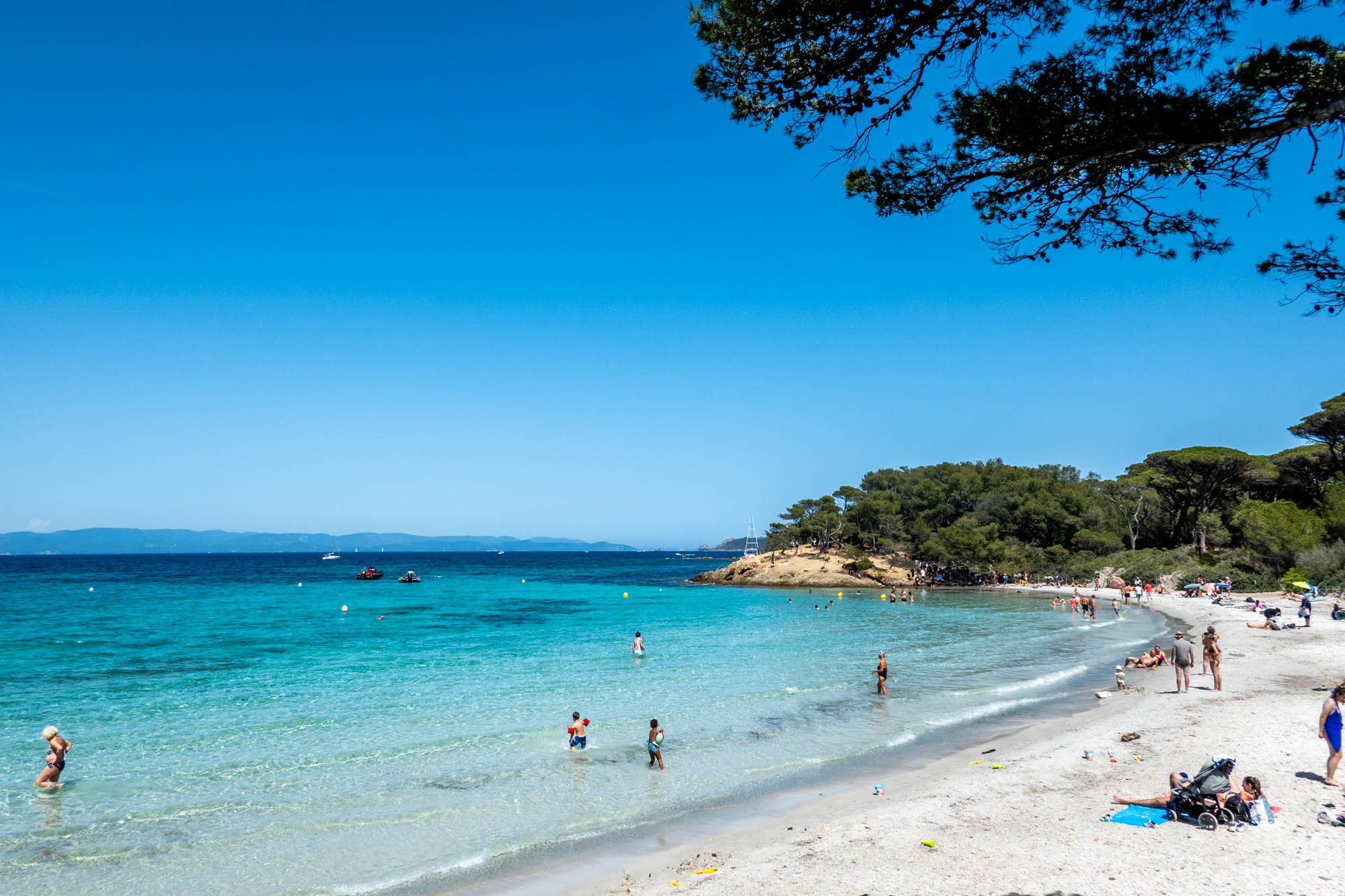
Off the southeastern coast of France, the small island of Porquerolles is a unique getaway. Only about 200 people live on this car-free island where much of the land is part of a national park and nature conservation area.
A 15-minute ferry ride from Hyeres on the French Riviera takes visitors to the port of Porquerolles where you can walk or rent a bike to visit the local beaches, shops, and vineyard. There is also an art gallery and a 14 th -century fort with a beautiful viewpoint. We spent a day relaxing on Plage d’Argent and are already plotting a return.
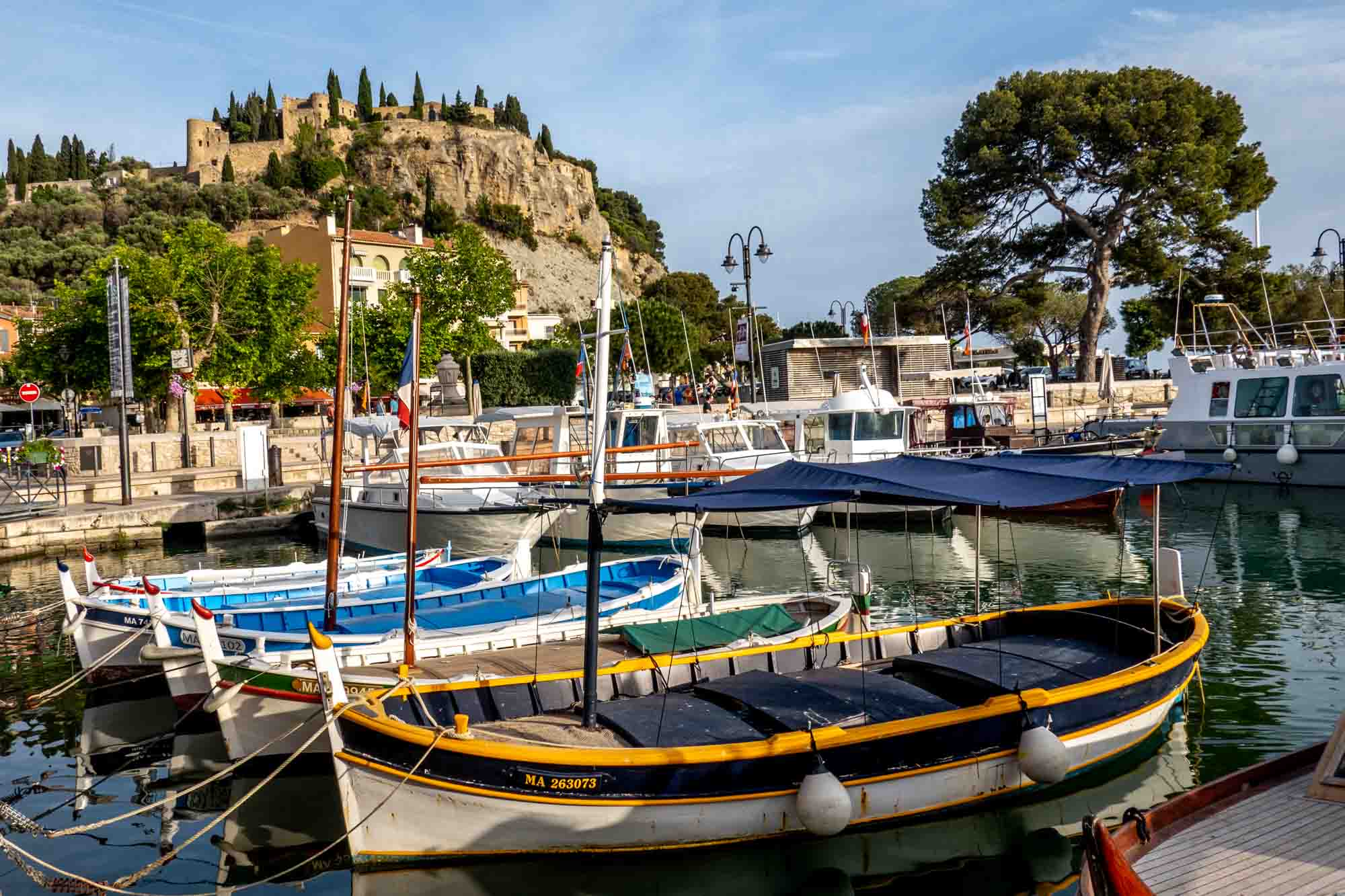
Cassis is a gem of a town. With stunning natural features, harborside restaurants serving great food, and a dramatic mountain drive, we love it so much that we’ve included it in our southern France travel on two trips.
The town is most noted as a jumping off point to visit the calanques— white limestone cliffs that plunge dramatically into the Mediterranean Sea. Some of them have small beaches that can be visited by hiking in. Sea kayaks and boat tours are also popular ways to see them from a little further away.
If you want to stick a little closer to town, walk the marina area to browse the shops or go to the beach that’s just steps from the center. Relax at one of the cafes with some fresh seafood while you marvel at the colors of all the boats. Consider a sunset drive (or take a taxi) on La Route des Cretes , a breathtaking mountain drive that takes you high above the town for one of the most scenic things to do in Provence .
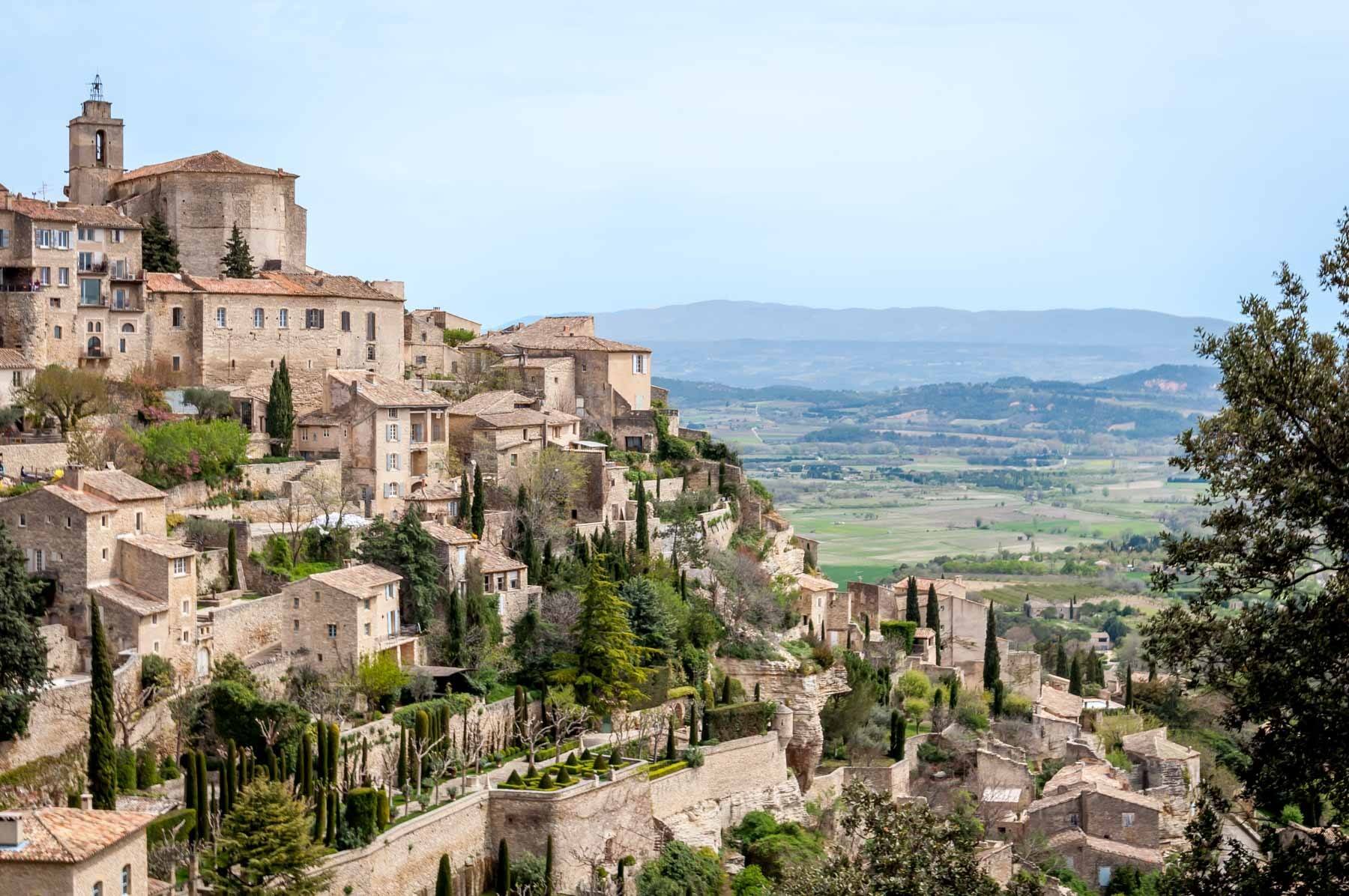
The hilltop village of Gordes is one of the cutest in France. The impression it makes is dramatic from the moment you first see it, seeming to tumble down the hill from its perch high above the valley.
Close up, the stone buildings of Gordes are laced together by narrow cobblestone streets that climb or descend the hill, depending on your perspective. Major sites include Gordes Castle, which originally dates to 1031, and the Cellars of Saint Fermin Palace , a site carved out of rock by Gordes residents in the Middle Ages that includes an olive oil mill, cisterns, and more.
Chateauneuf-du-Pape
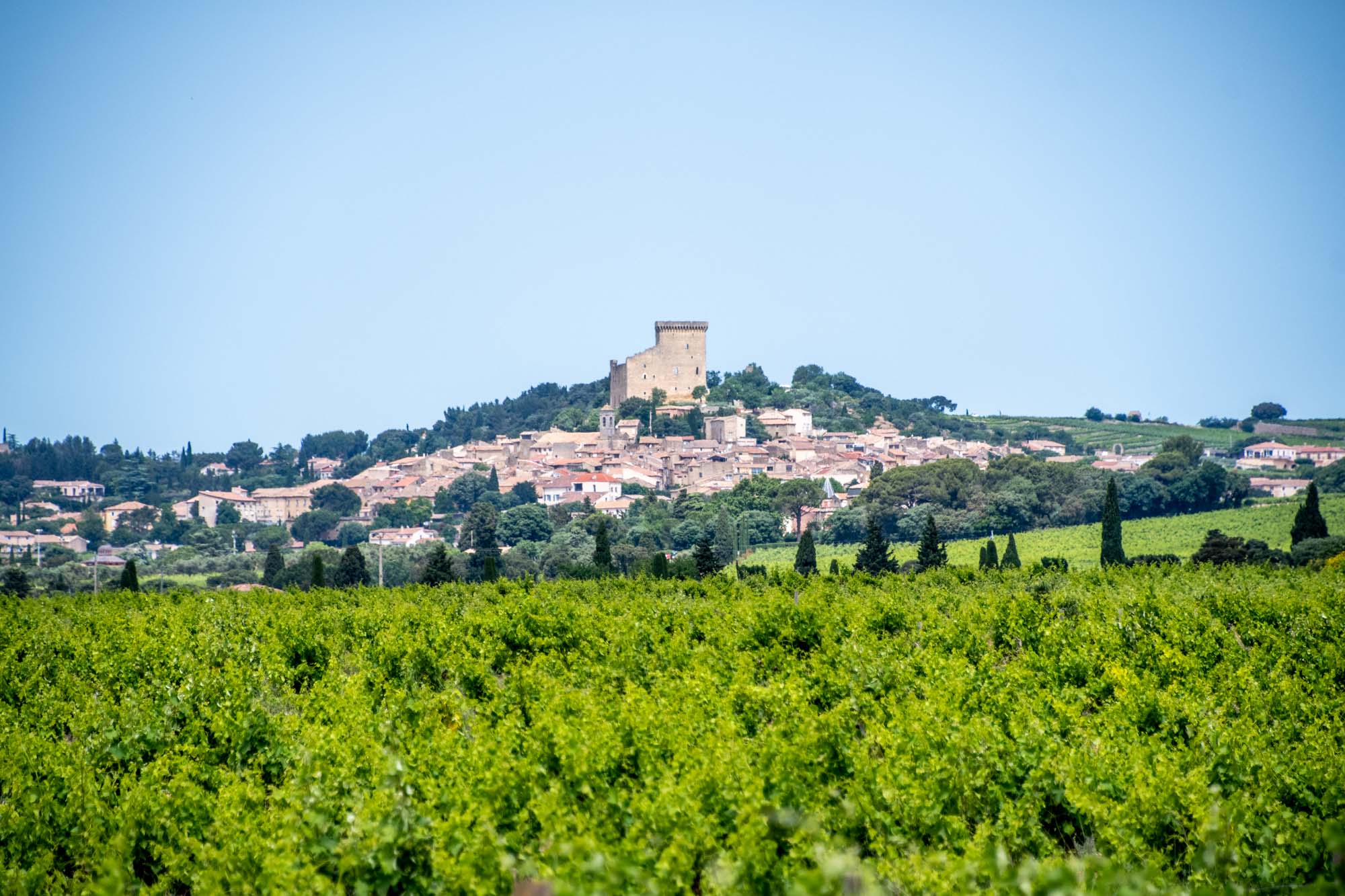
Châteauneuf-du-Pape is all about wine. The tiny town not far from Avignon appears to rise up from a hill surrounded in every direction by vineyards.
At its center is part of the chateau built by Pope John XXII in the 14th century as a refuge from the city’s heat in the summer. During their time here, it was the popes who planted the town’s original grapevines. Over the years, the chateau was partially destroyed, but the part that still stands can be seen from miles around.
The tiny village has a selection of good restaurants and medieval houses in its winding lanes. And, of course, there are lots of wine shops and cellars. Many of them offer tastings of the area’s famous wines. Most are red, but there is also a selection of good whites available.
There are also lots of surrounding wine estates that welcome visitors. Chateau des Fines Roches is one of the newer, more commercial estates, but the wines are good and you’re guaranteed to be able to taste at almost any time.
Ancient Roman Theatre of Orange
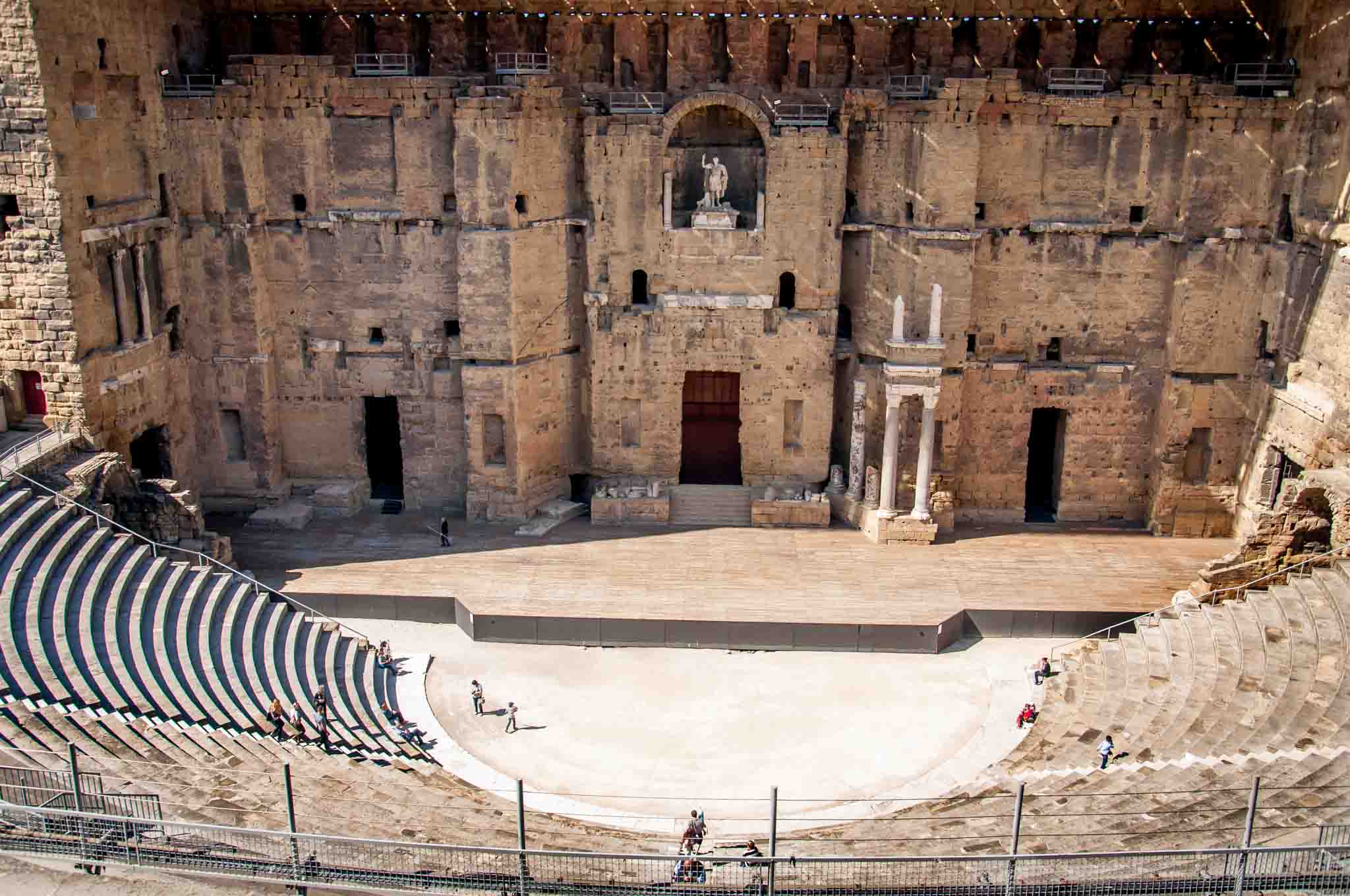
The city of Orange, France, is renowned for its Roman architecture. Its main site, the Ancient Theater of Orange , is astonishingly well preserved for a 2000-year-old structure, and it is still used for special summer performances.
The original statue of the Emperor Augustus still looks down on the crowd from its original niche on the stage. Visitors can climb on the ancient seats and even walk on the historic stage.
Saint-Emilion
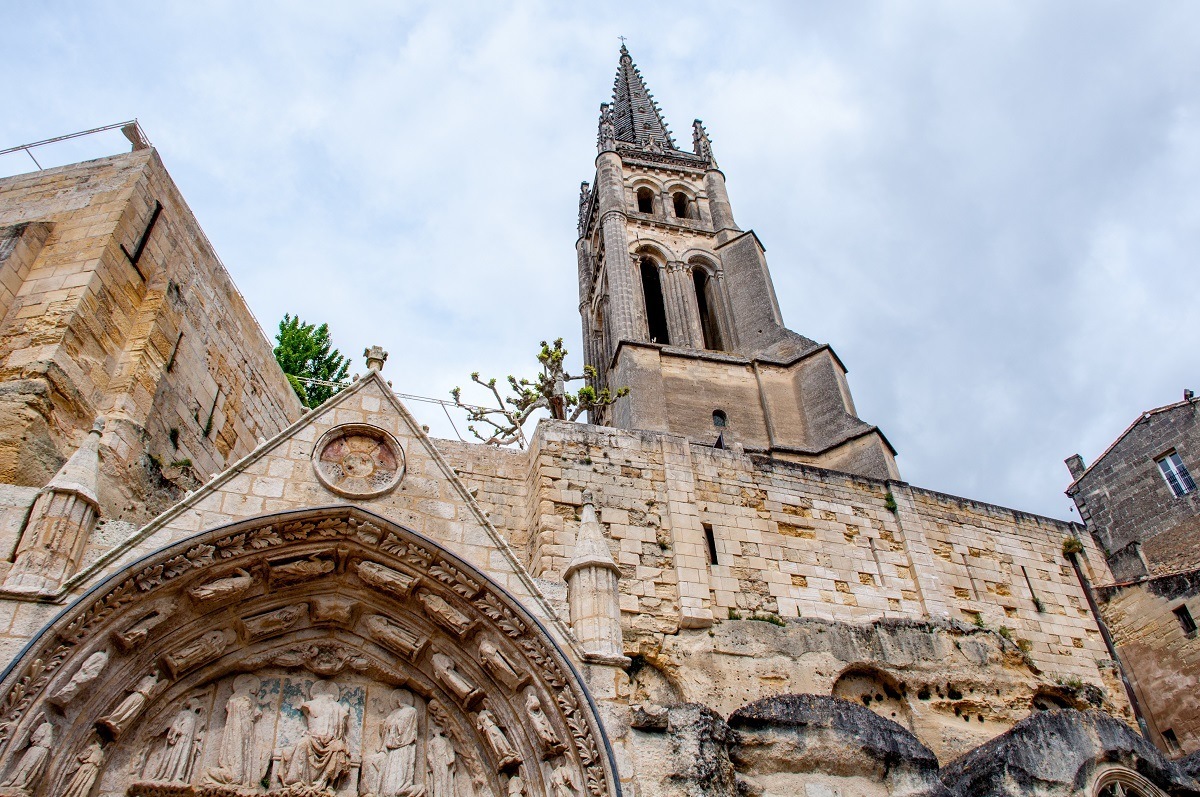
The tiny town of Saint-Emilion has welcomed visitors for centuries to sample the rich red wines the area is known for.
There are nearly 1000 chateaux to choose from in Saint-Emilion, so the decision about where to go can be a hard one. if you’re not able to make plans in advance, the tourism office can suggest a few that are open the day of your visit.
Beyond the vineyards, Saint-Emilion is known for its UNESCO-listed Monolithic Church . The underground church was dug out of limestone in the early 12th century in honor of the hermit monk Emilion who lived in a cave on the site 400 years earlier. The tourism office offers daily tours of the church, the catacombs, and related sites, which is the only way to get an inside look at this part of the village’s history.
Wandering the steep alleys of the village is also a great way to spend an afternoon. Stop at a restaurant, browse the shops, and take in the views. L’Envers du Décor is an excellent option for lunch, and you can stop by the historic Les Cordeliers cloisters to enjoy the grounds and taste their range of Crémant de Bordeaux sparkling wines.
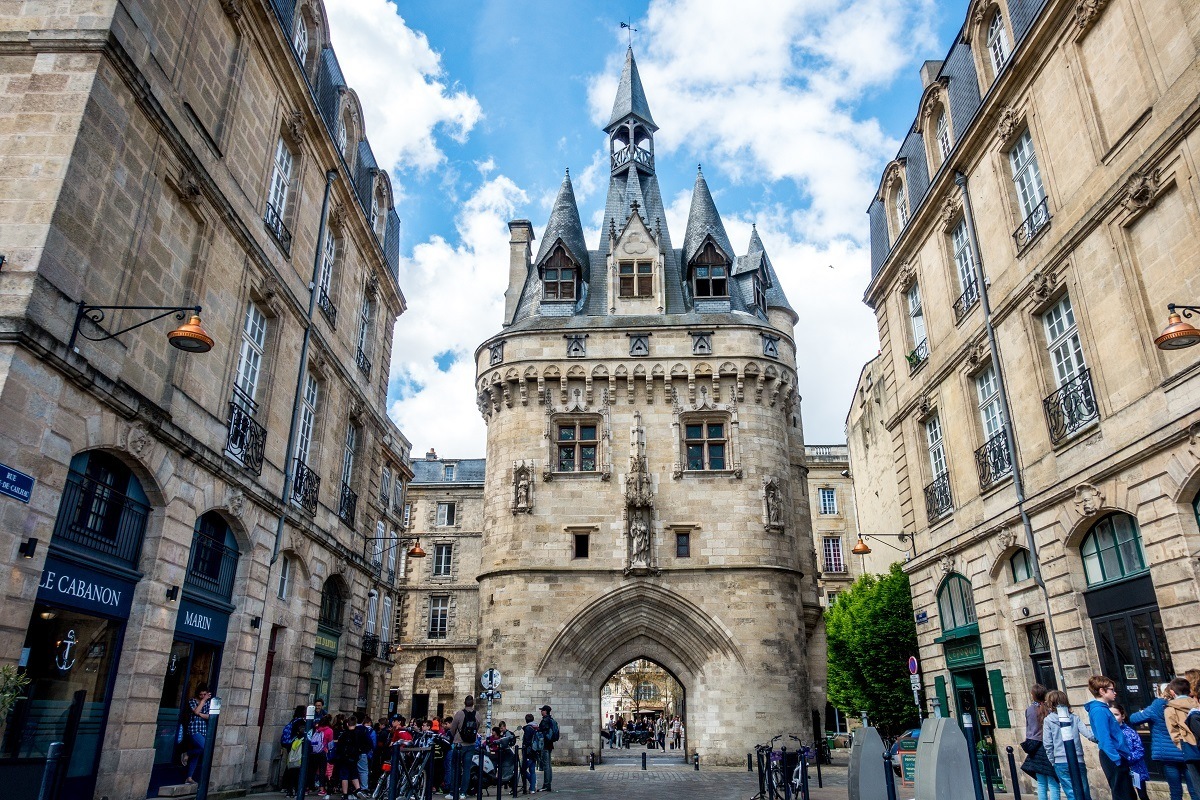
Exquisite architecture, fresh seafood, a vibrant city with an historic core, and some of the best wine in the world—these are the things that make Bordeaux one of the best places to visit in the South of France. Even better, the whole city is highly walkable, with pedestrian-only areas and welcoming squares.
There is an endless selection of things to do in Bordeaux . Visit Mirior d’Eau, a giant pool that creates a unique reflection on its surface. Stroll under the trees at Place des Quinconces, the largest city square in France, and visit one of the regular festivals there. For a break, check out the vendors at Les Halles de Bacalan , a modern food hall with over 20 different merchants.
Don’t miss La Cite du Vin , the amazing, interactive wine museum where you can learn all about wine making and sample lots of varietals from around the world. For a slightly different take on imbibing, visit Moon Harbour Distillery —the first whiskey distillery in Bordeaux. Take a tour or do a tasting at its unique facility, a former German World War II submarine bunker.
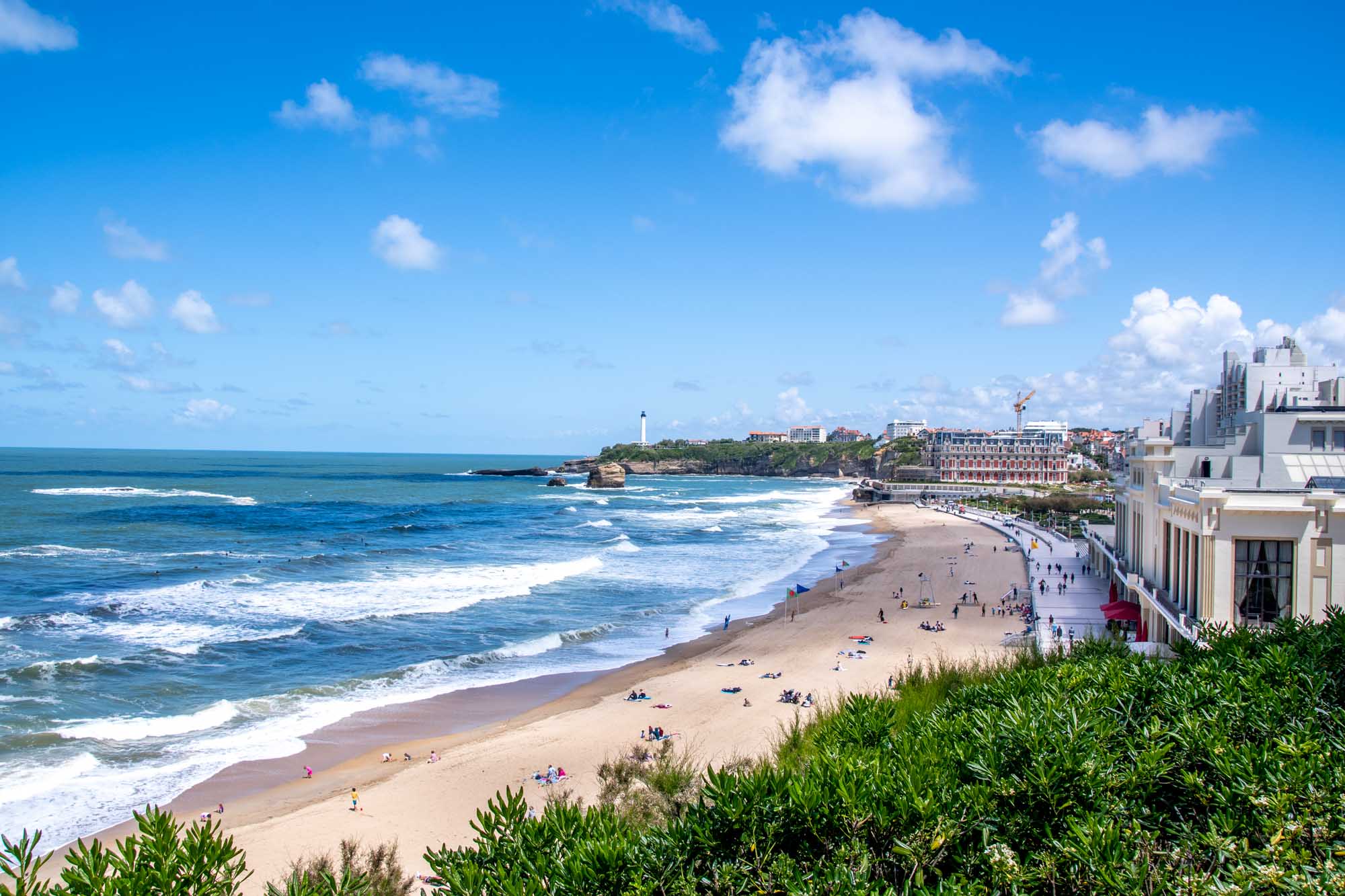
Biarritz is all about the ocean. On the coast of southwestern France and just 20 miles from the border with Spain, this luxurious destination in the Basque Country welcomes visitors to enjoy its sun and sand.
Windy Biarritz is the surfing capital of Europe, drawing people from around the world for casual enjoyment as well as competitions. Even if you’re not surfing yourself, it’s fun to watch the riders do their best tricks among the waves.
The seaside destination also has attractions focusing on the ocean. At the Biarritz Aquarium , visitors can see 50 aquariums filled with thousands of species of sea life, including sharks, seals, rays, and turtles. Just down the coast at City of the Ocean , you can try the surfing simulator, experience the virtual reality shark exhibit, or listen to seafaring explorers explain the mysteries of the ocean.
For something a little calmer, enjoy the Grande Plage, try your luck at the Bellevue casino, or explore the Hotel du Palais—a grand hotel that was originally the imperial residence of Napoleon III and Empress Eugenie.
Saint-Jean-de-Luz
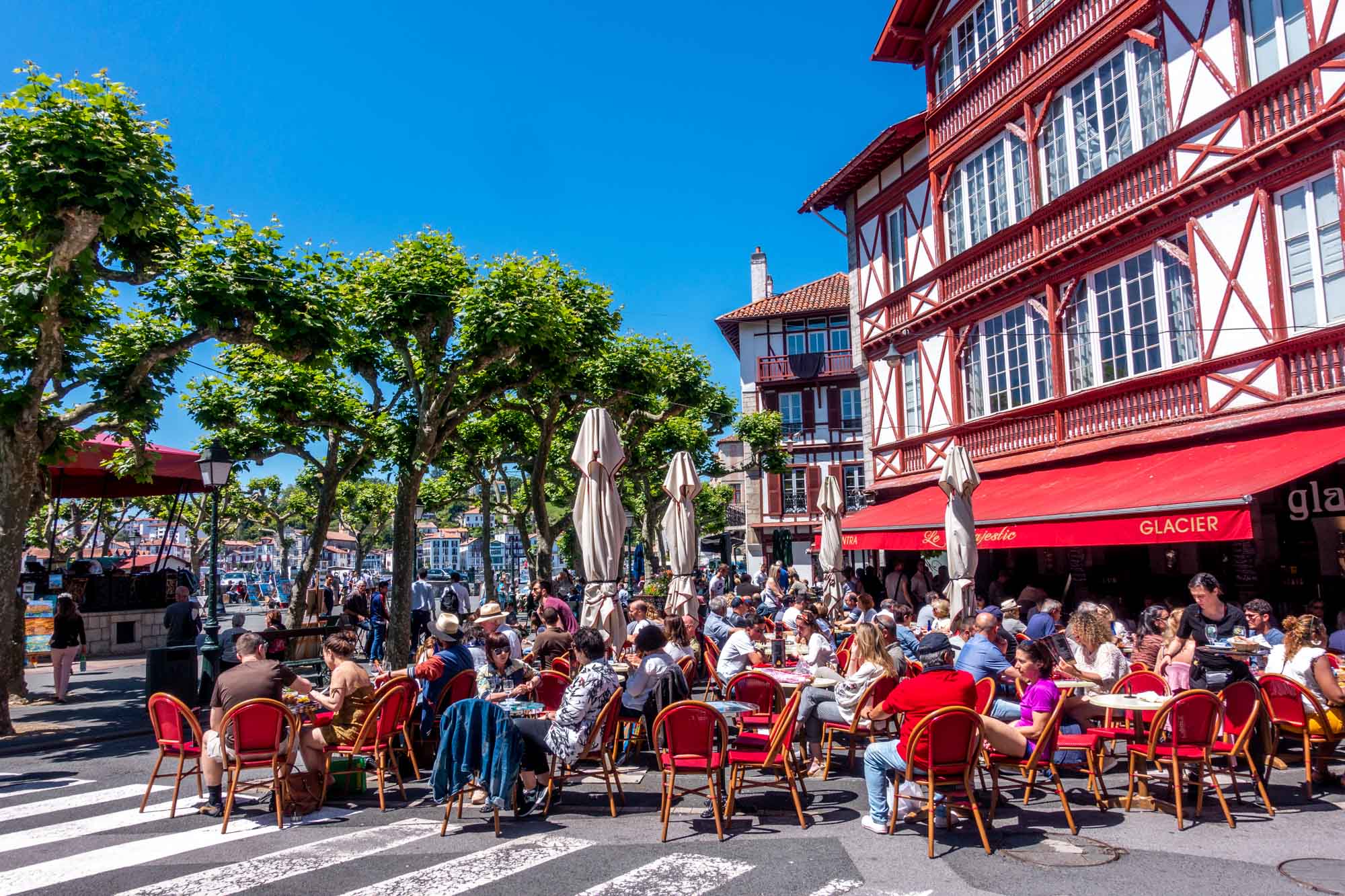
A short drive from Biarritz, the coastal town of Saint-Jean-de-Luz is where to go in the South of France if you’re in search of relaxation. It’s all about enjoying the beach, surfing, and discovering charming town squares.
Like its northern neighbor Biarritz, Saint-Jean-de-Luz has ideal conditions for surfing and sunbathing. Walking along the seawall provides a great vantage point for seeing all the activity.
When you’re ready for a break from the ocean, check out the town squares. One of the most inviting is Place Louis XIV, which has lots of bars and restaurants plus occasional live music and painters who capture the scene en plein air (outside), which is fascinating to watch.
A few steps from the square, you can visit Maison Louis XIV , a 17 th -century home where the Sun King stayed while anticipating his marriage to the Infanta of Spain, Maria Theresa. They married in 1660 at the church of St-Jean-Baptiste nearby, which is also open for visiting.
Laura Longwell is an award-winning travel blogger and photographer. Since founding Travel Addicts in 2008, she has written hundreds of articles that help over 3 million people a year get the most out of their travel. In that time, she has visited nearly 60 countries on 5 continents, often returning to favorite destinations over and over again. She has a deep love of history, uncovering unexpected attractions, and trying all the good food a place has to offer.
In addition to Travel Addicts, Laura runs a site about her hometown of Philadelphia—Guide to Philly—which chronicles unique things to do and places to see around southeastern Pennsylvania. Her travel tips and advice appear across the web.
Share this post:
This site uses Akismet to reduce spam. Learn how your comment data is processed .
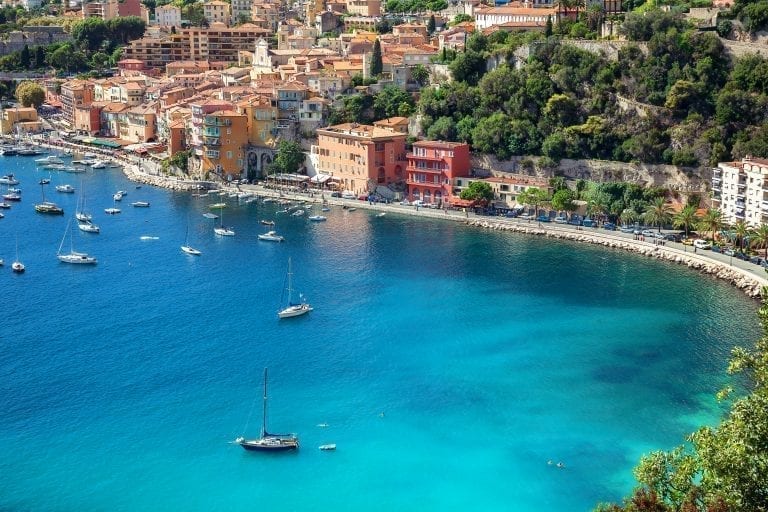
21 Epic Places to Visit in the South of France
If you start planning a trip to southern France, it quickly becomes apparent that there are endless amazing places to visit in the south of France.
From castles to medieval cities, from lavender fields to the sparkling sea of the Cote d’Azur, the south of France is absolutely littered with incredible places to visit–not even a lifetime could hope to cover them all.
While this list could never hope to be exhaustive (beautiful Bordeaux isn’t included here, for example), we’ve rounded up some truly epic places to visit in the south of France–including some of our personal favorite spots.
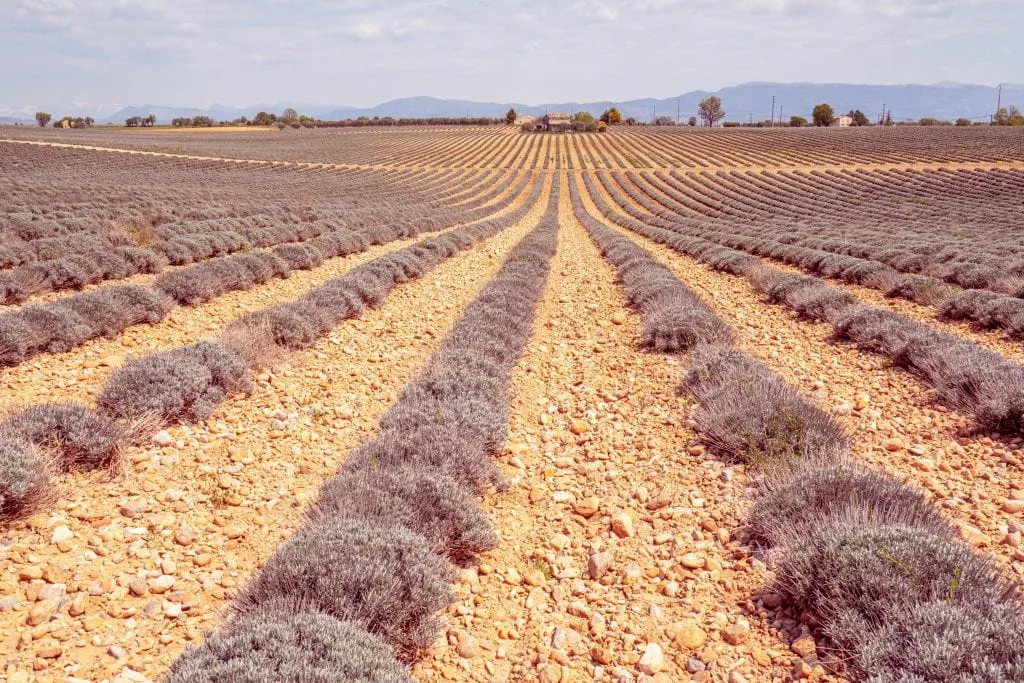
Some links in this post may be affiliate links. If you make a purchase through one of these links, we may earn a small commission at no extra cost to you. Please see our disclosure policy for more detail.
Table of Contents
Map of the Best Places to Visit in the South of France
Cities + towns, natural wonders & other highlights.
Take This Map With You! Click each highlight to pull up the name of the destination. To save this map to “Your Places” on Google Maps, click the star to the right of the title. You’ll then be able to find it under the Maps tab of your Google Maps account! To open the map in a new window, click the button on the top right of the map.
Once the home of popes–as evidenced by the incredible Papal Palace–Avignon is an incredibly relaxed and beautiful city that is the perfect jumping-off point to exploring Provence.
Don’t forget to check out the stunning Pont d’Avignon while you’re there!
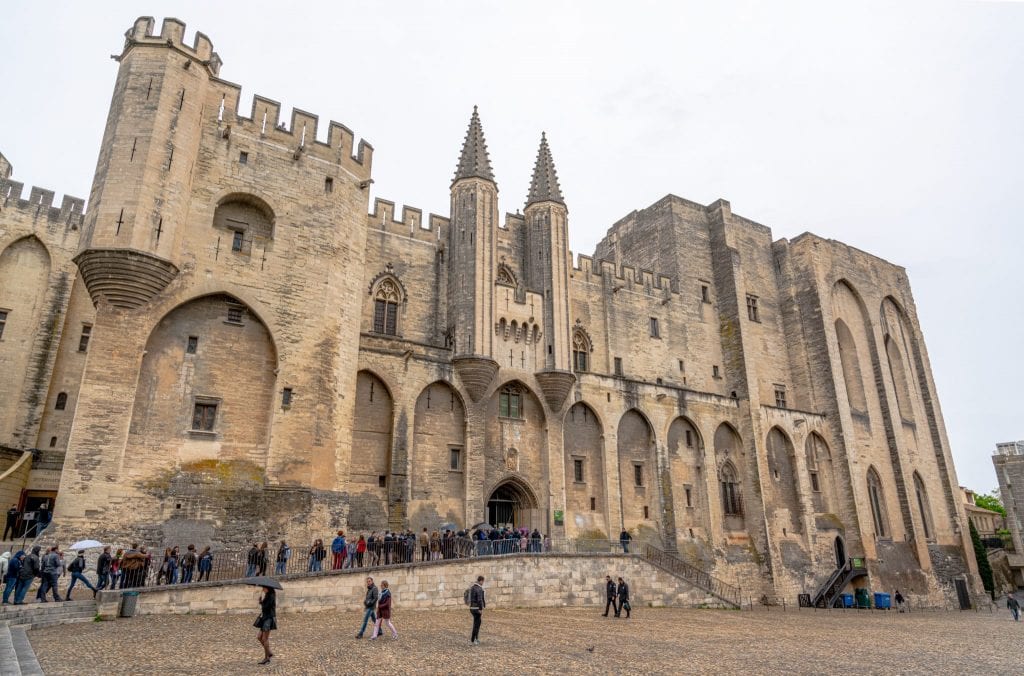
Aix-en-Provence
Once the capital of Provence, Aix-en-Provence is known for its colorful streets, its many fountains, its great location as a base to visit other places in Provence, and–best of all–its outdoor markets.
Plan your visit for a Tuesday, Thursday, or Saturday for the biggest concentration of markets!
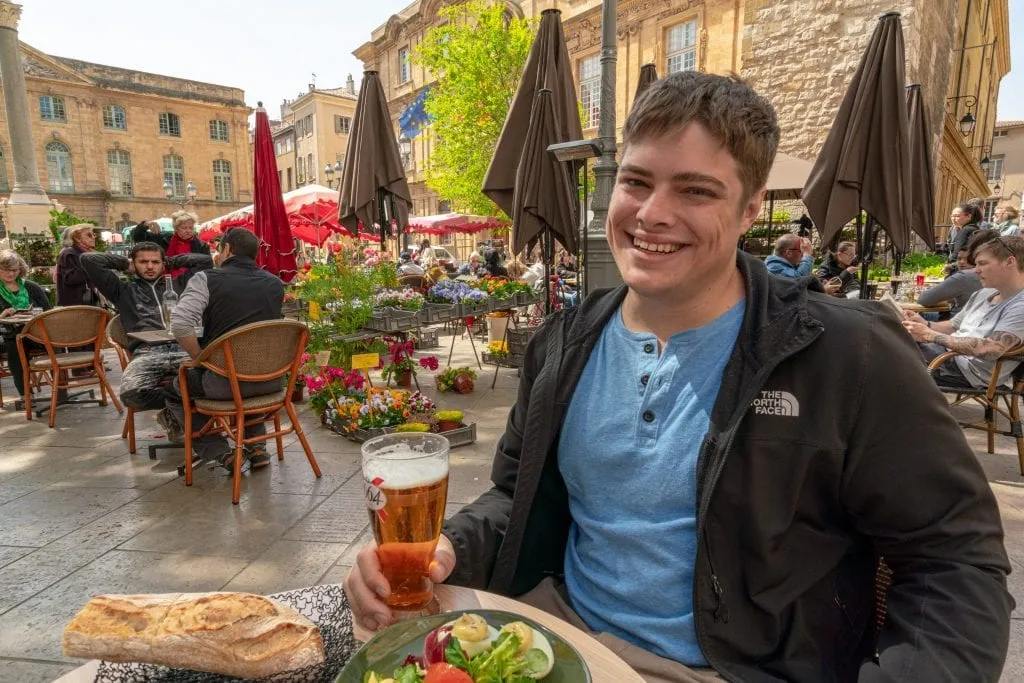
Saint-Tropez
Glitzy and glamorous to the core, Saint-Tropez is the ultimate French escape if you’re looking for a luxurious stay along the Cote d’Azur.
Once a medieval fishing village and later a port, Saint-Tropez is better known today for its beautiful beaches and the magnificent yachts that come to visit.
The adorable fishing village of Cassis looks more like it belongs in an impressionist painting than as a busy tourist destination less than an hour from Marseille–and we were completely charmed by this small town!
Cassis is also an excellent place to use as a base to explore Calanques National Park.
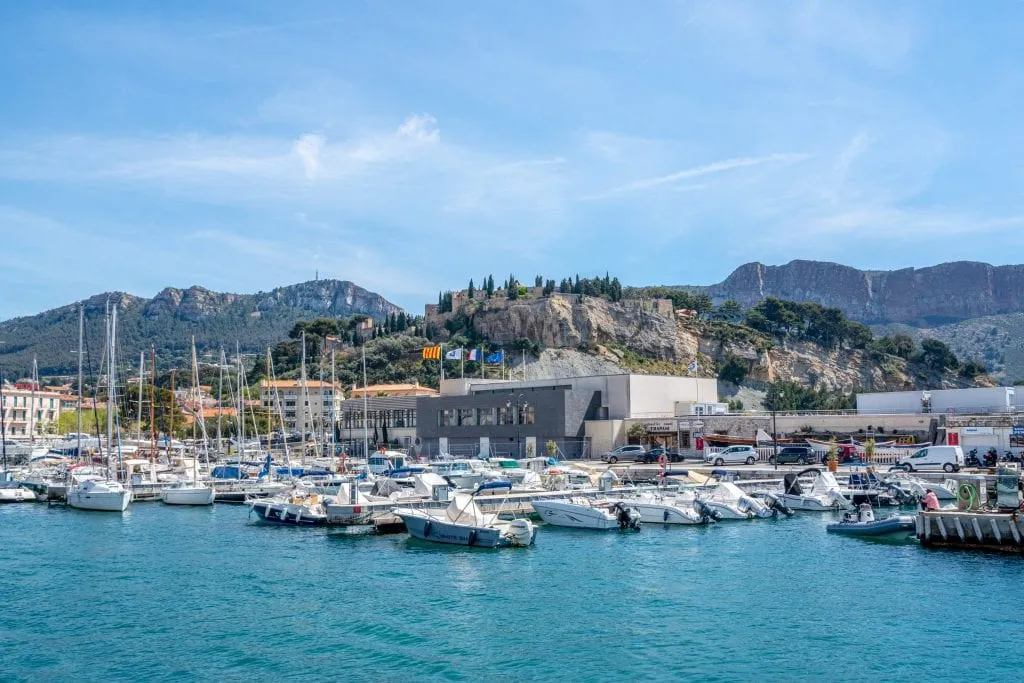
Located along the Rhône River, Arles is best known for its history as part of the Roman Empire and for inspiring many of the paintings of Van Gogh, who lived in Arles for a year. It’s also a great jumping-off point to visit the Camargue !
Possibly the best-known village of the Luberon Valley, Gordes is built directly into the hilltop it rests on, giving a whole new twist to the concept of a hilltop village!
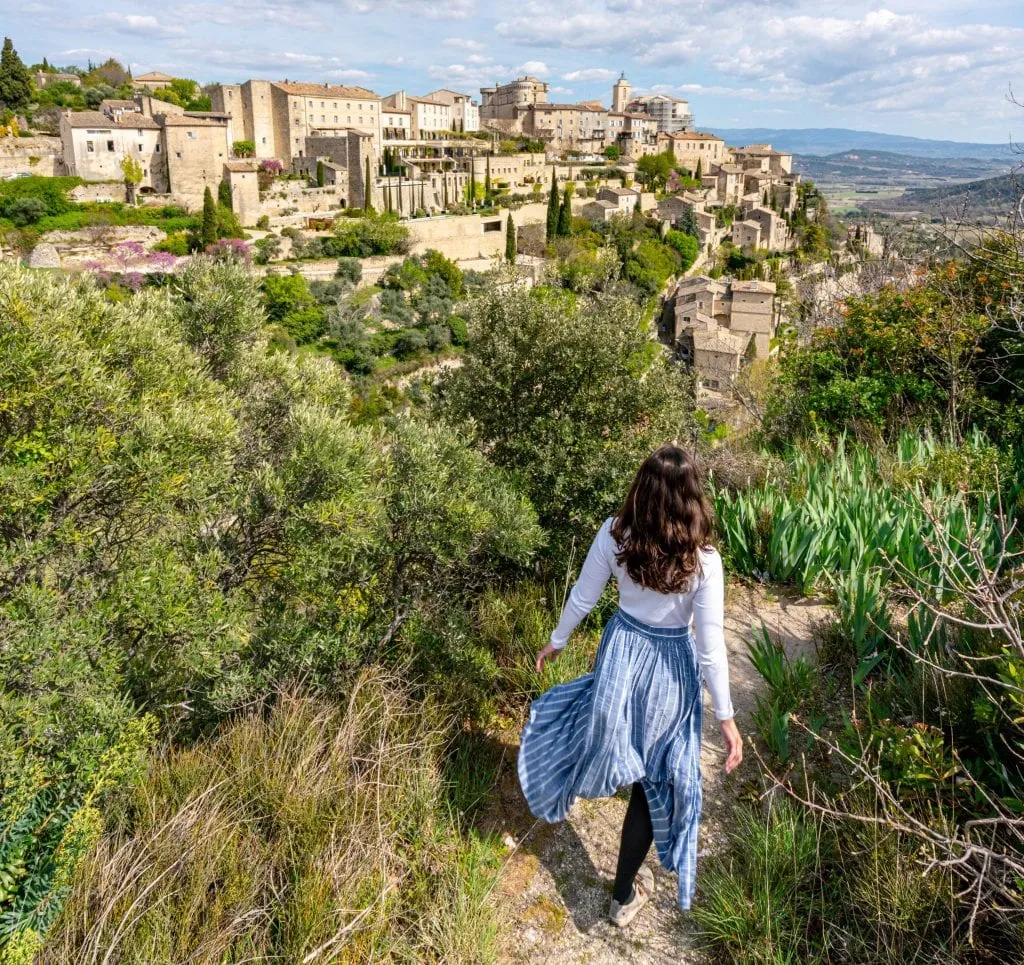
Of course, Monaco is not part of France–but how could any post about places to visit in the south of France leave off Nice’s famous neighbor, the glamorous microstate of Monaco?
Whether you want to doll up and try your hand at cards at the Monte Carlo or simply stroll the streets and admire the many impressive yachts, Monaco is certainly worth a quick visit.
Les Baux-de-Provence
Considered one of the most beautiful villages in France, Les Baux-de-Provence is as small as it is delightful.
Located in the Alpilles, come here both for the winding, narrow stone streets and the countryside views alike.
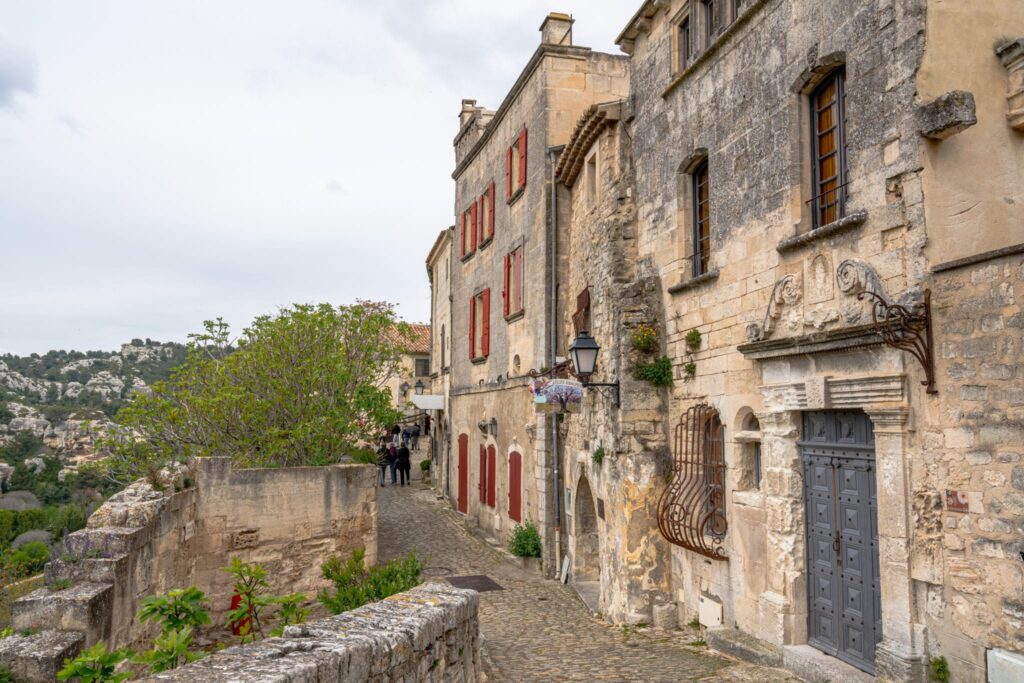
If you know one thing about Cannes, it’s likely that the city is home to the famous Cannes Film Festival.
Cannes goes well beyond its glamorous reputation in the film industry, though. Its beautiful beaches, gorgeous promenade, and the plethora of nearby day trips are all excellent reasons to visit Cannes.
As the biggest city on the French Riviera one of the most iconic beach cities in Europe , glamorous Nice is home to gorgeous markets, an incredible (and incredibly famous!) stretch of curving beach, tasty Nicoise salad, and an excellent location to use as a base for many of the incredible day trips in southern France.
Plenty of trips to the French Riviera start in Nice due to its large airport–but don’t just use Nice as a stopover.
I t’s lovely enough to deserve at least a little attention on your trip to the south of France!
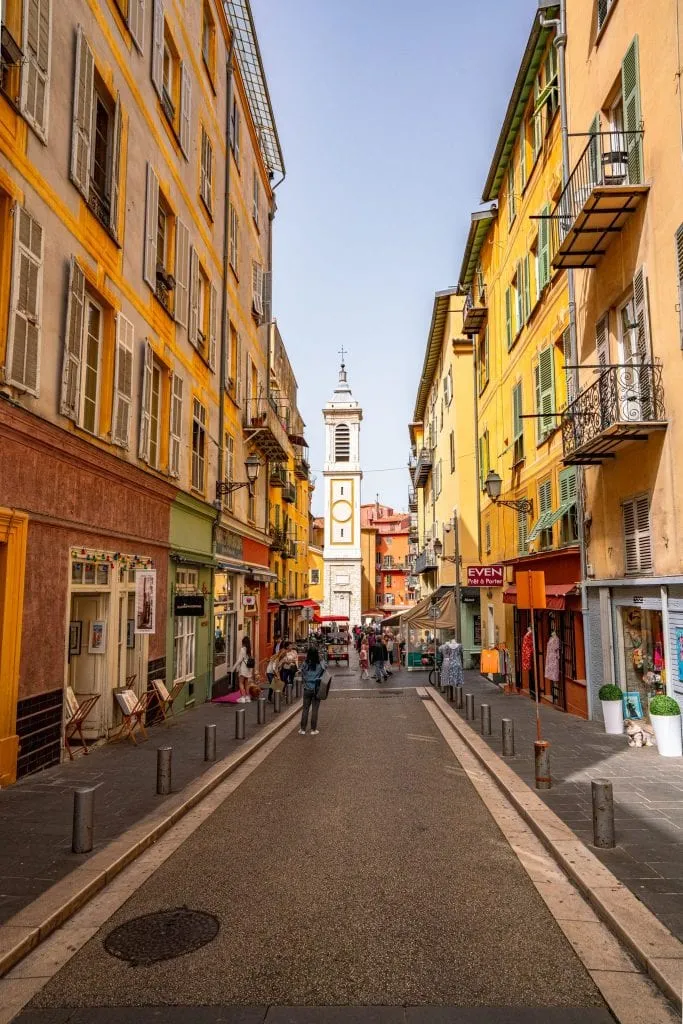
Fontaine-de-Vaucluse
Located right on the Sorgue River, the Fontaine-de-Vaucluse is best known for being home to the gigantic spring that feeds the river–a spring whose source you can visit while in town.
Even apart from the spring itself, though, Fontaine-de-Vaucluse has a storybook-like air to it: its location on the river combined with the typical Provencal charm of the town makes it an unforgettable village to visit in southern France.
Saint-Paul-de-Vence
Perched high above the Cote d’Azur, Saint-Paul-de-Vence feels like exactly what it is: an artist colony, plus a typical French hilltop town, plus a glamorous destination along France’s best-known coast.
Stand on the medieval walls that surround the town, and you can see all the way out to the Mediterranean Sea–but wander down a narrow cobblestone street inside the town, and you’ll feel like you’re back in Provence.
Also–don’t miss the corgi that hangs out at the cafe just outside the town walls! He alone is enough of a reason to add Saint-Paul-de-Vence to your list of places to visit in the south of France.
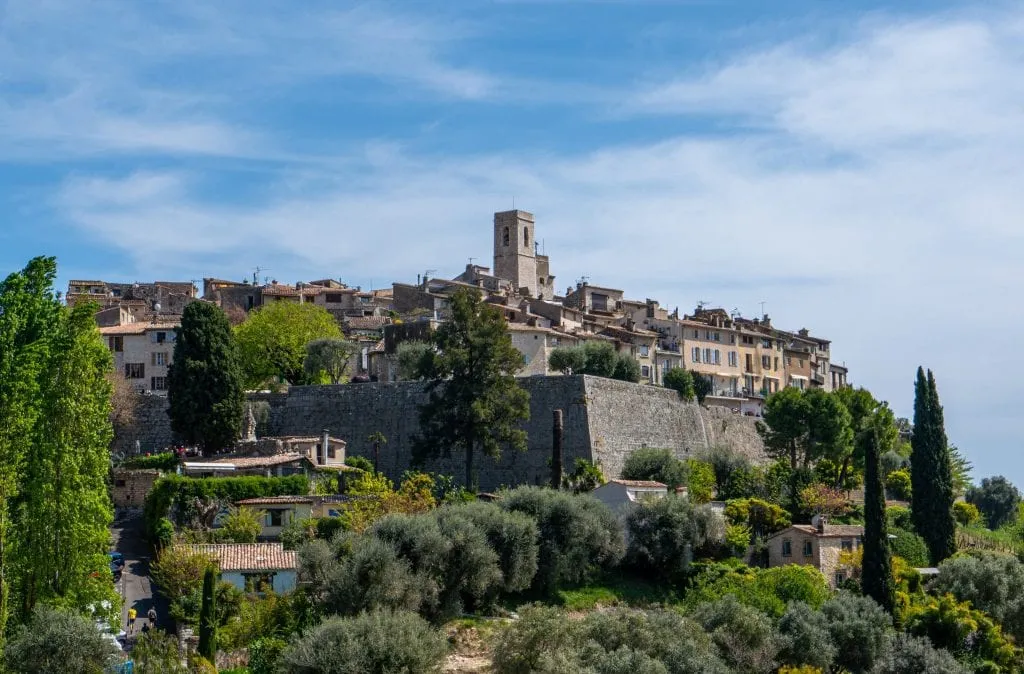
Perched on top of a hill overlooking the Luberon Valley, Bonnieux is all charming cobblestone streets and adorable houses–plus the gorgeous Vieille Eglise (“Old Church”) located at the highest point in town.
After exploring the area around the church, be sure to take plenty of time to admire the view over the valley–look closely, and you’ll be able to pick out villages like popular Gordes in the distance.
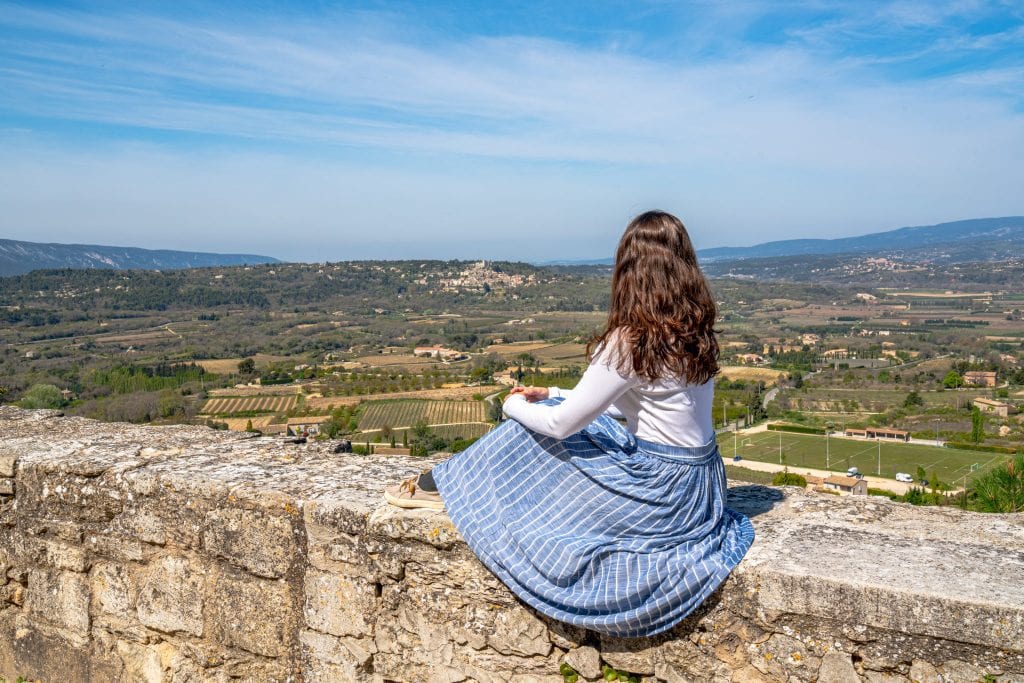
This incredibly bright and colorful French Riviera town reminds me of Italian getaways like Cinque Terre at first blush–and considering Menton is located near the border of Italy, that’s not surprising!
Come here in the summer for swimming, delicious food, and a lovely coastal escape–or in February for their incredible annual lemon festival!
Remarkably uncrowded and slightly more under-the-radar than villages like Saint-Rémy-de-Provence and Gordes, Goult has all the charm you could ever dream of in a Provencal village: excellent countryside views, cobblestone streets framed with buildings that boast colorful shutters, a windmill at the top of town.
This is one of my personal favorite villages in the south of France–don’t miss it while in the Luberon Valley!
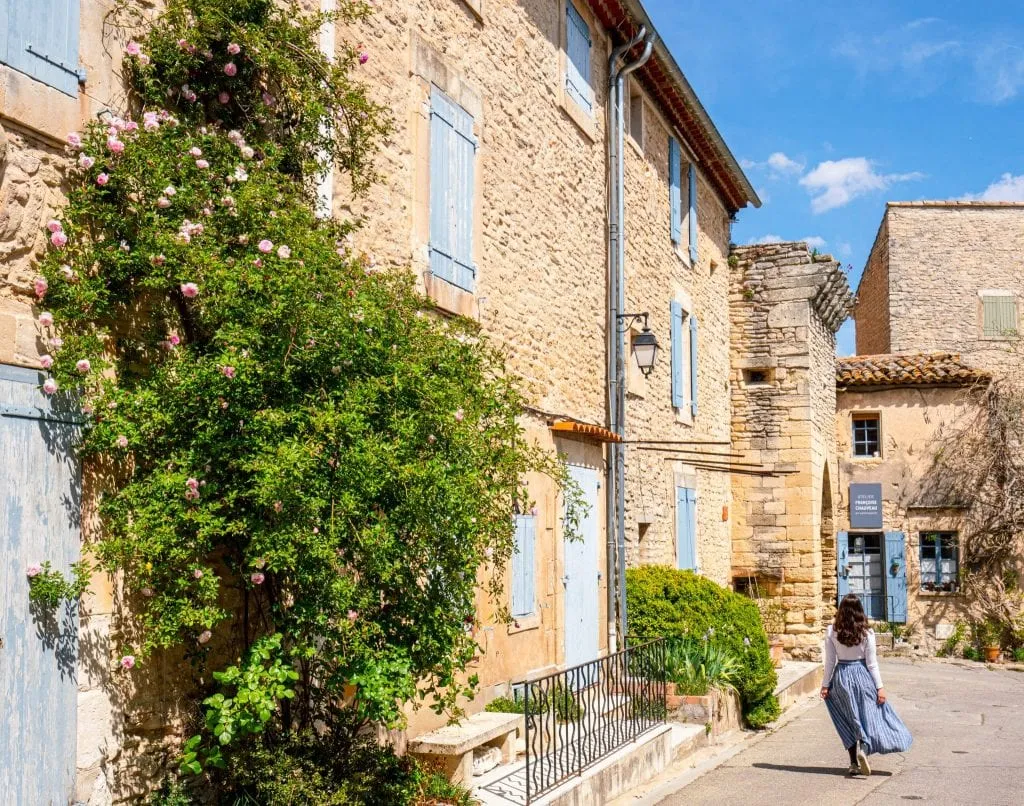
Saint-Rémy-de-Provence
If I were to move to a village in Provence tomorrow, it would be this one: incredibly beautiful, packed to the brim with tasty restaurants and interesting boutiques, and home to everything from fascinating art history (Van Gogh lived here during his days in a sanitarium) to a whimsical carousel, Saint-Rémy-de-Provence is enormously popular for good reason!
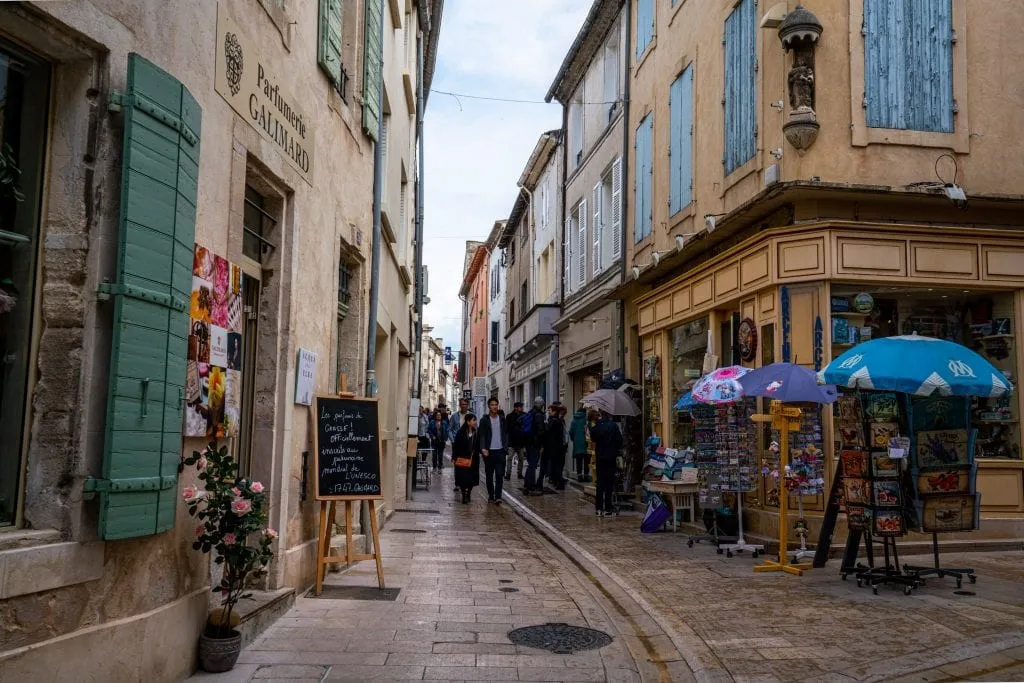
Calanques National Park
If you’re hoping to hike in France, look no further than Calanques National Park!
Located between Marseille, Cassis, and La Ciotat, the Calanques (or coves) that are the highlight of the park are full of sparkling Mediterranean waters and framed by bright, white cliffs–and the combination is absolutely stunning.
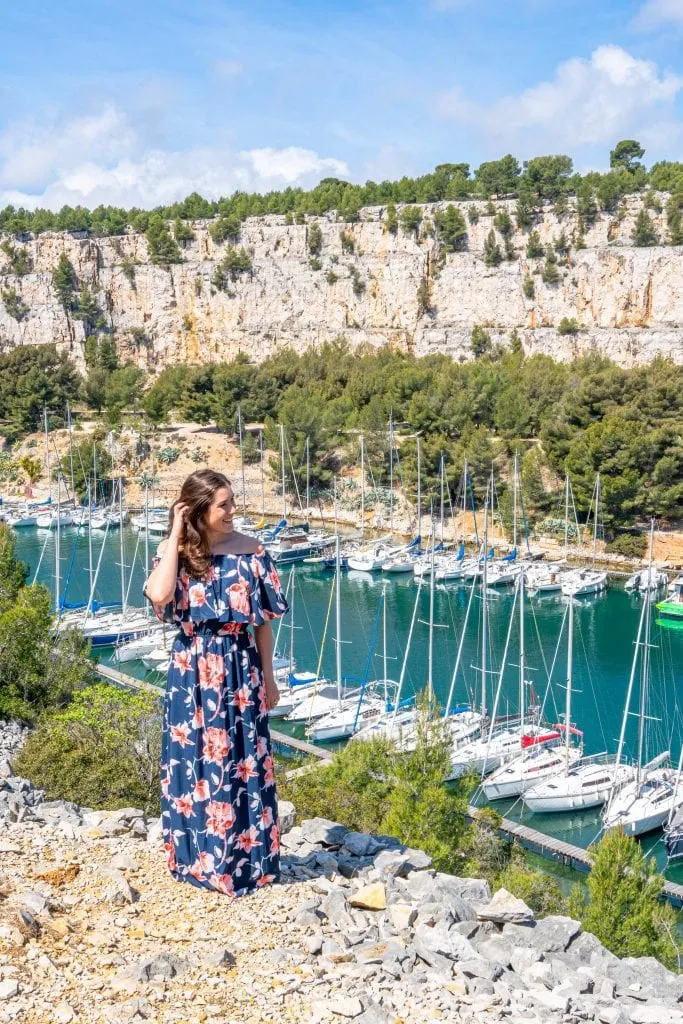
Verdon Gorge
A deep canyon framed by white cliffs with a turquoise river that rushes through it: the Verdon Gorge is so beautiful that it almost defies description.
Stop here in the summer to kayak, canoe, swim, or even go whitewater rafting–or simply to admire the views and take a lovely hike.
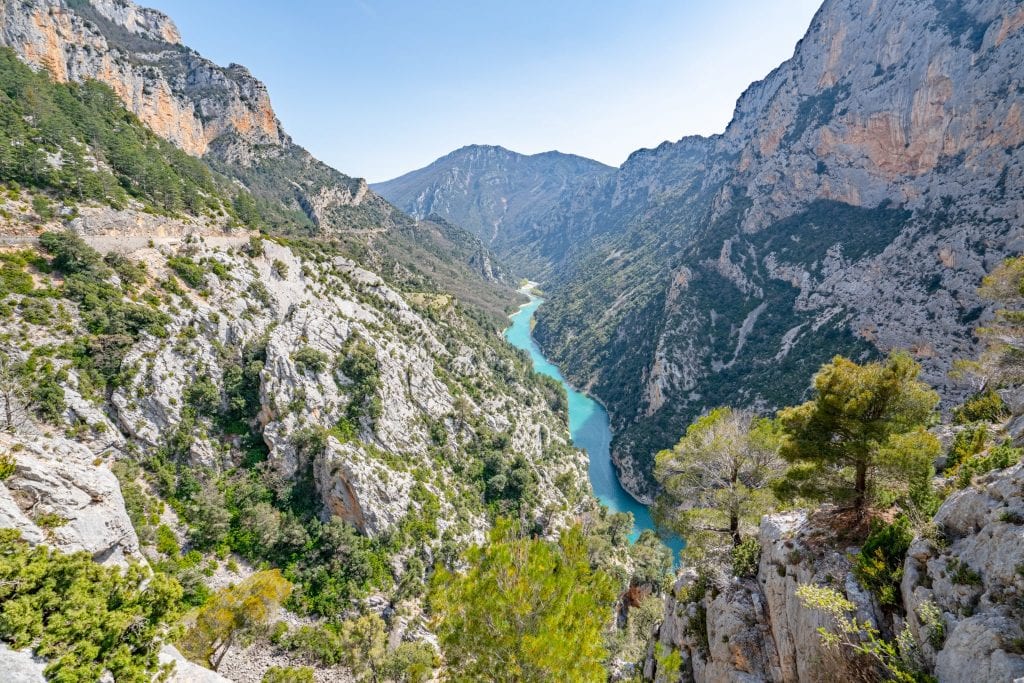
Sénanque Abbey
Located near the village of Gordes, the Sénanque Abbey is an unmissable place to visit in southern France for those exploring the Luberon Valley!
Though the abbey was founded in the 12th century and is still the home of monks today, these days it is best known for its gorgeous lavender fields.
Lake of Sainte-Croix
Though this brightly colored lake is man-made, it’s absolutely gorgeous, an excellent place for hiking or camping, and located right next to the Verdon Gorge, making it a fabulous addition to your list of places to visit in the south of France!
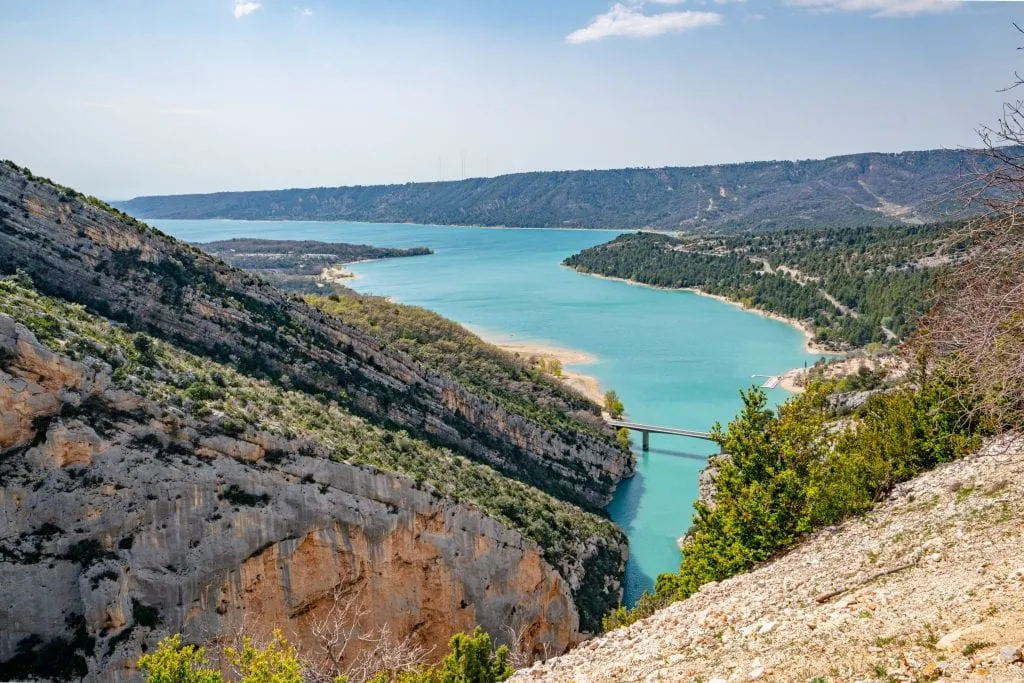
Valensole Plateau
The gigantic, far-as-the-eye-can-see, sprawling lavender fields of Provence may just be the most popular place to visit in the south of France… and the Valensole Plateau is where you can find the best of them–check out the first photo in this post for an example of what you can find!
If you’re coming to southern France to chase lavender, you should absolutely add the Valensole Plateau to your list of places to see in the south of France.
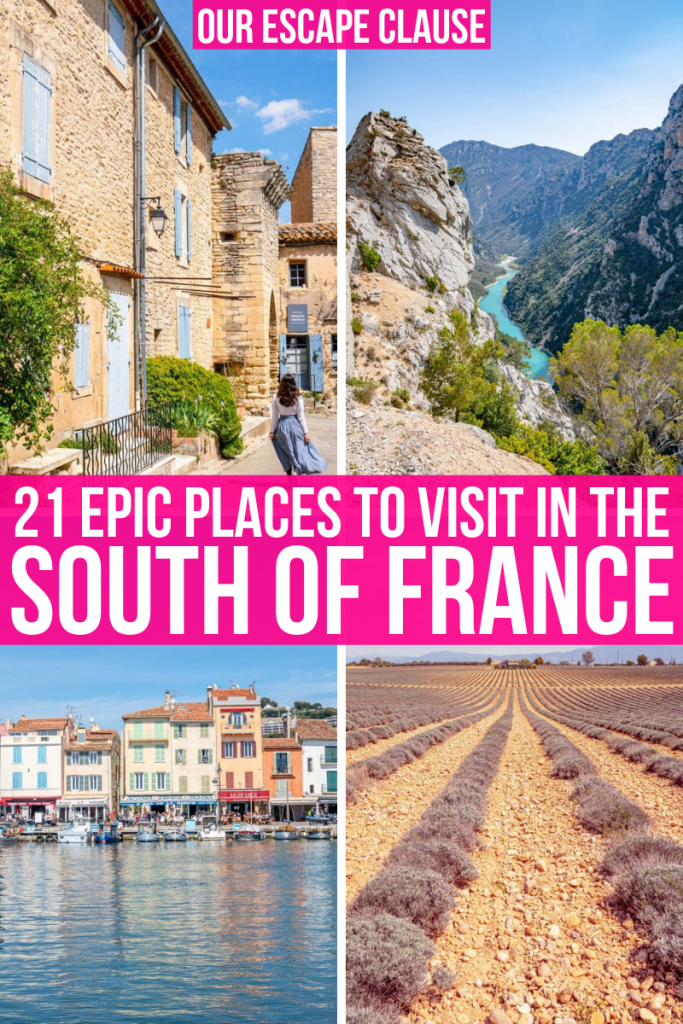

About Kate Storm

In May 2016, I left my suburban life in the USA and became a full-time traveler. Since then, I have visited 50+ countries on 5 continents and lived in Portugal, developing a special love of traveling in Europe (especially Italy) along the way. Today, along with my husband Jeremy and dog Ranger, I’m working toward my eventual goal of splitting my life between Europe and the USA.
Leave a Comment Cancel reply

30+ Beautiful Places to Visit in the South of France!
By: Author Sophie Nadeau
Posted on Last updated: 12th April 2024
Categories France
Last Updated on 12th April 2024 by Sophie Nadeau
The South of France is a wonderful area of Europe characterised by its sandy stretches, glittering Mediterranean coastline, and countless colourful villages. Inhabited since antiquity, you can’t go wrong by exploring at least several French destinations on any venture through the area. Here are 30+ sun-soaked places in the south of France you simply must visit…
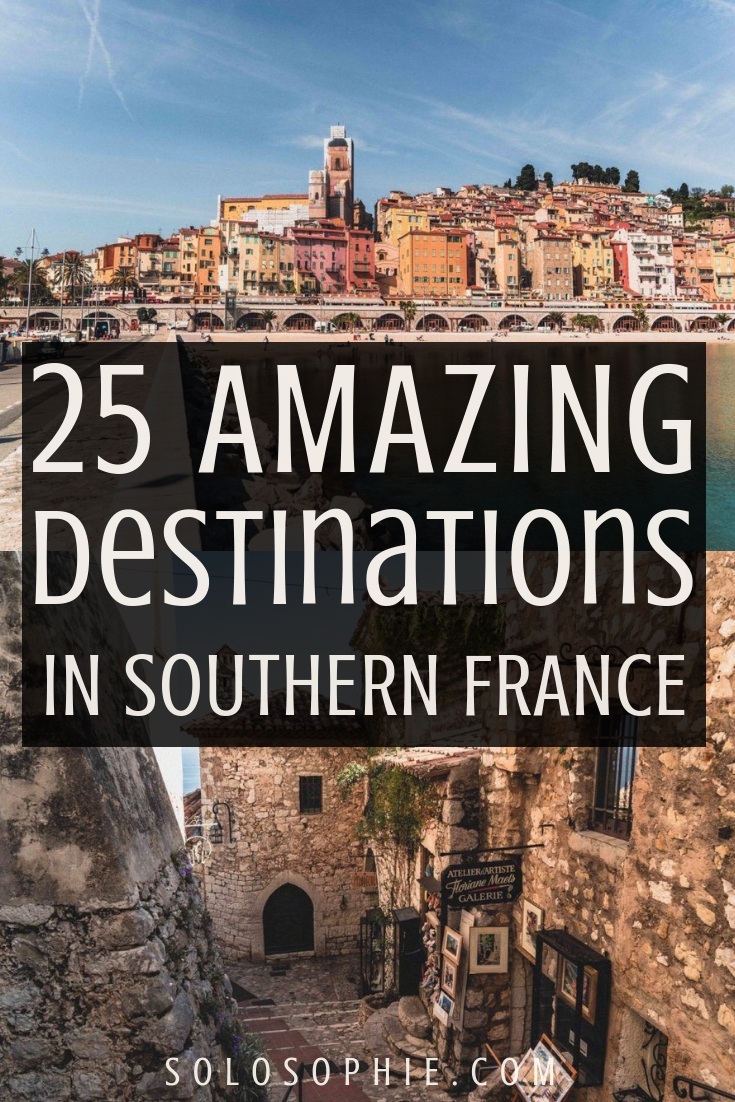
#1 Montpellier
#3 béziers, #5 narbonne, #6 biarritz, #7 marseille, #8 moustiers-sainte-marie, #12 nîmes, #13 carcassonne, #14 gorges du verdon, #15 aix-en-provence, #17 la ciotat, #18 antibes, #19 massif des calanques , #20 sète, #21 saint-paul-de-vence, #22 saint tropez, #24 saint-jean-pied-de-port, #25 èze, #26 lourmarin, #27 aigues-mortes, #28 martigues, #29 menton , #30 villeneuve-lès-avignon, #31 les baux de provence, #32 valensole lavender fields, #34 colorado provençal , enjoyed reading this post about the best places in the south of france pin it now, read it again later:, best places to visit in southern france.
Often referred to as the ‘Paris of the South,’ Montpellier is filled with Haussmannian architecture and plenty of historical museums and art exhibitions. As one of the largest cities in France, it’s also home to oodles of coffee shops, bars, and cafés.
Other highlights of the city include the impressive Gothic cathedral, Montpellier’s very own Arc de Triomphe in the form of Porte du Peyrou, and the breathtakingly beautiful Château de Flagergues in the outskirts of the city. For a greater look at this Southern French city, check out my free and self-guided Montpellier walking tour .
Montpellier travel tip: The best time to visit Montpellier is in the late spring or early autumn. This way, you get the best weather for exploring (not too hot and not too much rain) and the crowds will be significantly less than in the high season (i.e. during the summer). For more inspiration, check out our suggestions for spending one day in Montpellier .

The Roman ruins of Arles are often said to be some of the best archaeological sites in the South of France, if not all of the country. Complete with a two-tiered amphitheatre which was first founded in 90 AD, the city has inspired countless writers and painters over the years, including world-famous painter, Van Gogh.
Arles’ position alongside the River Rhone also means that it’s easy to access the Camargue from here, a region of France which is synonymous with grassy open plains, pink flamingoes, and wild horses. Other day trips from the Southern French city include St-Rémy, Pont-du-Gard, Uzès and Les Baux.
Arles travel tip: Be sure to truly check out all of the Roman history on offer, even if you’re not typically a traveller who enjoys historical sites. The size and preservation of the amphitheatre in particular is truly breathtaking and not to be missed.

Home to the UNESCO world heritage site of Les Ecluses de Fonserannes, a series of nine stepped locks which link the Canal du Midi to other French waterways, Beziers is one of the oldest cities in France. In fact, it’s only a couple of decades younger than the Provençal city of Marseille.
Today, highlights of Beziers include wandering around the city’s many cobbled lanes, seeing the city’s fortified old town, and exploring a side of France which many tourists never get to experience. Otherwise, be sure to make the journey to the nearby locks and search for the best view in Béziers.
Béziers travel tip: Don’t miss out on the locks of Béziers (known as Les 9 Écluses de Fonseranes) in French. They are of such engineering importance that they’re now listed as a UNESCO world heritage site and it’s truly impressive to follow a boat going down the series of locks and gates.

Birthplace of Henri Toulouse-Lautrec, Albi is the kind of city you see on a vintage postcard. And the kind of place that you might believe no longer exists. Yet Albi does exist, and it couldn’t be easier to visit, making it the perfect place for a weekend escape.
Located in Occitanie , this city was founded thousands of years ago and is now home to a population hovering around seventy thousand inhabitants. Highlights of Albi include the Gothic 13th-century Albi Cathedral and the formal French gardens of Musée de la Berbie.
Albi travel tip: The stunning city of Albi should definitely not be missed on any trip to Southern France and the one must-see attraction that should be visited above all others is Albi Cathedral. The ecclesiastical building is constructed from brick and is also fortified, making it a particularly interesting French cathedral.

Once a Roman port city, silt and sand have built up to such an extent over the years that the pretty town of Narbonne now lies some 15 kilometres or so from the sea. Today, instead of a sandy beach, you’ll find plenty of cobbled lanes, museums, and the birthplace of iconic French singer Charles Trenet (who is best-known for singing the hit song ‘la mer’) should you opt to visit this pretty southern French town.
Other reasons to visit Narbonne include the fantastic Roman ruins to be explored in the city, as well as Les Halles , which is easily one of the best covered markets in France. If you still want to experience some sea, sun, and sand, then simply take a day trip from Narbonne via bus to Narbonne-Sur-Plage.
Narbonne travel tip: The best way to explore this highly underrated destination in the South of West is on foot. Set aside at least a couple of hours during your stay in the city to simply stroll around and allow your feet to take you where they may…

For some sun-soaked sea adventures, then you simply must head to Biarritz , a seaside town on France’s Basque coastline. Located in the Pyrenées-Atlantiques, Biarritz is best-known for its historic lighthouse and great surf.
In fact, it’s often referred to as the ‘Capital of Surf’ for all of France. The town’s beaches are sandy and cloud coverage is minimal throughout the spring, summer, and autumn, making it an ideal destination for sun-seekers.
Biarritz travel tip: Though Biarritz town itself is fairly small and can easily be explored over the course of a few hours, you’ll want to dedicate at least a long weekend to exploring all that the surrounds of Biarritz has to offer.
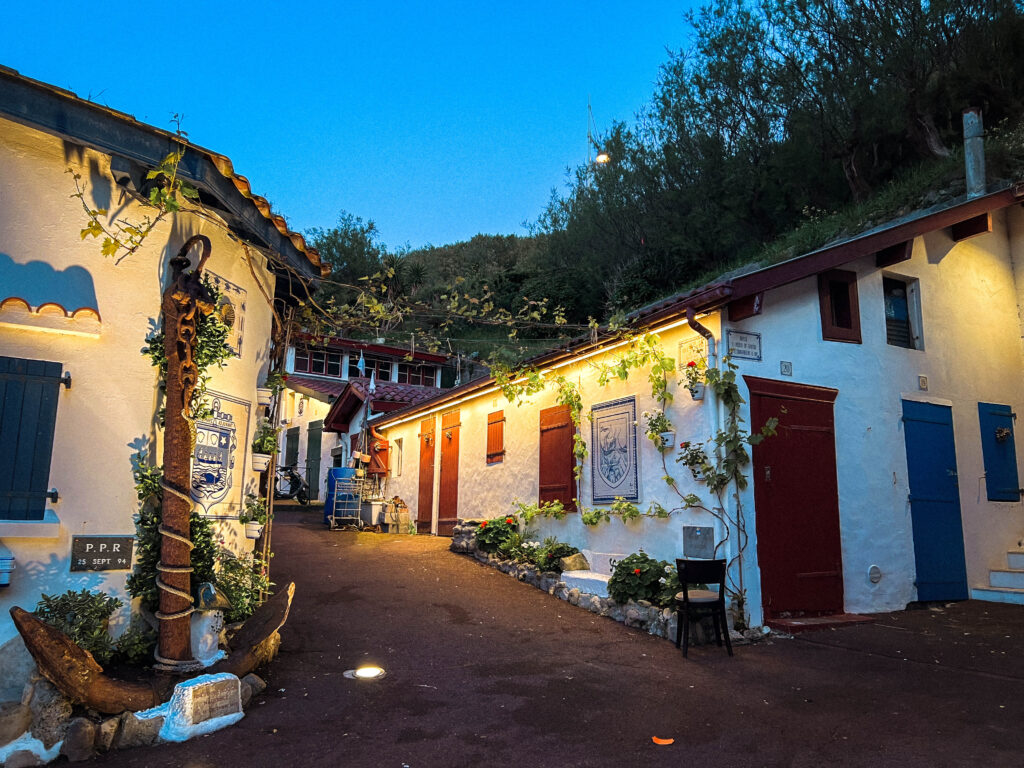
One of the oldest cities in France can be found in the form of Marseille, a city founded as early as 600 BC in antiquity. First known to the Ancient Greeks as Μασσαλία ( Massalía) , today Marseille is the second-largest city in France after Paris and is well-known for its seafood scene.
The historic fishing town still functions as a working port and highlights of the South of France destination include Notre Dame de la Garde basilica, as well as the city’s ultra-modern Museum of European and Mediterranean Civilisations. While in town, be sure to sample the Navette de Marseille , a local delicacy.
Marseille travel tip: Hands down, the most attractive district of Marseille is the Le Panier district. Characterised by its steep steps, pastel-hued homes, and family-run eateries, you could easily get lost for a good couple of hours discovering all that Le Panier has to offer. For even more inspiration, be sure to check out our guide to spending one day in Marseille .
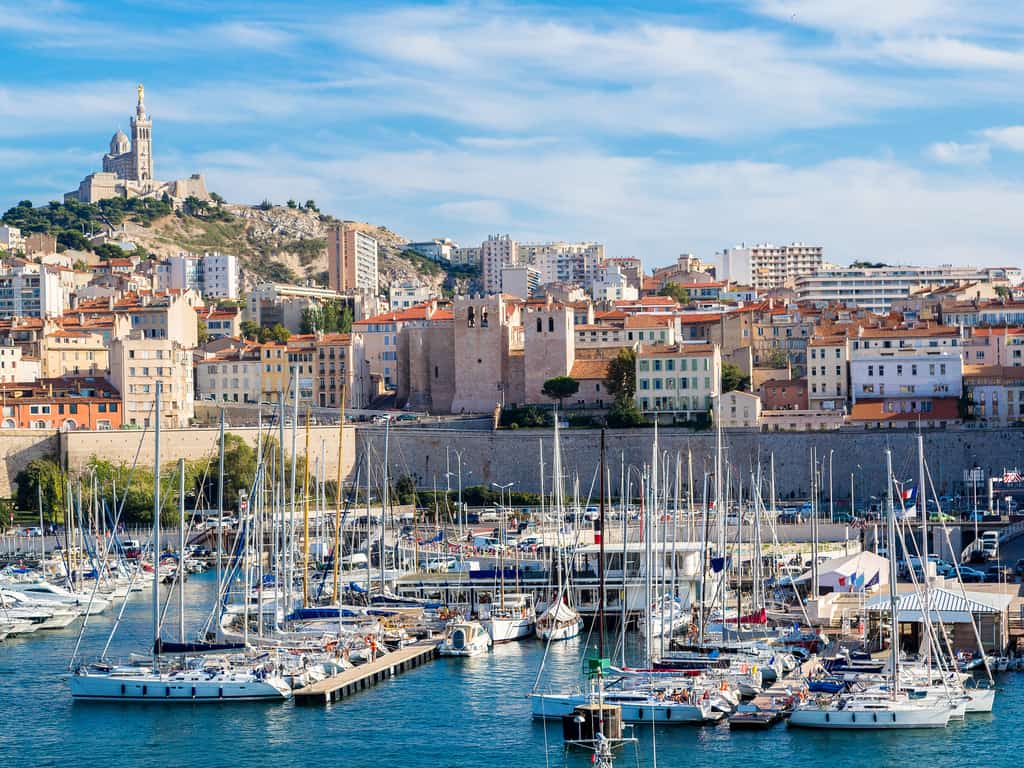
Located in the Alpes-de-Haute-Provence department and close to the Western entryway to the Gorges du Verdon , Moustiers-Sainte-Marie, which is often referred to as simply ‘Moustiers,’ is easily one of the most beautiful places to visit in the South of France.
Highlights of this vibrant town include the Romanesque and Gothic 12th-century Church of Notre-Dame de l’Assomption, as well as the tiny chapel of Chapel Notre-Dame-de-Beauvoir. It’s also worth noting that Moustiers is particularly famous for its glazed faïence pottery, which has been produced in the Provence settlement for centuries.
Moustiers-Sainte-Marie travel tip: If you’re looking for a particularly unique souvenir to purchase during your time in the South of France, then I highly recommend picking up a piece of two of the faïence pottery of Moustiers Sainte Marie . The beautiful ceramics also make for great present/ birthday gifts.

Made famous in the South of France by the children’s nursery rhyme ‘Sur le Pont d’Avignon’, this city in the South of France is characterised by its imposing Gothic ‘Palais des Papes,’ as well as the remains of the 12th-century bridge, Pont Saint-Benezet, which inspired the famous French nursery rhyme ‘Sur le Pont d’Avignon’. Avignon is also home to a surprising number of beautiful hidden gems.
The city’s iconic bridge is named for a 12-year-old shepherd boy who lived during the middle ages. One day, Benezet allegedly heard a divine voice instructing him to venture to Avignon so that he could build a bridge.
The story goes that this is exactly what he did and so (most of) the bridge still stands to this day! For more South of France inspiration, check out this guide on how to spend 5 perfect days in Provence.
Avignon travel tip: The name ‘ Avignon ‘ comes from the original Latin name of ‘Avenio’ which refers to the strong winds that the city experiences. This is even the case in the summer and so be sure to wrap up warm in plenty of layers when visiting this Southerly French city.
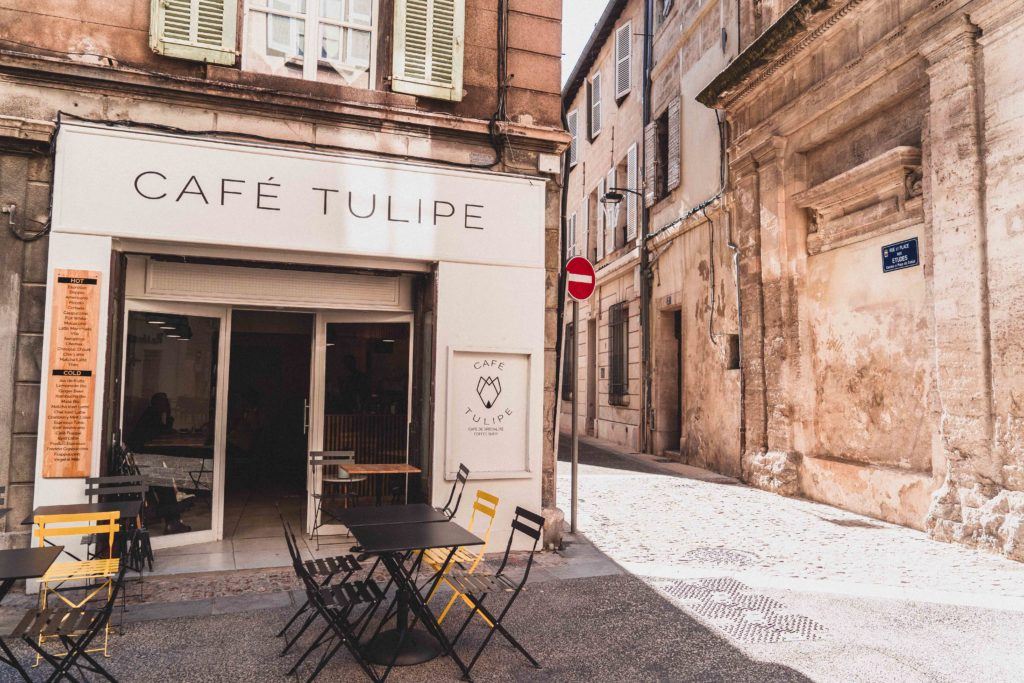
One of the most beautiful places to visit in Southern France is that of Toulon, which is to be found somewhere along the coastline between La Ciotat and Hyères and is home to a population of around 167,000 residents.
A vibrant city situated alongside the coast, some of the best things to do in Toulon include hiking up the nearby Mont Faron, relaxing on sandy beaches, and learning about maritime history in the grand Musée National de la Marine.
Toulon travel tip: Despite not being near the top of travellers lists when it comes to visiting the South of France, Toulon still merits a second look thanks to the fact that it boasts one of France’s most attractive harbours.
The word ‘cassis’ in French is not only the name for ‘blackcurrant’ in the language, but also the name for a pretty port town that lies right beside the seaside. A must-see on any trip to Provence, highlights of Cassis include candy-coloured houses, a Carolingian hotel , and easy access to the now designated heritage site, Calanques de Cassis.
If you want a taste of the ‘real’ France then simply pick up an ice cream in a local flavour (lavender is a must-try!) and wander around the town. Just don’t forget your camera, almost every corner is picture perfect! For more town highlights, here are the very best things to do in Cassis.
Cassis travel tip: Pack your hiking shoes/ boots if you’re headed to Cassis. The town lies on the fringes of the Calanques de Marseille, an incredible national park that is home to secret coves, hiking trails, and some of the most unique scenery in all of France.
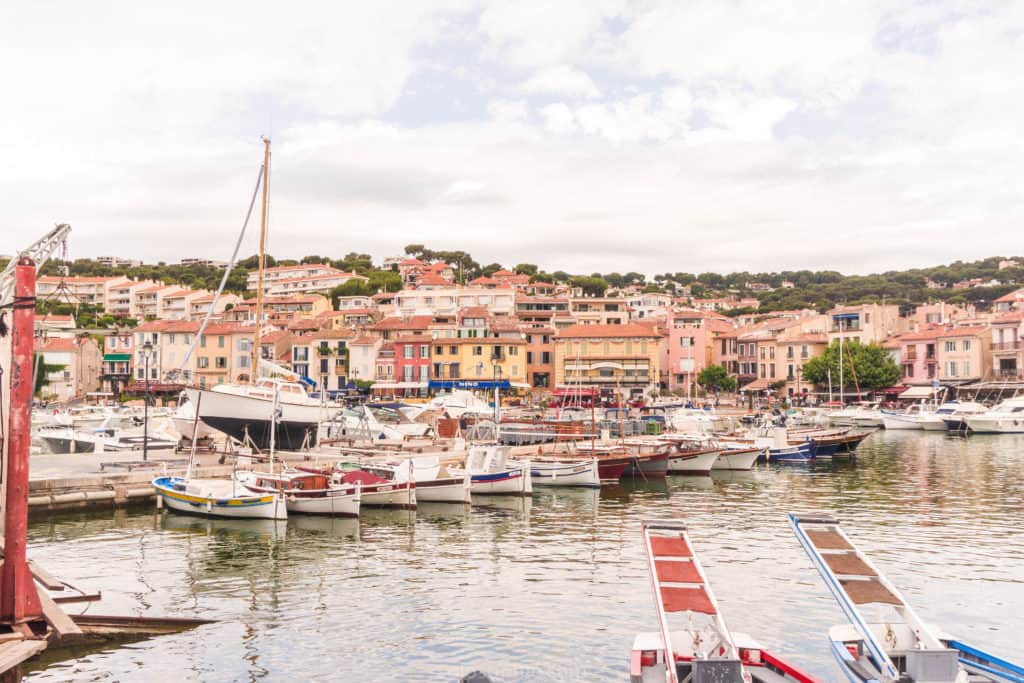
Yet another former Roman town which is a delightful visit in Southern France is that of Nîmes. Characterised by its sun-soaked façades and well-preserved Roman amphitheatre which is still in use to this day, you can’t go wrong by dedicating a long weekend to exploring the city.
Other highlights of Nimes include taking a day trip to the nearby Pont du Gard, an iconic Roman aqueduct that was constructed in the 1st century CE and is formed of three tiers, and seeing the Maison Carrée, a Roman temple in the heart of the city.
Nîmes top tip: Nîmes is so rich in history that it’s often nicknamed the ‘most Roman city outside Italy’. To discover more about the history of this ancient French settlement, be sure to book a guided walking tour like this one.

Fortified walls and a whole host of impressive structures come together to form a hilltop town that’s iconic the world over. Carcassonne was first founded as a fortified settlement in Gallo-Roman times and then further additions to the town’s defences were added during the Middle Ages.
Although the medieval fortress lay in pretty bad shape by the 19th-century (money constraints, the lack of a needy for defences etc. all contributed to the crumbling of the walls), the fortifications were heavily restored by architect Viollet-le-Duc (remember him from Mont Saint Michel? ) .
Today, Carcassonne is probably one of the most visited spots in the Occitanie region. Although there are certainly less touristic spots to visit when it comes to the South of France, Carcassonne remains worth a visit, if only to say you’ve visited this Southern French city!
Carcassonne top tip: If you want to walk along the historic Carcassonne ramparts, then the best time to visit is early in the day before the city gets pretty busy (this is one of the most popular places to visit in the south of France).

If you’re looking for a natural phenomenon to visit in the South of France region, then you should head to the Gorges du Verdon, which is a river canyon in Southeastern France. Home to cliffs and white river rapids, the area is popular among water sports enthusiasts, with many companies offer water-based activities in the area.
Gorges du Verdon top tip: If you want to experience going out on the water, then you can actually rent a boat (no boating licence required). We searched local rentals in the area and were able to rent one for half a day.

Warm stone, a hundred cobbled lanes, and plenty of fountains are the trademark of Aix-en-Provence, a fairly substantial city which lies to the base of Montagne Sainte Victoire. Once home to artist and impressionist Paul Cézanne, today you can follow in the footsteps of this famous Frenchman and even take your picture with a life-sized statue of Cezanne in front of the tourist office!
If you’re also looking for a little nightlife when it comes to your next destination, then I highly recommend considering Aix as it’s full of cafés, bars, bistros, and clubs thanks to its abundance of students!
What’s more is that Aix is home to plenty of secret spots . For a longer stint in Provence, Aix-en-Provence also makes a great base. After all, here are the 10 best day trips from Aix-en-Provence.

For a little glitz and glamour, you need to look no further than Cannes , a stunning resort town along the glittering French Riviera. Even if you’re ‘not really a beach person,’ then you may well have heard of this Southern French destination thanks to its annual film festival, ‘Festival de Cannes.’ And so, if you’re a movie buff, then you simply must head to this French destination!

Little and located by the sea, the charm of La Ciotat lies in its authentic French ambiance and well-preserved old town. Though there is little by way of attractions when it comes to this Provençal town (several seafood restaurants and a man-made beach), La Ciotat’s main claim to fame is that it is believed to be the birthplace of Petanque, a ball game similar to that of Boules.

Best seen just before or just after peak season so as to enjoy the city sans the crowds but with the best possible weather, Antibes is situated between the famous resort towns of Cannes and Nice. Home to a particularly impressive Museum dedicated to Picasso, 16th-century star-shaped fort, Fort Carré, is a must-see while in the city.

Stretching a 20 km length of coastline between Cassis and Marseille, the Massif des Calanques is a unique National Park in the world in that this terrain is formed of rugged limestone which has been worn away by the sea, time, and salty breeze.
Small inlets and impressively high peaks make this park a must-walk for lovers of hiking. Should you choose to plan a visit, make sure to avoid the summer months as the park is often closed due to the risk of a forest fire! Want to go and see the National Park for yourself? Here are tips for hiking the Calanques de Cassis.

A fishing city which still functions as a working port to this day, Sete is located between the historic cities of Beziers and Montpellier. Easy to visit as a day trip from Beziers, the area is well known for its sea-inspired dishes, notably ‘moules’ (mussels)!
Of all the beautiful towns and villages in the South of France, Saint-Paul-de-Vence is probably the most picturesque of them all. Characterised by its meandering walkways, floral displays, and cobbled lanes, wandering through this Southern French town feels akin to stepping back into a vintage postcard!
Other highlights of St Paul de Vence include the Fondation Maeght art museum and the breathtakingly beautiful 14th-century collegiate church. Easy to reach as a day trip from Nice , this quaint settlement is a must-see when in the Alpes-Maritimes area of France.

For a seaside resort with a luxurious feel and countless hours of sunlight throughout the year, you need to look no further than Saint Tropez.
Situated along the world-famous French Riviera, some of the best things to do in this South of France city include visiting the Citadel, sampling the local cuisine, and embarking on coastal walks to explore the local region.
Nice is nice, or so they say… Bad puns aside, Nice is a stunning city along the glittering French Riviera. Best-known for its long boulevard along the sea named ‘ Promenade des Anglais ‘, the city became a place for the rich and wealthy when celebrities started flocking to the beach resort town during the 19th-century.
Ever since that time, Nice has featured in countless paintings, movies, and is well worth a visit if you’re looking for a European getaway from it all. After all, look beyond must-sees like the old town and you’ll soon discover that Nice has plenty of hidden gems as well as an excellent foodie scene (be sure to try the best socca in Nice while in the Southern French city).

If you’ve ever thought about hiking the famous Camino de Santiago in Northern Spain , then you’ll know that the traditional starting point for the Spanish portion of the pilgrimage is actually Saint-Jean-Pied-de-Port in Southern France.
Incredibly busy and close to the border with Spain, the town is characterised by its pretty river vista views and many albergues, which host pilgrims throughout the year.
The hilltop medieval crown jewel of the French Riviera, the town of Èze dates back centuries and wandering around its cobbled lanes and stepped pedestrian streets truly feels akin to stepping back in time.
Similar in appearance to the nearby Saint-Paul-de-Vence, wander around Èze and you can expect to find a botanical garden, little hidden chapel, main parish church, and too many boutiques to count on two hands.

Time and time again, Lourmarin is listed as not only one of the best places to visit in the South of France, but also as one of the most beautiful villages in France. Situated East of Avignon and in the Luberon, the medieval village is picture perfectly stunning, and is surrounded by almond and olive trees!

With a red sea that gets its appearance from the region’s rich salt deposits, Aigues-Mortes was founded by Louis IX in the 13th-century for the purpose of expanding France’s trade routes. Today, the walled city is breathtaking to look at and is filled with tiny coffee houses, narrow cobbled streets (many of which are pedestrian-only) and lots of shopping opportunities.

Situated to the North West of Marseille, Martigues has a population of around 50,000 and was founded in the 13th-century by Ramon Berenguer IV, Count of Provence, on the site of what was once likely a Roman settlement. Today, visit the town and you can expect to find the ‘Provençal Venice’ on account of the town’s picturesque port and many winding canals.
The last major town before the Franco-Italian border along the French Riviera, Menton is a picture-perfect town that’s characterised by a glittering harbour and pastel-hued old town. This is the last large town before the border with Italy and each time a lemon festival is held in the town .
Highlights of the town include a centuries-old Cathedral, meandering pedestrian-only old town, and a cemetery that’s perched on the ruins of the old town castle, high above the Mediterranean sea below.

Just across the water from the world-famous Avignon and its semi-washed-away bridge, Villeneuve-lès-Avignon can even be spied from the Palais des Papes. Around a forty minute walk from Provence (and even less by bus or car) , highlights of this medieval town include a church with beautiful cloisters, and the 14th-century fortress, Fort Saint André.
Often alleged to be one of the most beautiful villages in France, Les Baux de Provence is a historic Southern settlement with just a couple of dozen residents in the historic old town.
Home to several churches (including an ecclesiastical building that’s quite literally been hewn out of the cliff face) , some of the more ‘hidden gems’ of this South of France village include a free-to-visit museum that’s dedicated to Nativity figures and an art museum that’s located in a former quarry.

Of all the beautiful places to visit in the South of France, the lavender fields are an absolute must, particularly those in Provence where swathes of purple stretch as far as the eye can see onto the horizon.
The Valensole lavender fields of Provence are widely regarded to be some of the prettiest lavender fields in France and are best seen between mid June and mid July, just before the harvest.

Grasse is a centuries old town along the azure blue French Riviera which is well worth a visit on any trip to France. Situated in the rolling hills to the North of Cannes, the picturesque town is famed for its perfume production.
Another major highlight of Grasse is its stunning cathedral, which even features some Rubens paintings. If you can’t make it all the way to Grasse to learn the secrets of fragrance making, then you might instead consider a perfume workshop in Paris.

One of the more unique places to see in the South of France Colorado Provençal . As its name would suggest, the Colorado Provençal resembles Colorado in the USA. Indeed, when I recently posted a photo of this magical French destination on social media, many people commented that it resembled the deserts of Colorado perfectly!
The Colorado Provençal is a former open-air ochre quarry close to the village of Rustrel in Provence. Since 1993, the site has been open to tourists and can only be seen on foot (no horses or bicycles are allowed within the quarry site). Today the geological site is a true marvel to see and is fun for all age groups to visit.

Sophie Nadeau loves dogs, books, travel, pizza, and history. A Francophile at heart, she runs solosophie.com when she’s not chasing after the next sunset shot or consuming something sweet. She splits her time between Paris and London and travels as much as she can! Subscribe to Sophie’s YouTube Channel.
This site uses Akismet to reduce spam. Learn how your comment data is processed .
susan kabuku
Tuesday 3rd of September 2019
such a beautiful read. im planning to visit France in the near future, this article is very informative. Thank you
francetaste
Monday 16th of July 2018
I live near Carcassonne, and while the fortified city is filled with visitors in summer, it's lower-key the rest of the year, and the rest of the city doesn't feel very touristy at all. It's an excellent base for visiting other sights, from vineyards and quaint villages to Mediterranean beaches. The summer crowds are worth bearing, though, because in July there's a huge music/theater/dance festival, and in August there are great medieval jousting shows--like rodeos but with the riders in chain mail.
Top 25 Places to Visit in the South of France
The South of France is a hidden gem and has a charm of its own that will leave you wanting more. There is so much to see and do which is why I’ve put together a guide on the top 25 places to visit in the South of France. It covers everything from star-studded streets in Cannes, beautiful picturesque villages, and towns in Provence to the wine capital, Bordeaux.
When we decided to embark on our sabbatical to Europe, my husband convinced me to add the South of France to our itinerary. I was hesitant at first because I didn’t know what to expect. I had countries like Italy, Greece, and Croatia in mind instead. But I’m so glad we decided to go to the South of France. It has its own Riviera with turquoise waters, picturesque hills, and medieval villages. This was the perfect opportunity for me to unravel all the hidden treasures in the area. And if you are a foodie like me, you’ll understand just why you need to visit this region! From rich stews to sweet delights, the food is bursting with flavor.
The beautiful beaches, amazing food, and cute little French villages add more to the appeal of this sunny part of France. It doesn’t matter if you have been here before, or if this is your first visit, a South of France road trip is the perfect French holiday.
When planning a trip to the South of France, you’ll realize very quickly there are endless places to visit. From the sparkling sea of the Cote d’Azur to the lavender fields in Provence, castles to medieval cities, this guide will assist in planning your South of France itinerary and will ensure you include the top places to visit in the South of France.
South of France Travel Guide
Best time to visit the south of france.
There is no bad time to visit the South of France as it has something unique to offer any time of the year. But it’s best to plan ahead so you can make the most of your time while visiting.
The summer months between June and August are peak seasons which means higher prices and larger crowds all around. The locals also tend to take this time off and holiday in the region, making beaches and other tourist spots incredibly crowded.
September sees the end of peak season and tourism starts to quieten down. It’s generally a good time to visit southern France. The region isn’t as crowded and the temperatures are still warm during the day. If you do plan to visit the lavender fields, which is one of the highlights in Provence, you’ll need to plan your trip between June and the end of July. This is when the lavender fields are fully in bloom. By August, you’ll miss the lavenders in bloom.
How long do you need in the South of France?
In a perfect world, you could spend weeks or even months exploring all the hidden treasures in the South of France. But if you have 10 days to two weeks in the South of France, you’ll be able to cover a reasonable amount. I’d say allow a minimum of two weeks to make it a worthwhile trip. Anything less will seem like a rush.
Disclaimer: Please note some of the links in this post are affiliate links. Purchasing through these links earns us a small commission at no extra charge to you.
From glitz and glamour, warm sunny beaches to mouth-watering cuisine, the South of France makes for the perfect holiday destination. To help you plan your perfect trip to southern France, refer to this guide which includes the top places to visit in the South of France. This list of places covers everything from cities that are famous to cute little French towns that will charm you off your feet. Whether you are looking for culture, delicious food, warm beaches, or a bit of history, this guide has some of the best things to do in the South of France and covers all the region has to offer.
This part of the French Riviera offers everything travelers want from a holiday. With world-class art, stunning beaches, balmy weather and delicious food, the capital of the French Riviera is the place most people think of when visiting the south of France.
Explore Old Town where you’ll come across grand plazas and open-air markets. There’s always something going on in the evenings so take a stroll down the Promenade des Anglais to catch a glimpse of the action.
Nice has some of the best beaches on the French Riviera. So, if you don’t mind pebbles, you can head down to the beach and sunbathe or simply enjoy a dip in the turquoise waters.
Nice also makes the perfect base for many day trips to neighboring towns such as Villefranche-sur-Mer, Èze, Monaco, and Cannes. Plenty of trips to the French Riviera and south of France start in Nice as it has a large airport. So something to consider when you plan your south of France trip.
With its deep blue sea and palm trees that line the streets, Monaco is filled with tropical vibes, has lush vegetation, and provides perfectly warm weather of the Côte d’Azur. Monaco exudes luxury no matter where you look and has become the perfect holiday destination for the rich and famous.
Just a 30-minute train ride from Nice, Monaco attracts crowds to its high-profile yacht shows, the annual Formula One Monaco Grand Prix car race, and the famous Monte Carlo Casino.
Stroll through the narrow streets of the old town where you’ll find small boutiques and souvenir shops. At the heart of the city stands the Prince’s Palace which is the current residence of the Prince of Monaco. You can catch the changing of the guard ceremony at 11.55 each day.
And of course, you can visit Monaco without visiting the famous Monte Carlo casino. Even if gambling is not your thing, you can take a walk through the main casino area to see the grandeur of the place. Monaco also has lush vegetation which results in there being some beautiful gardens around the place. If you have time on your hands, be sure to visit the Japanese Garden or Jardin Exotique.
With its long stretches of sandy beach and 300 days of sunshine, Cannes attracts visitors from all over. Take a walk along the Boulevard de la Croisette. The promenade offers views of the sea and sand on one side and upscale hotels and boutiques on the other. Cannes is well known for its annual film festival which attracts celebrities from all over the world.
Cannes is a short car ride from Nice so be sure to add it to your list as it’s easy enough to get to.
4. St. Tropez
Once a humble fishing village, today Saint-Tropez is a playground for the rich and famous. With its picturesque port and quaint historic town, beautiful Mediterranean scenery, and fine sandy beaches, it’s not hard to see why Saint Tropez attracts visitors from all walks of life.
Find a café in Place des Lices and soak in the ambiance of Saint Tropez or simply sunbathe at one of its finest beaches.
5. Saint-Paul-de-Vence
Somewhere between Nice and Vence is the beautiful village of Saint-Paul-de-Vence perched high on a hilltop. The scenic beauty of this place makes it one of the most beautiful villages in France. If you are looking to lose yourself among cobblestone streets and want to soak up history, then you should visit Saint-Paul-de-Vence.
Though a short distance from Nice and Cannes, it’s quite different from the bustling city of Nice, or the star-studded streets of Cannes. If you stand on the medieval walls that surround the town, you can see all the way out to the Mediterranean Sea.
6. Marseille
Marseille is France’s oldest and second-largest city, so as you’d expect it doesn’t quite have the calmness of the smaller towns and villages in the South of France. It’s a bit more chaotic and edgy and is a real working city with a cosmopolitan vibe.
There are many things to do in Marseille. If you only have a short amount of time Explore the charming Vieux Port, marvel at the Notre Dame de la Garde or jet off on a boat towards the Parc National des Calanques.
Cassis is a charming fishing village located just 30 minutes from Marseille. It is known for its incredible beaches and local markets. Lined with pastel-colored houses and delicious restaurants, Cassis is a pleasant surprise for those who visit for the first time.
It’s probably one of the best coastal towns in the South of France. You can stroll through the old town, browse the boutiques, take in the historic sites, and walk the pier.
8. Aix–en–Provence
Once the capital of Provence, Aix-en-Provence is a typical Provencal city. With its open-air markets, fountains that adorn squares, and outdoor cafes, Aix-en-Provence provides visitors with a typical insight into the southern France lifestyle. Aix’s historical center has gorgeous architecture. It is a great location as a base to visit other places in Provence.
9. Roussilon
With its warm-toned color scheme and advantageous views overlooking the Provençal countryside, Roussillon is one of France’s most beautiful villages. It’s not hard to see why, Roussillon has many beautiful houses and every street provides a great photo opportunity.
Roussillon is a charming village with shady squares, fascinating architectural details, and natural attractions. There are plenty of cafés and restaurants so you can while away a few hours in this beautiful town.
There are some cute souvenir shops, gorgeous little boulangeries, and wine shops that you can check out. If you are driving through the South of France, Roussillon is a great place to stop by for a few hours, explore the narrow streets of the village, grab a bite and be on your way. There is a car park at the top of the hill.
10. Lourmarin
This small village in the South of France is surrounded by olive groves and vineyards. Not as overrun with tourists as other towns in the region, Lourmarin offers an authentic Provençal experience. It has one of the best markets in the area, several chic boutiques, and a castle with delicious wine. You’ll also come across some pretty squares with old fountains.
Lourmarin is charming and captivating and I’d highly recommend you stop by this cute little village. This charming village makes an excellent day trip or even a pit stop on your way to your main destination.
11. Gordes
The small medieval town, of Gordes is built directly into the hilltop it rests on. Takes the concept of a hilltop village to a whole new level! In my opinion, Gordes is one of the most beautiful villages and one of the best towns in the south of France. You have to see it to believe it.
The town’s cobblestone streets wind around the hill and at the top, you’ll find a castle containing the town hall and a small art museum. Take a walk through the town, grab a seat at one of the small cafes or restaurants, and indulge in a meal as you take in the views.
To keep up with the architecture and styling, any new buildings in Gordes must be built with limestone and capped with terracotta tiles. The view from a bit farther away tends to be the ideal way to experience Gordes.
12. Sénanque Abbey
Located near the village of Gordes, the Sénanque Abbey is an unmissable place to visit in the South of France!
The abbey was founded in the 12th century and is still the home of monks today. These days the Abbey is best known for its gorgeous lavender fields. The best time to see them bloom is from the last week of June to the beginning of August.
13. Avignon
Avignon is a beautiful city known for the Palais des Papes, the largest Gothic palace in Europe. Built in the 14th century, the fortified structure covers the top of a hill overlooking the Rhône River.
Avignon is a city rich in religious history and stunning architecture. There was a time in the Middle Ages when this charming city was the center of western Christendom. Six papal conclaves were held in the breathtaking Palace of the Popes.
If you’ve seen a photo of Avignon, you’ve most likely seen a picture of its most famous bridge. Nowadays only 4 of its original 22 stone arches remain. Take a stroll to the end and then make your way through the arty-walled town or take a cruise down the Rhône River. On this 2-hour private walking tour , you’ll explore the history, and culture of Avignon and see the awe-inspiring Palace of the Popes.
14. Pont du Guard
A masterpiece of engineering and a thing of great beauty, Pont du Guard is a Roman aqueduct that was originally built to bring fresh water from Uzès to Nîmes. Over the centuries, once it couldn’t be used as an aqueduct anymore, it became a bridge to cross the Gardon river. It’s the highest Roman bridge in the world measuring 48m by 275m.
Apart from taking in the views, you can walk across the bridge or even swim in the Gardon River. There is an onsite tour you can take that even takes you inside the aqueduct.
It’s not something you see every day so I’d highly recommend putting aside a morning to come to view the aqueduct. The Pont du Gard is in the South of France in the Occitanie region. The closest city is Uzès – about a 10-minute drive away. It’s easy enough to get to Pont du Guard from Avignon too, about 30 minutes. A trip to the South of France wouldn’t be complete without seeing the ancient Roman ruins of the Pont du Gard aqueduct and bridge. It was one of my top places to visit in the South of France.
15. Nimes
Nîmes has a historic center with many tree-lined streets and fountains that adorn public squares. There are several Roman monuments scattered throughout the city. The Arènes de Nîmes is one of them and is a perfectly designed Roman amphitheater. Many of these monuments are among the most well-preserved in the world.
The town is largely walkable, has a lively ambiance, and is known for its festivals.
16. Uzès
Tucked away in the hills in the South of France is a small little town called Uzès. While Uzès may not be as popular as some of the other destinations in France, it’s a charming town that is slowly starting to attract more tourists. In my opinion, it certainly was one of the best towns in the South of France.
The square is the best place to begin a walking tour of this town. The medieval center is a joy to explore on foot. Stroll through the cobblestone streets that will lead you to beautiful squares. Or simply find a café and grab yourself a coffee and pastry as you watch people walk by.
If you are lucky enough to catch one of the markets, be sure to purchase some local produce.
17. Montpellier
Holding its place as the seventh-largest city in France, Montpellier is located in the Occitanie region. Being home to one of the oldest universities in the world, students make up a decent size of the city’s population. Despite being a modern city, Montpellier has retained its historic charm in the Old Town known as L’Écusson. Tourists can walk through the winding pedestrian streets, explore art galleries, visit churches, shop at boutique stores, and dine at traditional restaurants. I’d highly recommend you stroll through the cobblestone streets at your pace while taking in the atmosphere around you.
Its wide tree-lined boulevards, elegant mansions, public squares, and gardens provide a certain flair to every visitor who passes through the city. If you are traveling with kids there’s a zoo and aquarium, and perfect sandy beaches on the coast just 15 kilometers away. Montpellier has a diversity of attractions and shouldn’t be missed when you are traveling through the South of France.
If you base yourself in Montpellier, make a day trip to the port city of Sète. It’s a real hidden gem in the south of France.
Note: If you are looking to purchase good wine, make your way to a place called Frontignan.
18. Sète
The Mediterranean port city of Sète is a real hidden gem in the South of France. You won’t often hear of this place as it can often be overshadowed by the coastal towns on the French Riviera.
This charming city is filled with fun things to do. You can explore the sights of Sète with a tour or simply walk around the town and visit some of its popular attractions.
19. Carcassone
The Cité de Carcassonne is a sight that will amaze you forever. It’s one of France’s oldest fortified cities. Walls have encircled the city since the 4th century but were modified in the 13th century to stand as a barrier against the Crown of Aragon to the south.
The stained-glass windows in the Basilica of Saints Nazarius and Celsus are some of the most beautiful you will see. Wander through the cobblestone streets, pop into souvenir shops, or simply sit down and take in the atmosphere of this walled city.
20. Toulouse
Toulouse has been given the nickname, “La Ville Rose”, meaning pick city. It’s because so many of the city’s buildings are pink in color, giving the cityscape a look like no other.
Toulouse provides a great mix of old and new with its historic center filled with spectacular architecture dating back centuries, while also being the headquarters for Europe’s largest Space Center and the multinational aerospace corporation Airbus.
Toulouse is quite laid back and the city center is easily walkable. You can do almost everything on foot. Be sure to visit the UNESCO-listed Basilique Saint-Sernin which takes you on a journey back in time to the era of medieval pilgrimages.
With countless churches, museums, gardens, and delectable cuisine, Toulouse has so much to offer. If you love exploring food as much as I do, be sure to try the hearty specialties, like cassoulet (meat and bean stew) and duck pâté. Toulouse is also famous for its Gâteau du Fénétra, a tart made with apricots, candied lemons, and almond meringue.
21. Lourdes
When I was three years old my parents took me to Lourdes. I don’t have any memory of the visit, except the photos to remind me that I had once been there. So, it has always been my goal to go back and visit one day. This time I went with my husband and my three-year-old son. It was a lovely experience and I feel so grateful that I was able to share this with my son.
It is said in the year 1858, the Blessed Virgin Mary appeared in front of a 14–year–old peasant girl called Bernadette Soubirous. The town of Lourdes has since become a very significant site of pilgrimage and attracts millions of tourists every year. Pilgrims visit the Grotto, worship at the Basilique Notre-Dame du Rosaire (Cathedral of Our Lady of Lourdes), and participate in candlelit processions. Lourdes draws many pilgrims who hope for cures to an illness by bathing in the sacred waters. So far, the Catholic church has validated just over 60 official miracles.
The Lourdes Cathedral stands beside the River Ousse with the Pyrenees Mountains in the background. Pure spring waters flow into a Grotto where Saint Bernadette received visions of the Virgin Mary. Water from this source is believed to have healing properties. (You can purchase empty bottles at the souvenir shops before you enter the compound and fill them up with Holy Water before you leave)
If you are looking to visit the Pyrenees Mountains, Lourdes is a great starting point. Once you get to Lourdes, you can book a walking tour which takes you around the sanctuary.
22. Biarritz
A beautiful resort town in the South of France that offers something for just about everyone to enjoy. Whether you want to lay back and relax on the beach, admire the lighthouse or sip on Aperol, Biarritz is a coastal paradise that gives you an insight into Basque culture.
Biarritz has one of the hippest food scenes, many chic boutiques, a long promenade for beautiful strolls, and proximity to many other great destinations in the Basque region in the South of France. Don’t forget to walk past Hôtel du Palais, the town’s most famous landmark.
23. Espellete
If I had to choose one village in Basque country it would be Espellete. Espellete is a small village located about 20 km from the famous resort town of Biarritz. The houses here are covered with red peppers is what makes this place so unique and distinguishes it from other traditional Basque villages.
Starting late summer, thousands of peppers are hung to dry under the red shutters of traditional Basque houses. Most of the shops in the city sell red peppers or products that contain it in some way or another. At the end of October, the village celebrates La Fête Du Piment (the pepper festival), with concerts, a big market, and a parade to celebrate the end of the drying season.
The unique village is extremely popular and can get quite crowded in the summer. Try and visit earlier in the morning to avoid large crowds. You only need a couple of hours to walk through this village. I would highly recommend having lunch at one of the many established restaurants here that will give you a taste of authentic Basque food. Visiting Espelette is certainly a culinary journey into the Basque country.
24. Arcachon
Arcachon is a coastal town on the Bassin d’Arcachon just an hour away from Bordeaux. It is known for its turquoise beaches, delicious seafood, and Dune du Plait.
Quite honestly, I had never even heard of Arcachon prior to my visit there. Our friend Pierre, who lives in the Basque country, suggested we make a day trip to this area to spend some time at its beautiful beaches and of course the famous Dune du Pilat (the tallest sand dune in Europe).
If you plan to spend a day in Arcachon, visit one of the beaches (Le Petit Nice, Plage de la Corniche, and La Salie) and be sure to make your way to Dune du Pilat. At over 100m high and 3 km long, it is quite a strenuous climb to the top (there are hard steps built-in to assist with the climb). You’ll be rewarded with incredible views of the Atlantic Ocean once you get to the top. Several excursions take you to Arcachon and include oyster tasting.
Arcachon is also one of the main osticulture (oyster farming) centers of France so eating oysters is a “must” when coming to the area. There are plenty of restaurants that offer oysters and other delicious seafood. The fresh breeze, perfect weather, and tranquil environment make Arcachon the perfect getaway for locals and tourists who come from afar. And if you are traveling with kids, this is one of the best places to visit in the South of France. Arcachon was a pleasant surprise and should be added to your south of France holidays list.
25. Bordeaux
And last but not least is the city of Bordeaux that’s Located on the banks of the Garonne River. A trip to the South of France wouldn’t be complete without a visit to the world capital of wine. UNESCO has designated the entire city of Bordeaux as a World Heritage Site because of its architectural treasures. The city boasts over 350 buildings that are listed as historic monuments.
Bordeaux is a vibrant working city with a plethora of cafes and restaurants, open-air markets, and of course a multitude of outstanding wineries. Stroll through the historic center and marvel at the spectacular architecture. Visit Bordeaux Cathedral, Place de la Bourse, Place des Quinconces and Place de la Comédie. Allow at least three days to visit Bordeaux, two to tour the city, and one day to explore some vineyards.
Note: There are plenty of wineries in Bordeaux and it can sometimes be overwhelming trying to find the right ones to visit. While you can visit them yourself, you can also consider a wine tasting tour which will organize everything for you. Some great wineries to visit are Chateaux Saint-Émilion, Chateaux Médoc, and Chateaux Graves.
Final Thoughts
So there you have it, a guide to the top places to visit in the South of France. What I love about this region is the variety it provides. From glitz and glamour, seaside resorts and towns, picturesque hilltop villages, and historical monuments dating back to Roman times, the South of France is a great place to visit. This detailed list gives you an insight into some of the best places to visit in the South of France. If you end up visiting any of these places, be sure to send me a message or tag me @travelandtastewithtracy
Happy Travels!
- Saint-Paul-de-Vence
- Aix–en–Provence
- Sénanque Abbey
- Pont du Guard
- Montpellier
Note: The information here is updated the best we can at the time of writing this article. Please check attractions, activities, and transport before you can as things tend to change from time to time.
Other guides that may interest you
- 21 Best Things to See and Do in Budapest
- 15 Best Things to do in Vienna
- 26 Top Tourist Attractions in Spain
- Best Things to do in Prague
Related Posts
3 days in barcelona: the ultimate itinerary, a day trip from barcelona to montserrat.

25+ Must Visit Landmarks and Monuments In Southern France
Planning a trip to southern France and wondering what to see and do?
Here’s my guide to must visit landmarks and monuments in Southern France. This guide will particularly appeal to culture vultures and history buffs.
Southern France is a living history book. It’s sheer perfection and just packed with some of Europe’s best cultural attractions. You’ll be in seventh heaven. I promise.
These must see landmarks are in the Provence and Occitanie regions of Southern France. They’re naturally beautiful regions where the ever-present sunshine casts a luminescent glow on the historic goodies and crooked olive groves.
Two thousand years ago, southern France was part of Roman Gaul, so you’ll get a heady sampling of ancient Roman ruins.
The region is also littered with UNESCO sites, doughty medieval fortresses, and towering cathedrals.
Ahhhhh! Je l’adore.
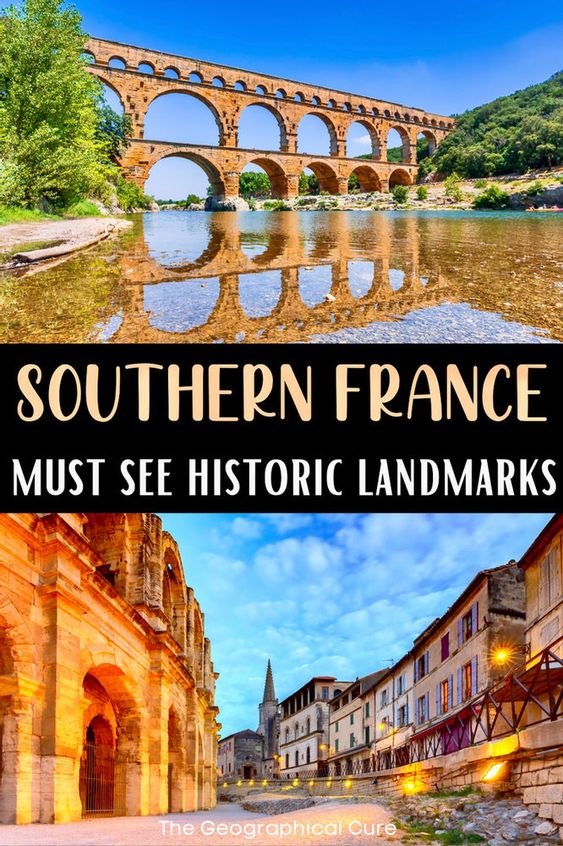
Southern France is so mesmerizing I can’t wait to go back for another geographical cure.
In the meantime, I’m giving you the full scoop on all the best landmarks and places to go in southern France for history lovers.
From Toulouse to Avignon, it could take days or week to discover southern France. Hopefully, you’ve got a good chunk of time to soak in the sumptuous landmarks on offer in southern France.
Historic Landmarks And Monuments In Southern France
Here are my pick for 25+ must visit landmarks and attractions in the south of France. If you’re wondering what to see in southern France, put some of these monuments on your bucket list.
1. Albi Cathedral, Albi
The historic town of Albi made the UNESCO list in 2010. It’s crowning glory is Albi Cathedral, a must visit landmark in southern France.
The mighty Saint Cecilia Cathedral is a 13th century masterpiece of southern Gothic style. Built by the Bishop of Albi, it’s a place of superlatives both inside and out.
It’s knicknamed the “crucible of faith. It’s one of the largest brick structures in the world. The fearsome exterior gives no hint of the extravagant art and craftsmanship inside the blue hued interior.
Like Albi Cathedral, the 800 year old Berbie Palace is an all brick affair with stout walls of extraordinary height and thickness.
Aside from the Pope’s Palace in Avignon, it’s one of the best preserved castles in France. The palace was formerly the residence of the Albi’s archbishops.
You can visit Albi on a guided day trip tour from Toulouse.
2. Berbie Palace, Albi
The Berbie Palace is another imposing forties-like building in Albi. Built between 1277 and 1308, it was the home for Albi’s bishops in the middle ages.
The structure has an imposing brick keep flanked by four towers. A second keep was added to house the Chapel offer Lady.
The palace also houses a museum dedicated to an artist you’ve likely heard of — Henri Toulouse-Lautrec.
The post-Impressionist artist was born and lived in Albi before he decamped to Montmartre in Paris to paint dancers at the Moulin Rouge and create his iconic art nouveau posters.
READ : Guide To Paris’ Montmartre Neighborhood
But Toulouse-Lautrec didn’t completely leave Albi. Some of his most seminal works are there, in one of the best single artist museums in Europe. At the museum, you get a comprehensive picture of his entire life and career.
3. Basilica Saint-Sernin, Toulouse
Toulouse is a feast for the eyes. It’s a lovely, relaxing city with infinite restaurants, blushing churches, fascinating architecture, and a delicious regional cuisine.
READ : Guide To The Top Attractions In Toulouse
The city has a UNESCO site to boot, the Basilica Saint Sernin . The basilica is holy ground in Toulouse, a stop on the pilgrimage road to Santiago de Compostela, and a famous landmark in southern France.
The church is a magnificent well-preserved Roman basilica and one of the greatest churches in France. Built between 1080 and 1120, it’s Toulouse’s most ancient and defining landmark.
Saint Sernin is a fine example of Romanesque architecture in the characteristic Toulousian red brick, designed in a crucifix. The site houses the remains of its eponymous 4th century saint, Saint Sernin.
He met his death in gruesome fashion, when pagans tied him to a bull and dragged him down the Rue du Taur in 250 A.D.
READ: One Day in Toulouse Itinerary
4. Convent of the Jacobins, Toulouse
Founded in 1215, this monastery i s a southern Gothic masterpiece. It’s a prime attraction in Toulouse, and yet still an oasis of peace and quiet.
The convent was badly damaged during the French Revolution, but was restored in the 1950s. You can still see some of its 14th century frescos.
The adjacent church is exquisite and houses a column that resembles a “ palm tree ,” called the “Palm of the Jacobins.” It is an architectural wonder made up of a double nave and star-shaped vault under a massive column.
The convent also houses the relics of the philosopher Thomas Aquinas, sometimes called the Aristotle of Christianity. Each year on January 28, his feast day, a service is held honoring the saint.
5. Musée des Augustins
Set in a massive 14th century convent, the Musée des Augustins is Toulouse’s finest art museum. It was definitely my favorite museum in Toulouse.
Musée des Augustins houses a treasure trove of Roman, Gothic, and Renaissance sculpture. And it has an eclectic cache of paintings from the 17th-20th centuries, including art by Rubens, Ingres, Delacroix, Courbet, and Rodin.
It even has a few prints by Toulouse-Lautrec, who was born in nearby Albi and is the region’s celebrated son.
READ : Guide To the Toulouse-Lautrec Museum
The medieval cloister and garden are especially magical, surrounded by salons filled with evocative statues, sculptures, and gargoyles.
6. Citadel Of Carcassonne, Carcassonne
Carcassonne is a breathtaking sight that transports you to a 13th century fantasy world. With its towering structures, spiky turrets, sturdy walls, meandering alleyways, and surrounding moats, it truly captivates the imagination. This fortified city is unquestionably one of the top historic landmarks to explore in southern France.
For medieval enthusiasts, Carcassonne is like stepping into a dream world. The citadel boasts a remarkable double line of fortified walls that span nearly 2 miles, adorned with 52 watchtowers, each crowned with enchanting “witch hat” turrets.
Wandering through the town’s medieval streets is almost mind blowing. It’s no wonder that Carcassonne was granted UNESCO World Heritage status in 1997, recognizing its outstanding cultural and historical significance.
The citadel includes the Château Comtal, the central castle of the upper town dating from the 12th century with an amazing 31 towers. Cast your eyes to the roofline so you don’t miss the gargoyles.
The Basilica of Saints Nazaire (Carcassonne’s main church) also has lovely 12th century stained glass and stonework.
For the full scoop on this dreamy UNESO town, read my complete guide to Carcassonne . You may want to book a 2 hour guided walking tour to get the complete historical and archaeological backdrop.
You can easily visit Carcassonne from Toulouse. You may want to book a guided day trip tour . Or a half day guided tour that combines Carcassonne and the Canal du Midi.
7. The Canal du Midi, Carcassonne
Just across Carcassone’s Pont Vieux sits the Canal du Midi , another UNESCO World Heritage Site.
The canal was a major 17th century feat of engineering, designed during the reign of Louis XIV to link the Mediterranean and the Atlantic.
You can stroll along the banks or take a guided boat tours. There’s a quite nice 8 km circular walk of the River Aude, starting at the Pont Vielle in the medieval city.
If you’ve been besieged by tourists in Carcassonne, this is your chance to escape to the peaceful countryside with only the occasional jogger for company.
8. Cathar Castle Ruins, Lastours
The Cathars were a fastidiously monkish and zealously religious Christian sect. They believed that all earthly things (including themselves) were tainted and sinful.
The Cathars aspired only to the purity of early Christianity. They were outraged by the worldliness of the medieval papacy and its debauched Catholic clerics.
After a startling rise in Cathar popularity, the Catholic Church had had enough of the pesky rebels. In 1208, Pope Innocent III announced a crusade to eradicate them.
Led by the bloodthirsty Simon de Montfort, cross-bearing armies laid seige to the Cathars. They fought valiantly, but had a long and agonizing demise.
Evidence of the Cathar struggle can be found in the vestiges of their castles, sprinkled throughout Occitanie. The castles are all attractively perched on hilltops.
It’s hard to visualize grizzly battle scenes when surrounded by such seductive mountain scenery. France embraces its Cathar past, and you’ll see signs proclaiming that “You are in Cathar Country.”
The village of Lastours boasts the best ruins, perched on a rocky spur of the Black Mountains. It’s only 10 miles north of Carcassonne.
You you can hike up the incredibly steep gorge via a rugged mountain trail. Access was obviously not meant to be painless. But it’s well worth the hike.
9. Arenes de Nimes, Nimes
The town of Nimes was founded as a Roman colony in the 1st century B.C.
Nime’s centerpiece, and key reason for visiting, is its fantastic Roman arena.
The 20,000 seat Arènes de Nîmes was built in 70 A.D. It’s a perfectly symmetrical two level stadium.
When first built, the arena hosted gladiator fights, animal chases, and even (shudder) executions. The walls had ingenious features, like trap doors and lifts for “performers.”
This magnificent landmark in France looks great for its age. Nowadays, it hosts bullfights and concerts.
>>> Click here to book a walking tour of Nimes
10. Maison Caree, Nimes
While in Nimes, also check out the Maison Carree. It’s a superbly preserved Roman structure known as the “square house.”
The house was commissioned by Caesar’s right hand man, Marcus Agrippa, circa 19 B.C. and built by an unknown architect. It’s in the classic Vitruvian style, with elaborate Corinthian columns and decorative motifs.
READ : Nutshell History of Ancient Rome
You can book a 2 hour guided walking tour of Nimes historical center . You can also visit Nimes and the Pont du Gard on a guided day tour from Avignon .
11. Orange Amphitheater, Orange
Located in the Rhone Valley, Orange is not in and of itself a must see destination in southern France. But for history lovers, it is and you’ll need a few hours. Besides, it’s pretty charming.
Orange has both a Roman triumphal arch and the spectacular ruins of a Roman Theater you’ll just love.
Because of their historical importance, they’re both designated UNESCO sites. There’s also an excavations of a Roman temple near the theater.
Louis XIV called the Orange Theater “the finest wall in my kingdom.” Indeed, it’s one of the greatest ancient Roman sites in all of Europe.
For four centuries, it was the main entertainment venue of Roman Orange. There’s a large statue of Emperor Augustus center stage, just to remind you of his importance.
There’s an opera festival held in the Orange Roman Theater every August. Not only is it used for operas, it’s also used for rock concerts. What a venue!
And you can’t miss Orange’s Triumphal Arch. The triumphal arch was the official entrance to the Roman town and it’s quite beautiful.
It was also built during Augustus’ reign. It has a nice three arch bay and is decorated with military and naval themes.
You can visit the theater and other Roman sites on a guided day tour from Avignon .
12. Pont du Gard: UNESCO Roman Aqueduct
The mighty Pont du Gard is the most famous landmark in southern France. It’s a surviving scrap of a Roman aqueduct that’s a UNESCO site.
The aqueduct was an engineering marvle that originally took water from Uzès to Nimes. The aqueduct soars over the Gardon River and its dramatic gorge.
The aqueduct is massive, despite taking only 5 years to build. The bridge is 48.8 meters high, 275 meters long, and sports 52 arches.
Pont du Gard was the highest aqueduct in the Roman Empire. There are three tiers of arches, one on top of the other. You can only access the upper tier via a guided walk in July and August.
In late June, the temperature had soared to the mid-90s. So after our visit, we dipped our feet in the Gardon River to cool off. It’s a popular place to swim as well. From the river, you have a great perspective view of the aqueduct.
You’ll want to book a skip the line admission ticket . You can visit the Pont du Gard on a small group day trip from Avignon .
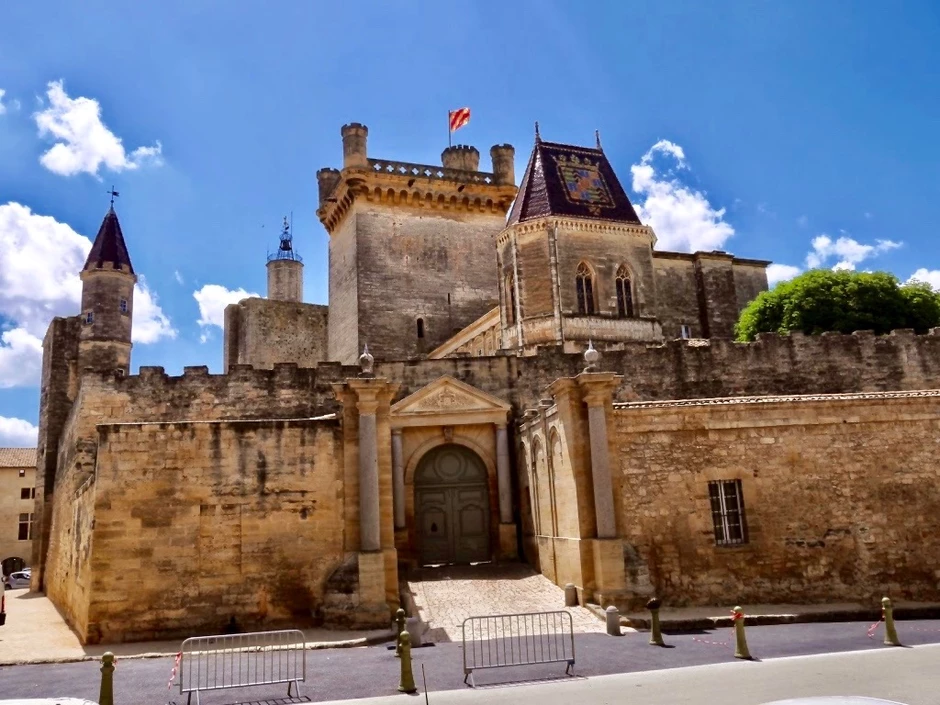
13. The Duke’s Castle, Uzes
Uzès most dominant landmark is the medieval Duke’s Castle, called the Duchy. It’s a walled structure smack in the middle of the town, complete with turrets, that serves as the Duke’s residence.
The dukes of Uzès have lived in the castle for over a thousand years. The present duke is #17. The castle serves as his summer home.
The castle’s a bit of an architectural mishmash with a 12th century tower, Gothic chapel, and Renaissance facade. After the French Revolution, the castle was partly in ruins.
Beginning in 1951, the Marchioness of Crussol set about restoring the Duchy. The present Duke and Duchess of Uzes continue to renovate.
Tucked behind the Duchy is a modern recreation of Uzès’ medieval gardens. From there, you can climb the King’s Tower (100 steps) for a panoramic view. Your castle entry fee includes access to the viewpoint atop the donjon.
Here’s my guide to visiting Uzes . You can visit Uzes and the Pont du Gard on a guided day tour from Avignon .
14. The Pope’s Palace, Avignon
The Pope’s Palace in Avignon is one of the most famous historic landmark in southern France. It’s the largest Gothic structure in Europe.
The popes haven’t always lived in Vatican City . From 1309-77, the popes lived in the enchanting riverside town of Avignon, rather than in Rome. That period was called the “Avignon Papacy.”
This episode in history created drama akin to an HBO mini series. In the 14th century, Rome was in chaos. In 1309, Clement V moved to Avignon to escape the mess and for his own safety.
Thereafter, no pope wanted to leave. It’s southern France, after all, and they liked their swishy digs. Upon the pleading of Rome, an elderly and more pliable Gregory XI finally moved “home” in 1377.
But the next pope was the mentally unstable Urban XI. The French cardinals rejected him, along with many European countries.
This led to a schism between France and Italy, a standoff where there were dual popes. Then there were deaths and poisoning and all matter of infighting until, finally, a single pope was agreed upon.
Today, you can tour the magnificent Palais des Papes (Palace of the Popes), where these rebellious French popes lived. The edifice was built in 1335-52 and is Avignon’s main attraction.
The imposing facade resembles medieval fortified churches. You can gasp at the Pope’s private apartments, frescoes, and the soaring chapel. And see what it actually looked like in the 14th century on a histopad.
Parking in Avignon is a nightmare. If your’ driving, your best bet is to head straight to the parking garage in the Pope’s Palace. The entrance is right outside the city walls.
You can book a guided walking tour of Avignon that includes skip the line tickets to the Pope’s Palace. You can also book a 4 hour guided tour that covers both the old town and the palace .
READ : One Day in Avignon Itinerary
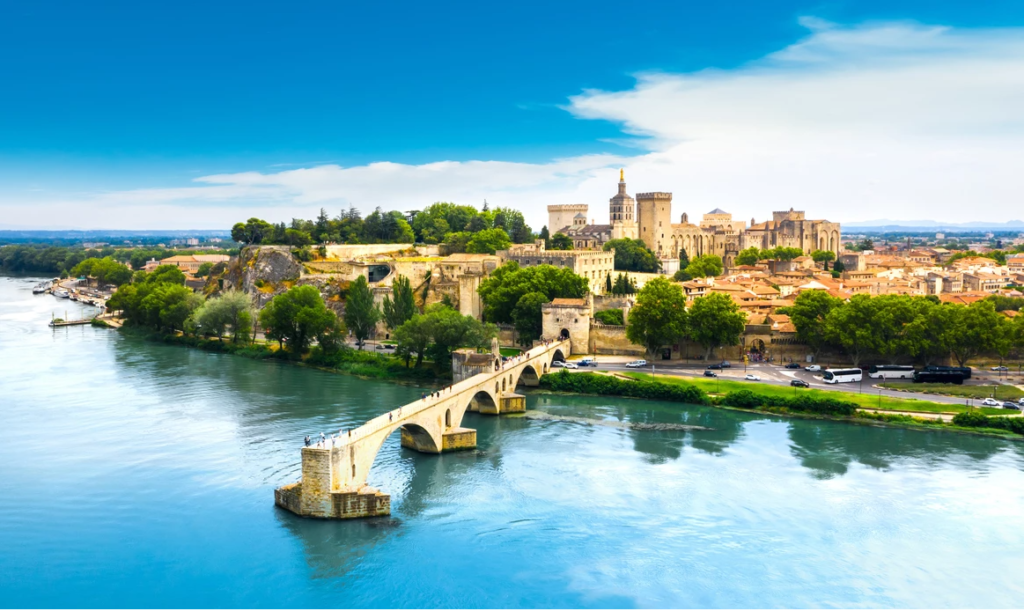
15. Pont Saint Benezet, Avignon
Pont Saint Benezet is the famous Avignon bridge that inspired the children’s song. It’s a UNESCO site as well.
Building began in 1177. In medieval times, the bridge was an important pilgrimage route for travelers going from Italy to Spain.
In 1226, Louis VIII of France laid siege to Avignon and destroyed the bridge. But the citizens rebuilt it.
But, over time, many of the arches were swept away due to flooding of the Rhone River. All that’s left are four arches and a tower.
16. Roman Amphitheater, Arles
Arles is a fantastic and underrated UNESCO town in Provence, just brimming with historical treasures and Roman ruins.
Now that we’ve covered Arles’ top cultural attractions, let’s get down to the things that make Arles a UNESCO destination.
Like nearby Nimes, Arles’ amphitheater was inspired by Rome’s Colosseum and is largely intact. Built in the 1st century when Augustus reigned, the two tiered arena can hold up to 25,000 people.
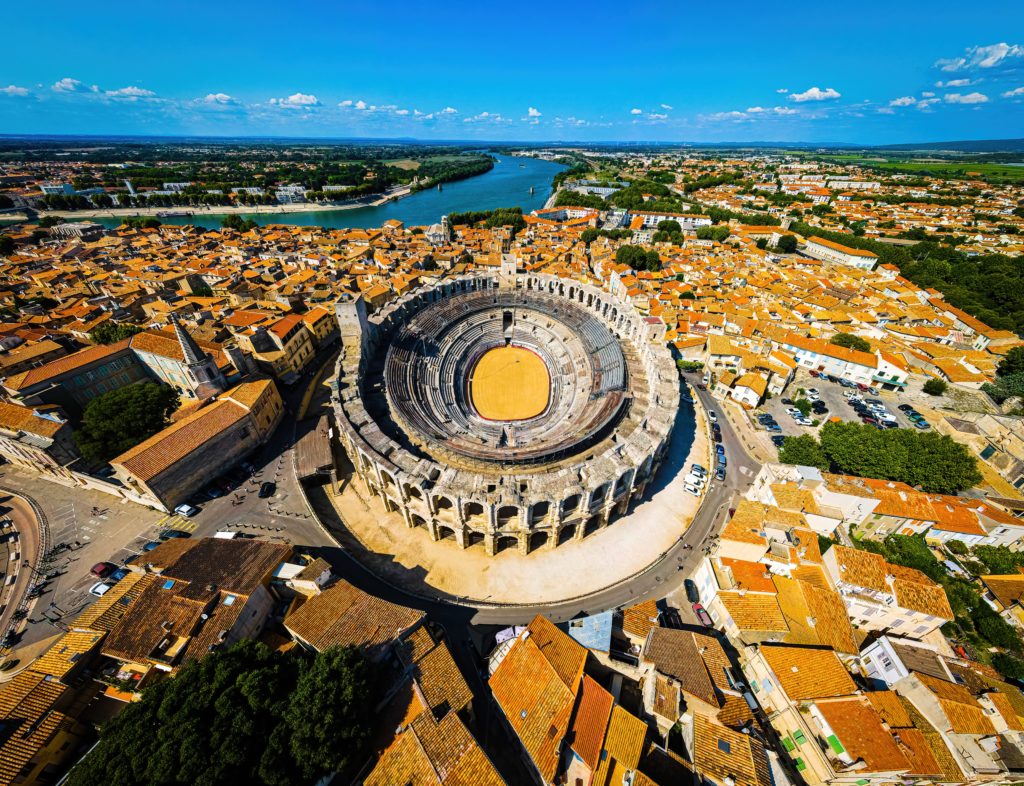
The amphitheater is beautifully preserved. Much of the structure’s original architecture remains, including terraces, galleries, and the original Roman drainage system.
Today, the arena hosts spectacles and concerts befitting a cultural hot spot. It also features Camargue-style bull runs and controversial bullfighting, which while beloved by Picasso is controversial or illegal elsewhere in France.
You can book a guided walking tour of the city to see all its Roman ruins.
You can also visit Arles on a guided day tour of historic sites from Avignon . Or on a guided day tour from Aix-en-Provence .
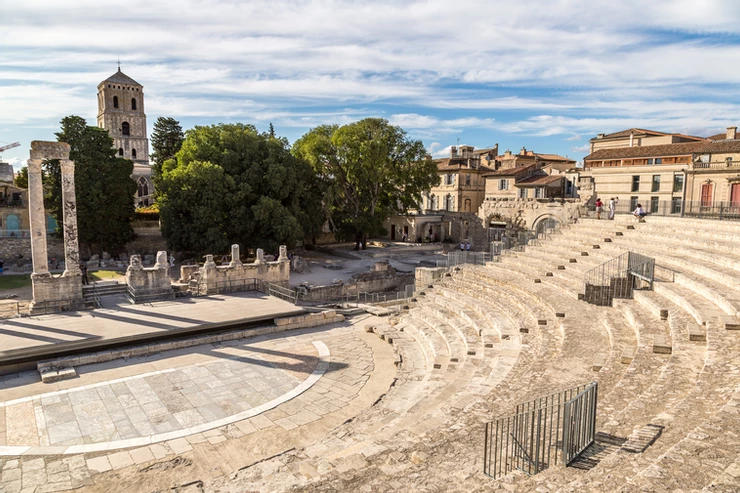
17. Roman Theater, Arles
Another top attraction in Arles is the Roman Theater in the Rue de la Calade.
Like the Arena, Arles’ Roman Theater is of Augustian vintage. With seating for 8,000, it’s as large as the famous theater in Orange France.
While I was there, I was lucky to witness a dance performance at night.
With the lights flickering across the roman stones and the few remaining pillars standing guard in the darkness, I felt catapulted back in time. It was exactly as affecting as it ought to have been.
18. Constantine’s Baths, Arles
My next stop was the Baths of Constantine, which date from the 4th century A.D. and were part of the imperial palace of the Roman Emperor Constantine the Great.
Only a small part of the original site is excavated, but it is well-preserved and you can glimpse some of the engineering that supported it.
Roman baths were, of course, an important part of Roman public and social life and are now fittingly part of Arles’ UNESCO classification.
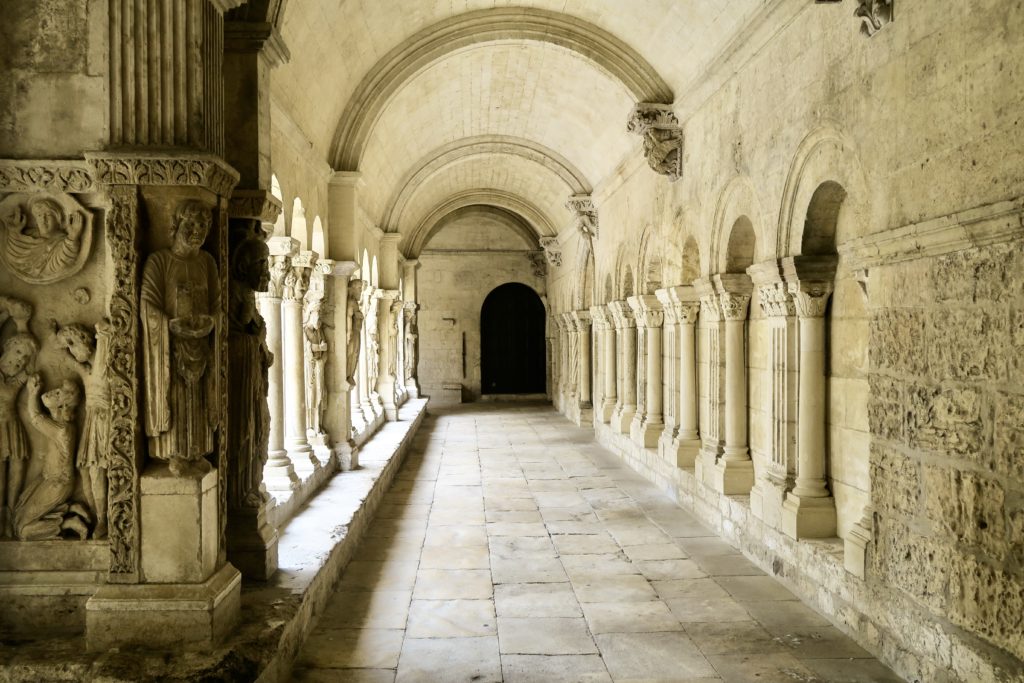
19. Eglise St. Trophime, Arles
When the Roman sites are a fait accompli, tucked away in the northeast corner of the Place de la Republique is the Eglise St.Trophime . The church is a remarkable example of medieval architecture
It was constructed over several centuries from the 12th to the 15th century. Recognized for its historical significance, it earned a spot on the UNESCO World Heritage list in 1981.
The church is distinguished by its intricately carved Romanesque portal. It depicts biblical stories through sculptural artistry. Inside, the atmosphere is austere yet adorned with remarkable details.
Among its notable features, St. Trophime houses an extraordinary collection of Romanesque sculptures, including a captivating piece that appears like an “approved public stoning.” These sculptures showcase exceptional craftsmanship and artistic expression.
The church has been laser cleaned. That removing some of the time-worn grime that once added character.
The stunning cloister is exceptionally well-preserved. It offers a separate entrance for visitors and features informative displays to enhance your understanding and appreciation of its historical significance.
20. Les Alyscamps, Arles
Alyscamps is a famous tree-lined Roman necropolis a short distance outside the walls of the old town. It’s near Jardin d’été, shadowed by the Chaine des Alpilles Mountains.
Dating from 241 BC, Les Alyscamps is a hybrid place, both a lichen covered stone cemetery for former aristocrats and a serene tree-lined promenade for those of more recent vintage.
During the middle ages, it was forbidden to bury the dead inside the city walls for religious and hygienic reasons. Cities like Arles created suburban “Aurelian Ways” lined with tombs just outside the city.
Alyscamps was the most coveted burial site outside of Rome. In fact, it became so popular that sarcophagi were shipped from around Europe to be interred.
Legend holds that Jesus Christ himself attended the burial ceremony of Saint Trophimus (the first bishop of Arles), leaving an imprint of his knee on a sarcophagus lid.
21. The Camargue
When I think of southern France, my mind immediately turns to enchanting medieval villages and bucolic lavender fields. I don’t expect to see top notch wildlife. So imagine my surprise when I arrived in the Camargue.
I saw wild bulls and white horses galloping in the countryside and pale pink flamingos flapping their wings in the salt flats. Because of its biodiversity and natural splendor, the Camargue is on the tentative UNESCO list.
The Camargue is a river delta where the Rhône meets the sea, just 30 minutes outside Arles in Occitanie. It’s an outdoor enthusiast’s and birdwatcher’s dream.
The Camargue is also a very off the beaten path destination in southern France . Visitors can hike, cycle, or ride horses in peace and quiet.
Or unwind by cruising the waterways. If you want to see thousands of flamingos, they’re on the coast between Les Stes Maries and Salin-de-Girard. Boats leave from Les Stes Maries.
And don’t forget the adorable villages. The fortified town of Aigues-Mortes is a must see site in the Camargue. It’s a perfectly preserved example of 13th century military architecture.
After you explore this “living museum,” head to the quaint town of Saintes Marie de la Mer. You can climb the ramparts for killer views over the Camargue.
To visit, you can take a guided 4 x 4 safari day tour from Arles. You can also book a guided tour that leaves from Avignon . You can also explore the Camargue on a fun guided e-bike tour with food and wine .
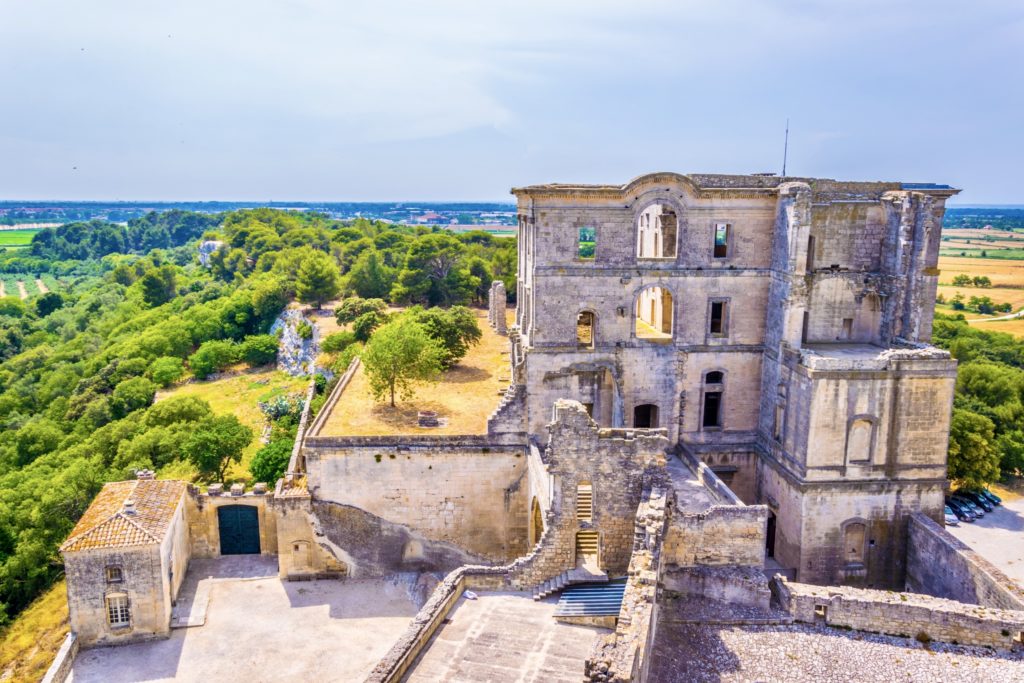
22. Abbey de Montmajour, Arles
Just 15 minutes northeast of Arles is the monumental Abbey de Montmajour.
The ancient Benedictine abbey was founded in the 10th century. It was built between the 10th and 18th centuries.
Because of the different building initiative, the abbey is an ensemble of a Roman cloister, Romanesque abbey church, a cave chapel, and a necropolis dug right into the rock.
In the Middle Ages, it was an important place of pilgrimage. Van Gogh was fascinated with the abbey and went there to paint.
23. Les Baux Castle, Les Baux In Provence
Les Baux is a popular spot, located in the heart of the Apilles Mountains and perched on a cliff. It’s the second most visited site in southern France (after the Pope’s Palace).
But don’t let that put you off. If you want to avoid tourist clogged streets, go there in off season and spend a half day. Les Baux is tiny, after all.
Les Baux is home to a great medieval castle. It’s now mostly in ruins, but the stone slabs are very atmospheric. And they remind you that Les Baux once fended off mauranding bands of medieval villains.
It was eventually destroyed by Cardinal Richelieu in the 14th century, when the fortress fell into rebel hands. The population of Les Baux dramatically declined afterward.
You can visit Les Baux as part of a Van Gogh-themed day tour from Aix-en-Provence . Or as part of a Provence sightseeing tour from Avignon .
24. Senanque Abbey
Situated right near the beautiful town of Gordes, the Notre-Dame de Senanque is a Cistercian abbey in Provence. Founded in 1148, some parts were destroyed in the Wars of Religion.
In 1988, a small group of monks returned. You can take a guided tour of the abbey church, cloisters, monks’ cells, and the Chapter House.
The abbey offers a fascinating glimpse of the austere (yet serene) surroundings of the Cistercian monks, who led lives of asceticism, poverty, contemplation, and manual labour.
Pray and work was their motto. At the time, the monks were a great counterpoint to the excesses of the catholic church.
25. Roman Ruins, Vaison-la-Romaine
The hidden gem town of Vaison-la-Romaine in Provence has an upper medieval town and a lower Roman town — an efficient double dose of history.
Based in the lower city, the Roman part of Vaison-la-Romaine was discovered in 1907. It’s the most important Gallo-Roman site in France.
The luxuriousness of the restored patrician villas reveal the Vaison was a prosperous Roman town. Don’t miss the Maison Apollon, Maison Laure, or Maison Tonelle.
The villas were once filled with beautiful mosaics, mostly in geometric patterns. The most intricate ones are from the Peacock Villa. To learn more about Vaison’s roman ruins, head to the Archaeological Museum, where you can also see the peacock tiles.
I also loved Vaison’s 1st century antique theater, dating from 20 A.D. It was empty, so my travel partner impulsively took center stage and sang an aria. Talk about reliving history.
READ : One Day in Vaison-la-Romaine Itinerary
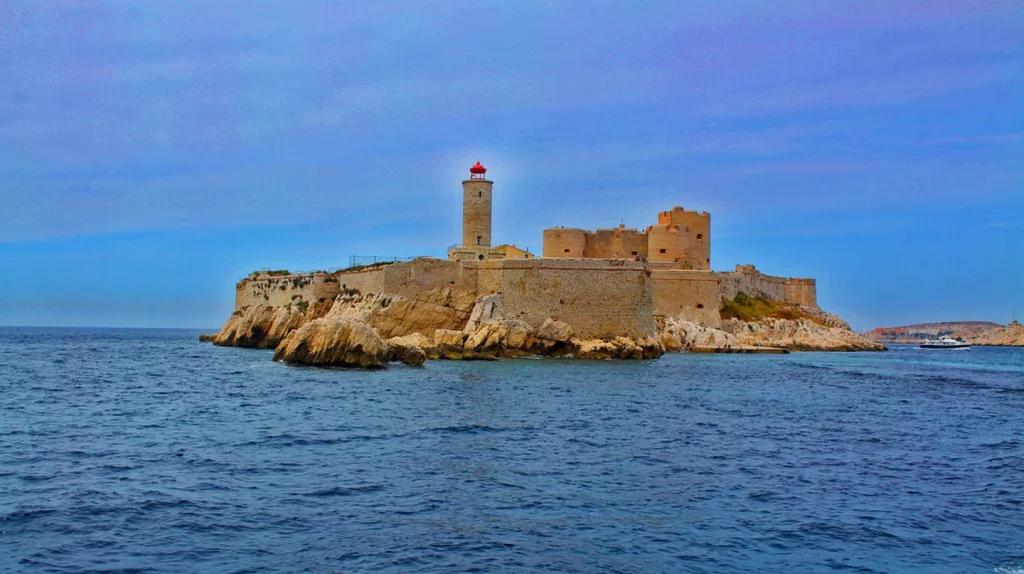
26. Chateau d’If
Château d’If is an old island prison off the coast of Marseilles. It was made famous by Alexandre Dumas in his classic novel, The Count of Monte Cristo . It’s where his hero, Edmond Dantès, was wrongly imprisoned for years.
Construction began in 1524 and finished in 1531. It has three storeys, built in the shape of a square. It’s protected by towers, with cover for archers and guns.
But the design wasn’t conducive to military use. So the chateau was converted to a prison.
I hope you’ve enjoyed my guide to the must visit landmarks and monuments in Southern France. You may enjoy these other France travel guides and resources for France:
- 2 day itinerary for Paris
- 3 day itinerary for Paris
- 5 day itinerary for Paris
- Top Attractions in Montmartre
- Secret hidden towns in France
- Famous landmarks in France
- 10 day itinerary for southern France
- Charming hidden gems in Provence
- 30+ beautiful towns in northern France
- Beautiful villages of Brittany
- Guide to Mont Saint-Michel
If you’d like to visit historic landmarks and attractions in southern France it, pin it for later.
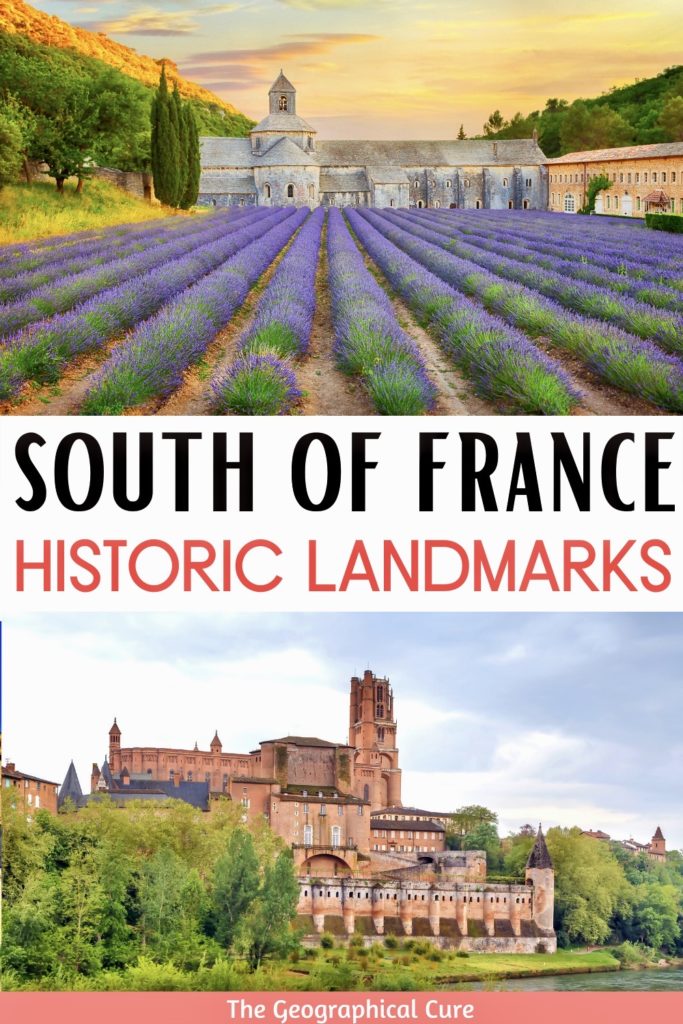
Leave a Comment Cancel reply
Save my name, email, and website in this browser for the next time I comment.
Last Updated on June 22, 2023 by Leslie Livingston
Top Destinations
- Food + Drink
Explore the best of the world. Access insider tips and hotel recommendations from our travel tastemakers
By proceeding, you agree to our Privacy Policy and Terms of Use .
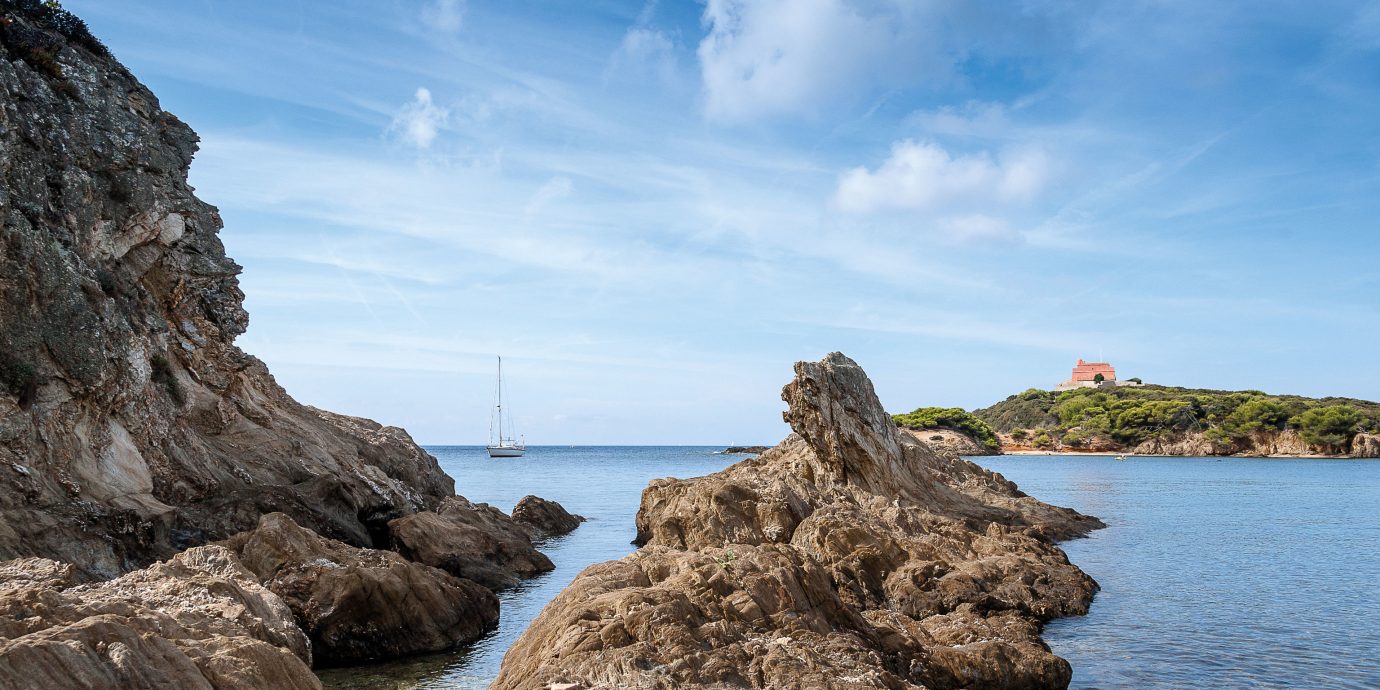
- 1 Saint-Tropez
- 3 Porquerolles Island
- 6 Saint-Paul-de-Vence
8 Incredible Places to Visit in the South of France
While the Riviera has maintained a glam reputation since the '50s (Brigitte Bardot basking on Saint-Tropez's beaches; A-listers strutting down Cannes' red carpet), there is more to le Midi than just its jet-set resort towns—including idyllic bohemian islands and hilltop medieval towns housing their own Michelin-starred restaurants. Whether you are looking for a day that starts (and ends) with rosé at a celeb-filled beach club or prefer a more secluded seaside escape, here are eight must-see destinations to check off during a visit to the South of France.
P.S. Check out What to Pack for a Beach Vacation before your next seaside getaway!
See recent posts by Lane Nieset
Subscribe to Jetsetter on YouTube
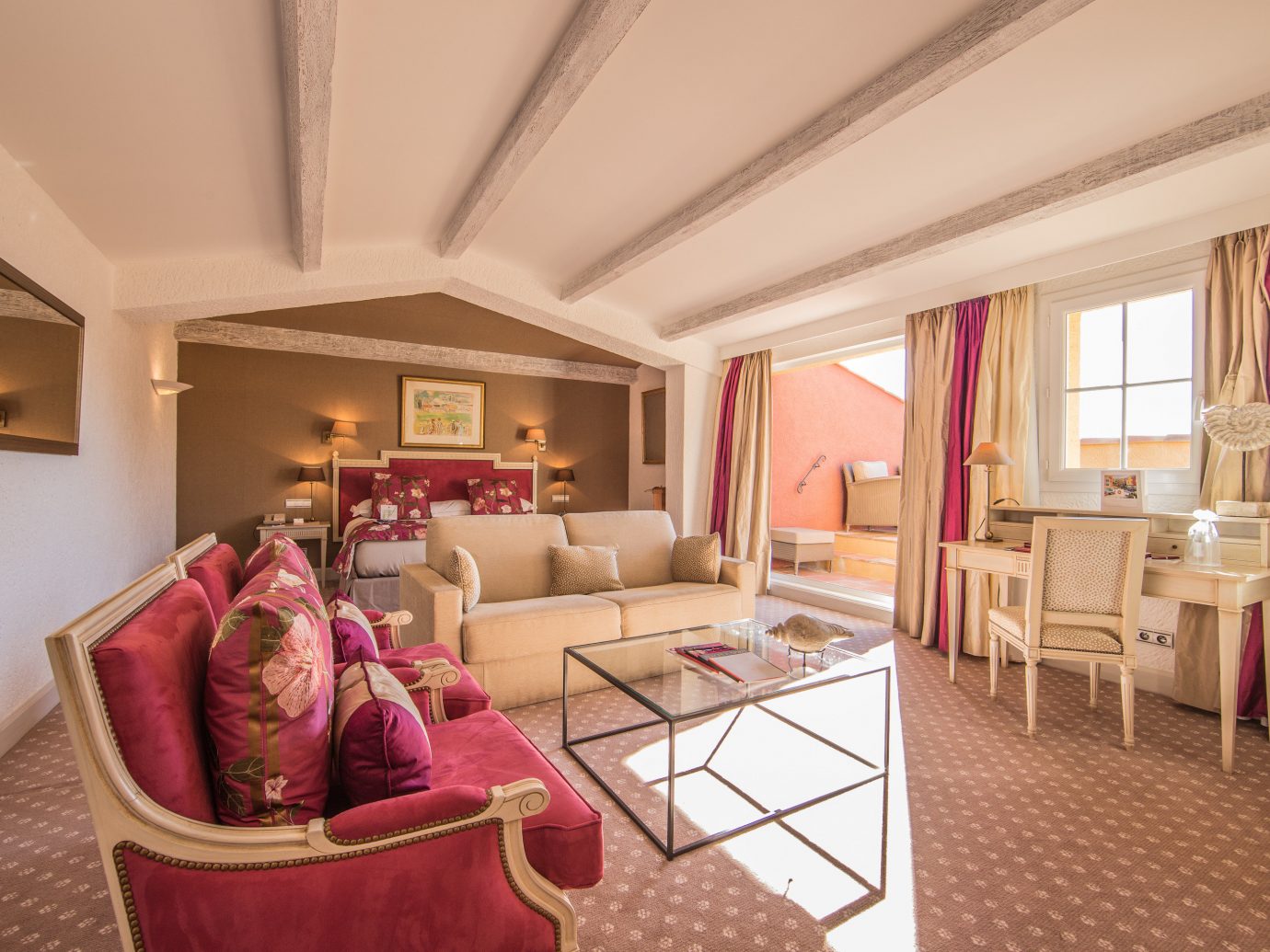
Saint-Tropez
Saint-Tropez swells in the summer months as yachts creep into port, but a quick stroll through the narrow, cobbled streets of Old Town reveals what attracted celebrities to this former fishing village in the first place. Start your morning at La Tarte Tropézienne with an espresso and a slice of the patisserie’s namesake cream-filled brioche (a Brigitte Bardot favorite when she was shooting the 1950s film “And God Created Woman”), then take your petit-déjeuner across the square to the Place des Lices and stroll through the stands of cheese and flowers at the open-air Provencal market, held every Tuesday and Saturday morning. After gathering a basket-full of picnic fixings, head over to the 15th-century stone Portalet Tower and work off those breakfast calories during a coastal hike along the peninsula’s best beaches—accessed otherwise only by boat. At one of the most famous, Pampelonne, you’ll find the swankiest of Saint-Tropez’s beach clubs like Le Club 55 and Miami Beach transplant Nikki Beach , whose anything-goes spirit and lavish costume parties are known to draw celebrities. For something more low-key, trek down to the tucked-away cove of L’Escalet Beach, where you can spread out on a shore sans tourists. Back in town, pause on the port at Sénéquier for a coffee and prime people watching until dinner at the buzzy, Asian-inspired BanH-Hoï , a Saint-Tropez institution in Old Town. Night owls can dance the evening away at the legendary nightclub Les Caves du Roy in Hôtel Byblos ; for those ready to call it a night, head up the hill to the secluded 28-room Saint Amour La Tartane Hotel .
Do: Rent a small boat and explore the glamorous resorts and sun-soaked beaches of the French Riviera from the sea.
Explore More: See hotel details | See all Gassin, France hotels
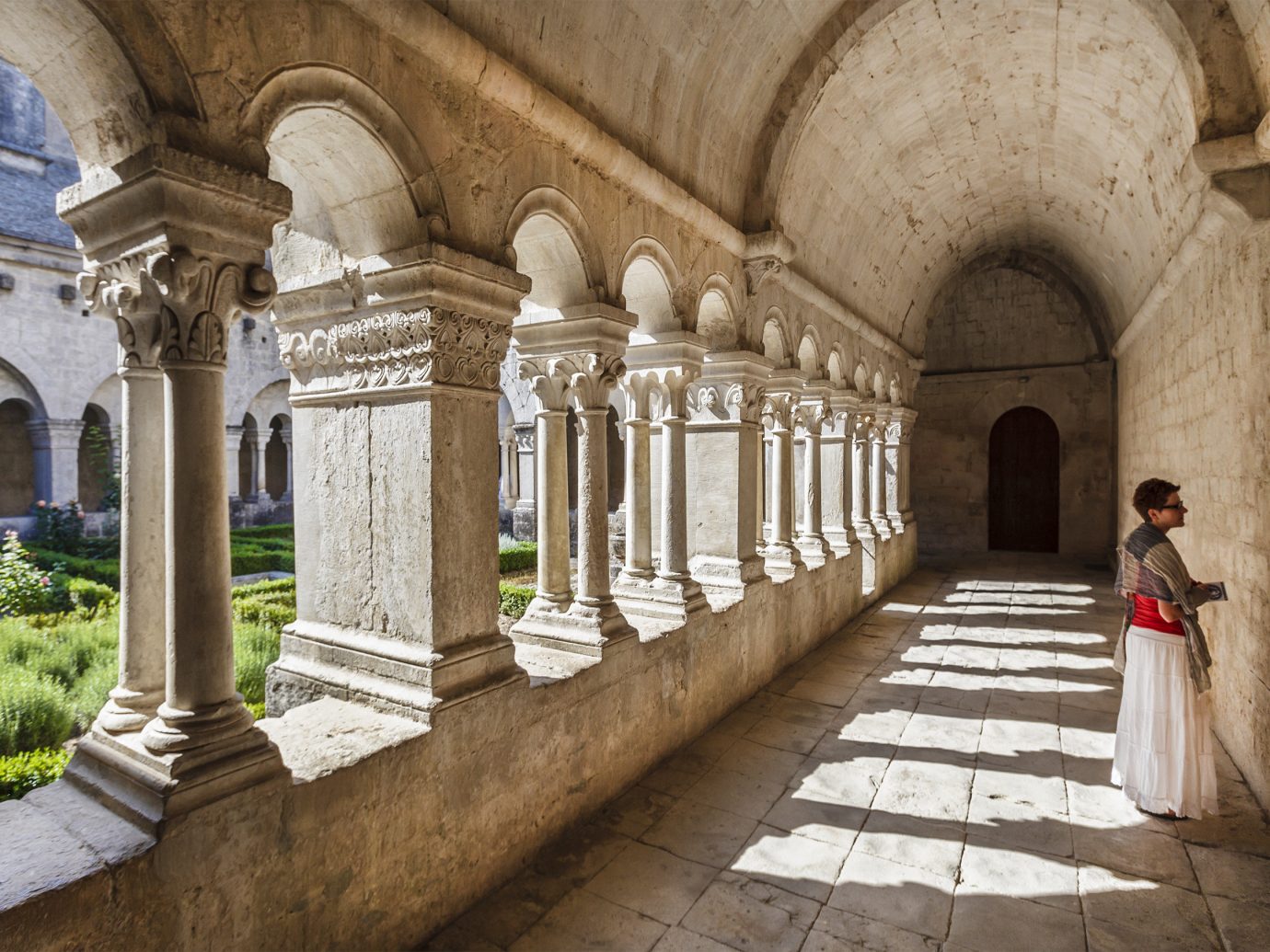
Provence is a blanket term for the southeastern part of France that sprawls along the Mediterranean coastline and up into the rolling, vineyard-lined hills beyond. The best way to take in the region is by car, starting in the storybook-like medieval village of Les Baux-de-Provence. Make the former farming estate of Domaine de Manville your home base, whose stylish hotel and pastoral 100-acre grounds are within easy reach of Les Baux’s more famous neighbors like Aix-en-Provence and the walled city of Avignon. Sit in the center of Aix and sip a glass of cool rosé on the terrace of Les Deux Garçons —the legendary brasserie has been frequented by everyone from painter Pablo Picasso to chanteuse Édith Piaf—or linger over a spread of foie gras, beef tartar, and black tiger prawns at the shabby-chic restaurant L’Agape in Avignon. When you’re ready to hit the road and cruise through Provence’s signature lavender fields, set your GPS to the 13-room Les Gorges de Pennafort , home to Philippe Da Silva’s Michelin-starred restaurant. Not only is the restaurant a destination in itself, it’s also close to the Gorges du Verdon, a river valley carved with scenic hiking trails that’s been called the Grand Canyon of Europe.
Do: Discover the medieval villages and world famous wineries of Châteauneuf-du-Pape on a small-group day tour .
Explore More: See hotel details | See all Provence, France hotels
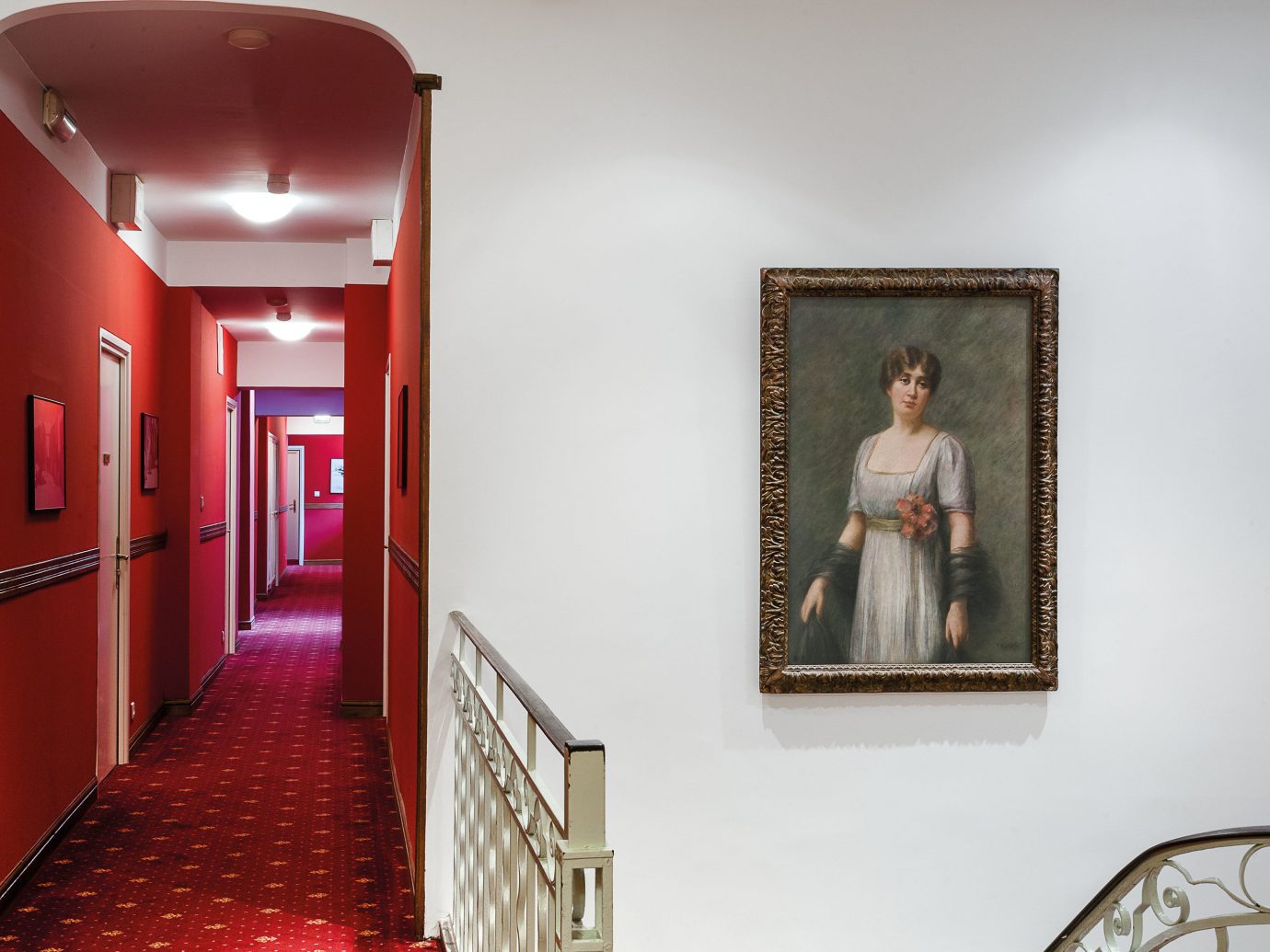
Porquerolles Island
Just a 15-minute ferry ride from the town of Hyères, less than an hour from Saint-Tropez, lies an archipelago of three islands with coastlines as white as the Caribbean and vineyards producing rosé on par with some of Provence’s most iconic wineries. On the largest of the islands, Porquerolles, a small village sits in a square along the port that’s full of locally owned restaurants like Pélagos . (Order the catch of the day grilled à la plancha and rosé from Domaine Perzinsky, one of island’s three wineries.) The four-mile-long-by-two-mile-wide (and car-free) island is lined with over 37 miles of marked trails that are best explored by bike. After packing a picnic of local produce and wine from one of main square’s market stalls, rent a set of wheels from Le Cycle Porquerollais (full-day rentals are 15 euros). It’s not hard to navigate the island, but one of the most beautiful beaches worth seeking out is Plage Notre Dame, about a 15-minute ride away on the north coast. After a day of beach hopping and biking, soak up views of the sea on the terrace at L’Orangerie . Because this isn’t a town that stays up late, call it an early night at one of the two stand-out hotels: the charming 25-room Villa Sainte Anne , which overlooks the main square, or the antiques-filled Le Mas du Langoustier , a regal Provencal residence-turned-hotel hidden away on the western side of the island.
RELATED: The Most Romantic Hotels in Paris
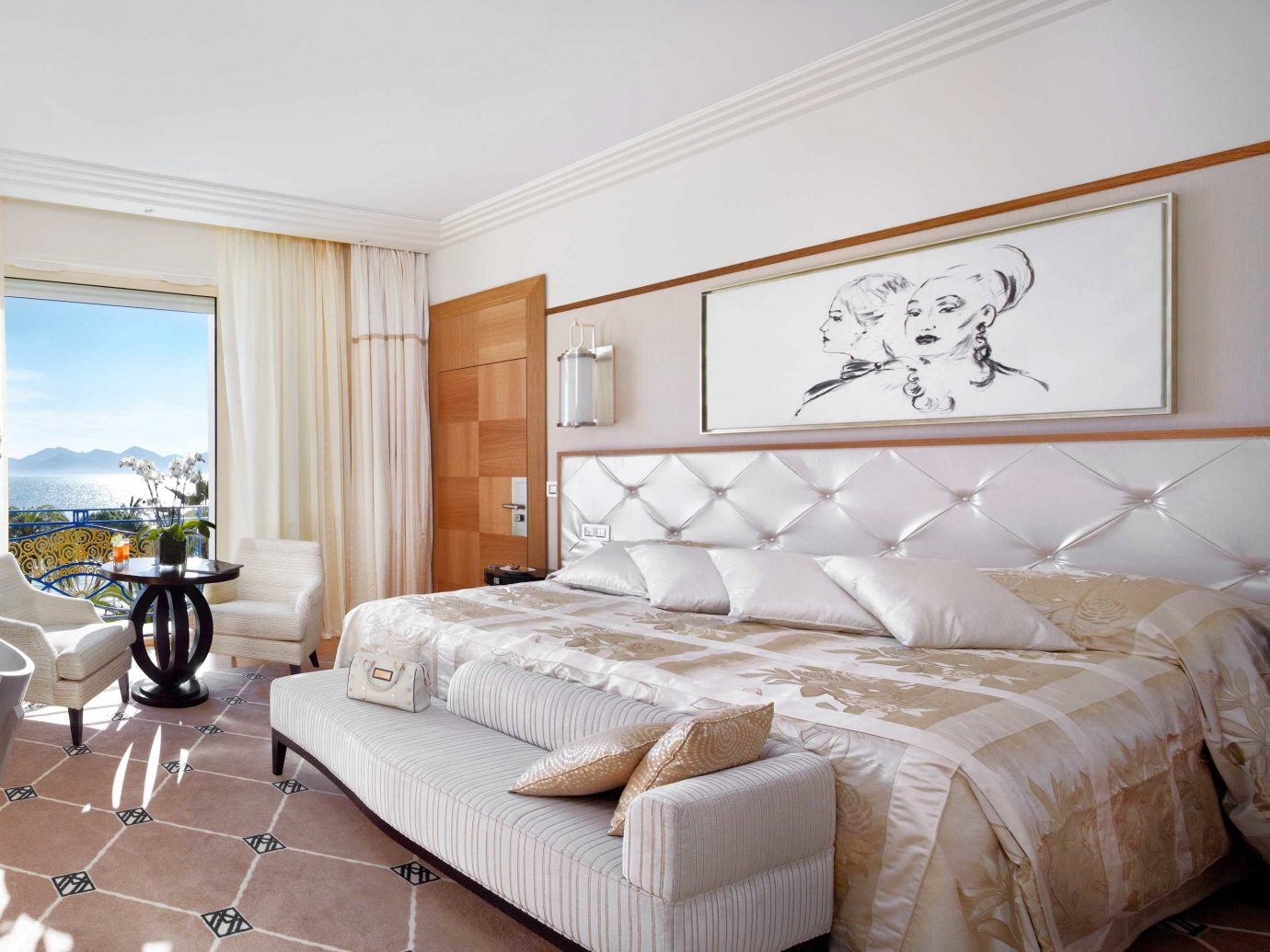
Cannes has been synonymous with cinema for the past 70 years, so slip on your chicest set of heels and take a walk just like the stars along the infamous Boulevard de la Croisette, which separates boutiques like Chanel from the beach. For parties that seep from day into night, Bâoli Beach Cannes is your place. At midnight, the restaurant transforms into a roaring nightclub where sparkler-filled magnums are the norm. (Its sister spot , on the far end of the Croisette in the Port Pierre Canto, is also known for hosting some of the hottest events during the film festival.) If you want to get a sense of where the city started over 400 years ago, take a stroll through the streets lining the hill of Le Suquet, the Old Town. From the Old Port below, hop a ferry to the Lérins Islands, where you’ll find untouched sandy shores and wine crafted by Cistercian monks, the islands’ only residents. Île Sainte-Marguerite is the largest and closest island to mainland Cannes and home to historical sites like the cell of the Man in the Iron Mask as well as haute seaside eatery, La Guérite . Back in town, dine in a villa at L’Antidote , whose menu weaves market-fresh ingredients into rich dishes like foie gras-stuffed ravioli. JS Tip: If you want to sample a Provence specialty, try Chef Christophe Ferré’s version of bouillabaisse seafood stew. After a day of sightseeing, rest your feet in one of the major hotels hugging the Croisette, such as the Grand Hyatt Cannes Hôtel Martinez (home to the city’s only two-Michelin-starred restaurant) or the Belle-Époque palace known as Hôtel Barrière Le Majestic .
Do: Cruise the charming streets of Cannes on a Vespa with an expert guide leading the way.
Explore More: See hotel details | See all Cannes, France hotels
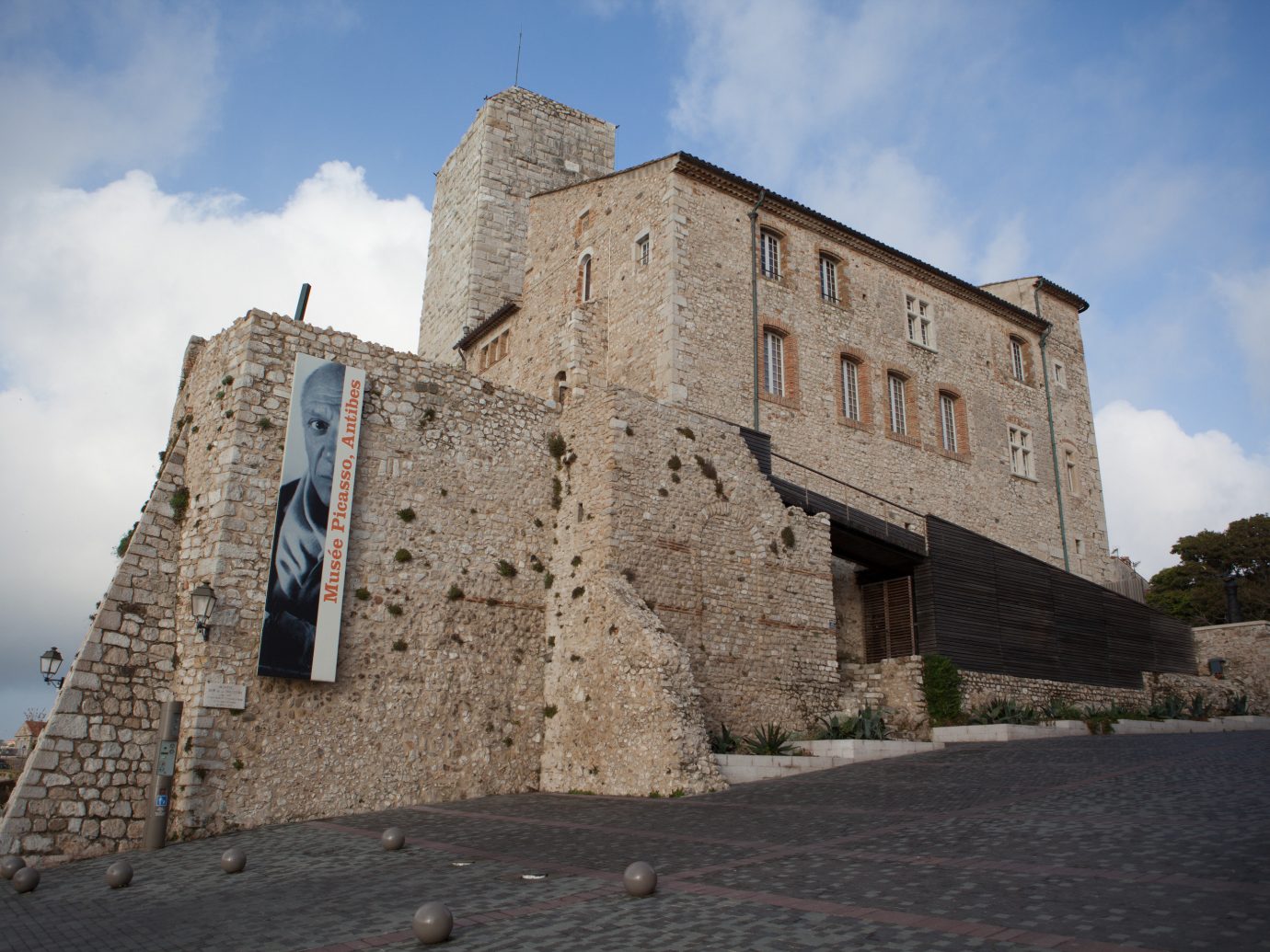
Tucked on the coast between Nice and Cannes, Antibes got its start as a Greek colony in the 5th century BC. In the mid-1800s, the town transformed into the haute holiday destination it is today. Admire remnants of its stronghold past by walking along the remaining rampart walls and into the castle housing one of the Old Town’s main attractions: the Picasso Museum. After getting your cultural fix, grab a baguette from one of Antibes’ most famous boulangeries, the three-generation Le Pain JPV , then skip the beaches in town and head to the villa-lined peninsula of Cap d’Antibes for a picnic lunch along the water. The two-hour light hike around the coast on the Chemin du Calvaire path leads to some of the cape’s best coves like La Garoupe beach, a favorite of writer F. Scott Fitzgerald. Literature buff? You can even sleep in the same spot the writer lived during the 1920s, Hôtel Belles Rives , a 40-room villa on the sea wall in neighboring Juan-les-Pins that’s home to La Passagère, one of the top eateries in town. While the villa inspired Fitzgerald’s “Tender Is the Night,” Hôtel du Cap-Eden-Roc was also immortalized in the work of another artist—photographer Slim Aarons. Spend your evenings there sipping bubbly at the rooftop Champagne Lounge, which exclusively collaborates with 14 top champagne houses, or sway to the sounds of piano in the Old Town at the cave-like Absinthe Bar.
Do: Have a bike delivered to your hotel and explore the beachside town of Antibes at your own pace on wheels.
Explore More: See hotel details | See all Antibes, France hotels
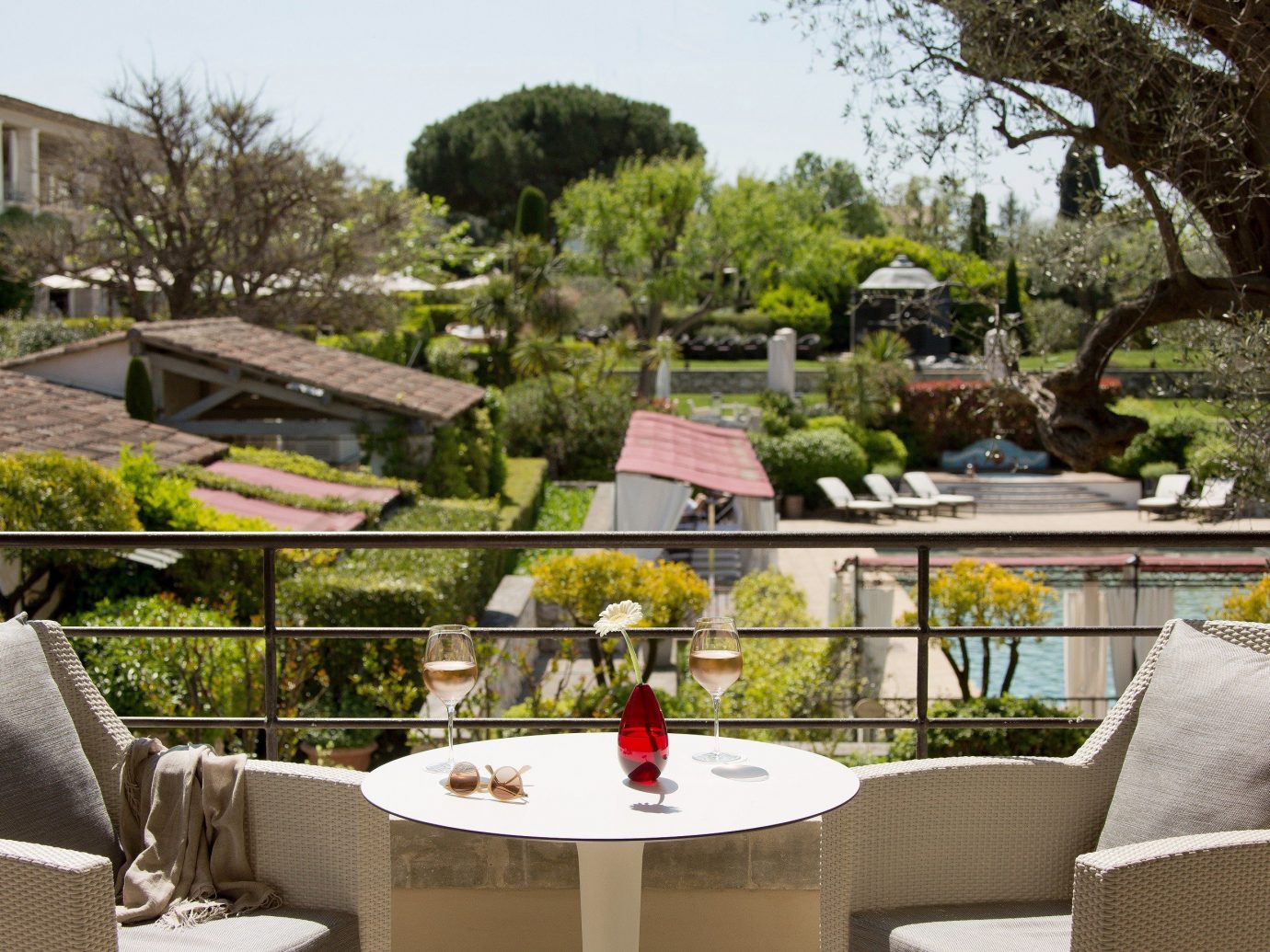
Saint-Paul-de-Vence
Medieval towns dot the hillside along the Riviera, but one so charming that artists like Calder and Chagall decided to call it home is the thousand-year-old walled city of Saint-Paul-de-Vence. Soak up village vibes at the legendary Place du Jeu de Boules square, where you can people-watch while sipping coffee on the terrace at Café de la Place . Just across the square, you’ll find the famous Colombe d’Or . What started as a bar and three-room inn grew into a restaurant and 25-room hotel that became one of the most popular meeting places for artists like Picasso and Matisse. At that time, artists exchanged paintings for a free night’s stay or a few meals, and you can still see many of these works on display around the hotel and restaurant (be sure to make lunch reservations months in advance to ensure a table). You can also take in one of the largest collections of 20th-century art in Europe, including works by greats like Braque and Miró (who also spent time in Saint-Paul-de-Vence), at modern art museum Fondation Maeght , while the neighboring town of Vence is home to the magnificent stained-glass Chapelle du Rosaire , a Matisse masterpiece. For lunch, head next door to Les Bacchanales , a three-story villa with an outdoor sculpture garden and terrace overlooking the sea. In the hills above Vence, the former 12th-century Knights Templar Commandery, Château Saint-Martin & Spa , remains one of the most stunning spots to rest your head in the Riviera. If you’d rather stay in St.-Paul proper, the tucked-away Le Mas de Pierre is a great pick for views over the valley—plus private gardens and villas if you really want to live like royalty.
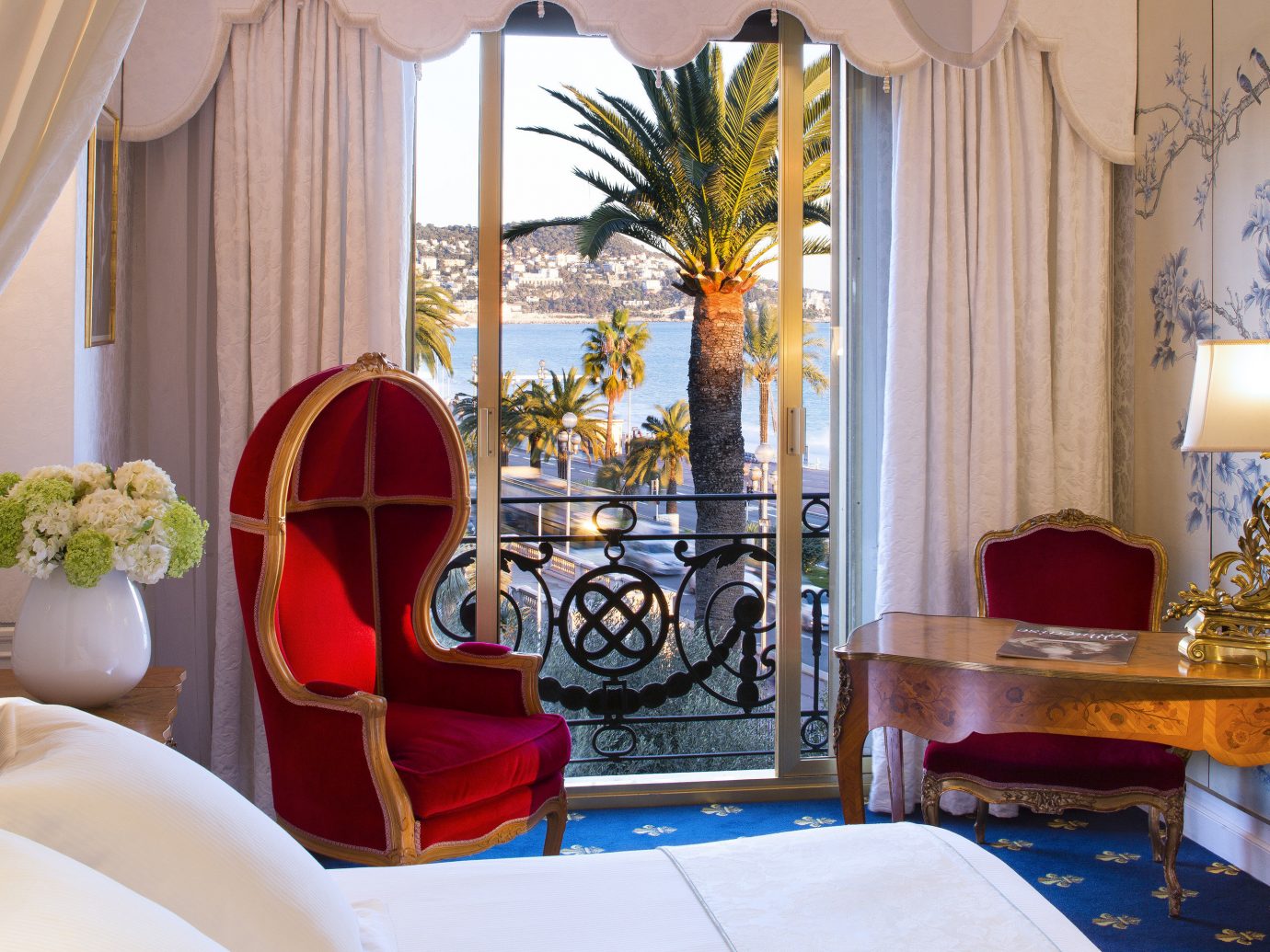
While often seen as a stopover town, Nice is the Riviera’s main point of entry for good reason. One glance at the Cours Saleya flower market and you’ll quickly fall in love with the city. Tourist trap-style restaurants line the square, but if you head one street back, you’ll find the husband-and-wife-run Papayou , which serves a mix of Mediterranean and Asian-influenced plates (think Thai curry and fish stew). Nearby, La Petite Maison (whose empire spans from Dubai to Miami Beach) is a celeb fave, but for something just as charming yet slightly less flashy, walk across the street to owner Nicole’s newer bistro, Le Comptoir 2 Nicole . Start the your evening here with a cheese plate and rosé, or take your apéritif above water at La Réserve , a restaurant perched on a rock jutting over the harbor. If you want something that truly captures the Riviera’s party spirit, drive 10 minutes to neighboring Villefranche-sur-Mer for Le Palm Anjuna, the restaurant version of lively beach bar Anjuna Bay nestled along a hidden bay in Eze. Here, musicians serenade guests in a bohemian enclave of tropical plants, Balinese statues, and reclaimed wood tables. Curl up for the night back in Nice along the half-moon Promenade des Anglais at century-old Le Negresco , whose regal, antique-filled rooms have enticed everyone from Princess Grace to The Beatles. Château de la Chèvre d’Or , in the cliffside medieval village of Eze, is just as breathtaking: statues and waterfalls transform gardens into open-air museums, while each of the 40 rooms (formerly village homes) offers up something different, from chimneys to private pools and panoramic bay views.
Do: Taste the flavors of Provence with a small-group food tour.
Explore More: See hotel details | See all Correze, France hotels
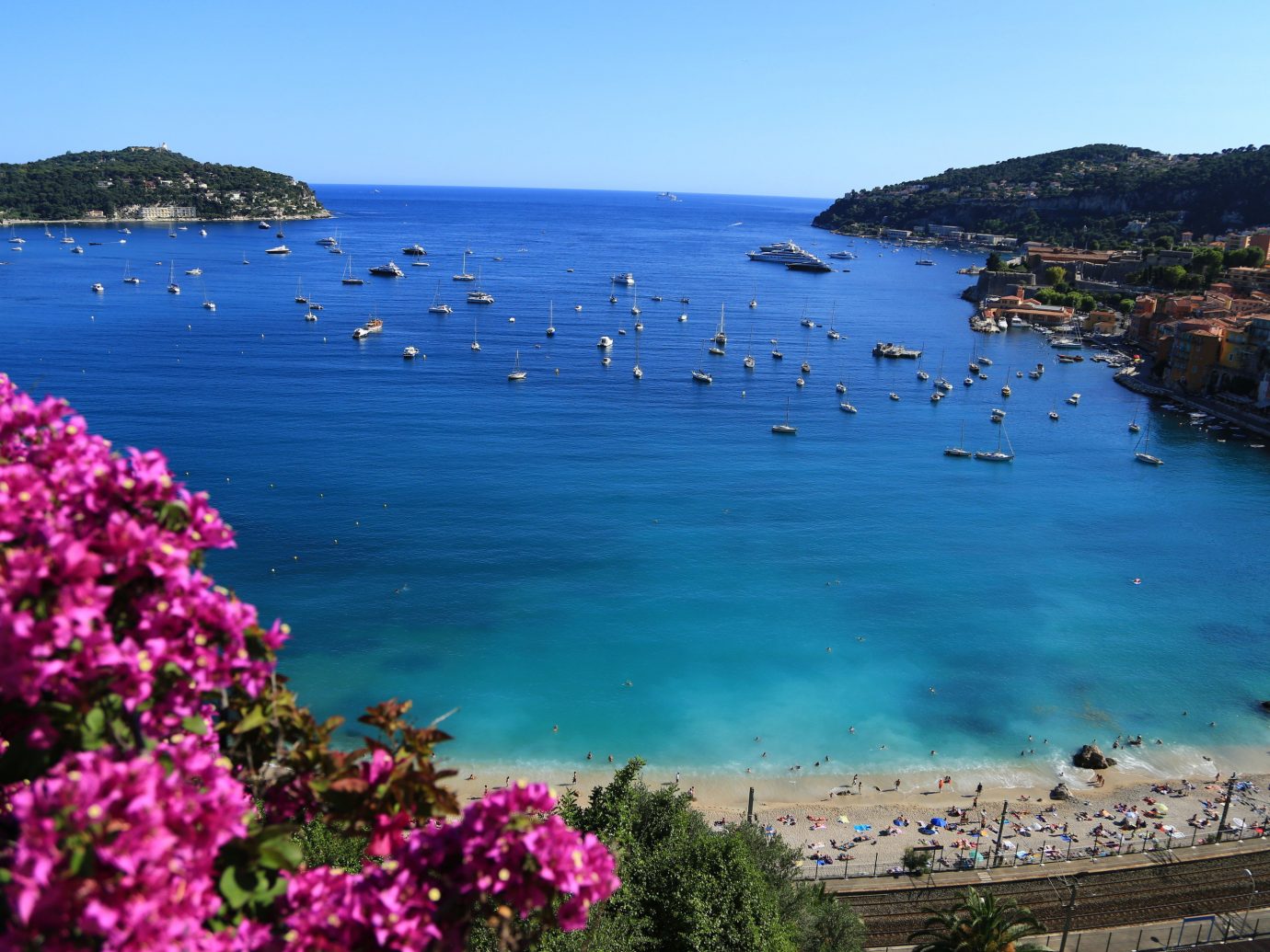
While not technically part of France, Monaco is still one of the major highlights to hit while touring the south. Just a 10-minute drive from the Italian border town of Ventimiglia, the petite principality of Monaco—it measures roughly three times the size of the National Mall in Washington D.C.—offers plenty of pursuits that can be as decadent or demure as you’d like. Lounge by the sea in Cap d’Ail at beach bar Eden Plage Mala , or treat yourself to a day of pampering at the iconic Thermes Marins Monte-Carlo, whose alfresco Jacuzzis overlook the port and Prince’s Palace. Before hitting the town, get your hair styled like the stars at the recently opened Rossano Ferretti salon (a stylist favored by the likes of the Duchess of Cambridge) in the Hôtel de Paris , then pause for a cocktail at the property’s iconic Bar Américain or take your pre-dinner drinks down to the water at Wine Palace , whose plush couches sit along the port. If you want to keep the party going, dance to live music at portside Rascasse or head to high-energy Jimmy’z , dubbed Monaco’s “temple of clubbing.” When you’re ready for some beauty sleep, rest your head at the sumptuous Hôtel Métropole Monte-Carlo , where you can soothe away any signs of a hangover at the spa by Givenchy.
Do: Book a private yacht (with your own personal skipper!) and experience Monaco in luxe style.
Explore More: See hotel details | See all Monte-Carlo, Monaco hotels
What to Pack
Women’s pretty dress outfit for the south of france, shop the look.

Leather Bag

Men’s Casual Tee Outfit to Wear in the South of France

Instant Camera

Aluminum Cash Strap

Classic Sneakers
- The Best Walking Shoes for Women
- 16 Stylish Trenchcoats We love
- 7 Places to Go This Year Before the Crowds Hit
Jetsetter is a participant in the Amazon Services LLC Associates Program, an affiliate advertising program designed to provide a means for sites to earn advertising fees by advertising and linking to Amazon.com. Jetsetter also participates in the SkimLinks and SkimWords affiliate programs.
All products are independently selected by our writers and editors. If you buy something through our links, Jetsetter may earn an affiliate commission.
Become a Jetsetter.
Use our insider connections to know where to go and what to do.
Thanks for Signing Up!
Related Tags
Explore more.
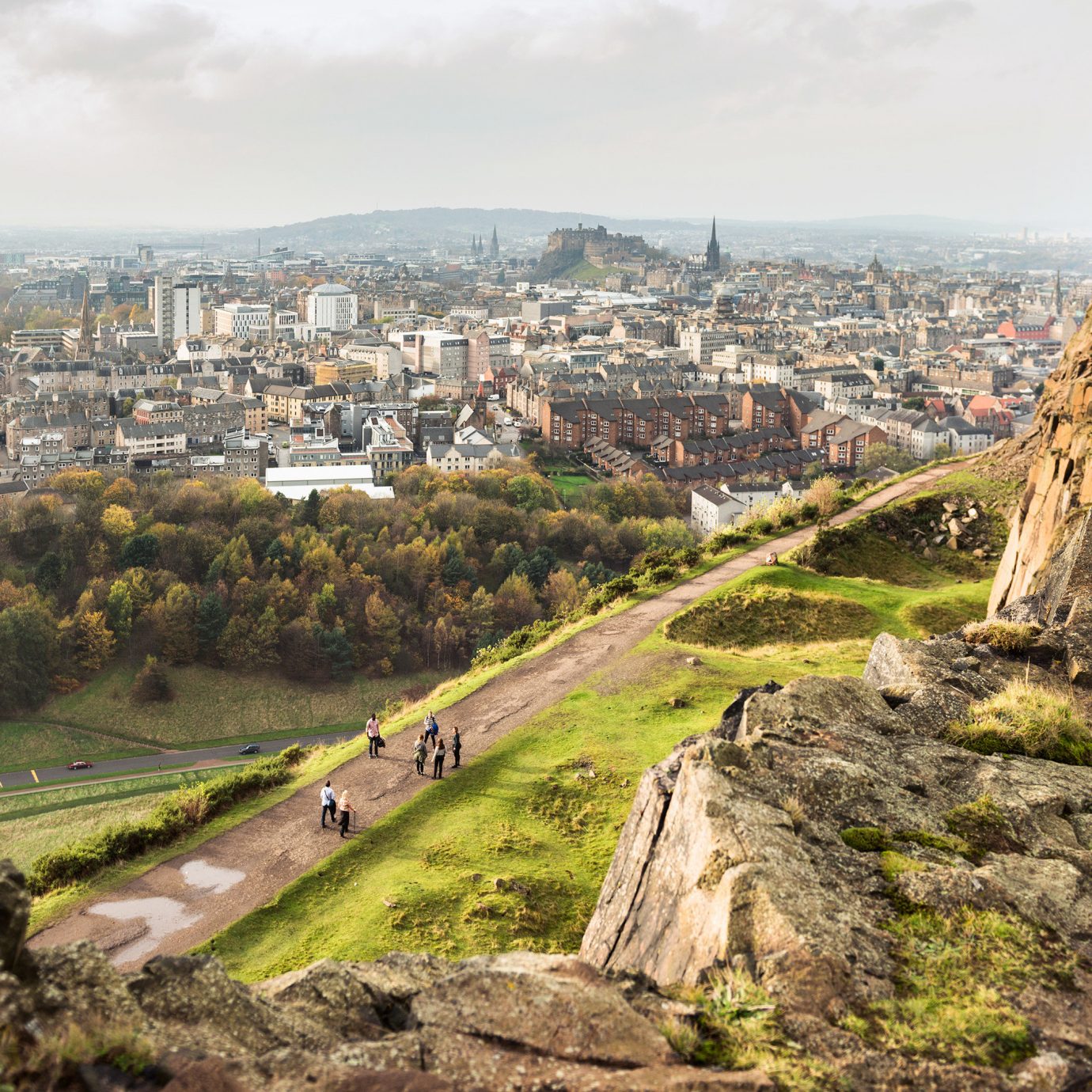
Where to Eat, Sleep, and Play in Edinburgh, Scotland

The Coolest Things to Do in Barcelona Now
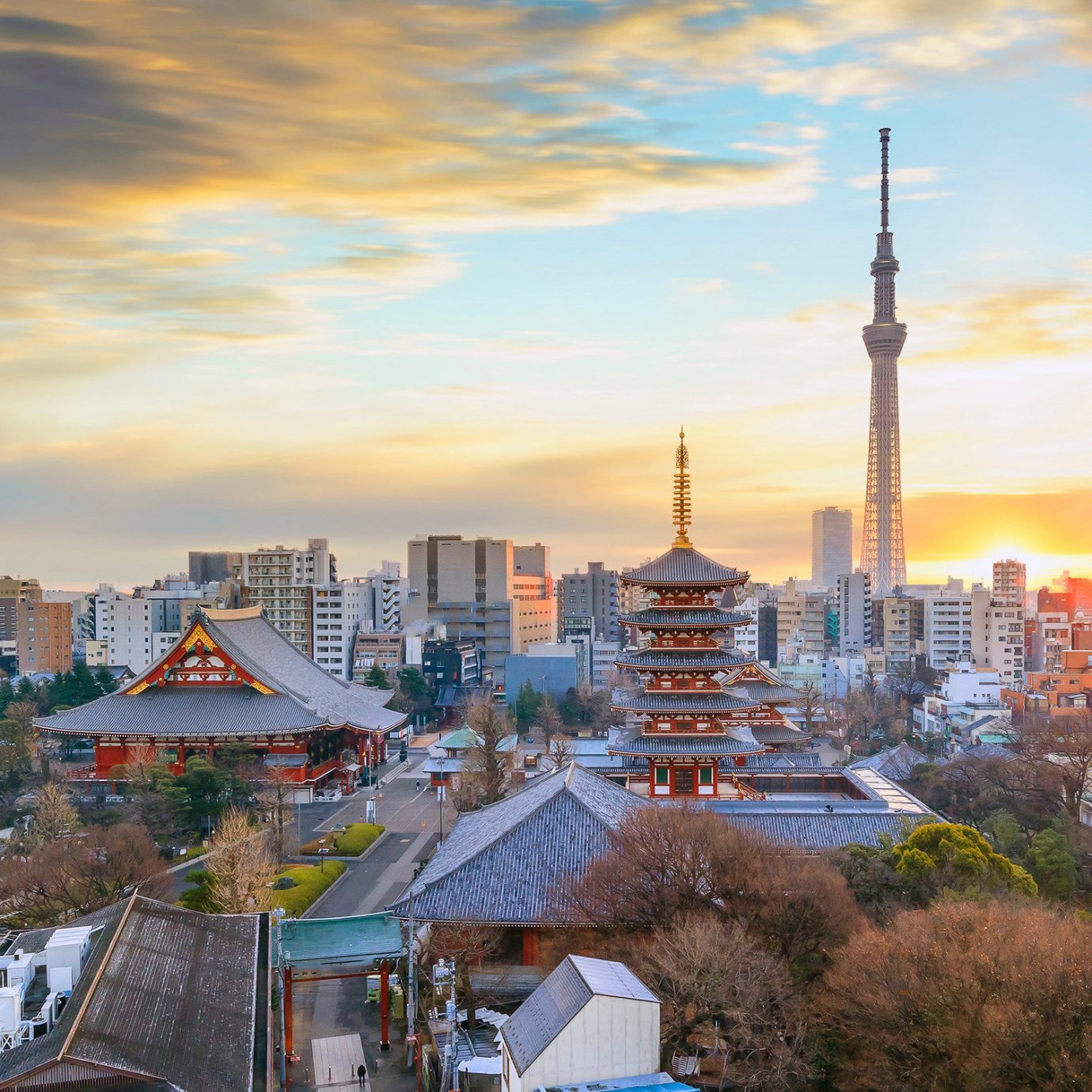
The Coolest Things to Do in Tokyo
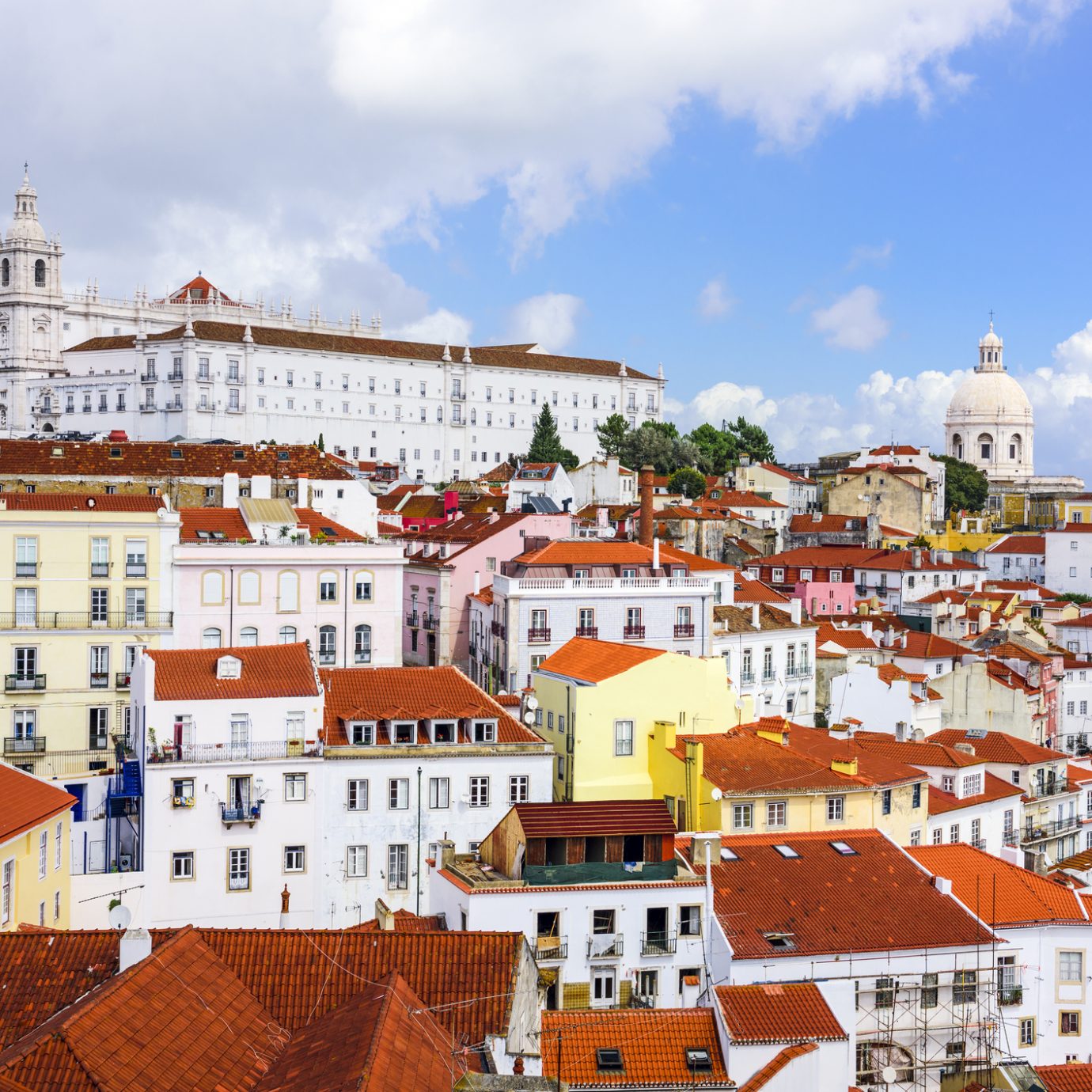
Lisbon for Food Lovers
Beautiful South of France Cities to Visit All Year Round
Article written by Elisa - Travel Writer & Local in France This article may contain compensated links. Please read disclaimer for more info.
Best Cities in the South of France to Visit
The South of France conjures images of stylish luxury, tranquil seaside vibes, and elegant fine dining. With a plethora of cities just waiting to be explored, Southern France is perhaps one of the best regions in the country to visit.
This list of the best cities in Southern France includes some of the most beautiful cities in France as well as some lovely, underrated cities . Because of the region’s warm weather and days of sunshine, you can visit any of these South of France cities all year round.
This post covers cities in the Occitanie region and the Provence-Alpes-Côte d’Azur region . Many of these South of France cities are ideal destinations for a long weekend break or starting points for fabulous French road trips , while others are excellent base camps to visit some of the best places in Southern France .
Check out this list of favorite Southern France cities before you plan your next trip to France .
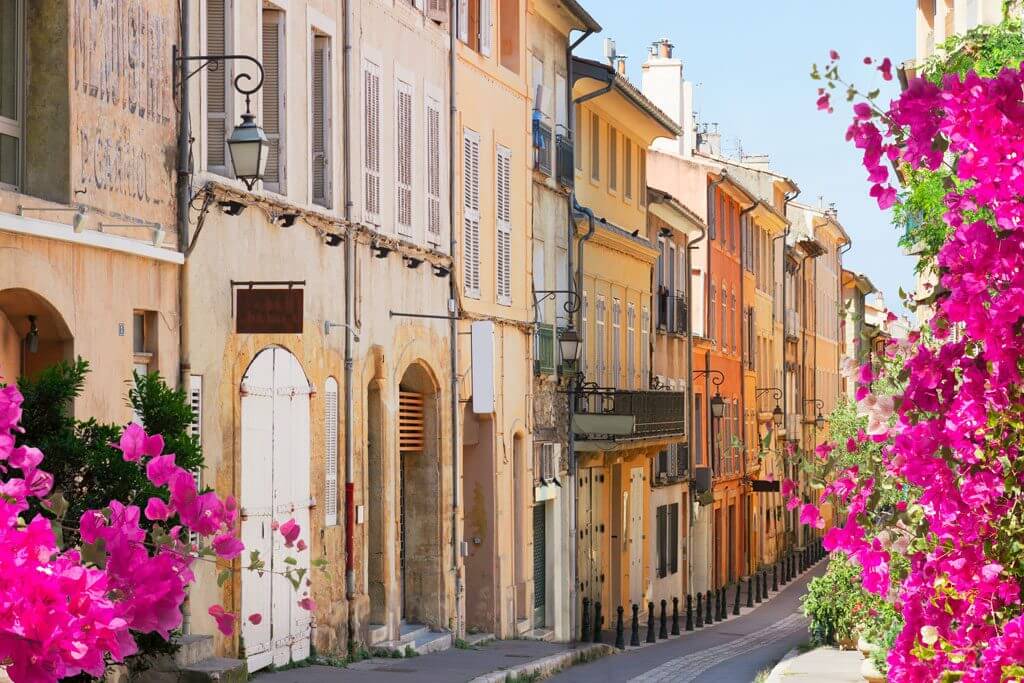
Best Southern France Cities for a Fabulous Getaway
1. marseille.
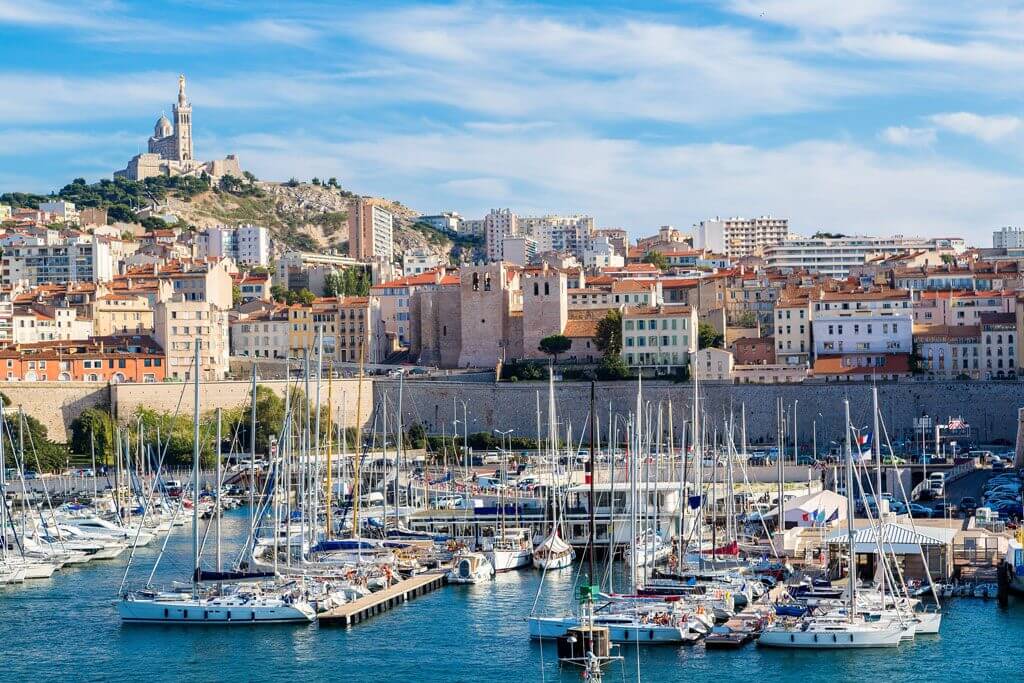
Marseille is a port city and the capital of the Provence-Alpes-Côte d’Azur region. It is situated between Cannes in the east and Montpellier in the west.
This city in Southern France is the oldest in the county, dating back to 600 BC. Its history, charm, and effortless beauty make this a must-see destination. The city’s immigration and trading history has resulted in Marseille becoming a melting pot of European and African cultures. It was even named the European Capital of Culture in 2013!
Marseille is also known for its anise-flavored pastis drink and the delectable bouillabaisse – an authentic fish stew that originated in this port city.
The list of fun things to do in Marseille includes:
- Visit the Basilica of Notre Dame de la Garde
- Explore Marseille’s Old Port
- Get cultured at the MuCEM
- Visit the Cathedral and Fort Saint-Jean
- Explore the Vallon des Auffres
Though you could easily spend most of your vacation exploring the city, there is an array of things to do near Marseille . Marseille is an excellent base to visit the Parc National des Calanques , a breathtaking park overlooking the Mediterranean coast. The coastal towns of Cassis , La Ciotat , and Martigues on the west also make excellent day trips.
Marseille Trip Planning :
- Book your train tickets to Marseille . Check out all the ways to travel to Marseille from Paris, France, and abroad .
- Check out the best hotels in Marseille
- Check out this Marseille 2-day itinerary
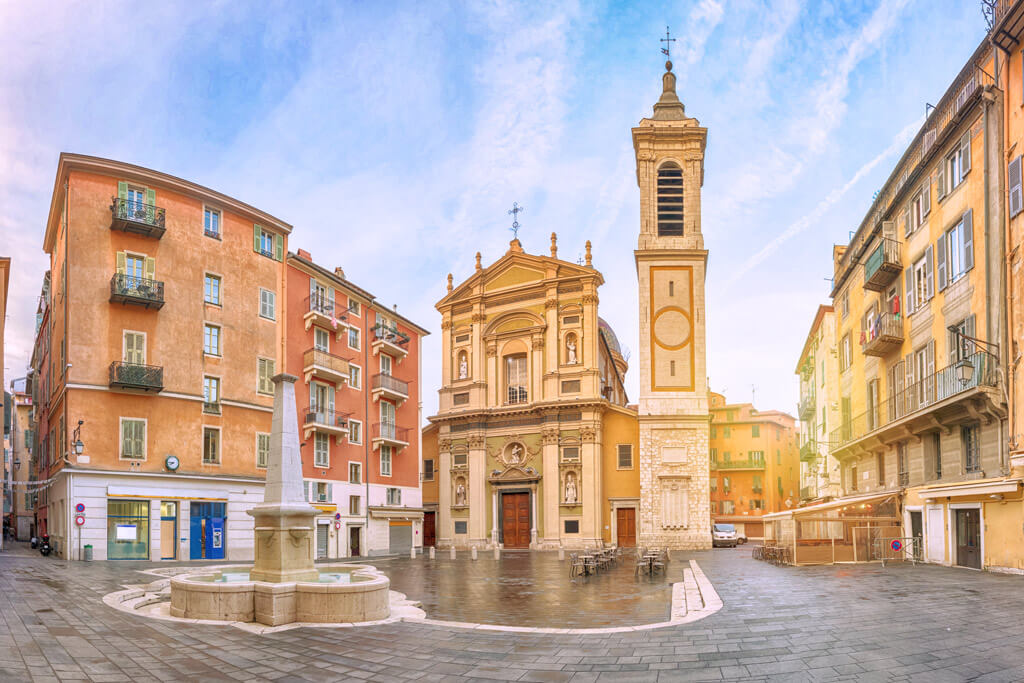
The charming city of Nice is set between the Mediterranean Sea and the Alps and is the capital of the famous French Riviera .
Once the 19th-century retreat location for European elites, Nice still holds much of its sophistication and grandeur. Nice is one of those cities in South of France that’s got it all. You’ll want to visit for its rich history, sophisticated architecture, and incredible year-round weather.
Thanks to its mild temperatures during the coldest months, Nice is also one of the best winter destinations in France . You might even want to plan your city break vacation around The Carnival of Nice in February, a celebration of all things extravagant and comical, or use it as a base to explore the Lemon Festival in Menton .
The list of fun things to do in Nice includes:
- Enjoy the views of the Baie des Anges from the Colline du Château
- Admire Old Town’s baroque architecture
- Stroll around the Old Port
- Visit Cimiez Hill and its museums
- Stroll along the Promenade des Anglais
- Relax and sunbath on one of Nice’s beaches
Of all these South of France cities, Nice is ideally placed to enjoy a variety of day trips or long weekends from the city. In less than 30 km, you can cross over into Italy. It is also close to neighboring Monaco .
Nice Trip Planning :
- Book your train tickets to Nice . Check out all the ways to travel to Nice from Paris, France, and abroad .
- Check out the best Nice hotels and the best hotels in Nice with a pool for the hottest months.
- Check out this Nice 2-day itinerary
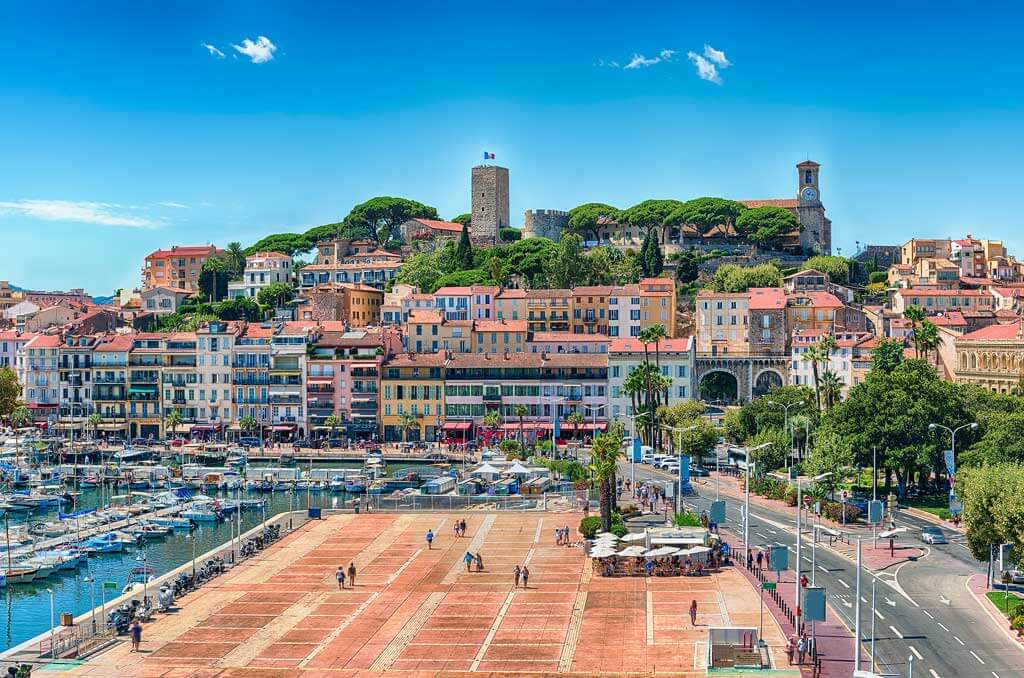
Cannes is one of the most famous cities in the South of France. Cannes is part of the Alpes-Maritimes department and is quintessentially French Riviera.
Of all these South of France cities, Cannes is probably the most well-known. Made famous by the Cannes International Film Festival , this city is a magnet for the rich, famous, and those searching for a good time. It boasts picturesque white sandy beaches, high-end boutiques, and gourmet dining experiences.
The list of fun things to do in Cannes includes:
- Explore Le Suquet, Cannes’ oldest neighborhood
- Take a stroll along the La Croisette walkway
- Visit the Old Port
- Spend a lazy day on the beach
- Visit the Lérins Islands and Cap d’Antibes
- Taste Cannes’ local specialties at Marché Forville
If you can’t decide between these best cities in South of France, then why not stay in one and make a day trip to another? Cannes is an excellent base to visit the equally glitzy Monaco , Antibes , or Nice .
Cannes Trip Planning :
- Book your train tickets to Cannes
- Best hotels in Cannes
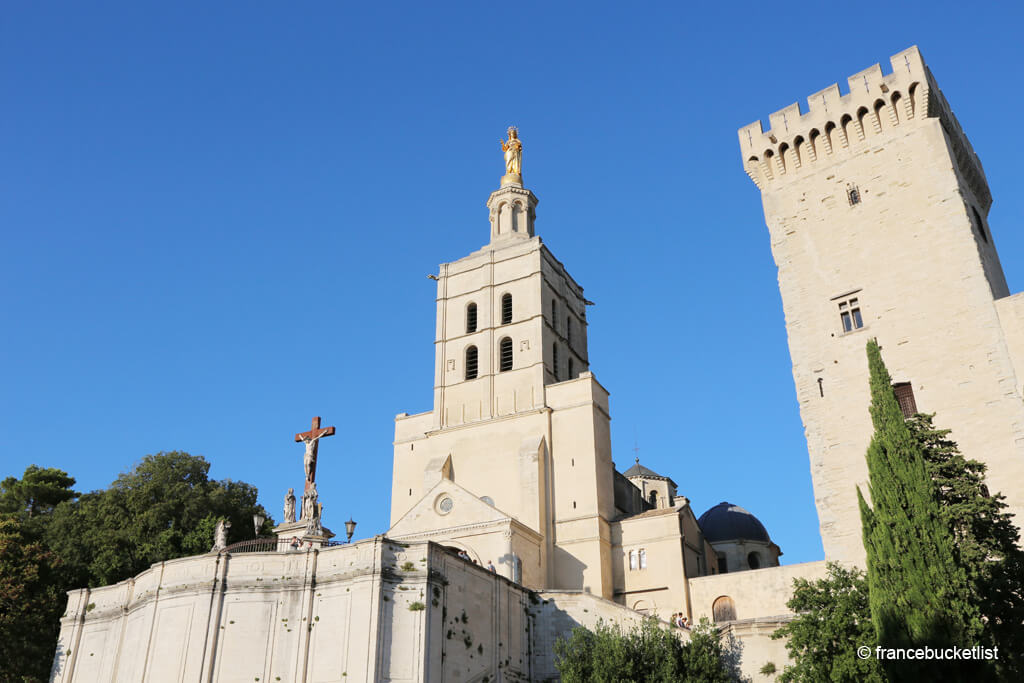
Avignon is located in the region of Provence , Southwest France. Set alongside the Rhône River, Avignon is a real gem.
Avignon is steeped in history, and its cultural attractions are one of the main reasons people visit. Avignon served as the capital of the Catholic Popes between 1309 and 1377, and it was a powerful city in Medival times.
The Palais des Papes , built in Gothic style, is the biggest civil building of its kind and was awarded UNESCO heritage status. Avignon’s Medieval bridge (le Pont d’Avignon ) is a demonstration of both history and architecture and is one of the most popular attractions in the city.
The list of fun things to do in Avignon includes:
- Get lost in the Medieval Town
- Visit the Palais des Papes
- Dance on the Pont d’Avignon (while singing the famous French song)
- Discover the Festival d’Avignon (July), one of the world’s largest performing festivals
Visiting Châteauneuf du Pape is one of the best day trips you can take from Avignon. The town was the summer destination of the Popes, and the whole area is world-known for its excellent wines . Avignon is also a good base for exploring the hilltop villages in Luberon by car – Check out this Luberon road trip itinerary for inspiration.
Avignon Trip Planning :
- Book your train tickets to Avignon
- Best hotels in Avignon
- Check out this Avignon 1-day itinerary
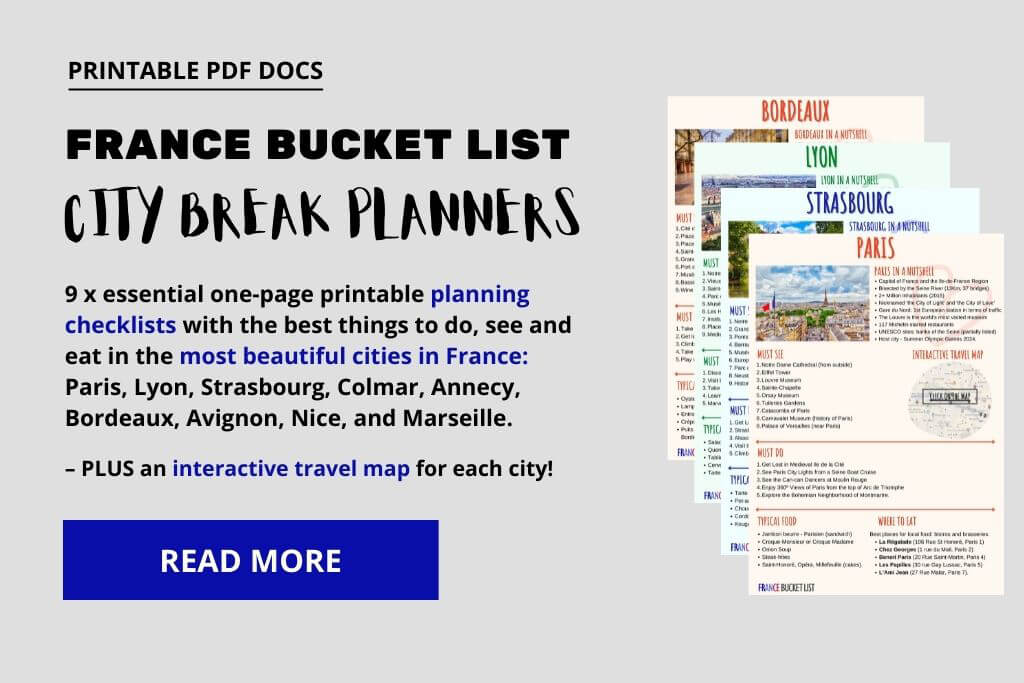
5. Aix-en-Provence
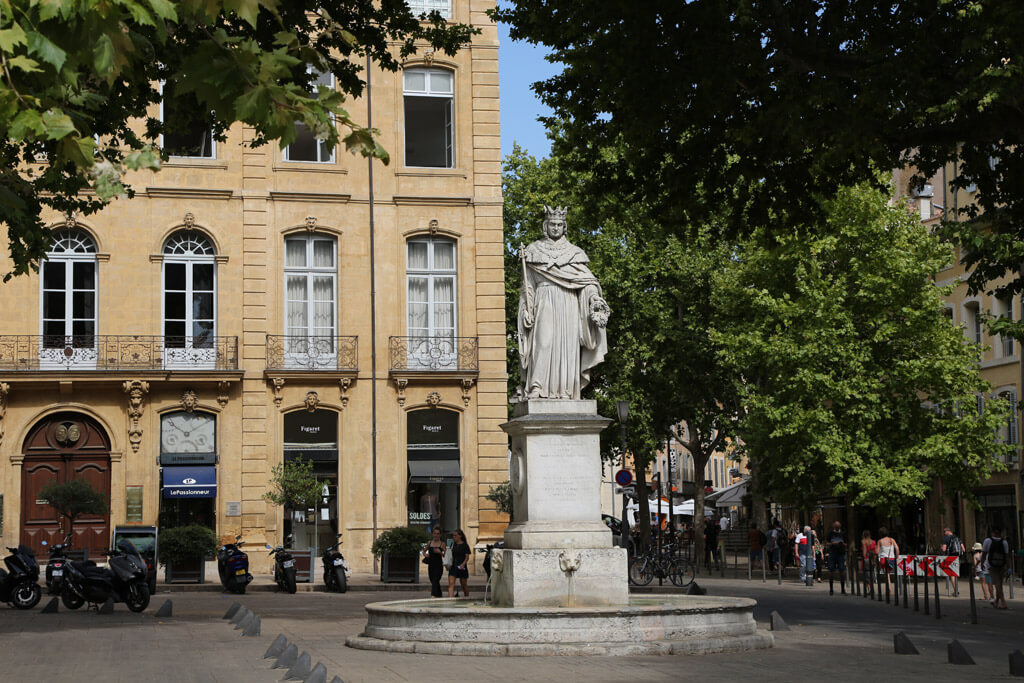
Aix-en-Provence is one of the best cities in the South of France if you’re looking for a cultural yet student atmosphere. This quintessential Provencal city is situated close to Marseille.
Aix-en-Provence is home to an array of eclectic museums, art galleries, and thousand fountains, which come in all shapes and sizes. Stroll along cobbled, winding streets with a pastry in hand, visit its colorful markets , taste delicious Provençal food , and get a characteristically French small-city experience.
The list of fun things to do in Aix-en-Provence includes:
- A stroll through Cours Mirabeau
- Visit Saint-Saveur Cathedral
- Explore the colorful Provencal markets
- Apéritif and people-watching in one of the city’s squares
- Visit the Atélier Cézanne
The spectacular Montagne Sainte-Victoire mountain range was one of Cézanne’s sources of inspiration and is situated just 17km outside the city. It’s well worth the drive out to this limestone mountain ridge on a guided tour by e-bike . Aix is also a usual starting point for exploring the Gorges du Verdon – Check out this Gorges du Verdon road trip itinerary for inspiration.
Aix-en-Provence Trip Planning :
- Book your train tickets to Aix-en-Provence
- Best hotels in Aix-en-Provence
6. Toulouse
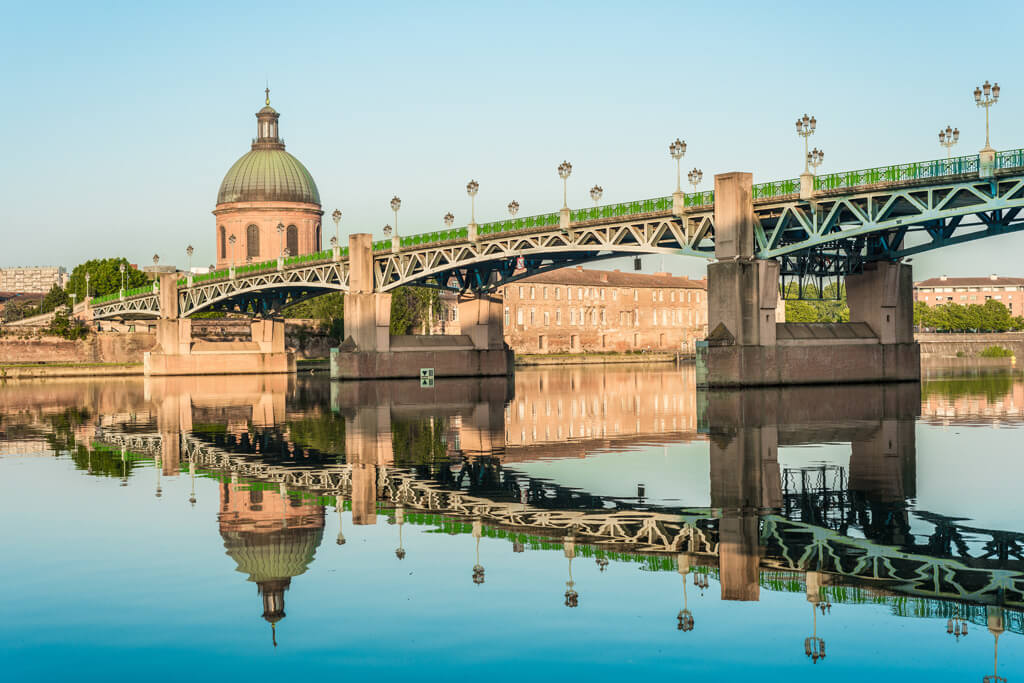
Toulouse is the capital of the Occitanie region, and it is bisected by the Garonne River. Boasting a rich historical heritage and sumptuous monuments, the famous “Pink City” always ranks among the most beautiful cities in France.
Cradle of aviation and space, Toulouse is one of the most advanced technology parks in terms of research. Toulouse also welcomes many students and tourists each year, making the city very lively and an excellent base to explore the region.
The list of fun things to do in Toulouse includes:
- Explore the Old Town with its beautiful Neo-classical architecture
- Visit the Basilica of Saint-Sernin
- Explore La Cité de l’Espace
- Taste the regional food
- Enjoy Toulouse by night, with its lively student atmosphere
You might well arrive in Toulouse and decide you never want to leave. But if you feel like a day trip is calling, there are plenty of places you can go to on day trips from Toulouse . Why not head to the fairytale Cité de Carcassonne ? Just an hour and a half drive from Toulouse, you’ll find one of the best castles in Southern France surrounded by imposing walls with innumerable turrets and towers. The beautiful city of Albi is also very easy to visit from Toulouse by train. You can also combine it with Cordes-sur-Ciel on a fun-packed day tour from Toulouse .
Toulouse Trip Planning :
- Book your train tickets to Toulouse . Check out all the ways to travel to Toulouse from Paris, France, and abroad .
- Check out the best hotels in Toulouse
7. Montpellier
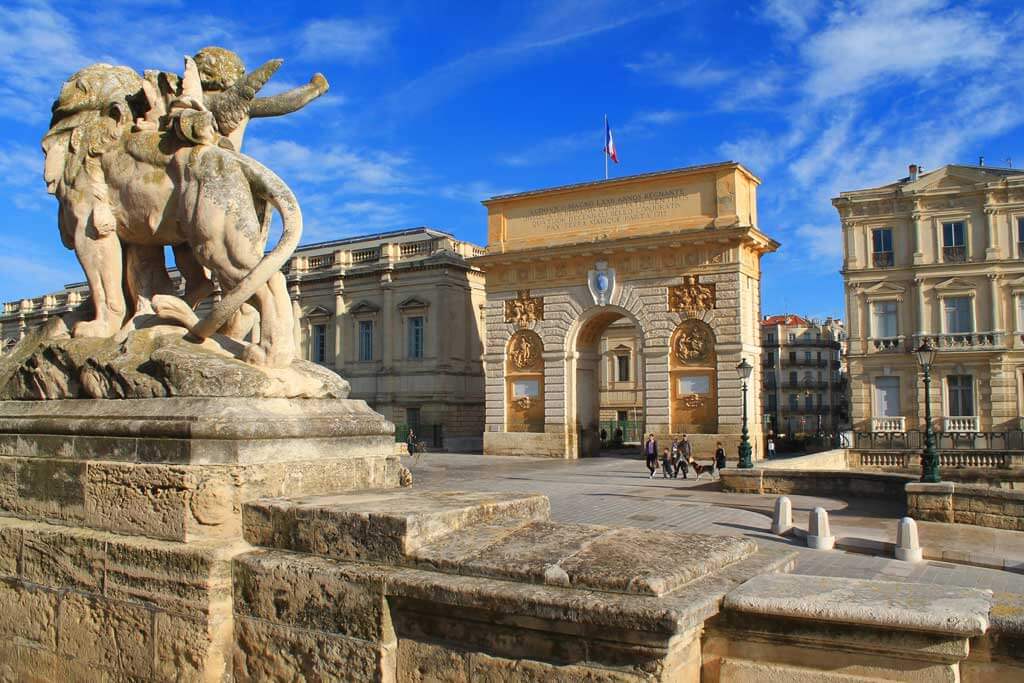
Another of the best cities South of France has to offer is Montpellier . It’s just 10km from the Mediterranean Sea and is characterful and has a variety of activities to enjoy.
Wander around the impressive old quarter full of chic boutiques and impressive private mansions. There are several museums to enjoy, including the Fabre Museum. The Montpellier Cathedral and the Promenade de Peyrou have become iconic landmarks in Montpellier.
The list of fun things to do in Montpellier includes:
- Visit l’Ecusson (Montpellier’s historical neighborhood)
- Visit Saint-Pierre Cathedral
- Explore Le Jardin des Plantes
- Enjoy magnificent mountain and sea views from the Promenade Peyrou
- Visit the Musée Fabre (Arts)
- Enjoy Montpellier by night, and its lively student atmosphere
Montpellier acts as an ideal base to explore other places throughout the Occitanie region. From this South of France city, you can visit the Camargue, Nîmes , and Béziers .
Montpellier Trip Planning :
- Book your train tickets to Montpellier
- Best hotels in Montpellier
8. Perpignan (Perpinyà)
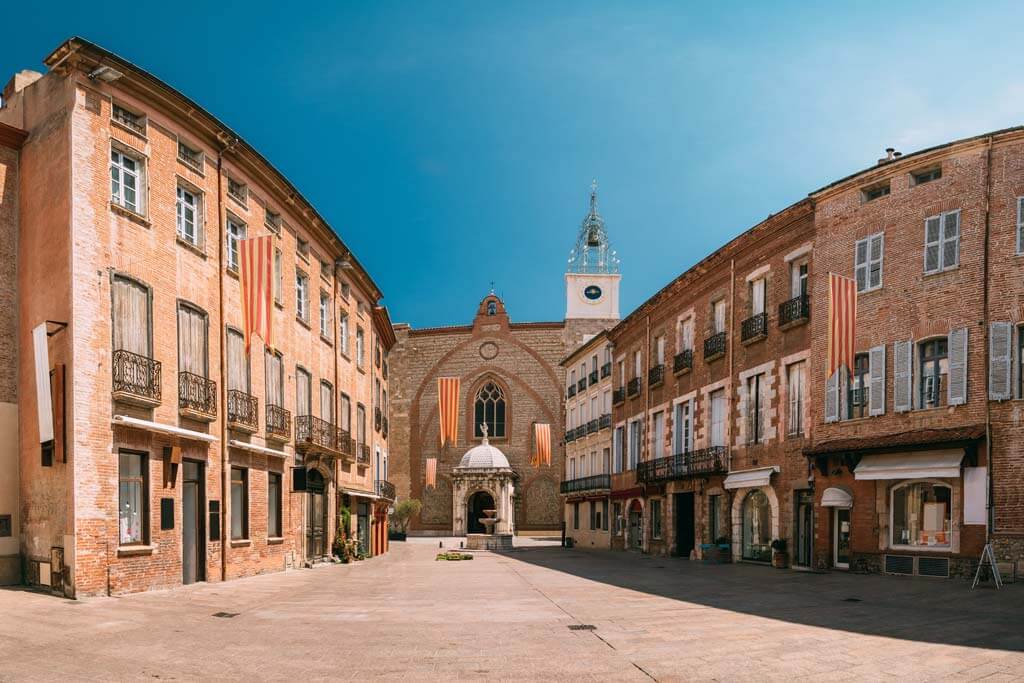
Perpignan is perhaps one of the lesser-known southern France cities on this list. The capital of Northern Catalonia, Perpignan is ideally located between the Mediterranean coast and the Pyrénées.
Believe it or not, this city of Southern France was a European powerhouse during Medieval times, the capital of the county of Rosselló (Rousillon) and the Kingdom of Mallorca. The castle that dominates the city belonged to the Kings of Mallorca.
Perpignan became part of France only in the 15th century when King John II of Catalonia and Aragon ceded the counties of Rosselló and Cerdanya to the French King Louis XI in exchange for military aid to deal with the Catalan Civil War.
Head to the Old Quarter to get a taste of Perpignan’s rich history and unique architecture. Its top sights, delectable food, and atmosphere are what attract travelers to this smaller French city.
The list of fun things to do in Perpignan includes:
- Visit the Citadel and the Historial Center
- Visit Le Castillet and La Loge de Mer
- Explore the Castle of the Kings of Mallorca
- Take a boat tour
Being located so close to the Catalan border, take a drive down to Girona for sightseeing or the Costa Brava to enjoy the Mediterranean Sea and the gorgeous views. If you prefer to remain in France, the monasteries of Sant Martí del Canigó and Sant Miquel de Cuixà are two jewels of Catalan Romanesque architecture.
Perpignan Trip Planning :
- Book your train tickets to Perpignan
- Best hotels in Perpignan
9. Narbonne
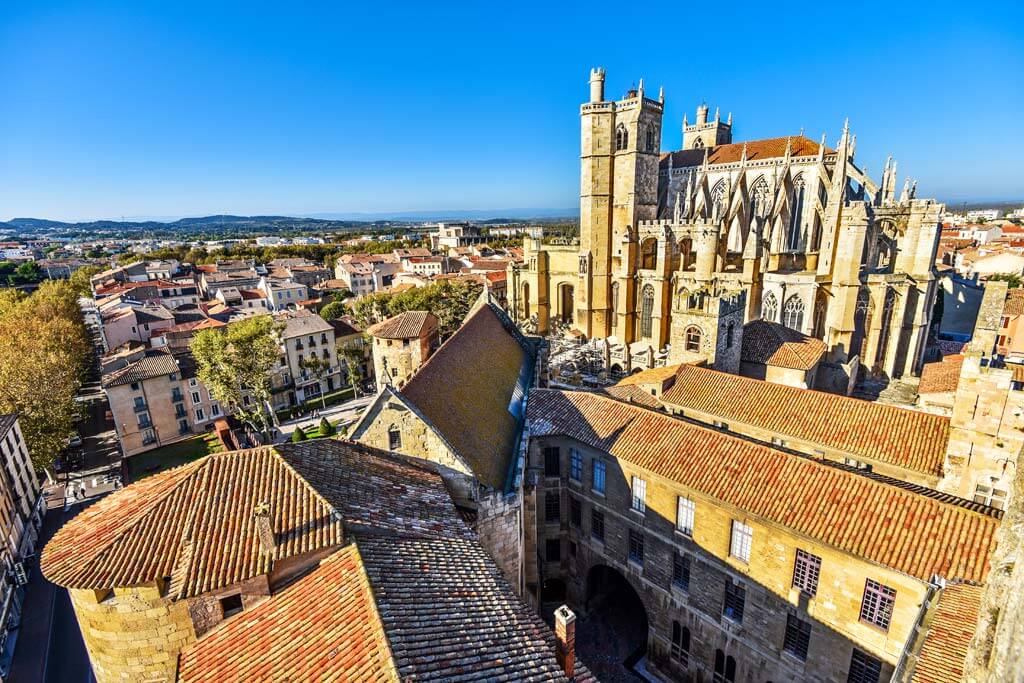
In the Occitanie region, Narbonne is located at the crossroads of the Mediterranean Sea, the Corbières, and the Pyrénées, so it is the ideal destination for your French holiday. With a rich environment and historical heritage, this South of France city is a fascinating, pleasant, and attractive city where all (or almost) activities are possible!
Narbonne is a touristy city thanks to its 5 km of thin sand at Narbonne-Plage. It is also a city with a rich history that goes back to Roman times (118 BC). The Canal de la Robine is one of France’s oldest canals, and it separates the Historical Center and the Cité district in central Narbonne. Here, you will see vestiges of Antiquity, the Middle Ages, the Renaissance, and Narbonne’s Age of Gold at the end of the 19th century.
The list of interesting things to visit in Narbonne includes:
- Stroll around the Old Town
- Visit the Cathédrale Saint-Just-et-Saint-Pasteur
- Visit the Archaeological Museum of Narbonne
- Visit the Musée Lapidaire de Narbonne
- Explore the Musée Roman Horréum (ancient Roman galleries)
- Beach day at Narbonne-Plage
- Sail the Canal de la Robine on an electric boat (no boating license required).
Narbonne Trip Planning :
- Book your train tickets to Narbonne
- Best hotels in Narbonne
And there you have it, the list of the best cities in Southern France for every kind of traveler. Which South of France cities tempt you most?
Back to Homepage
Disclaimer: This article may contain compensated links, meaning we get a small commission if you make a purchase through our links. It costs you nothing more (in fact, if anything, you’ll get a nice discount) but helps us to go on creating incredible French content for you. We trust all products and brands promoted here and would never recommend anything that isn’t of value. Please read disclaimer for more info.
(C) Copyright 2019 - 2024 France Bucket List. All Rights Reserved. Designed & Developed by France Bucket List || Disclaimer || Privacy Policy || Contact |
Top 10 Places To Visit In The South Of France
The South of France is an entirely different landscape, full of lavender fields, majestic mountainside villages, and tranquil countrysides.
France is a beautiful country. The more time someone spends exploring, the more they understand that they can spend a lifetime there, with still more to explore ! Few areas in Europe provide a more remarkable vacation experience than France's bright, glamorous, and breathtakingly beautiful south, and a trip to this beautiful area is a pleasure for all the senses. The South of France provides everything an adventurous wanderer might want, from the countryside to the shore. Here are the best places to visit in the South of France to know more.
This little fishing village would undoubtedly enhance any vacation in Southern France. Tourists may enjoy the Calanques located in the area, which are little coves accessible by foot or boats. Cap Canaille, a beachside cliff with spectacular views of the vineyard and the Gulf of Cassis, is also located. Tourists shouldn't leave without trying some bouillabaisse; it is the region's signature dish, and the inhabitants take it very seriously. Cassis also has a delightful local market where people enjoy visiting the vendors and purchasing chocolates and other delicious delicacies.
RELATED: Check Out These Hidden Gems In Paris The Next Time You’re In France
9 Montpellier
Tourists looking for style should head to Montpellier. From pristine beaches to private homes, this beautiful town in the South of France has it all. Art enthusiasts should visit the Musee Fabre, an excellent museum that displays old master paintings, current art, and installation elements. The Montpellier Parc Zoologique, France's second-biggest zoo, is also located in the neighborhood. Furthermore, Montpellier exudes a trendy and youthful vitality because of the university student population.
Arles is a beautiful French town that is a UNESCO World Heritage Site due to its richness of Romanesque style architecture. Since Julius Caesar established it, it has been an important cultural center and trade harbor. Every shift of a tourist's gaze is always a picture-perfect scene. It thus illustrates why Vincent van Gogh lived here for several years. As a result, this city with such a rich and influential tradition is a fantastic destination to explore.
7 Saint-Tropez: Its Village And Beaches
Saint-Tropez is a small fishing resort famed for its picturesque town and stunning beaches. This enticing seaside resort persuades travelers with its attractive port and quaint medieval town center. Tourists may also trek the Sentier du Littoral, a beachfront route with breathtaking countryside views. In addition to its vintage appeal and beautiful landscape, Saint-Tropez has a multitude of recreational and cultural sites. Furthermore, visitors should spend time around the Place des Lices to absorb the atmosphere of Saint-Tropez.
RELATED: Ski-On!: France Is Home To The Longest Ski Run In The World
6 Medieval Town Of Carcassonne
Carcassonne offers visitors the sensation that they have stepped into a scene from a fairy tale. Enormous walls encircle this magnificently maintained walled medieval town. Viollet-Le-Duc renovated sections of the medieval walls and turreted towers in the 19th century, giving it a Disneyland-like feel. While visiting this place, visitors may picture what lifestyle was like in a typical Middle Ages village by wandering Carcassonne's tiny passageways and cobblestone streets. Carcassonne is a town in the South of France that tourists would love to visit.
The old feudal legacy of the Gascony Region in Southwest France contributes to its peculiar character. Farmlands cover the rolling terrain in a multicolored patchwork, while hilltops are studded with majestic fortresses, walled medieval cities, and tranquil rural villages. La Bastide in the land of the Gascony enables visitors to enjoy the leisure and healing of a peaceful getaway. This beautiful hotel has exquisite yet straightforward guest rooms, a good restaurant, a sauna, a swimming pool, a courtyard, and bikes to explore a nearby picturesque path.
Avignon is a town immersed in ancient religious history and boasts the gorgeous architecture that one would expect from such a location. Avignon is most renowned for the Palais des Papes, Europe's most enormous Medieval palace. The palace also hosts art galleries, conferences, and celebrations. Outside, hilltop meadows, ponds, and groomed terraces are welcome. The Musée Angladon, which houses the only Van Gogh artwork in Provence, is well worth visiting.
RELATED: Indulge In The Best Coffee & Pastries At These Cafés In France
Most people who think of the South of France think about Nice. It is a magnificent city with long esplanades and large parks. It is also the fifth-largest city in France; therefore, visitors will not be weary for a single moment in this city. Tourists should visit Nice for something like the beach, the magnificent medieval town center, and some reasonably delectable French cuisine. Essentially, if travelers seek a calm and sufficiently lavish trip in the South of France, they should go to Nice.
2 Rocamadour
Rocamadour, a cliff-top town in southern France, is well-known for the Cite Religieuse, a renowned religious site. The village is situated above the Dordogne River and offers breathtaking natural views. Among the religious structures is the Chapelle Notre Dame, which features a remarkable Black Madonna monument. The neighboring Gouffre de Padirac, a magnificent tunnel that tourists can tour on foot and by boat, is especially popular with visitors. It is, in fact, France's most famous underground tourism destination.
1 Verdon Gorges
Verdon Gorges is one of the most tourist hotspots in the South of France. The Verdon Gorge is a massive calcareous rocky canyon that surprises people worldwide. This cliff is located in the center of a natural reserve with vegetation and animals. Boating, skydiving, canoeing, bike riding, and horse riding are just a few of the sports accessible in the Verdon Gorge area. Furthermore, this spectacular 700-meter-deep river canyon provides a wide array of leisure activities.
NEXT: France Vs. Tuvalu: The World's Most And Least Touristic Countries
Protect Your Trip »
Best places to visit in france.
France is home to some of the most lively cities, bucolic villages and renowned wine regions on the globe. U.S. News considered factors like variety of attractions, lodging, weather and culinary scenes to create this ranking of the best places to visit in France. Whether you're seeking an action-packed sightseeing adventure or a relaxing wine retreat, you'll find a fun French vacation here. To influence next year's ranking, vote below for your favorite destinations in France.
Mont Saint-Michel
Montpellier, french alps, chamonix-mont-blanc, aix-en-provence, loire valley.

As the world's best place to visit , it's no surprise that the electrifying City of Light tops this list. France's capital city is a year-round tourist destination with iconic attractions like the Louvre and the Eiffel Tower and incredible architecture (think: the dazzling Basilique du Sacré-Coeur). Not to mention, Paris offers unparalleled dining and shopping scenes and more museums than you could hope to visit in one trip. Keep in mind, Paris is often flooded with tourists and room rates can be pricey. If you're looking for a deal, travel in winter or early spring.

The capital of the Alsace region offers the perfect mix of French and German culture thanks to its location on the France-Germany border. While here, travelers should see Strasbourg's Gothic-style cathedral and stroll through the UNESCO World Heritage-listed Petite France quarter with its half-timbered houses and postcard-worthy waterways. Plus, those with an interest in politics can tour several important European institutions during their visit, including the European Parliament and the Council of Europe. For an extra dose of charm, arrive in December to see one of Europe's oldest Christmas markets.

Rising above the sea like a castle in a fairy tale, Mont Saint-Michel in Normandy is one of France's most-visited sights. Legend says the archangel Michael, the island's namesake, repeatedly appeared to Bishop Aubert of Avranches in dreams, telling him to build a church on top of the island in A.D. 708. Since its completion, it has become an important pilgrimage site for Christians and European intellectuals. Visitors can tour the picturesque abbey and admire its incredible medieval architecture or wander its surrounding streets, which are lined with tiny shops and quaint cafes.

Dubbed La Ville Rose due to the prominence of distinctive clay bricks in its architecture, Toulouse is a feast for the eyes. Throughout this city, which is located in the South of France, you'll find marvels like the neoclassical Le Capitole on the main square, the stately Basilica of Saint-Sernin (an 11th-century UNESCO site) and the Hôtel d’Assézat, which houses a noteworthy art gallery. What's more, several canals with shady footpaths pass through the city, including the idyllic Canal du Midi. For some of the best views of Toulouse, take a cruise on the River Garonne, or just sunbathe on its banks.

Sunny Montpellier glows with a combination of old world charm and a trendy university lifestyle. This city in the south of France evokes Parisian appeal with Haussmann architecture and stylish promenades. And like Paris, adornment is everywhere in Montpellier, from fashionable boutiques to street art to France's oldest botanical garden. Plus, since Montpellier is located 7 miles from the coast of the Mediterranean, a beach break is close at hand. Once the sun sets, take part in the city's youthful nightlife scene, which includes everything from music halls to dance clubs.

It's easy to see why Colmar, located in the heart of Alsace's wine region, is considered one of France's most beautiful cities. Colorful houses that look as if they belong in a fairy tale line the Little Venice district, where you can take a boat tour through Colmar's canals or reach boutiques and eateries on foot. The setting is picturesque regardless of when you vacation here, but for even more charm, visit Colmar at night when lights illuminate the city during annual events like the Colmar International Festival, Alsace's wine fair and Colmar's Christmas market.

To see some of France's most spectacular art and architecture, head to Avignon. This city in southeastern France is full of stunning structures, including the 14th-century Palais des Papes, the largest Gothic palace in the world, and the arched bridge, Pont d'Avignon. A number of can't-miss museums are spread throughout Avignon as well, such as the Musée Angladon, which houses works by highly regarded artists like Edgar Degas, Pablo Picasso and Vincent Van Gogh. Visit in July to attend the Festival d'Avignon, one of the world's largest performing arts festivals.

If your ideal French vacation involves a little more nature and a little less city, head to the French Alps . Here, you'll find some of the best ski slopes in Europe, as well as beautiful scenery that rivals any work of art or architecture. In summer, the typically snow-covered mountains thaw just enough to create perfect conditions for hiking and biking. Enchanting villages sit at the base of the range, offering several places to unwind when you've had enough fun on the slopes or trails.

Despite its war-filled past, this region in northern France is also a place of great beauty and culture. Étretat's white cliffs are a great place to take in the area's natural scenery. Then, visit the region's capital city, Rouen, to admire works of art at the Musée des Beaux-Arts and stroll past the quaint half-timbered houses. Be sure to sample some of the city's culinary specialties to see why it is now a UNESCO City of Gastronomy. Or, see some of the remnants of Normandy's heavy history at the D-Day Landing Beaches and The Bayeux Tapestry.

Glamorous Nice occupies a picturesque spot along the French Riviera. Beach bums and culture hounds alike will enjoy the city's pebbly shores, engaging museums, boutique shops and Baroque-style palaces. Be sure to stroll along the coastline's Promenade des Anglais and pick up some fresh flowers and produce at the vibrant Cours Saleya market, located in old town. You'll likely spend a pretty penny on lodging and beach access, but experiencing Nice is worth it. To save some coin, travel between mid-March and April or from September to October, the area's shoulder seasons.

Often called "France's Isle of Beauty," Corsica features diverse landscapes and a unique culture that make it seem like a miniature continent. The Mediterranean island's clear blue water and white sand beaches are ideal for sunbathing, snorkeling and kayaking, while its mountainous terrain and dense forests provide ample opportunities to hike trails like the highly regarded (albeit challenging) GR20. Those looking to take in some history can visit the Maison Bonaparte museum to see Napoleon's birthplace. What's more, Corsica offers a one-of-a-kind food scene that showcases various local delicacies, such as lonzu (dry-cured ham) and brocciu (cheese).

While it may not be as well known as big-name cities like Paris, Lyon competes with the best of them. Despite being the third-largest city in France, Lyon is much calmer and less touristy than other similarly sized destinations. The streets are filled with public art, including the city's famous trompe l'oeil murals, and there are museums that focus on everything from movies to history. Plus, it's surrounded by hundreds of wineries and home to 4,000-plus restaurants, several of which boast Michelin stars, making it especially appealing to oenophiles and foodies.

If you love to ski, chances are you'll enjoy shredding powder at Mont Blanc, the highest mountain in Europe. In the bustling Chamonix (the main place to stay if you want to ski at Mont Blanc), you'll have easy access to the longest off-piste run in the world (Vallée Blanche) and rugged, challenging slopes. But this destination, which hosted the 1924 Winter Olympics, offers more than just top-notch skiing. Chamonix is also a great place to go hiking, mountain biking and whitewater rafting. For some family-friendly fun, visit the town's adventure park to zip down its Alpine coaster and various slides.

Quaint, charming Aix-en-Provence is a university city known for its tree-lined boulevards, cute cafes and lively markets. Life moves at a more leisurely pace here than in other French cities, meaning it's the perfect place for travelers to get lost in the scenic streets. Make sure to add Cathédrale Saint-Sauveur and Le Grand Marché – two of the city's top attractions – to your itinerary. You can also see where artist Paul Cézanne (an Aix-en-Provence native) painted some of his masterpieces at Atelier de Cezanne, or venture outside of the city to see the Provencal scenes that inspired him.

Vincent Van Gogh fans may recognize the streetscapes of Arles: This small city in Provence inspired some of the artist's best-known works with its bright colors and rustic feel. Art aficionados can walk in Van Gogh's footsteps and explore his favorite haunts on a walking tour through this romantic city or visit the Fondation Vincent Van Gogh Arles. Beyond this noteworthy connection, Arles is renowned for its Roman ruins, including a two-tiered amphitheater, the Alyscamps necropolis and the Constantine Baths. And as the gateway to the Camargue region, Arles is a great base for visitors looking to explore this marshy, flamingo-filled area.

Another popular wine region, Burgundy is home to rolling hills, superior cuisine and an array of vineyards. Those visiting Burgundy must spend time exploring the medieval villages, historical abbeys and museums that call this area home. Dijon, the region's history-rich capital, makes a great home base for touring the area. And, of course, you can't leave without trying the region's wine, which mainly uses the pinot noir and chardonnay grapes, and dining on some of its rich cuisine.

Northwestern France's Brittany region stands out from the rest of the country in more ways than one. Locals are proud and protective of their Celtic heritage, including their unique language, traditions and festivals. As a result, visitors will find many well-preserved historical sites throughout the area, including prehistoric megaliths and medieval towns like Saint-Malo, a popular port town with a 12th-century citadel. Brittany also features breathtaking coastlines with fantastic beaches that are known for their phenomenal waves for surfing, dive spots and dolphin-spotting opportunities.

As the capital of France's Champagne region, Reims is a must-visit destination for both history buffs and those who love bubbly. The city offers many Champagne cellars where visitors can learn about how the popular wine is produced before tasting it. Additionally, Reims features breathtaking Gothic architecture at attractions like the Cathedral of Notre-Dame at Reims, where 25 French monarchs were crowned between 1223 and 1825, and the adjacent Palace of Tau, the former residence of France's archbishops. No visit would be complete without perusing the exhibits in one of Reims' museums, which cover a range of topics from war history to art and automobiles.

The gateway to the Loire Valley, Tours is perfectly situated for touring the region's wineries. But with Tours' historical elements and prime location along the Loire River, you may just want to stay in town. Place Plumereau, a medieval marketplace that remains one of the city's oldest squares, exudes irresistible charm with half-timbered houses, while churches like the Saint-Gatien Cathedral stun with their stately façades. Visitors will also have their pick of green spaces, from parks like Prébendes d’Oé Garden to riverside guinguettes (open-air cafes) at Tours sur Loire. What's more, several of the region's famed châteaux (including the Château de Villandry) sit just outside the city.

For a romantic escape, visit the Loire Valley in central France. Situated along the Loire River, the area is peppered with châteaux, bed-and-breakfast accommodations, farms and wineries renowned for their sauvignon blanc. The region itself is even a designated UNESCO World Heritage Site because of its beauty and historical villages. Plan to spend some time in a few of the valley's laid-back cities and towns, such as Orléans and Saumur, and you can't miss the emblematic Château de Chambord.

This wine-producing hub woos travelers with its riverbank location and surrounding countryside. With nearly 300,000 acres of vineyards, Bordeaux offers ample choices for those looking to sip some of the best (typically bold red) wines in the world. In the city center, marvel at the Gothic-style Basilique Saint Michel, walk across the Pont de Pierre (a beautiful stone bridge), snap a photo of the iconic Place de la Bourse and enjoy the Jardin Public's pathways and flora.

Located on the French Riviera just 8 miles from Nice, the tiny hilltop village of Èze makes for an excellent daytrip. The best way to spend your time in this medieval town is meandering through its cobbled streets that look as though they've been pulled from a postcard. In doing so, you'll find picturesque views of the coast, as well as luxury hotels and shops from another era. Top sights include the Notre-Dame-de-l'Assomption and Jardin Exotique d'Èze, as well as the walking path of Nietzsche, who was inspired to write here. Before leaving town, stop by the Fragonard Parfumeur factory for a fragrant tour.

Located 35 miles northeast of Montpellier, Nîmes delights history buffs with some of the world's best-preserved Roman treasures like its emblematic arena and La Maison Carrée, a temple dating back to 10 B.C. Museums throughout Nîmes also cover its past. But lest you get the wrong impression, Nîmes is anything but stuffy. The city embraces the joie de vivre of the South of France with countless festivals, from structured events like the concert lineups of the Festival de Nîmes to lively Ferias de Nîmes – multi-day celebrations that occur twice a year at Pentecost and in September, and center around bullfighting, dancing and music.

France's oldest and second-largest city has become an exciting, up-and-coming tourist destination. Marseille has a number of sights to see, including the Basilique Notre-Dame de la Garde and Château d'If, the ominous prison made famous by Alexandre Dumas' "The Count of Monte Cristo." When the weather is nice, the rocky cliffs and secluded beaches of the Calanques are excellent for swimming, boating and hiking. No trip to Marseille would be complete without a stop by the Mucem, a museum dedicated to Mediterranean civilization. Plus, its rooftop terrace makes the perfect vantage point to admire the city.

Famous for its annual film festival in May, Cannes is just as impressive (and much less congested) other times of the year. Cannes is another French Riviera hot spot that welcomes travelers looking for a little relaxation (think: sun-soaked beaches and meandering walks through the steep streets of Le Suquet, one of the city's oldest neighborhoods). Visitors can sightsee as they stroll along La Croisette, a 2-mile-long promenade, or sit down for an exquisite meal at a Michelin-starred restaurant. Feeling lucky? Stop by one of Cannes' casinos.
Vote to Add these Destinations to the Rankings

Carcassonne

Cirque de Gavarnie

You May Be Interested In

Best Places to Visit in Europe for 2023-2024

Best Places to Visit in Spain

Best Cheap European Vacations for 2023-2024

Best Family Vacations in Europe

Best Beaches in France

Best Beaches in Italy
If you make a purchase from our site, we may earn a commission. This does not affect the quality or independence of our editorial content.
Recommended
The 18 Best Napa Valley Wineries to Visit in 2024
Lyn Mettler|Sharael Kolberg April 23, 2024

The 25 Best Beaches on the East Coast for 2024
Timothy J. Forster|Sharael Kolberg April 19, 2024

The 50 Best Hotels in the USA 2024
Christina Maggitas February 6, 2024

The 32 Most Famous Landmarks in the World
Gwen Pratesi|Timothy J. Forster February 1, 2024

9 Top All-Inclusive Resorts in Florida for 2024
Gwen Pratesi|Amanda Norcross January 5, 2024

24 Top All-Inclusive Resorts in the U.S. for 2024
Erin Evans January 4, 2024

26 Top Adults-Only All-Inclusive Resorts for 2024
Zach Watson December 28, 2023

Solo Vacations: The 36 Best Places to Travel Alone in 2024
Lyn Mettler|Erin Vasta December 22, 2023

26 Cheap Beach Vacations for Travelers on a Budget
Kyle McCarthy|Sharael Kolberg December 4, 2023

The 50 Most Beautiful White Sand Beaches in the World
Holly Johnson December 1, 2023


Touropia Travel Experts
Discover the World
29 Top Tourist Attractions in France

When the mind ponders a trip to France, Paris quickly makes an appearance. Its storied streets are the very definition of romanticism. But beyond the Notre Dame, the Eiffel Tower and the Champs-Élysées is a sprawling country with the rugged Normandy coast on one side and the French Riviera on the other.
Day trips from Paris to Champagne and Versailles are easy to add to the list of things to do in France. But one needs to make use of the country’s efficient (and fun) train network to venture beyond to such memorable towns as Strasbourg, Lyon, Cannes, and St. Tropez.
Beyond glamour, the turquoise Mediterranean and ancient old towns, the French Alps harbor spectacular scenery where skiing, hiking, and climbing come to the fore.
But perhaps the biggest tourist attractions in France are found among its rich culture with food and wines that are among the most celebrated in the world.
29. Chateau de Chenonceau
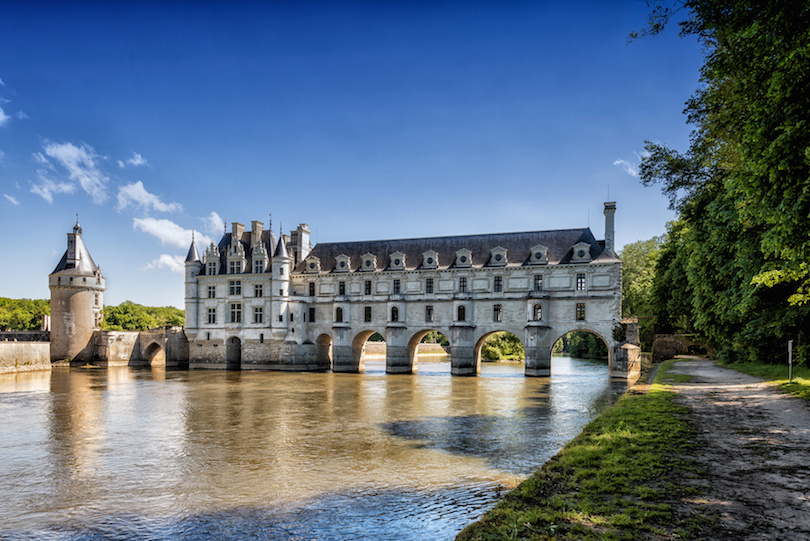
The Loire Valley is home to countless spectacular castles. At the top of your list should be the Chateau de Chenonceau. Dating back to the early 1500s, the castle has seen multiple iterations, each an improvement on the last.
Over time, the bridge spanning the Cher grows in length. But as it crosses the water, the arch bridge becomes the pillar that holds up an expanded castle. Showcasing a mix of Gothic and Renaissance architecture, the Chateau de Chenonceau reflects off the water below, offering brilliant photography.
Travelers can make their way into the castle where they’ll find the ornate chapel, the King Louis XIV Drawing Room, and bedrooms fixed with period furniture. Beyond the castle are expansive gardens that stretch into the French countryside.
28. Le Puy-en-Velay
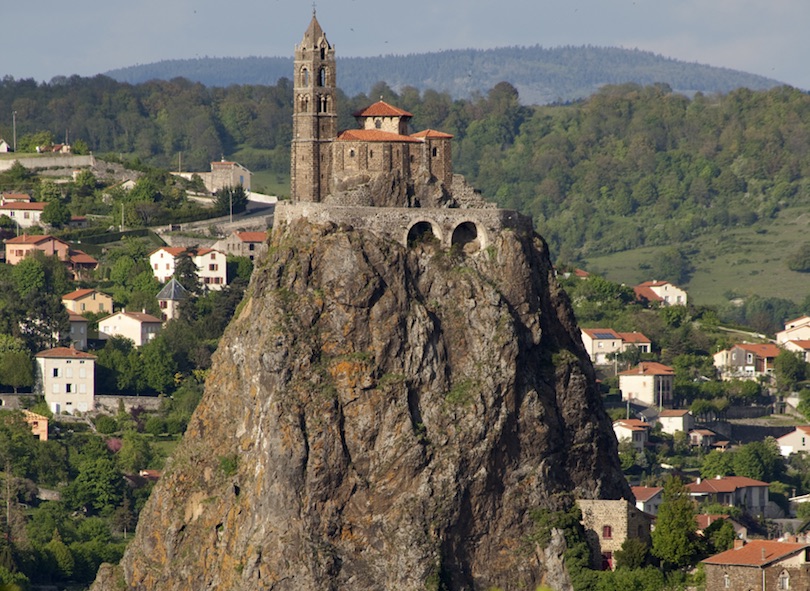
Thousands of years ago, volcanic eruptions carved the landscapes surrounding Le Puy-en-Velay. Today, dormant volcanoes and basalt spires are within constant sight. Yet, perhaps what brings Le Puy the most notoriety is its position along the Camino de Santiago.
For many, the 800km journey along the Way of St. James begins right here. The town has a storied connection to the pilgrimage and religion. One of the first sights you’ll see as you make your way into Le Puy-en-Velay is Our Lady of France statue which showcases the Virgin Mary. It’s almost 23 meters tall.
Beyond the Camino, visitors can experience the town’s traditional lacemaking industry.
27. Epernay Champagne
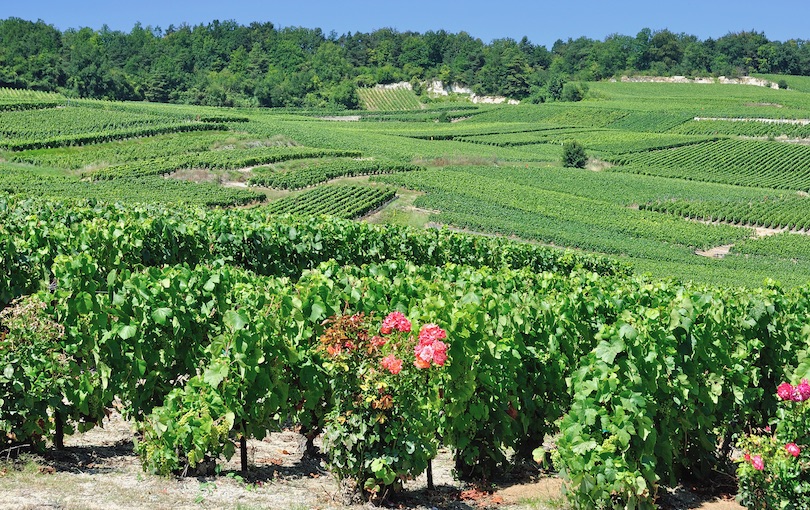
Alongside Reims, Epernay is the best town to visit in Champagne to experience the local delicacy. A simple day trip from Paris , Epernay, is a wonderful place to sample a wide range of world class champagne. After all, if it’s not from around here, then it isn’t really champagne.
Surrounded by rolling green hills, Epernay is the home of the famous Moet & Chandon. Arguably the world’s most sampled champagne, Moet & Chandon offer a range of tours where you can wander through the cellars and try their beloved drink within a sightly tasting room.
After visiting a range of other champagne houses, make your way to Hautvillers, where you can enjoy expansive views across multiple vineyards.
26. Cannes Film Festival
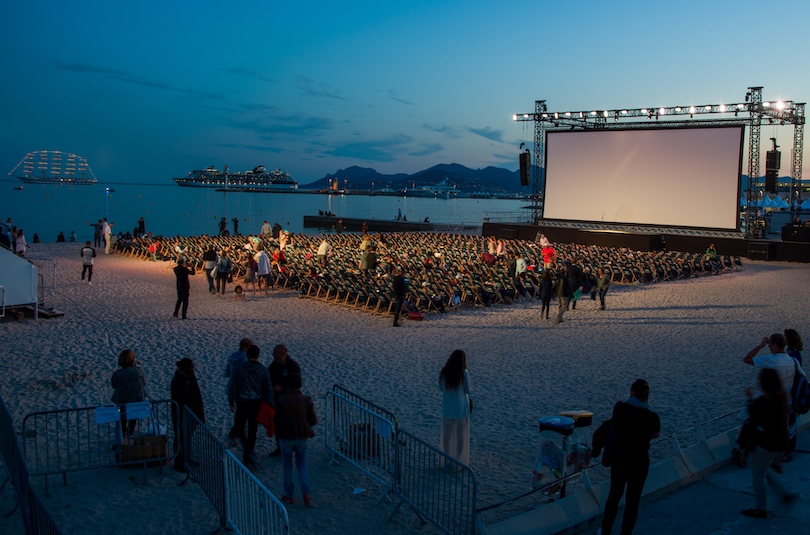
Along the Cote d’Azur, Cannes is lined with high-end hotels, glamorous boutiques, fine dining and plenty of sunshine. At the center of its fame is the Cannes Film Festival, which attracts the biggest movie stars from across the globe.
Although Cannes is a year-round destination with plenty of things to do, the film festival is one to mark on your calendar. Held in May, it’s a chaotic yet rewarding time to visit the stunning seaside town. You’ll find stars dotting the red carpet outside of the Lumiere Theater at the Palais. The 18 on-site auditoriums host many of the year’s top films.
Sans tux or ball gown and a hefty check, the best way to see movies (for free!) is the Cinema de la Plage, an open-air cinema steps from the Med.
25. Val d’Isere
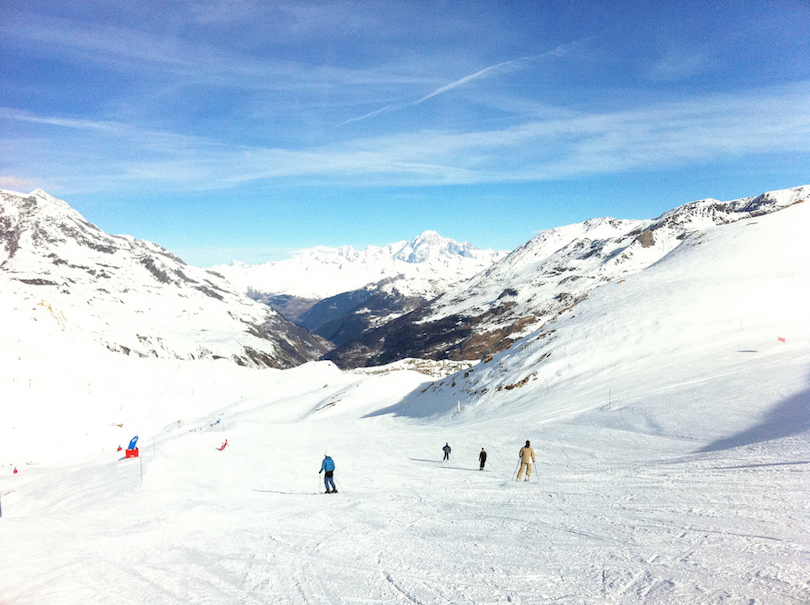
Alongside Chamonix, Val d’Isere is a destination not to be missed among snowbirds. This world-class skiing and snowboarding destination offers guaranteed snow cover, fun for beginners through to expert, and thrilling après-ski.
On the edge of the Tarentaise Valley, minutes from the Italian border, reaching the high alpine village is a trek. A forty-minute drive up from the valley is immediately rewarded with an exciting destination that harbors enough history to rival its sea-level compatriots.
Beyond the chalets, chairlifts take you up into the heavens. The run awaits, yet you’ll want to take in the spectacular views of the surrounding Alps. Once the day is done, change boots and experience Val d’Isere’s vibrant nightlife.
24. Nîmes Roman Monuments
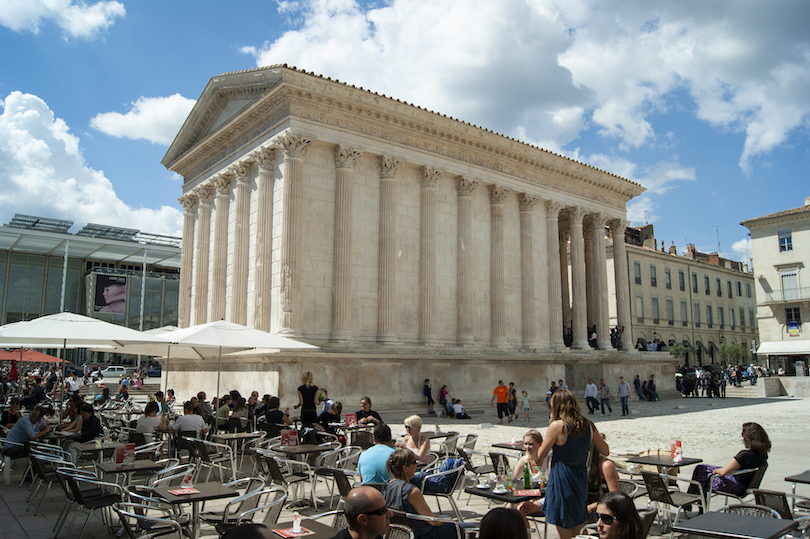
Around 2,000 years ago, the Romans made their mark upon the town of Nimes in southern France. Today, it’s the most Roman city to exist outside Italy. At the heart of this are the Nimes Roman Monuments that showcase an incredible city at its peak.
Once a major regional capital, Nîmes was where engineers and architects pushed boundaries to create the Pont du Gard, the Maison Carree, Temple of Diana and the Arena of Nîmes.
The Maison Carrée was built around the same time as the birth of Christ. It translates to square house and, incredibly, is almost completely intact. The Arena of Nîmes is another highlight. Similar in age to the Roman Coliseum, it remains in use today.
23. Camargue
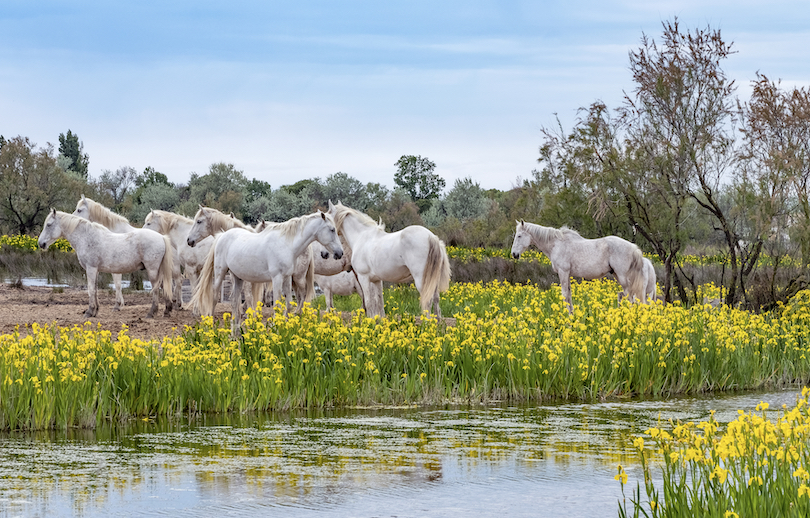
Beneath the city of Arles in southern France, the Parc Regional de Camargue is a protected landscape. France is teeming with old town and glamorous coastal enclaves. This sets Camargue apart.
UNESCO has listed this as a Biosphere Reserve, a place where wild horse saunter along the golden sands, at times venturing into the Med. Elsewhere, the park’s famous pink flamingos go about their daily lives.
There are over 300 bird species, both local and migrating within Camargue. This makes the reserve one of the best spots for birdwatching in France. Beyond hiking, you can explore on riverboats, kayaks, or horseback.
22. Vieux Lyon
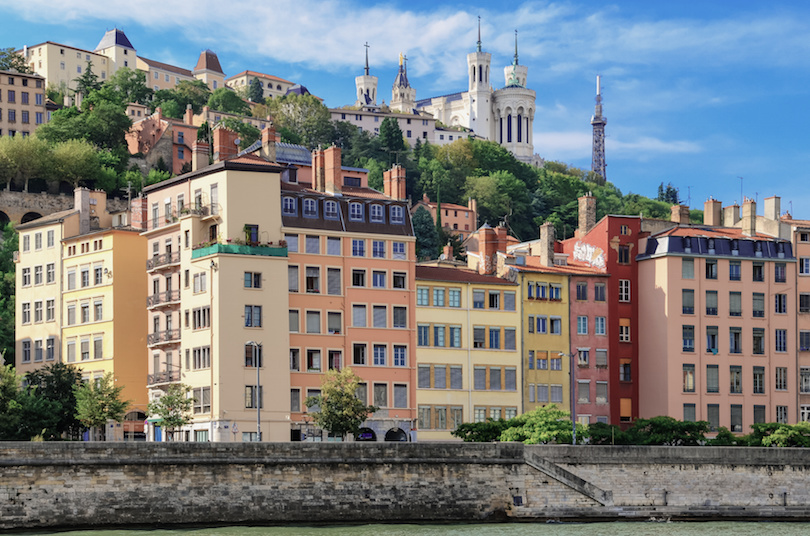
On the precipice of Fourviere Hill, Vieux Lyon ( Lyon Old Town ) is home to vibrant facades, old communes, churches, and business all reached along paved streets that have been worn smooth by the passage of time.
Thanks to a movement in the 1960s, the Vieux Lyon has remained much as it was going back hundreds of years. It has also been revitalized to the point it’s as prominent a part of local life as the popular Presqu’ile.
Now a World Heritage Site, Vieux Lyon’s three districts are waiting for your footsteps. Within them are three distinct churches, each with an important chapter in Middle Age religion.
21. Bonifacio
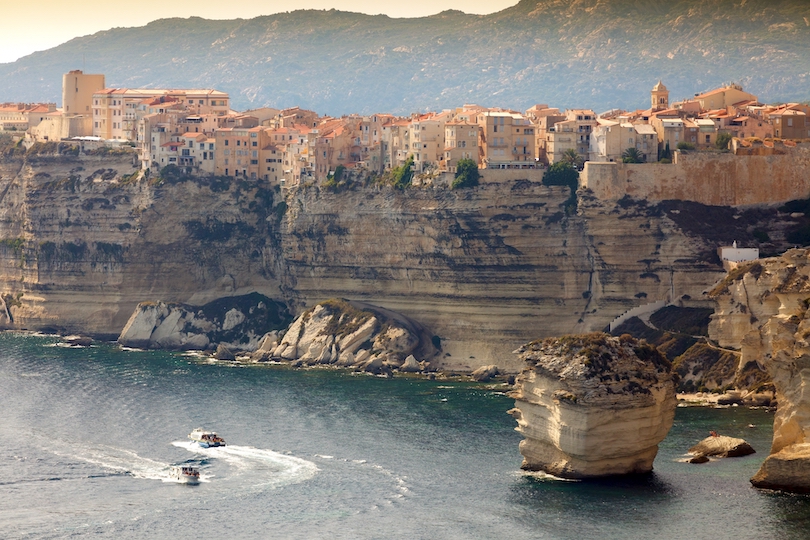
Known as the City of Cliffs, Bonifacio is one of France’s best-kept secrets. Clinging to the edge of white limestone cliffs, this seaside town along the Corsica coast is relaxing to visit, even at the height of summer.
Back from the cliffs that fall quickly to the kaleidoscopic Mediterranean Sea, is a medieval town that was once a part of Sardinia, an Italian island. Volcanic activity put an end to the connection leading to waters that are now littered with infamous pirate ships.
The vibe of the oft-chaotic sea is left behind once you step inside the coastline’s oldest town. The fortified Bonifacio is an ancient citadel, with colorful homes, and a culture that is a fascinating mix of Italian and French.
20. Millau Bridge
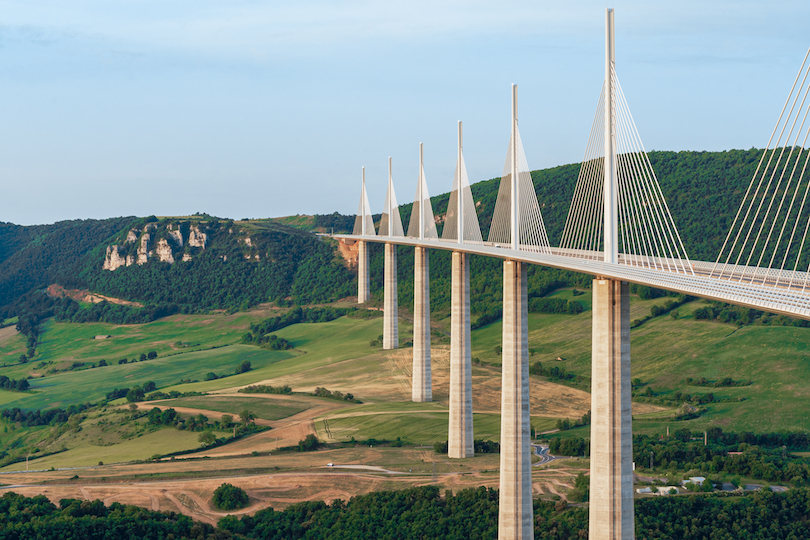
Touring around southern France is on the bucket list of many travelers. As such, it’s nice to know that such a journey can take you across one of the most incredible bridges in the world. The Millau Bridge stands at 343 meters tall, a world record. Add on stunning panoramas and you’ll quickly be changing course.
The Millau Bridge stretches across the stunning Tarn Valley, connecting a duo of limestone plateaus otherwise known as the Causse du Larzac and Causse Rouge across 2.5 kilometers. The cable-stayed bridge is as visually appealing as the surrounding landscape featuring white towers that often poke through the clouds above.
19. Ètretat Cliffs
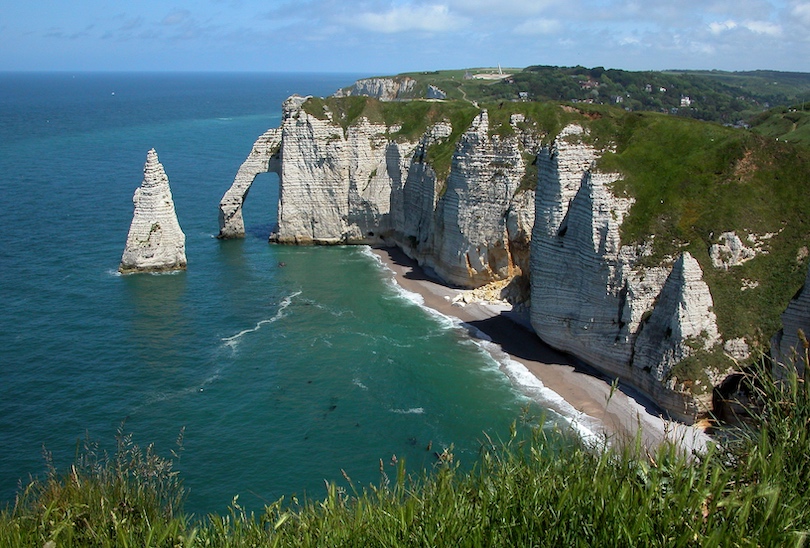
Along the hauntingly beautiful Normandy coast, stands the towering white rock known as the Étretat Cliffs. Looking out across the English Channel, the cliffs are home to two famous natural arches that jut into the water, showcasing both its strength and fragility.
The white cliffs are encased in thick greenery, providing a beautiful breadth of colors on a sunny day. It’s easy to scale up the Étretat Cliffs to enjoy vast views of the coast and the ghost white sand below. But it’s from the beach that you can best appreciate the scale of the cliffs and the arches which were initially carved by a rolling river.
18. Reims Cathedral
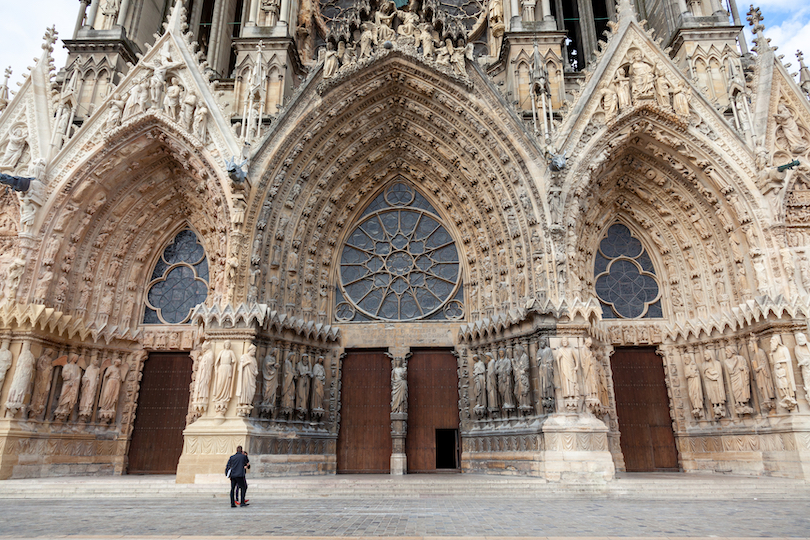
For eight centuries until 1825, French kings received their coronation within the walls of the Notre Dame de Reims Cathedral. All up there were 29 such kings, which include the famous names of Francois I and Louis XIV. Such was the esteem of the cathedral’s coronations that led Joan of Arc to its doorstep in 1429.
Today, the Reims Cathedral is a brilliant example of High Gothic architecture and is one of the most stunning attractions in France. Despite enduring heavy artillery fire and bombings in the Second World War, it has returned to its former glory. Its front facade features more statues than any equivalent on each and comes with a trio of towering entrances, known as portals.
Like other French cathedrals, Reims also has an enormous rose window which leads to the Gallery of Kings.
17. Strasbourg Old Town
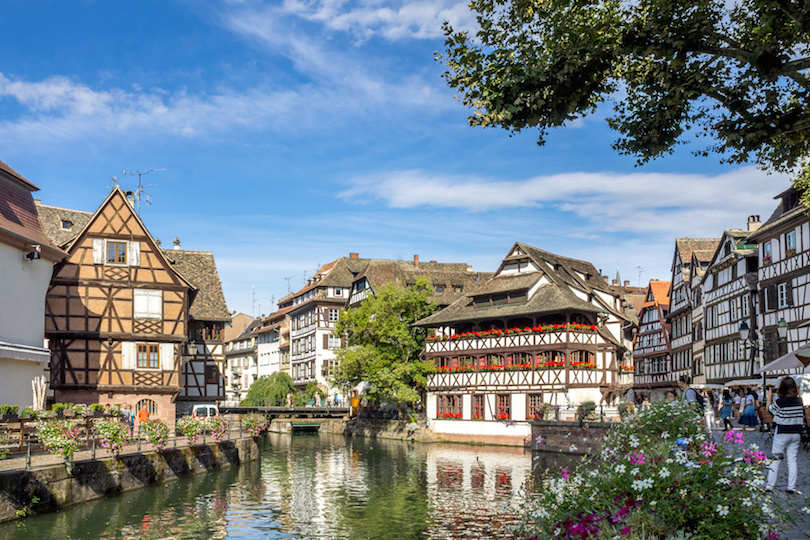
In northeast France, Strasbourg is the capital of the Grand Est Region. Minutes from the German border, Strasbourg’s entire Old Town is a UNESCO World Heritage Site. Encased in picturesque half-timbered houses and the canals of Petite France, it’s a destination that oozes history.
The wider Strasbourg is a town driven by youthfulness, but its historic interior tells the tale of a city that has lived under many kingdoms and within multiple nations. The narrow passageways act as a maze, guiding you by the pastel homes half covered in wood, past medieval churches and onto vibrant town squares where locals gather in droves on the cafe patios.
Within the Old Town are a number of unique quarters, such as La Petite France and the Quartier Krutenau, each with their own story to tell.
16. Promenade des Anglais
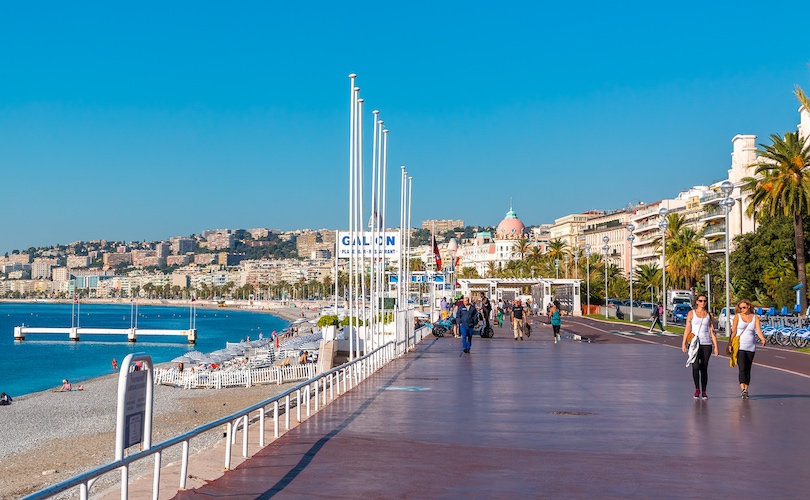
Set along Nice ’s spectacular waterfront, the Promenade des Anglais spans seven kilometers. It splits Nice’s beloved Baroque palaces, historic museums, and high-end shops with its pebbly shores home to scantily clad travelers soaking up as many rays as possible.
While there’s much to do on the city-side of the promenade, it’s along this path that you can best participate in local culture. The Promenade des Anglais boasts a series of cafe terraces, offering gorgeous views of the Med. Festivals are consistently set upon the smooth path and in the center is the Jardin Albert 1er, one of Nice’s original parks.
After a lengthy stroll, the Promenade delivers you to the doorstep of Nice’s memorable Old Town.
See also: Best Neighborhoods & Hotels in Nice
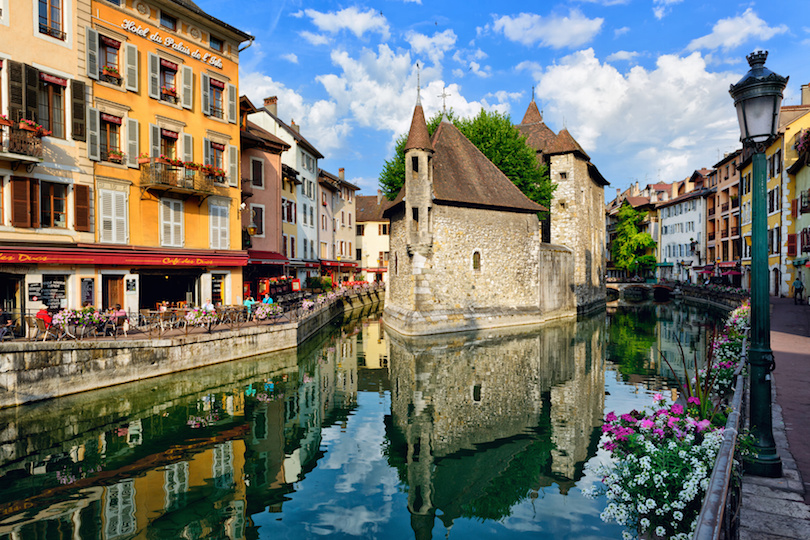
In southeastern France, Annecy is surrounded by giant snow-capped peaks. But little time is spent marveling at the mountains as Lake Annecy steals the show. Known as the Venice of the Alps, Annecy features pastel-colored homes, narrow alleys, and an abundance of old churches. All set upon the waterfront or the town’s series of slim canals.
Between the memorable man-made creations is a town that preserves its natural beauty. Almost 30,000 trees are spread across the locale, a historic town that refuses to grow much beyond its original design. Here, pedestrians are king and getting about on foot is the best way to admire not just the buildings, but each garden and the alpine lake that reflects the surrounding mountains.
14. Bordeaux Wine Regions
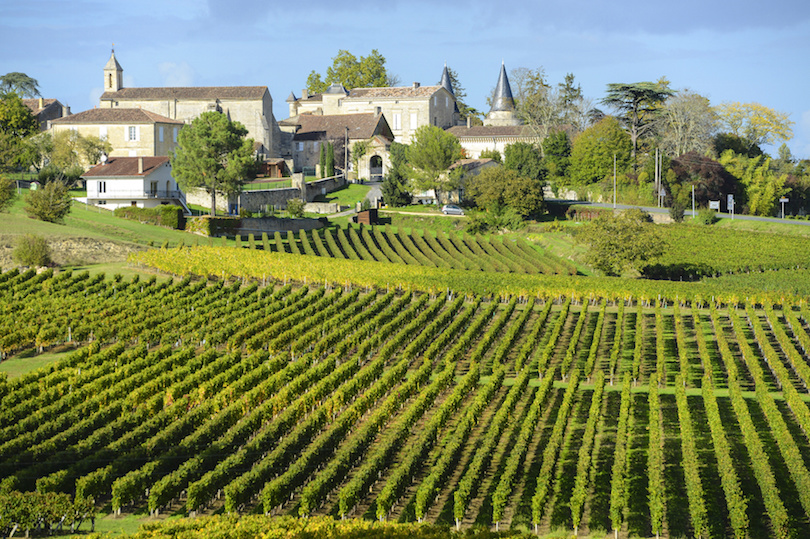
Broken up into 38 sub-regions, the Bordeaux Wine Regions are not to be missed. Though enjoying a good wine is one of the most popular things to do in France, you may not enjoy sampling the local tipple in Bordeaux . If that’s the case, you’ll have no problem falling in love with the countryside home to such quaint towns as Pomerol, Graves, and Saint-Emilion.
Set between each charming village is a collection of 7,000 vineyards split by the Gironde Estuary. Mesmerizing views are found around each passing corner, whether it be the lush rolling hills or the sight of the spire rising above a town as old as time.
The Gironde Estuary separates the region along the Left and Right banks. The former is famous for its cabernet sauvignon, while the latter provides sumptuous merlot and white wines.
13. Palace of Fontainebleau
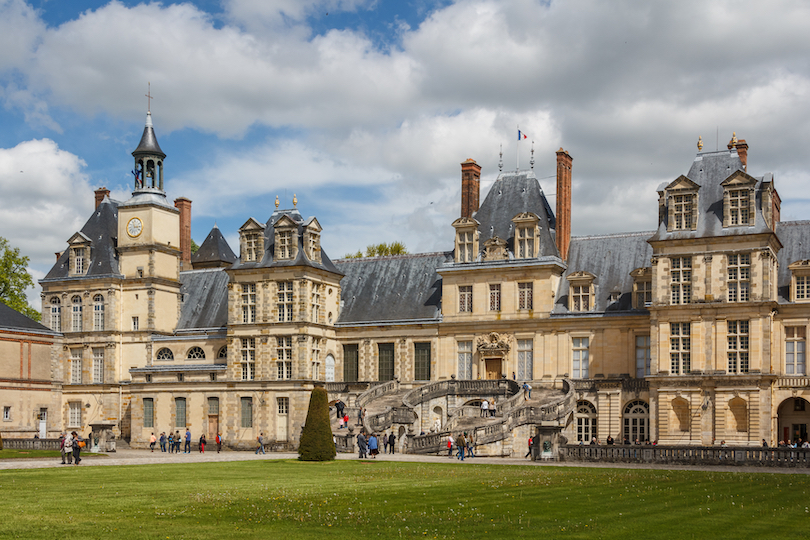
It was here, within the walls of the Palace of Fontainebleau, that Napoleon abdicated the throne and was exiled to Elba. Unsurprisingly, the palace, which dates back to the 1130s, is lathered in history.
Older than the Louvre and the Palace of Versailles, Fontainebleau was once the home of Marie Antoinette, among other famous (and infamous) royal characters. Inside, you’ll find the horseshoe staircase which was created for Louis XIII and where Napoleon saluted his guards for the last time.
Decorated hallways lead you to the renowned Throne Room where Napoleon once sat. It’s the only one of its kind in France to remain exactly as it was. Each part of Fontainebleau has much to say. However, as most travelers choose Versailles, this palace remains easy to explore.
12. Pont du Gard
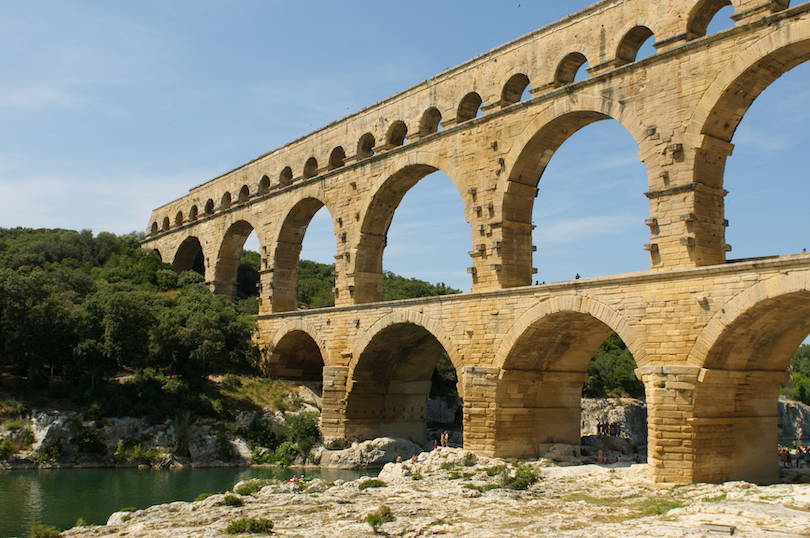
In the south of France, the River Gardon snakes its way through the surrounded landscapes. As it reaches the Occitanie region, it passes under Pont du Gard, a Roman aqueduct that was built in the heart of the first century.
The aqueduct, which at its height was as long as 50km, is one of the most impressive Roman creations. Built by the ancient Nemausus, a Roman colony, the three-story creation supplied the city of Nimes with water from Uzes. Pont du Gard was pivotal, as it allowed the water to cross over the River Gardon.
In 1985, it joined the list of UNESCO World Heritage Sites, allowing the preservation and celebration of this historic and vital work of art.
11. Carcassonne

Once you set foot within the town limits of Carcassonne, you’ll understand how it came to inspire the strategic board game that harbors the same name. The ancient town has been impeccably preserved over the centuries, so each step along the cobblestone streets feels like another step back in time.
Among the lush green trees are fortified walls eclipsed by towers that sparkle under the French sun. Also known as La Cite, it’s a fascinating journey back to the Middle Ages, where the streets guide you to historic sites such as the Chateau Comtal, constructed in the 1100s, and the 52 towers that belong to the Basilique Saint-Nazaire et Sainte-Celse.
10. Chartres Cathedral
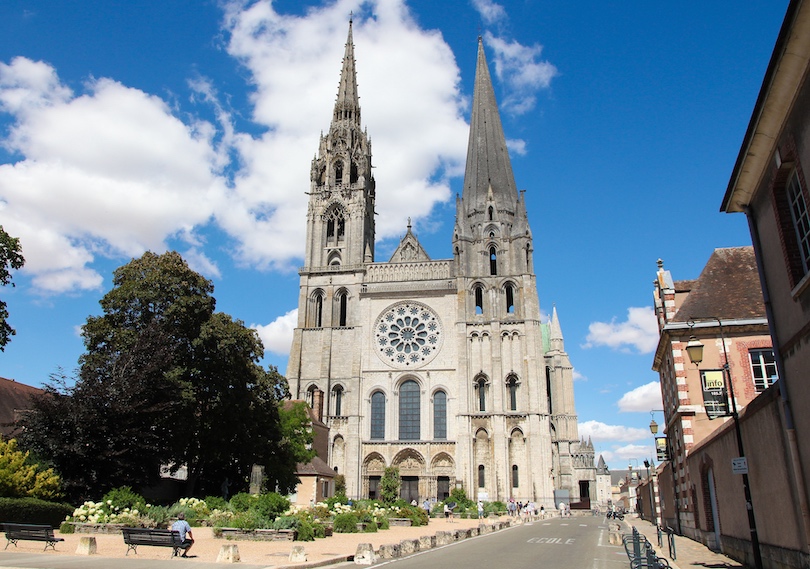
The story of France’s connection with religion is as old as time, as ancient even as the medieval Gothic architecture strewn across the provinces. Each is a prominent reminder of culture within the middle ages and the endurance of spirituality. Standing at the forefront of this is the Chartres Cathedral.
For over 800 years, the spectacular cathedral, with its twin spires, has inspired the masses and provided a sanctuary. The UNESCO-listed cathedral features impressive stained-glass windows that you can admire from several blocks away.
Two windows are particularly beloved. They are the Blue Virgin and the Passion windows that are almost as old as the structure itself. They both come to life during the annual light show.
9. Dune of Pyla
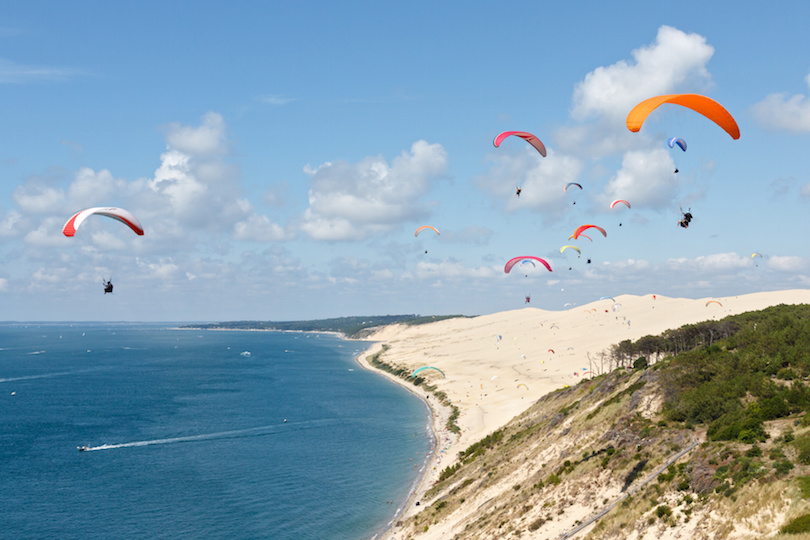
An hour southwest of Bordeaux, on the edge of the Atlantic Ocean is a soaring sand dune. The Dune of Pyla is the tallest in Europe and grows further eastward every year. On its edges is a vast forest creating eye-catching contrast that only enhances the dune’s beauty.
The Dune of Pyla stretches along the Arcachon Bay for three kilometers, holding off the pounding Atlantic surf while thousands of trees rustle on the other side. At its highest, the Dune of Pyla stands 100 meters above sea level, providing epic west-facing sunsets as the sun dances along the glistening sands.
Whatever the time of day, a quick stroll down to the Arcachon Bay for a refreshing dip will be a traveler’s reward.
8. Palais des Papes
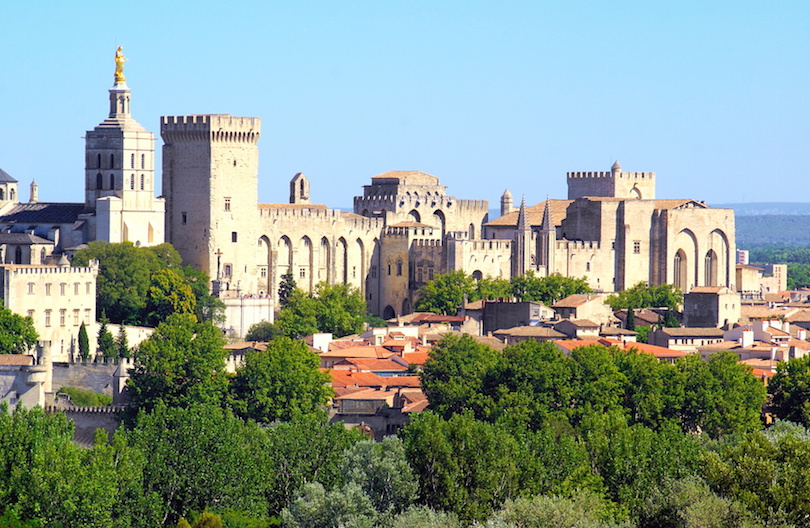
Within the medieval city of Avignon , is the equally medieval Palais des Papes. The remarkable gothic architecture dates back to the 14th century and is the largest of its kind on earth. From then until now, it’s been a constant symbol of Christendom.
At first glimpse, you’ll notice just how imposing the fortress is. Yet it’s equally luxurious within the fortified walls. A visit to the gothic palace will provide you with a look into the immaculate staterooms, ornate chapels lined with historic decor and private apartments where a series of nine popes resided in the 1300s.
Within, you’ll spot countless works of art while the onsite museum dives into the story behind Palais de Papes. Before departing, admire the views of Avignon from the terraces.
7. Chateau de Chambord
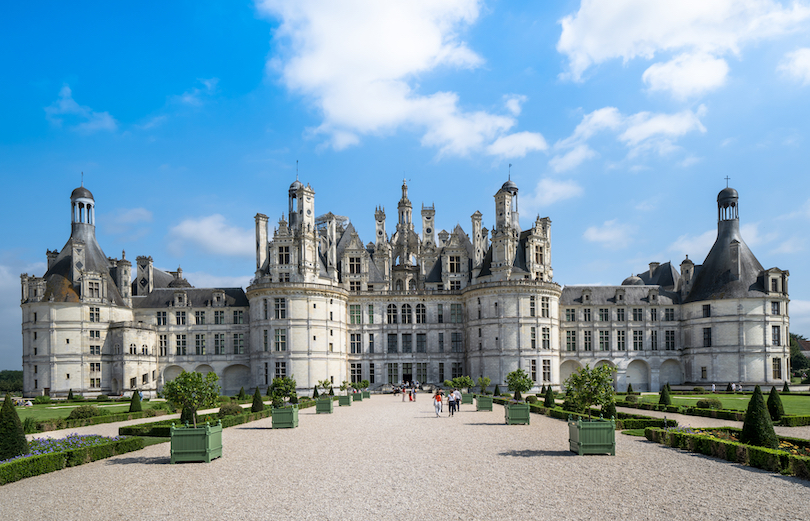
Set in the romantic Loire Valley, the Chateau de Chambord is a veritable masterpiece that owes its origins to the French Renaissance. Ordered under the rule of King Francois I in the early 1500s, the chateau features over 400 rooms, 282 fireplaces (naturally) and even 83 staircases.
It’s enough to fill the stats book, yet Francois I, who had planned to use it as a hunting escape, spent only a handful of nights staying within its four walls. It was maintained over the centuries, yet recently it received rejuvenation. The colorful surrounding gardens are now just as much a reason to visit.
The Chateau de Chambord is just one of the numerous incredible castles within the valley. Others include the neoclassical Chateau de Cheverny and the Chateau de Chenonceau.
6. Gorge du Verdon
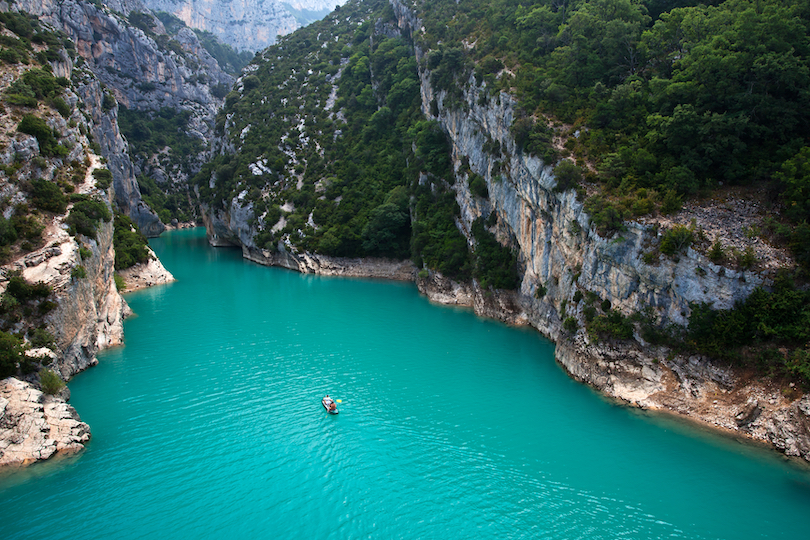
One of Europe’s largest canyon, Gorge du Verdon, brings together the strength and might of ancient rock and the turquoise beauty of the Mediterranean. Set between Marseilles and Nice, north of the French Riviera , Gorge du Verdon was carved by glaciers creating cliffs as tall as 700 meters that soar about the milky blue water illuminated by glacial till.
It’s the Grand Canyon, but with a river far more relaxing. The canyon walls are littered with lush vegetation, seeming holding on for dear life as the canyons rise sharply upwards and sometimes over the Verdon River.
Beginning at the Pont du Galetas bridge in the Provence, you can kayak along the river admiring the sheer scale of the canyon with each stroke.
5. Mont Saint-Michel
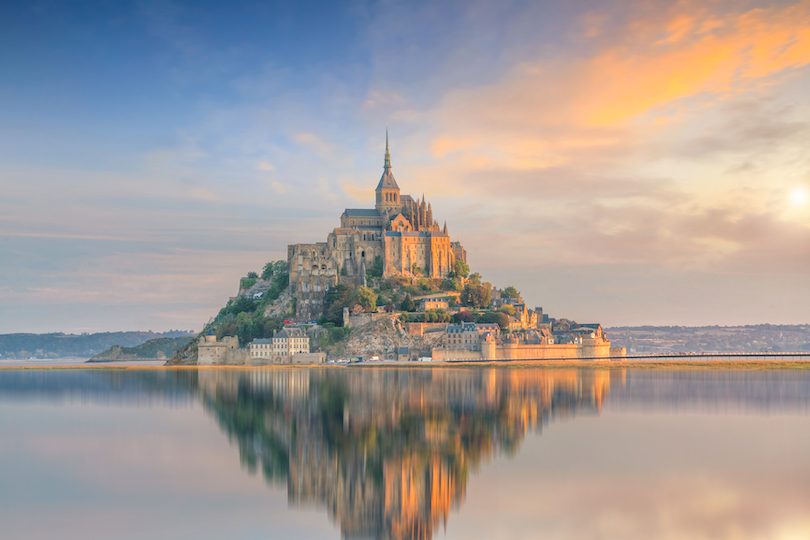
Surrounded by the chilling waters of the English Channel, along France’s memorable Normandy coast, is the UNESCO-listed Mont Saint-Michel. It’s the castle of dreams known as the Pyramid of the Seas that rises out of the encompassing landscape to provide one of the world’s great vistas.
The castle’s story begins in the 11th century, its awe-inspiring architecture home to Abbey Church (Abbaye du Mont Saint-Michel) draws pilgrims in large numbers a 1000 years later. From the beginning, pilgrims crossed the surrounding bay by foot, a tradition that has not lost steam.
Viewing the castle from a distance will only inspire you to come closer. The aforementioned church is the main attraction, boasting inspiring high-vaulted choirs, ancient naves and striking gothic spires.
4. Palace of Versailles
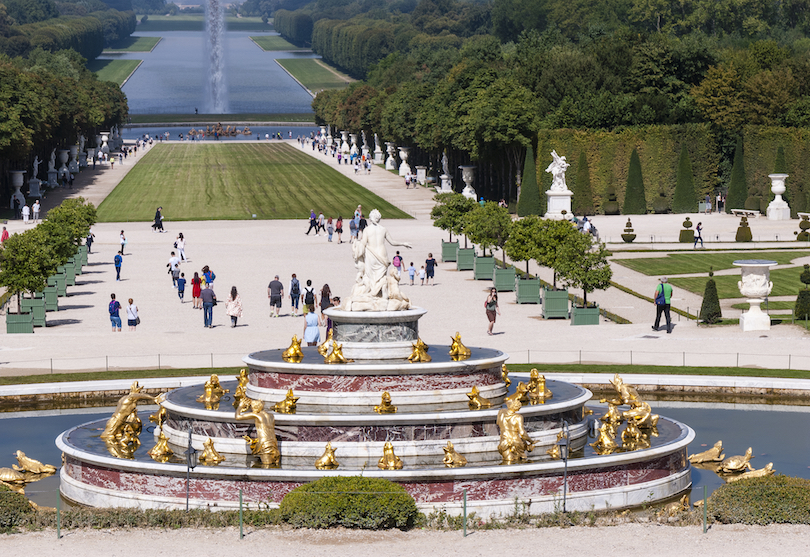
France has no shortage of groundbreaking architecture. Perhaps the most prominent is the Palace of Versailles. Originally constructed in the 1600s as a hunting lodge for King Louis XIII, such was the beauty of the building that the country’s royal court was moved from Paris to Versailles, up until the infamous French Revolution.
Under an hour from downtown Paris, the Palace of Versailles continues to capture the imaginations of all visitors into the 21st century and remains one of the most popular tourist attractions in the world. Within is five centuries of untouched history and stunning works of art splashed across the ornate walls.
Yet the palace itself, which boasts an incredible 2,300 rooms is the true work of art. The highlight of the palace is the Hall of Mirrors featuring over 350 mirrors that reflect the surrounding gardens.
3. Chamonix
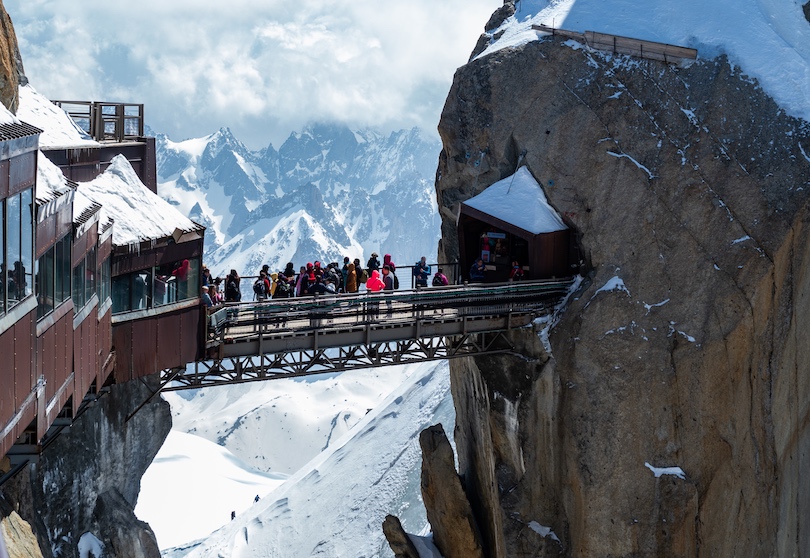
A year-round destination, Chamonix is one of the more famous alpine villages in Europe. Nestled in the foothills of France’s tallest mountain, Mont Blanc, Chamonix captures all that is good about nature and humanity.
The picture-perfect village provides access to a lively local culture where locals and travelers mix within the storied buildings from alpine churches to rustic auberges. But steps from the quaint cobblestone streets bring you to the marvels of the French Alps, from world class skiing and hiking to towering rock walls made for fearless climbers.
One could indulge in only the human or natural aspect of Chamonix and still walk away with an unforgettable experience. Regardless, a mouthwatering, traditional cuisine awaits every evening.
2. St Tropez
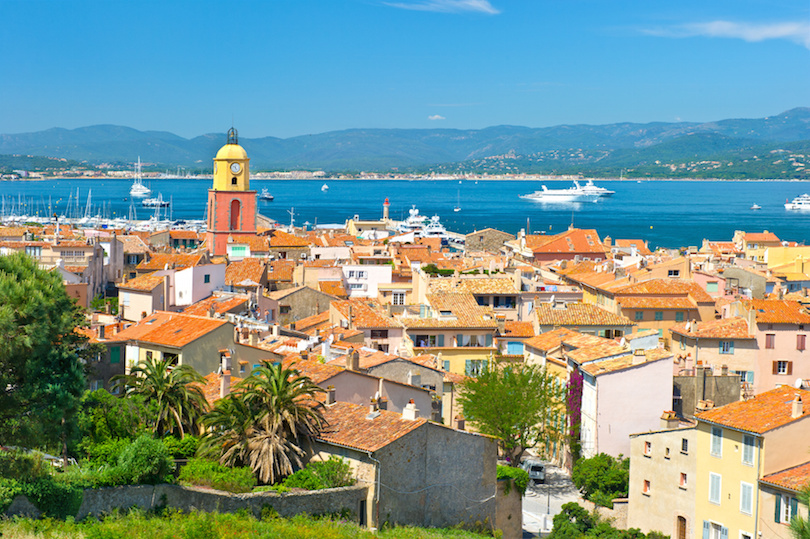
In the 1950s, St Tropez was a simple fishing village harboring an eye-catching secret. As tourists ventured elsewhere, locals went about their daily lives surrounded by striking beauty. Upon the release of the film And God Created Woman, the coastal town was forever changed.
Today, it’s a gorgeous hot spot along the famed French Riviera. In the distance the Alps rise across southeastern France, but for visitors’ eyes are firmly fixed on the arresting architecture and the glistening sea.
Eyes dart from spot to spot with the possibility of spotting a celebrity in a town that has now become a hallmark for glitz and glamour. Elsewhere, the calm sea breeze laps the sand as windsurfers and sailors play on the water mere yards from million-dollar yachts.
1. Eiffel Tower
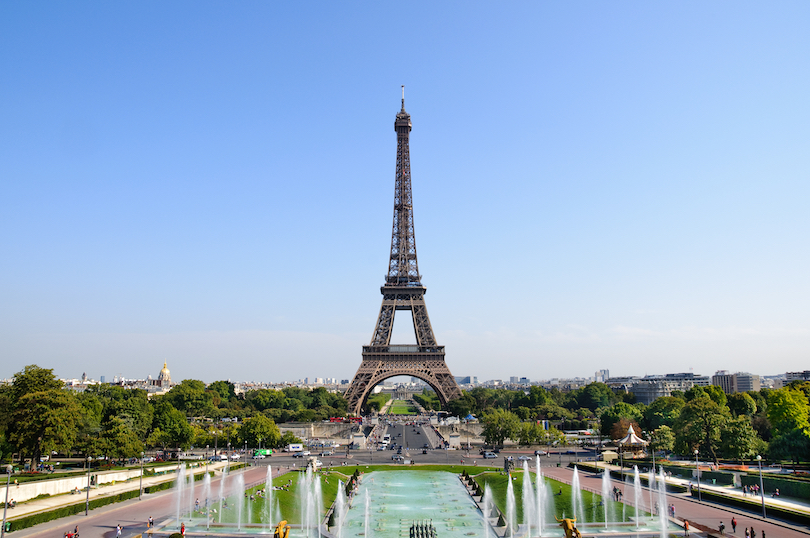
Such is the modern-day popularity of the Eiffel Tower. It’s hard to imagine that it was once despised among local Parisians. Built in 1889, the famous tower which harbors the bulk of Paris ’ romantic sensibilities has come a long way.
No trip to France’s biggest city is complete without a closeup view of the Eiffel Tower’s 8,000 parts. Once you’ve admired the marvelous architecture, wander up the staircase to restaurants across multiple levels, plus wondrous views of the city itself.
Within the tower, you can enjoy fine dining at the Michelin starred Le Jules Verne. Later, venture to the highest level almost 280 meters (905ft). From the jaw-dropping height, appreciate the beauty of the River Seine, Notre Dame, and the Trocadero.
Map of Tourist Attractions in France
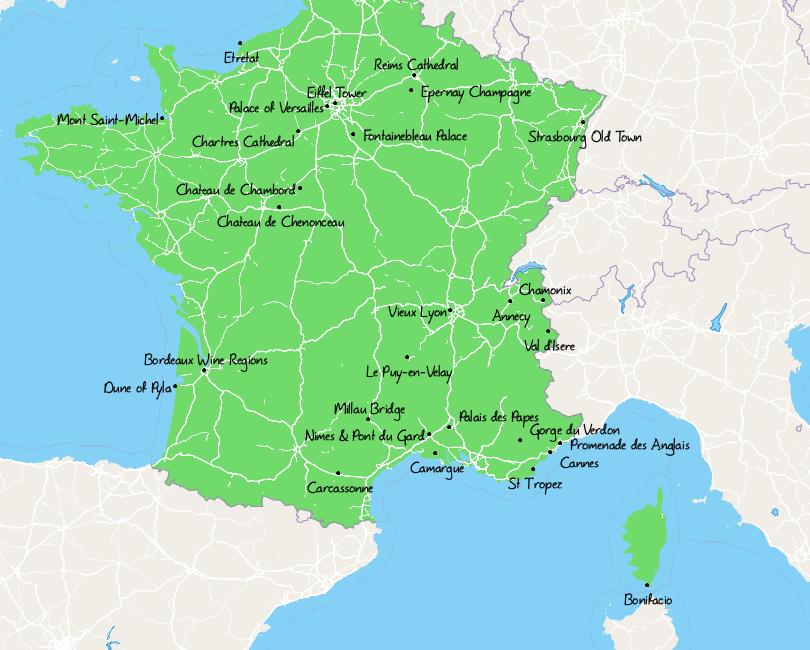
Share this post:
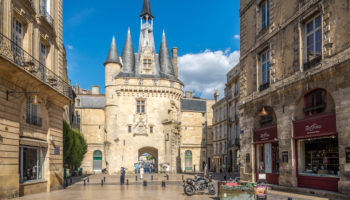
17 Best Cities to Visit in France
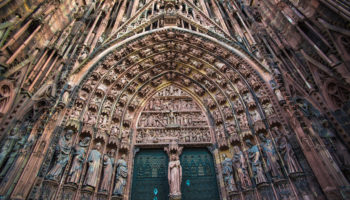
12 Most Beautiful Churches in France
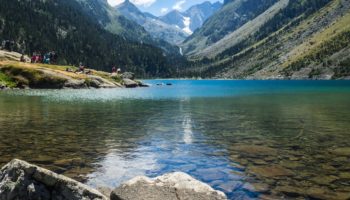
10 Most Beautiful Lakes in France
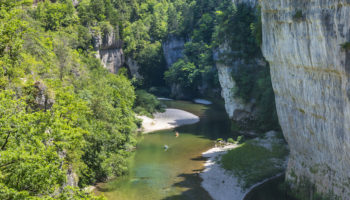
10 Most Beautiful National Parks in France
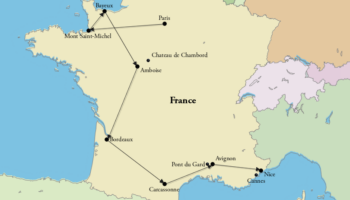
How to Spend 2 Weeks in France: DIY Itinerary
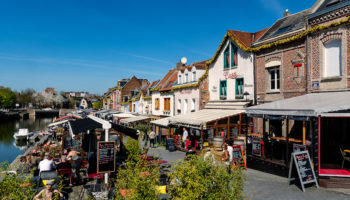
18 Most Beautiful Regions of France
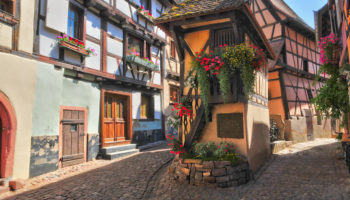
12 Most Charming Small Towns in France
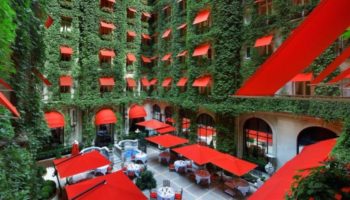
8 Most Awesome Places to Stay in France

10 Most Underrated Destinations in France

5 Most Beautiful Chateaus in France
Reader interactions.
January 25, 2024 at 5:57 am
Brilliant list! I’ve been to most of these places and enjoyed them massively. Calanques National Park in Marseille is another one that isn’t featured. There are so many picturesque hikes and fun activities for a busy day out.
November 28, 2016 at 10:14 am
Very good list but Lyon is missing! There is so much to discover…Vieux Lyon, Traboules, Fouviere and its Basilica but mostly lyonnais cuisine as Lyon is the Capital of Gastronomy.
July 14, 2016 at 11:34 pm
Pity that Lourdes is not mention….especially in these times of such unrest….many prayers have gone forth from that Holy Place…much unity and peace has gone forth from there to the world. Our Lady of Lourdes pray for us.
February 2, 2016 at 3:18 am
You’ve listed two of my favourite places in France! First is the Gorges du Verdon. I doubt if there’s anywhere in France that’s more spectacular. The second is the Chateau de Chambord. Certainly my most favourite Chateau in the Loire if not France!
January 25, 2016 at 10:34 am
I think it’s a “pity” that Val d’Isère always comes up as the best ski resort in France. Ok maybe it is not usurped, but many others “genuine” and wonderful villages deserve to be visited in the Alps.
June 23, 2015 at 3:10 am
I ve been to all of that places and if i could go back to one of them i would choose the Gorges du Verdon. Clearly one of the most beautiful canyon in the world. Perfect place for canoeing, swimming, and it’s not really far from the french riviera if your staying there for holiday (around 1 hour by car !)
January 16, 2015 at 5:07 am
Have been up the Dune du Pyla near Arcachon – remarkable ! but take food and drink with you! Have been next to the Eiffel Tower and have skied in Les Contamines but only see Mont Blanc from there – does that count ?!? Yes as someone says surely the Louvre as I think it had something like 7 or 8 million visitors last year!
August 7, 2014 at 6:37 am
I love these places. It makes me feel like I want to visit France and explore these places. This site is soooo useful for my project,wayyyy tooo useful, haha…..Thanks to the writer or blogger of this site/page. Thanks so much !
March 19, 2014 at 4:34 pm
Thanks for the tips. I´m planning a 20 day tour in France next month and certainly I´ll use your informations. I want to include Bordeaux and some other places. Mercy.
March 5, 2014 at 11:36 am
This website really helped with my French homework, it made it quick, easy and enjoyable and I loved learning these facts on these stunning attractions!
February 12, 2014 at 1:43 pm
This really helped me out to giv a wonderfull project on tourism in college thanks to one who wrote tis
January 30, 2013 at 4:34 am
The Pyrenees National Park is just one of the most outstanding areas of natural beauty to be found on this planet!
January 14, 2012 at 8:49 am
Hi this is really helping me on my speech. thnx to whoever wrote this
October 12, 2011 at 6:51 pm
Would love to visit the Chamonix – mountain biking is something I recently took up and this place just seems perfect………
Leave a Reply Cancel reply
Your email address will not be published. Required fields are marked *
This site uses Akismet to reduce spam. Learn how your comment data is processed .
- Breaking News
Greece hands Olympic flame to 2024 Paris Games hosts

Russia hits Ukrainian energy sites in ‘massive’ overnight attack

Child abuse police hunt for tattooed man

Hamas says studying new Israeli truce proposal
Greece on Friday handed over the Olympic flame of the 2024 Games to Paris organisers in a ceremony at the Athens marble stadium where the competition was revived nearly 130 years ago.
Hellenic Olympic Committee chairman Spyros Capralos handed the torch to Paris Olympics chief organiser Tony Estanguet at the Panathenaic Stadium, where the first modern Olympics were held in 1896.
Estanguet in a speech said the goal for Paris was to organise "spectacular but also more responsible Games, which will contribute towards a more inclusive society."
Organisers want to ensure "that the biggest event in the world plays an accelerating role in addressing the crucial questions of our time," said Estanguet, a member of France's Athens 2004 Olympics team who won gold in the slalom canoe event.
A duo of French champions, Beijing 2022 ice dance gold medallist Gabriella Papadakis and former swimmer Beatrice Hess, one of the most successful Paralympians in history, carried the flame during the final relay leg into the Panathenaic Stadium.
Nana Mouskouri, the 89-year-old Greek singer with a worldwide following, performed the anthems of France and Greece at the ceremony.
After spending the night at the French embassy in Athens, the flame on Saturday will begin its journey to France on board the 19th-century three-masted barque Belem.
On Sunday, the ship will pass from the Corinth Canal -- a feat of 19th century engineering constructed with the contribution of French banks and engineers.
The Belem is set to reach Marseille -- a city founded by ancient Greek colonists around 600 BCE -- on May 8.
Over 1,000 vessels will accompany its approach to the harbour, local officials have said.
French swimmer Florent Manaudou will be the first torch bearer in Marseille. His sister Laure was the second torch bearer in ancient Olympia, where the flame was lit on April 16.
Ten thousand torchbearers will then carry the flame across 64 French territories.
It will travel through more than 450 towns and cities, and dozens of tourist attractions during its 12,000-kilometre (7,500-mile) journey through mainland France and overseas French territories in the Caribbean, Indian Ocean and Pacific.
On July 26 it will form the centrepiece of the Paris Olympics opening ceremony.
A French historical monument launched just weeks after the Athens 1896 Games were held, the Belem carried out trade journeys to Brazil, Guyana and the Caribbean for nearly two decades.
Hours before the handover ceremony, the flame passed from Marathon, the town where the classic 42-kilometre endurance race, a key Olympic event, sets off annually.
The torch harks back to the ancient Olympics when a sacred flame burned throughout the Games. The tradition was revived in 1936 for the Berlin Games.
During the 11-day relay on Greek soil, some 600 torchbearers carried the flame over a distance of over 5,000 kilometres (3,100 miles) through over 50 towns and cities.
Russia hits Ukrainian energy sites in 'massive' overnight attack
Police are hunting at least one man after two sexual incidents involving children in Perth’s southern suburbs.

IMAGES
VIDEO
COMMENTS
The Camargue. 20. Plage de l'Espiguette. Map of Places to Visit in the South of France. 1. French Riviera Seaside Resorts. Beach in Cannes. The sunny weather, mesmerizing deep-blue sea, and leafy palm trees give the French Riviera a dreamy quality. Also known as the "Côte d'Azur," the French Riviera delivers fabulous beach holidays with a ...
The fields on the Valensole Plateau that erupt into a fragrant and gorgeous purple bloom each summer are some of the most popular — and photogenic — attractions in the region. 15 of 20 Grasse
Toulouse is a fantastic place to visit in South France, and will definitely keep you entertained. Read more: Best Things to do in Toulouse France. 2. Marseille. Marseille is the oldest city in Southern France. In fact, it is the oldest city in all of France and it is second in size only to Paris.
7- Cassis & Les Calanques. Cassis is a charming coastal town located in the Provence-Alpes-Côte d'Azur region of southern France. Nestled between the Calanques (rocky inlets) and vineyard-covered hills, it is renowned for its picturesque harbour, buzzing markets and crystal-clear Mediterranean waters .
The square is the best place to begin a walking tour of this town with its feudal towers and creamy limestone mansions from the 1600s and 1700s. You can scale the 100 steps of the Royal Tower for the best view of the symbolic Tour Fenestrelle, the romanesque campanile of Uzès Cathedral. 9. Marseille.
Cassis is a small town with a big personality, steeped in tradition and beauty. Related read: The 12 Best Things to Do in Cassis, France. 13. Saint Paul de Vence. High in the hills of the French Riviera, Saint Paul de Vence is one of the oldest medieval towns in the region.
Best Places to Stay. One of the more off-the-beaten-path destinations in the South of France is Sète, which is a seaside fishing town about 30 kilometers from Montpellier. It has been referred to as "Little Venice" because of the lovely canals along the streets of this coastal town.
Aix-en-Provence. Aix-en-Provence is one of the best cities in the South of France to visit. Often called the City of a Thousand Fountains, Aix is known for its water features, markets, and beautiful pedestrian lanes and squares dotted with plane trees. A visit to Aix is about being and soaking in the good life.
Sénanque Abbey. Located near the village of Gordes, the Sénanque Abbey is an unmissable place to visit in southern France for those exploring the Luberon Valley! Though the abbey was founded in the 12th century and is still the home of monks today, these days it is best known for its gorgeous lavender fields.
4. Avignon. Avignon is one of the most beautiful cities in southern France. Today part of the Provence region in Southeastern France, the city sits on the Rhône River, and it was the capital of the papacy from 1309 to 1377. Avignon is one of the best places to visit in South of France to explore for history lovers.
Of all the beautiful places to visit in the South of France, the lavender fields are an absolute must, particularly those in Provence where swathes of purple stretch as far as the eye can see onto the horizon. The Valensole lavender fields of Provence are widely regarded to be some of the prettiest lavender fields in France and are best seen ...
Wherever you travel, the sights, sounds and sensations you encounter in southern France will stay with you long after your trip is over. 10. Aix-en-Provence sailn1 / Flickr ... 22 Top Tourist Attractions in Nice, France. 10 Fun Things to Do in the French Riviera. 9 Best Day Trips from Nice. 3 Most Beautiful Gardens of the French Riviera.
While there, watch the Changing of the Guard at 11:55 a.m. daily. Then, explore The Oceanographic Museum of Monaco, also known as the Jacques Cousteau Museum. At the end of the day, take time to ...
From the sparkling sea of the Cote d'Azur to the lavender fields in Provence, castles to medieval cities, this guide will assist in planning your South of France itinerary and will ensure you include the top places to visit in the South of France. Top 25 Places to Visit in the South of France. From glitz and glamour, warm sunny beaches to ...
Here are my pick for 25+ must visit landmarks and attractions in the south of France. If you're wondering what to see in southern France, put some of these monuments on your bucket list. 1. Albi Cathedral, Albi. The historic town of Albi made the UNESCO list in 2010. It's crowning glory is Albi Cathedral, a must visit landmark in southern ...
Climb the Montagne Sainte-Victoire. This is a must-do while in the South of France. The Montagne Sainte-Victoire is a stunning natural landmark and a popular spot for hikers and climbers. Cezanne was so inspired by its beauty that he painted the famous Mont Saint-Victoire around 1906.
Provence. Provence is a blanket term for the southeastern part of France that sprawls along the Mediterranean coastline and up into the rolling, vineyard-lined hills beyond. The best way to take in the region is by car, starting in the storybook-like medieval village of Les Baux-de-Provence. Make the former farming estate of Domaine de Manville ...
Best Southern France Cities for a Fabulous Getaway. 1. Marseille. Marseille is a port city and the capital of the Provence-Alpes-Côte d'Azur region. It is situated between Cannes in the east and Montpellier in the west. This city in Southern France is the oldest in the county, dating back to 600 BC.
1 Verdon Gorges. Verdon Gorges is one of the most tourist hotspots in the South of France. The Verdon Gorge is a massive calcareous rocky canyon that surprises people worldwide. This cliff is located in the center of a natural reserve with vegetation and animals. Boating, skydiving, canoeing, bike riding, and horse riding are just a few of the ...
Mont Saint-Michel. #3 in Best Places to Visit in France. Rising above the sea like a castle in a fairy tale, Mont Saint-Michel in Normandy is one of France's most-visited sights. Legend says the ...
Cannes Film Festival. 25. Val d'Isere. 29. Chateau de Chenonceau. The Loire Valley is home to countless spectacular castles. At the top of your list should be the Chateau de Chenonceau. Dating back to the early 1500s, the castle has seen multiple iterations, each an improvement on the last.
It will travel through more than 450 towns and cities, and dozens of tourist attractions during its 12,000-kilometre (7,500-mile) journey through mainland France and overseas French territories in ...